The Weeds on Your Farm
December 15, 2020
Introduction
Profitable crop production depends on effective weed control. Weeds can reduce crop yield potential by competing for water, nutrients, and light. Some weeds release toxins that inhibit crop growth, and others may harbor insects, diseases, or nematodes that attack crops. Weeds can also reduce harvest efficiency and produce seed that can impact future crops.
Not all weeds compete with crops equally (Table 1).1 Broadleaf weeds tend to be more competitive than grasses in corn. For example, the predicted weed densities per 40 feet of row required to cause a 10% yield loss in corn would be 80 foxtails compared to 40 pigweeds and only 10 cockleburs. Canopy closure of the crop can limit the competitive ability of weeds. However, broadleaf weeds are better able to avoid the shading effects of the canopy and compete longer into the growing season. Early-germinating weeds are generally more competitive than weeds that emerge later in the growing season. Fields that experience moisture stress are also at greater risk of yield losses from weed competition. Heavier soils that hold moisture better can tolerate higher populations of weeds that may impact crop yield potential.
Late-emerging weeds can include those that emerge after control tactics have been implemented. The impact of late-emerging weeds decreases rapidly if weeds emerge 3 weeks or more after crop emergence. The competitiveness of late-emerging weeds is strongly influenced by how quickly the crop canopy develops. Stress factors that reduce crop growth can increase the impact of late-emerging weeds. These weeds are at a competitive disadvantage to the crop due to their delayed emergence but are still capable of causing economic losses.
Late-emerging weeds should not be ignored because they are capable of producing significant quantities of seed. If weeds have not initiated seed set at the time of herbicide application, seed production should be eliminated or reduced. However, if the fruiting structures are visible, it is unlikely that the application will reduce weed seed production or viability of the seeds. The other benefit of late-season weed control is harvest efficiency, and there are situations where these applications may be worthwhile.

Effective weed control in field crops requires the use of multiple management techniques including cultural methods as well as herbicides. Growing the same crop year after year and utilizing the same weed control techniques encourages the development of problem weeds and potentially, herbicide resistance. Utilizing crop rotation, tillage, and a diversified herbicide portfolio helps reduce this problem.
Identifying weeds properly is an essential first step in a weed management plan. This guide provides photos and identifying characteristics of grass and broadleaf weeds common to the crop’s growing region.
Click below on Grasses, Sedges or Broadleaves to identify and learn about the weeds on your farm.
Overview
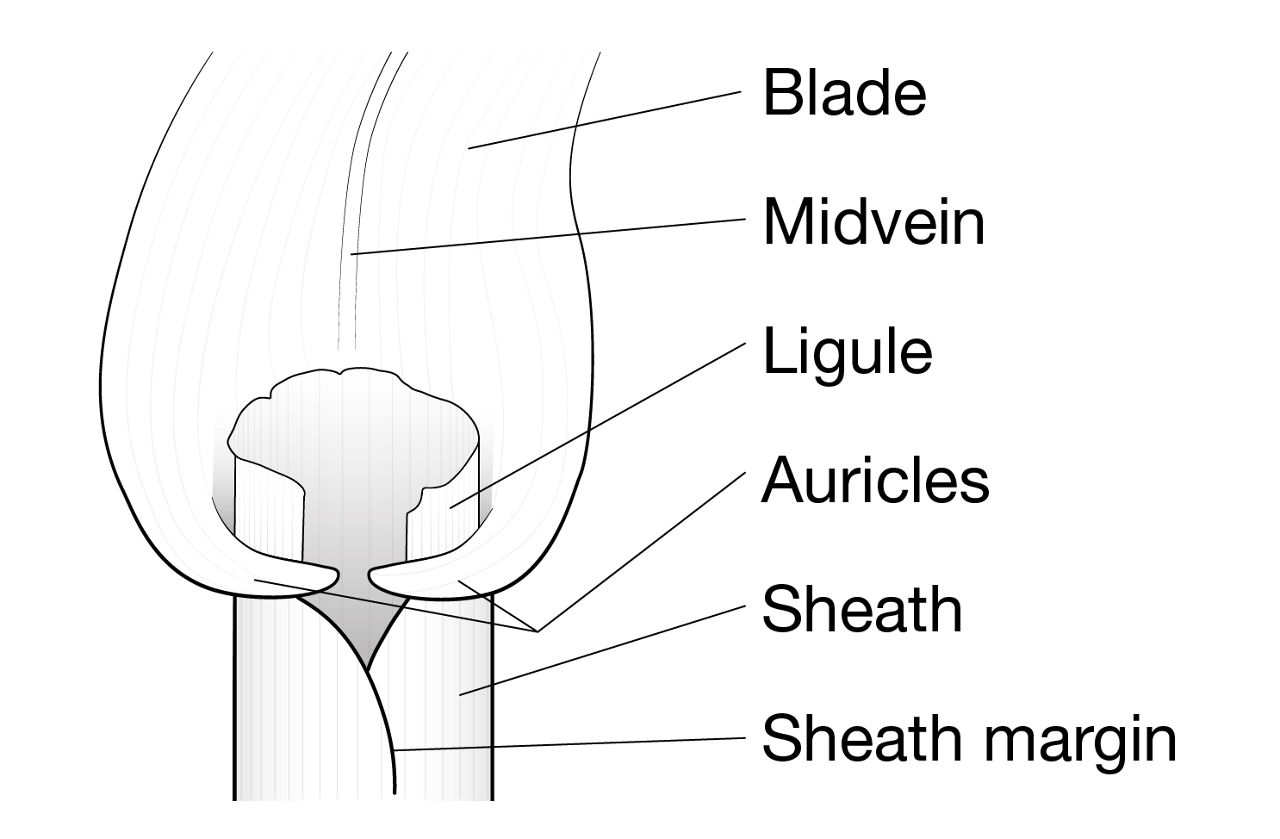
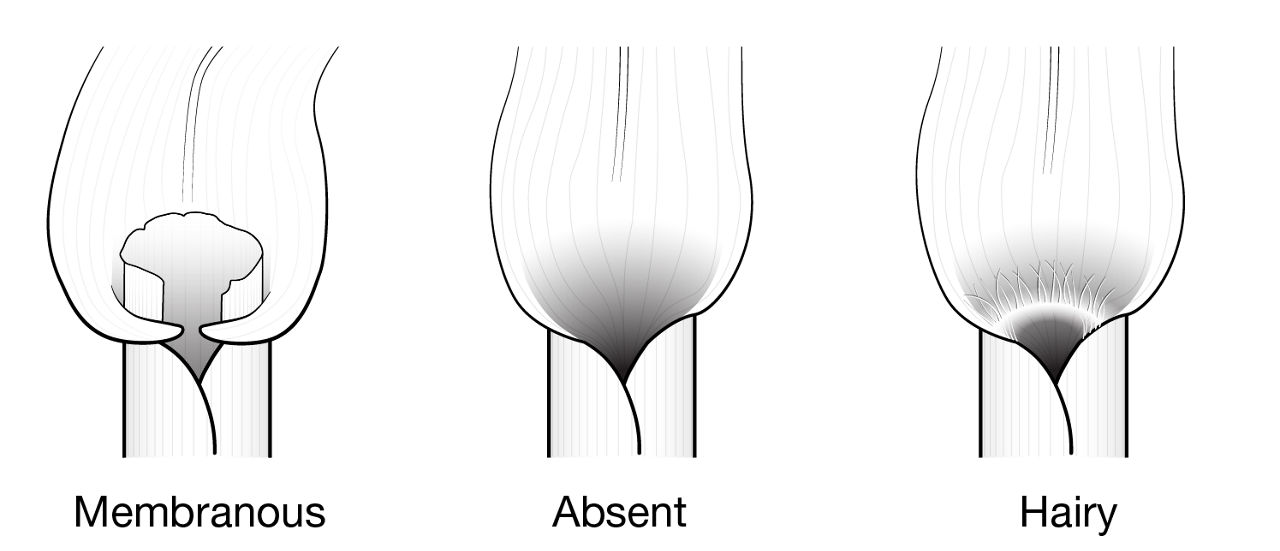
Winter Annual Grasses
Common name: Annual bluegrass
Scientific name: Poa annua
Life Cycle: Winter or summer annual
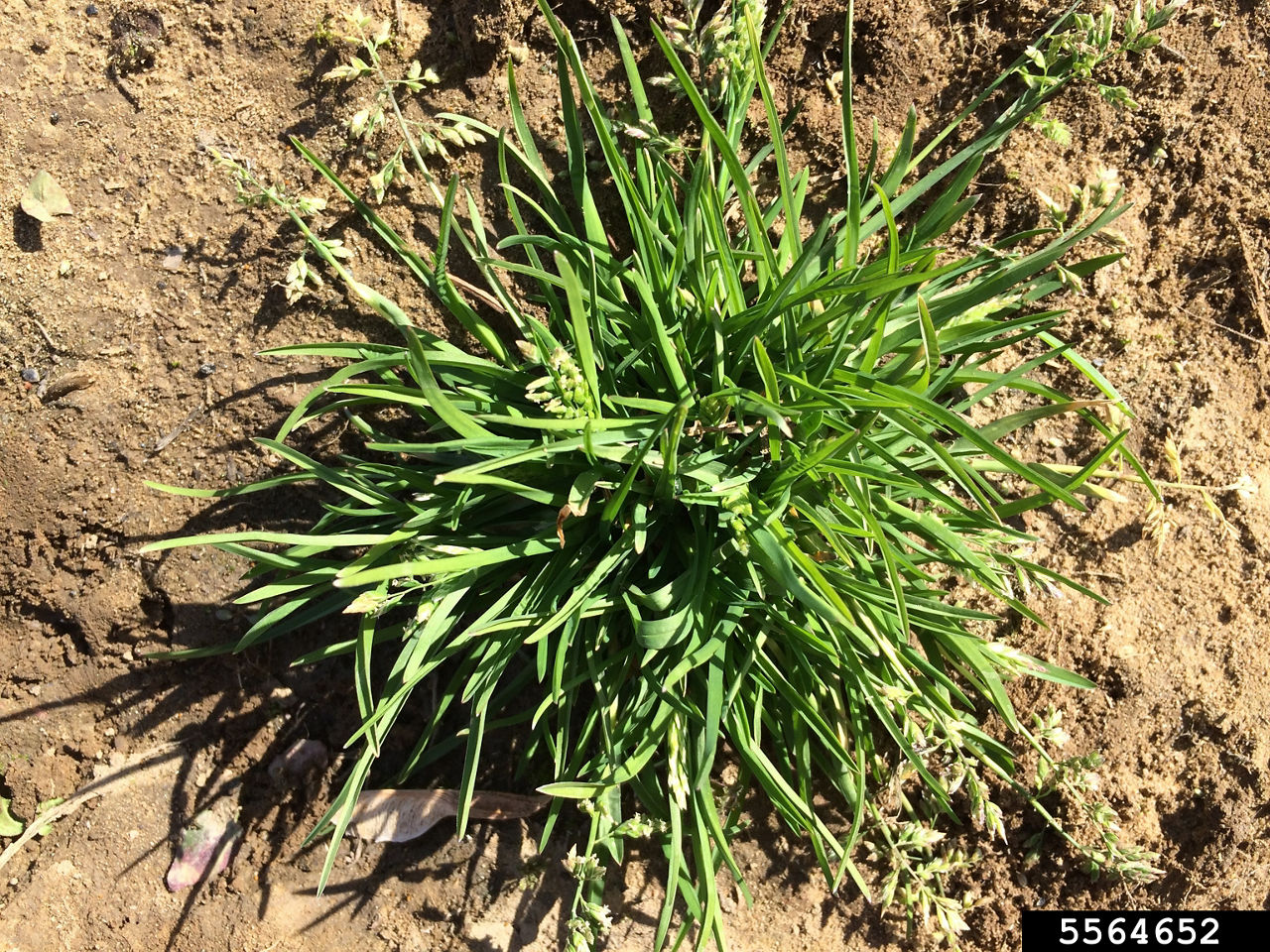
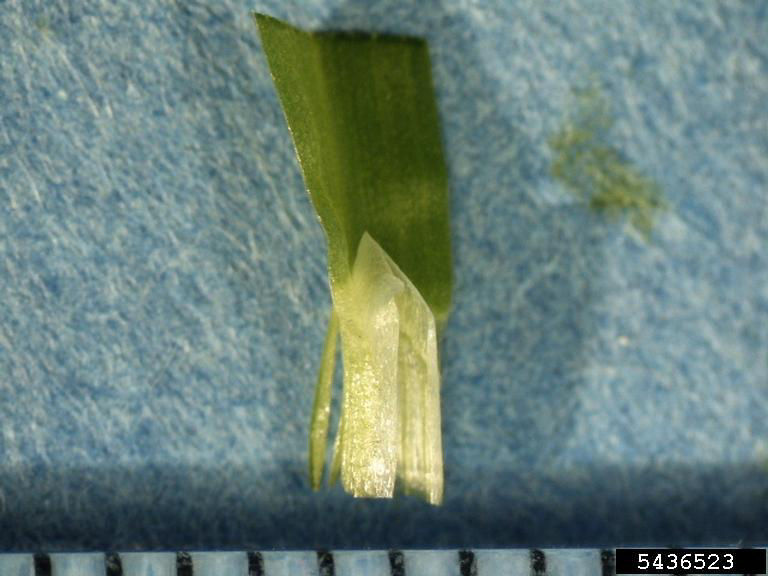

Identification: Annual bluegrass is a winter annual that germinates in the late summer/early fall once soil temperatures fall below 70° F. Seedlings grow in the fall, overwinter in a vegetative state, and flower and produce seed in late spring and early summer. Annual bluegrass is a prolific seed producer, and an individual plant is capable of producing more than 360 viable seeds. The seed may lie dormant in the soil for many years before germinating. Annual bluegrass grows well under short days and cool conditions.
Annual bluegrass is a clump-forming grass that sometimes roots at its lower nodes and forms mats (Figure 3). Leaves are light green, folded in the bud, lack auricles, and have a slightly pointed membranous ligule (Figure 4). Leaves have linear margins (both sides are parallel) and distinctive boat-shaped tips. The seed head is an open, greenish white, pyramidal panicle (Figure 5). Each spikelet contains 2 to 6 flowers.
Management: Annual bluegrass is primarily a weed of turfgrass but can also be present in no-till production systems. Common burndown herbicides typically offer good control of annual bluegrass. However, there are biotypes of annual bluegrass with herbicide resistance including Group 5 (PSII inhibitors), Group 3 (microtubule inhibitors), Group 9 (EPSP synthase inhibitors), and Group 2 (ALS inhibitors) that have been reported across the southeast in the turfgrass industry with at least one biotype with multiple resistance to both ALS and PSII inhibitors.1 Utilizing a multifaceted approach including crop rotation, targeted herbicide applications with multiple sites of action, and tillage will help manage resistant populations and slow the development of resistance.
Sources:
1Elmore, M., Reynold, C., and Baumann, P. 2015. How to manage herbicide resistant annual bluegrass. ESC-036. Texas A & M AgriLifeExtension. http://agrilifeextension.tamu.edu
Common name: Downy brome
Scientific name: Bromus tectorum L.
Life Cycle: Winter annual (may also germinate in spring).
Also known as cheatgrass, cheatgrass brome, downy bromegrass, wild oats, and cheat.
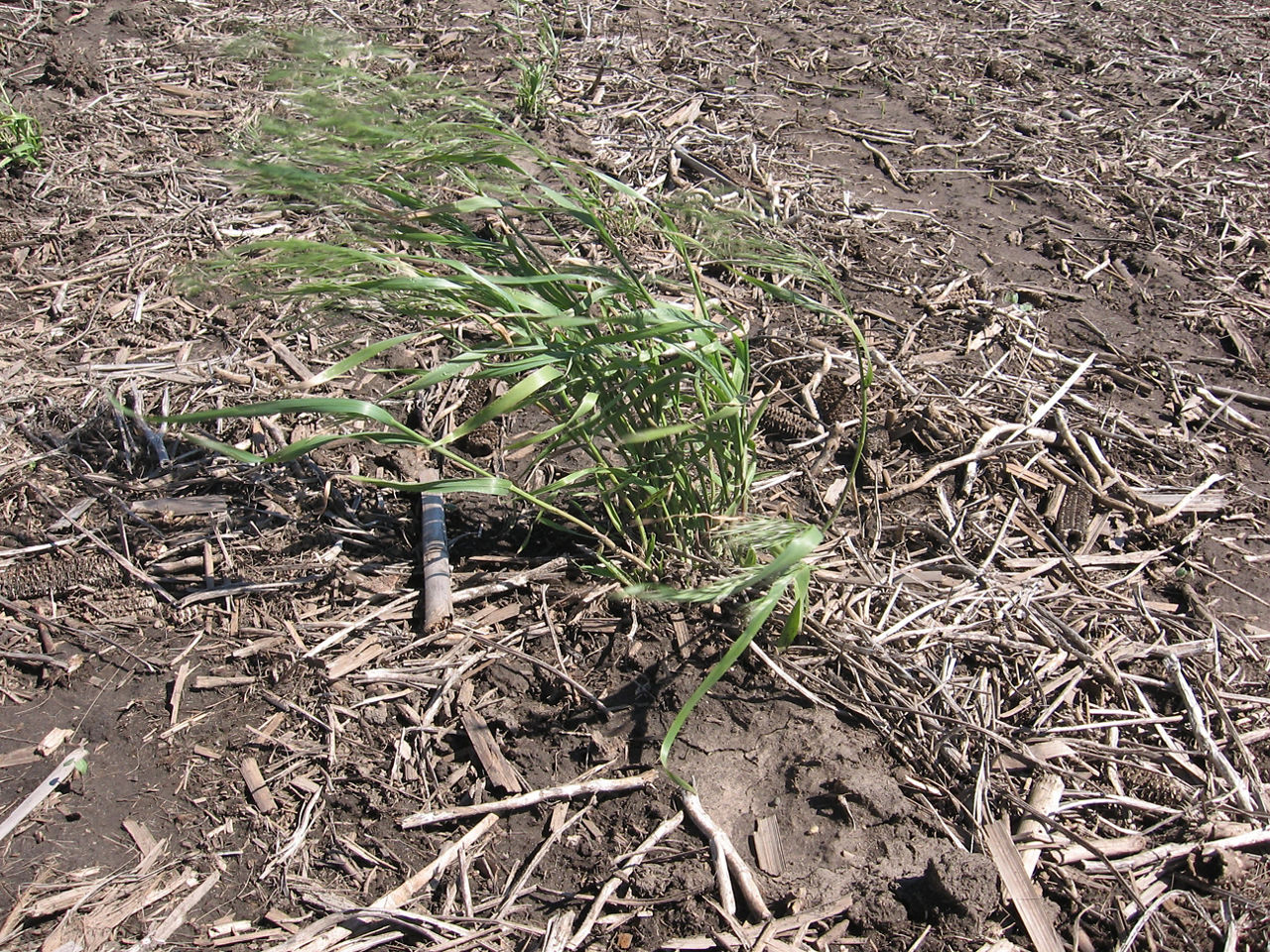
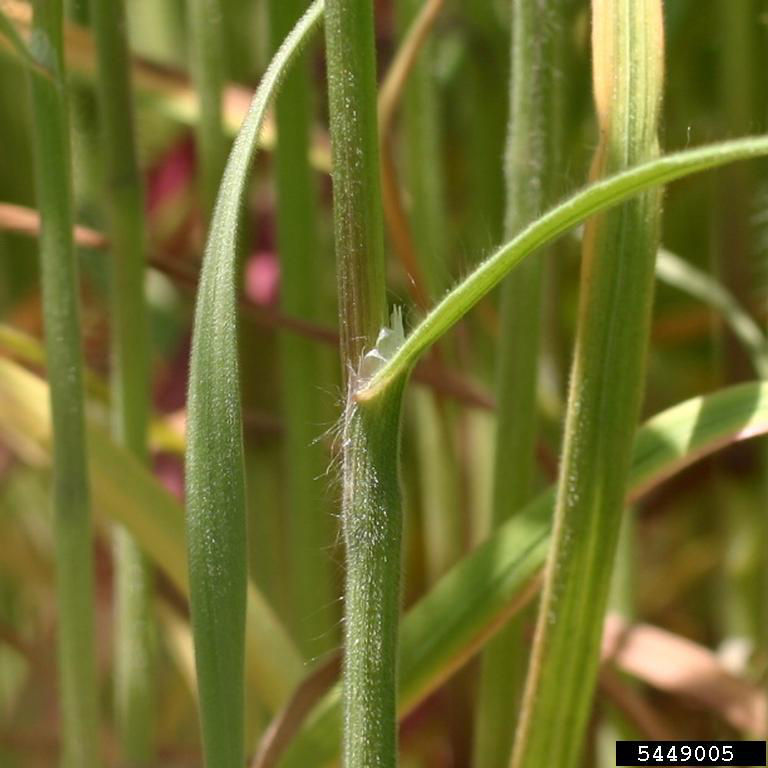
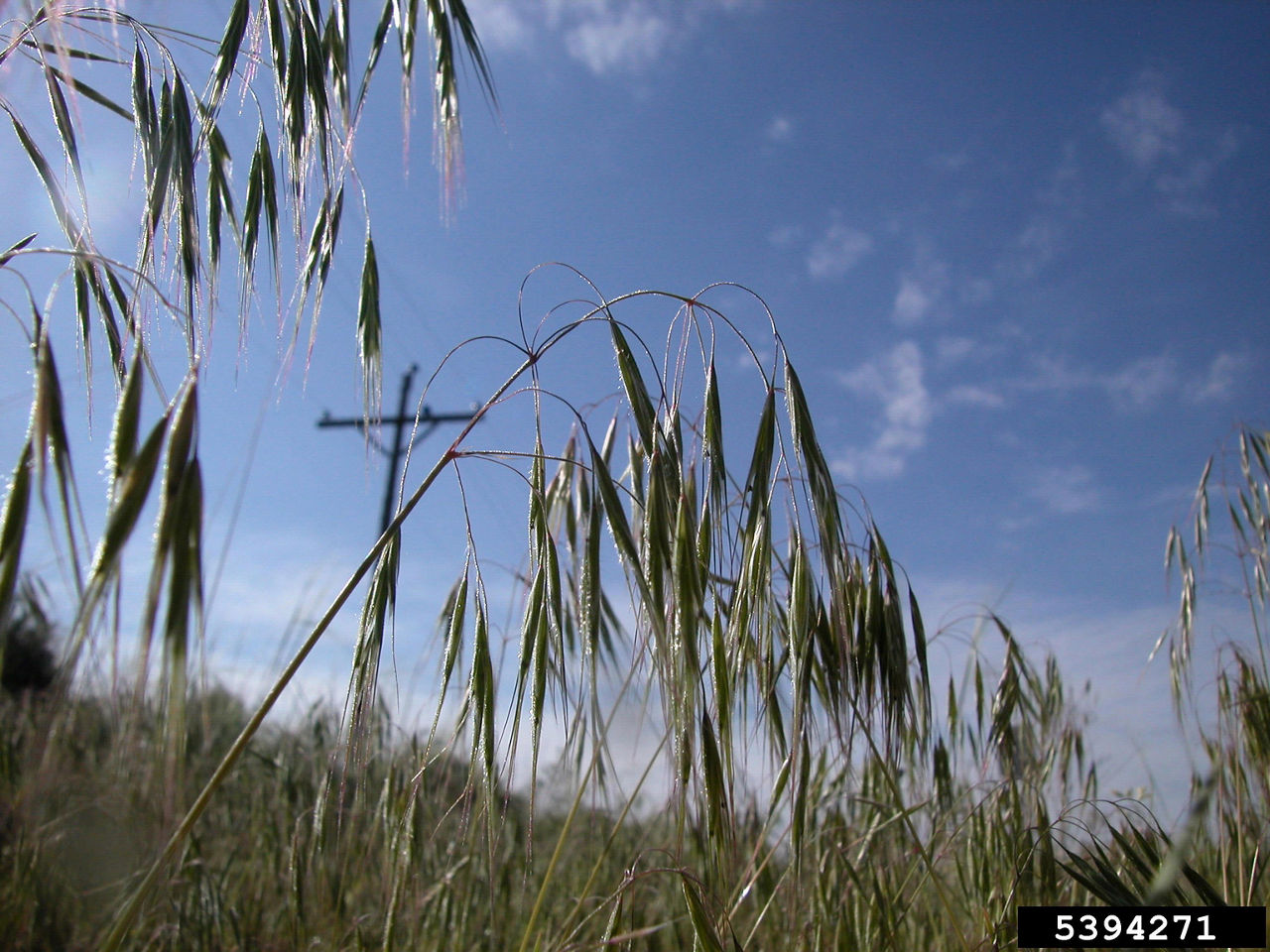
Identification: Downy brome is a tufted, erect, winter annual grass that can reach up to 2.5 feet in height with long, thin, twisted leaf blades from 1 to 9 inches in length (Figure 6). The ligule is a prominent membrane that may be toothed at the top. Stems are round and leaf blades are covered on both surfaces with dense, soft hairs (Figure 7). Leaf sheaths are also hairy. The seed head is a loose panicle with multiple, drooping, awned spikelets (Figure 8).
Similar Species: Downy brome is often confused with cheat (Bromus secalinus) but can be distinguished by the hairs on the leaf blades.
Management: Downy brome is best managed by integrating cultural and chemical control methods. Because downy brome is a prolific seed producer, minimizing seed sources can be an effective preventative control strategy. Crop rotation is one of the most effective control measures for downy brome because of the relatively short life span of seed in the soil (2 to 3 years). The key aspect of crop rotation for management of downy brome is to prevent any new seed production for at least 2 years between winter wheat crops. During this time, the seed bank will decline substantially as a result of germination, predation, and other forms of seed mortality.
Control of downy brome is relatively easy in corn and soybean with the use of tillage and/or preemergent burndown herbicide applications. However, downy brome is more difficult to manage in wheat, particularly winter wheat, and resistance to Group 2 (ALS inhibitors) herbicides has developed. Therefore, a multifaceted approach including crop rotation, enhanced crop competitiveness, and targeted herbicide applications should be used.
Sources:
Lane, T., Jha, P., Kittelman, E., Lewis, K., Roeder, B., Fulbright, J., and Good, A. 2018. Downy brome. MT201814AG. Montana State University Extension. http://msuextension.org
Summer Annual Grasses
Common name: Barnyardgrass
Scientific name: Echinochloa crus-galli L.
Life Cycle: Summer annual
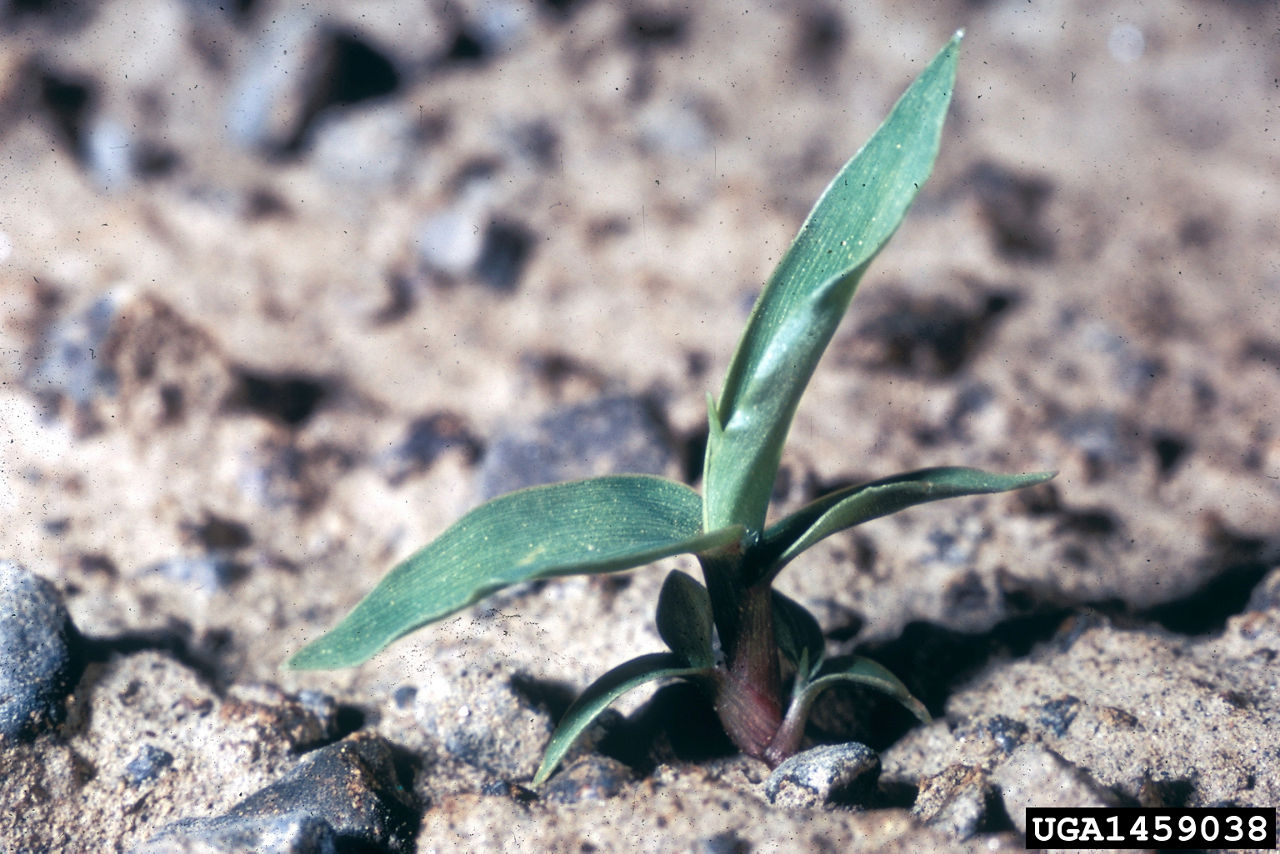
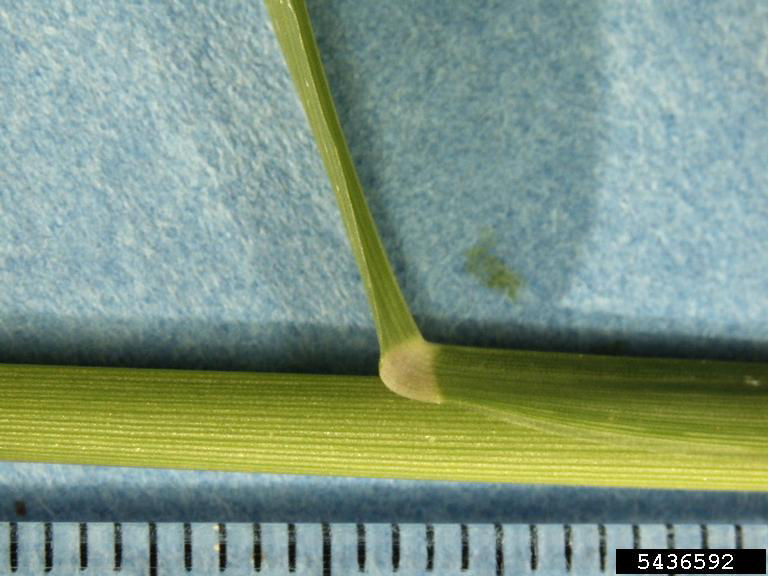


Identification: Barnyardgrass distribution ranges through much of the U.S. and is a weed of many agronomic crops, nurseries, landscape, and turf but is especially problematic in rice in the southern states. Barnyardgrass is a summer annual with thick stems that may reach 5 feet in height.
Seedlings are without hairs (glabrous), auricles, and ligules, and the leaf sheaths are often tinted red or maroon at the base (Figure 9). Leaves are rolled in the shoot, smooth and without ligules or auricles and have a distinct white midvein that becomes keeled toward the basal potions of the leaf (Figure 10) A few short hairs may occur at the leaf bases of mature plants. Stems are usually erect, thick, without hairs (glabrous), often branched at the lower nodes, and may be tinted red to maroon at the base (Figure 11). Seedheads are a terminal panicle ranging from 4 to 16 inches in length (Figure 12). Panicles may be green to purple in color and are comprised of individual spikelets that may develop a 2 to 10 mm long terminal awn.
Similar Species: Fall panicum (Panicum dichotomiflorum) and barnyardgrass are often confused prior to seedhead formation due to their similar growth habit and appearance. However, the characteristic absent ligule of barnyardgrass helps to distinguish this weed from most other grasses in both the seedling and mature stage of growth.
Management: Herbicide-resistant barnyardgrass is widespread in rice-growing regions. Resistance to Group 7 (Photosystem II inhibitors), Group 1 (ACCase inhibitors), and Group 4 (synthetic auxins) herbicides have been well documented in southern states. Many resistant populations are known to have multiple resistance.
Glyphosate reliably controls barnyardgrass. Furthermore, in areas where Palmer amaranth is a problem, barnyardgrass is often controlled as a result of chemistries utilized to manage glyphosate-resistant Palmer amaranth. Rotating crops and herbicide sites of action as well as utilizing residual herbicides are all excellent resistance management techniques.
Sources:
Bond, J. and Golden, B. March 29, 2016. Barnyardgrass management in Mississippi Delta. Mississippi Crop Situation. Mississippi State University Extension. http://mississippi-crops.com
Common name: Large crabgrass
Scientific name: Digitaria sanguinalis
Life cycle: Annual
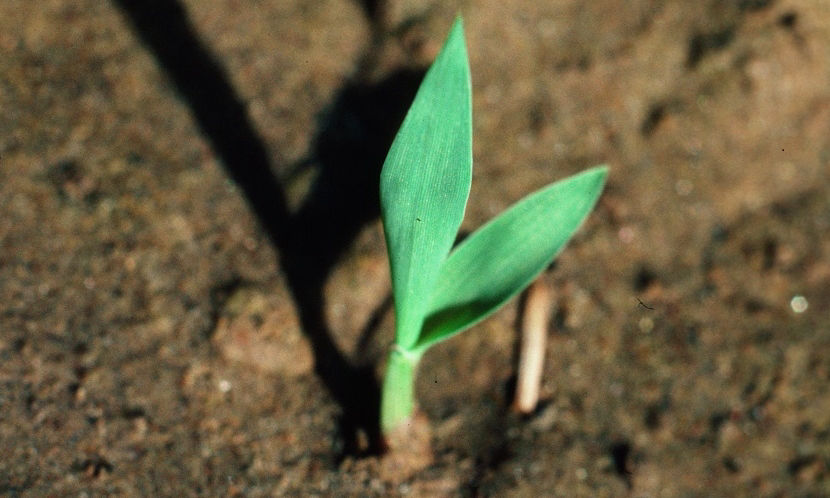
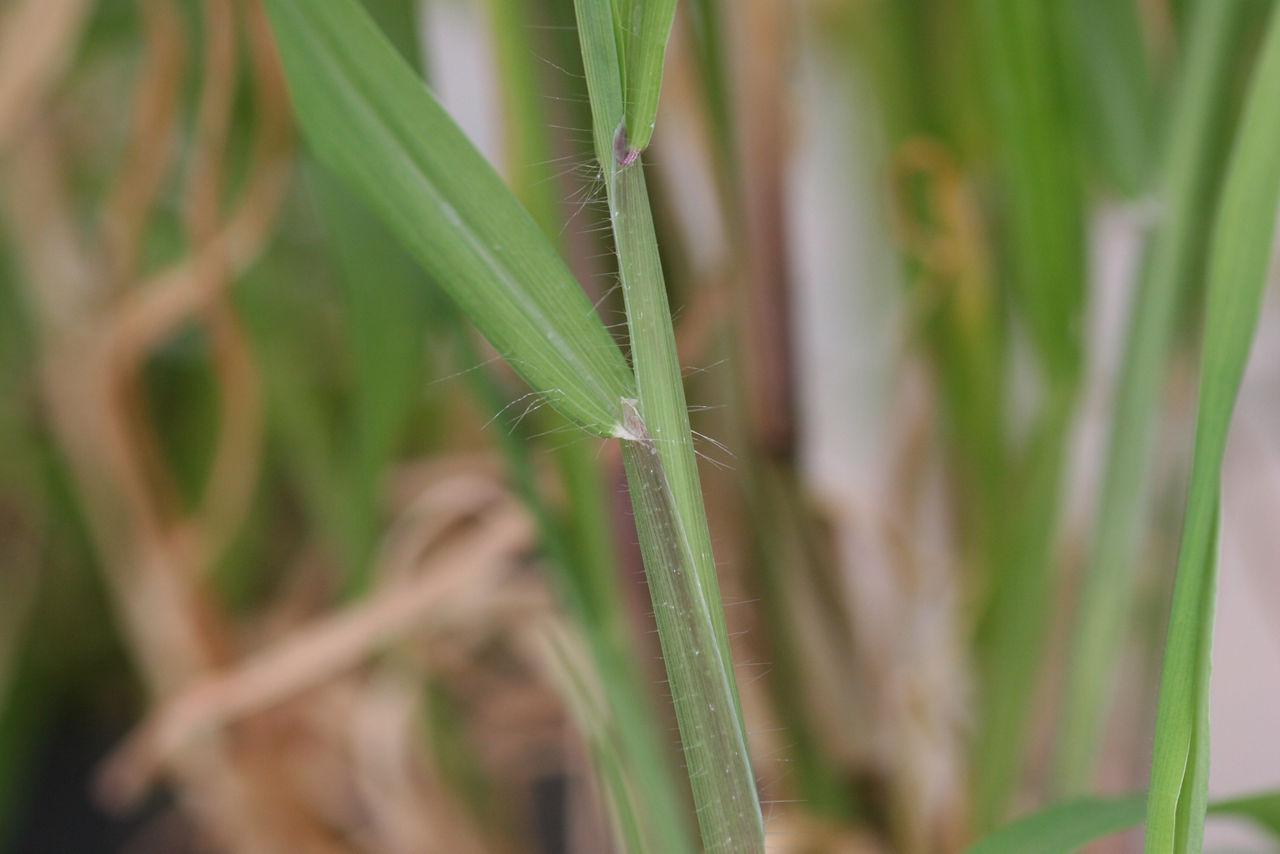
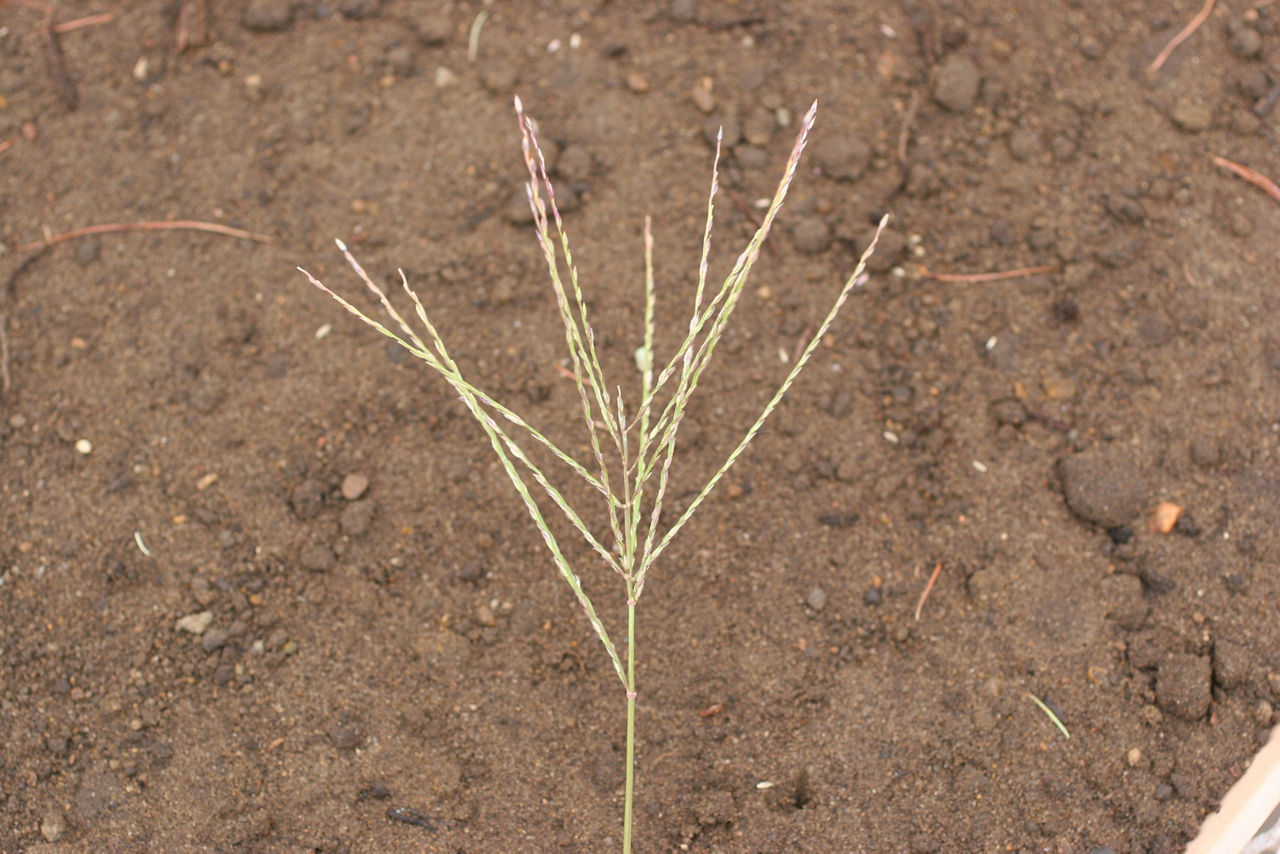
Identification: Large crabgrass is an annual weed with a prolific tillering or branching habit. It reproduces by seed and is problematic not only in row crops but also in pastures and home lawn environments.
Large crabgrass emerges later than most annual grass weeds and grows well under hot, dry conditions (Figure 13). Large crabgrass has a prostrate to ascending growth habit and is capable of rooting at the nodes. Both leaf surfaces and leaf sheath are densely hairy (Figure 14) The ligule is jagged and membranous. The seed head is a terminal panicle that consists of slender, finger-like branches arranged in a whorl (Figure 15).
Similar Species: Smooth crabgrass (Digitaria ischaemum) is a similar species to large crabgrass but differs by having hairless to sparsely hairy leaves and sheath, a tuft of long hairs at the collar region, and stems that do not root at the nodes.
Management: Due to late emergence patterns, preemergence herbicides don’t always provide season-long control. In corn, emerged crabgrass can be difficult to control. Glyphosate provides excellent control in glyphosate-tolerant corn and soybean products. In soybean, postemergence products also include foliar grass herbicides. Resistance to Group 1 (ACCase inhibitors) herbicides have been identified in some populations.
Common name: Fall panicum
Scientific name: Panicum dichotomiflorum
Life cycle: Annual
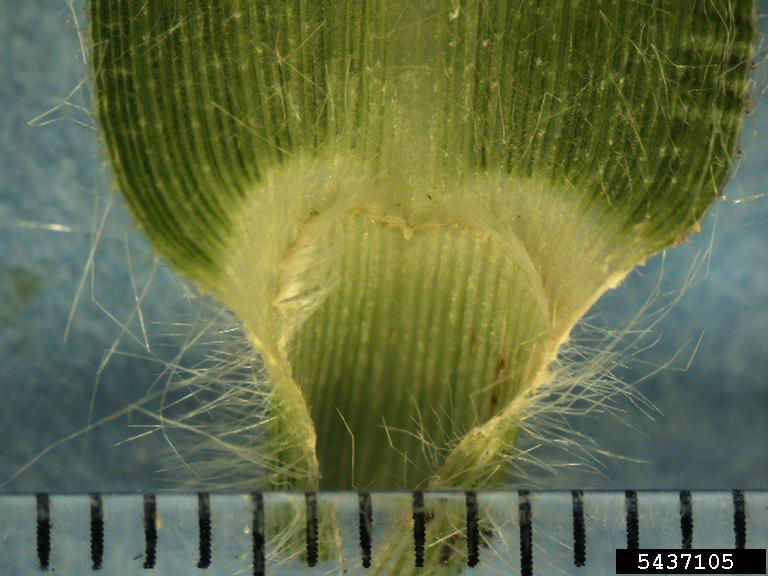
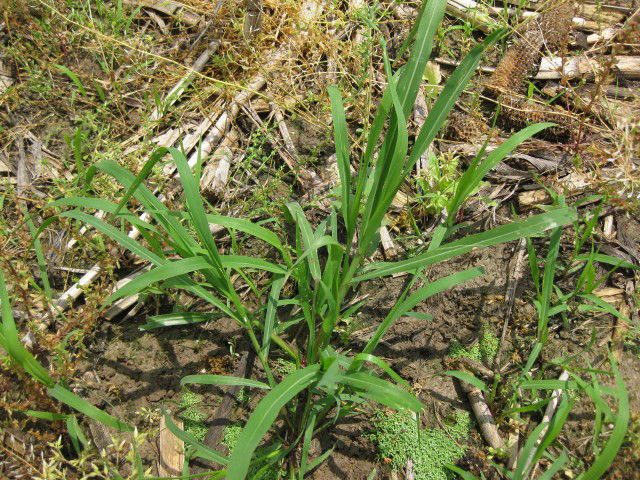
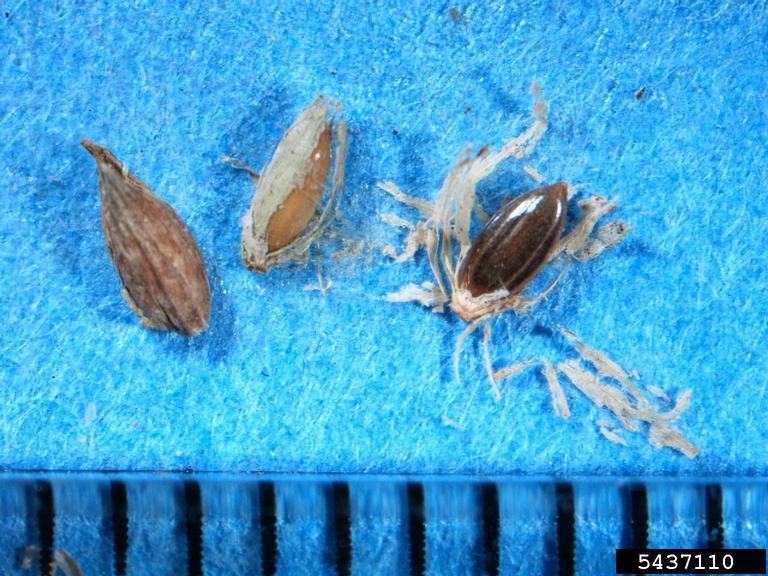
Identification: Fall panicum is a summer annual found throughout the United States. The seedling stage of fall panicum has hairs on lower leaf surfaces. Seedlings and mature plants have a hairy ligule that is up to ¼ inch long (Figure 16). As fall panicum matures, leaves become hairless or sparsely hairy with a prominent midvein (Figure 17). Fall panicum seed heads are wide, spreading panicles that develop a purplish tint when mature and yield small, straw-colored, oval seeds (Figure 18).
Similar Species: Fall panicum is most often mistaken for barnyardgrass and Johnsongrass prior to seedhead formation. Barnyardgrass also has a similar growth habit but it lacks a ligule. Johnsongrass has a similar growth habit but is a rhizomatous perennial, and its mature ligule is topped with a fringe of hair.
Management: Fall panicum is easily controlled in soybean. Earlier planting dates may improve crop canopy development to help suppress fall panicum infestations. Fall panicum seedlings are also readily controlled with tillage. Postemergence control of fall panicum in corn is difficult and must be timely; herbicide applications must be made to small plants to be effective.
Sources:
Spaunhorst, D. and Bradley, K. September 1, 2011. Weed of the month: fall panicum. Integrated Pest Management. University of Missouri. http://ipm.missouri.edu
Common name: Giant foxtail
Scientific name: Setaria faberi
Life cycle: Annual

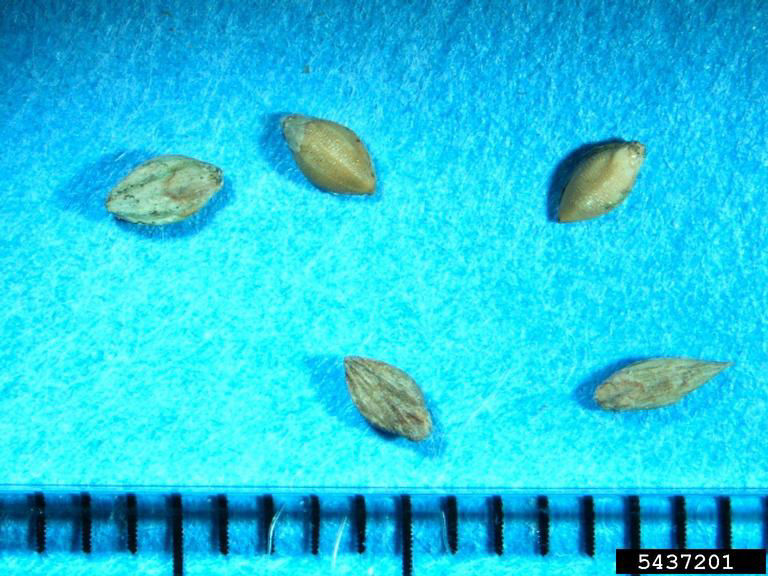

Identification: Giant foxtail is a summer annual that is problematic throughout most of the United States, especially in the northern and eastern corn growing region. It has a round stem, hairy ligule, and distinctive fuzzy seed head with a nodding appearance (Figure 19). Yellow foxtail and green foxtail closely resemble giant foxtail in general characteristics – ligule, growth habit, habitat, and reproductive characteristics. Giant foxtail is the largest of the three species and its seedlings and mature plants have numerous short hairs on the upper surface of the blades and on the margin of the sheaths.
Giant foxtail begins germinating in the spring. The emergence period for giant foxtail is lengthy and its seeds can emerge from shallow soils (Figure 20).
Management: Giant foxtail has developed resistance to Group 1 (ACCase inhibitors), Group 2 (ALS inhibitors), and Group 5 (PSII inhibitors) sites of action. Using cultural practices along with chemical control diversifies management and reduces the risk of developing herbicide resistance.
To manage giant foxtail, start with tillage or burndown herbicides. Apply postemergence herbicides early when plants are young (4 inches or less). Use multiple sites of action for both pre-and postemergence herbicide applications to help manage resistance development.
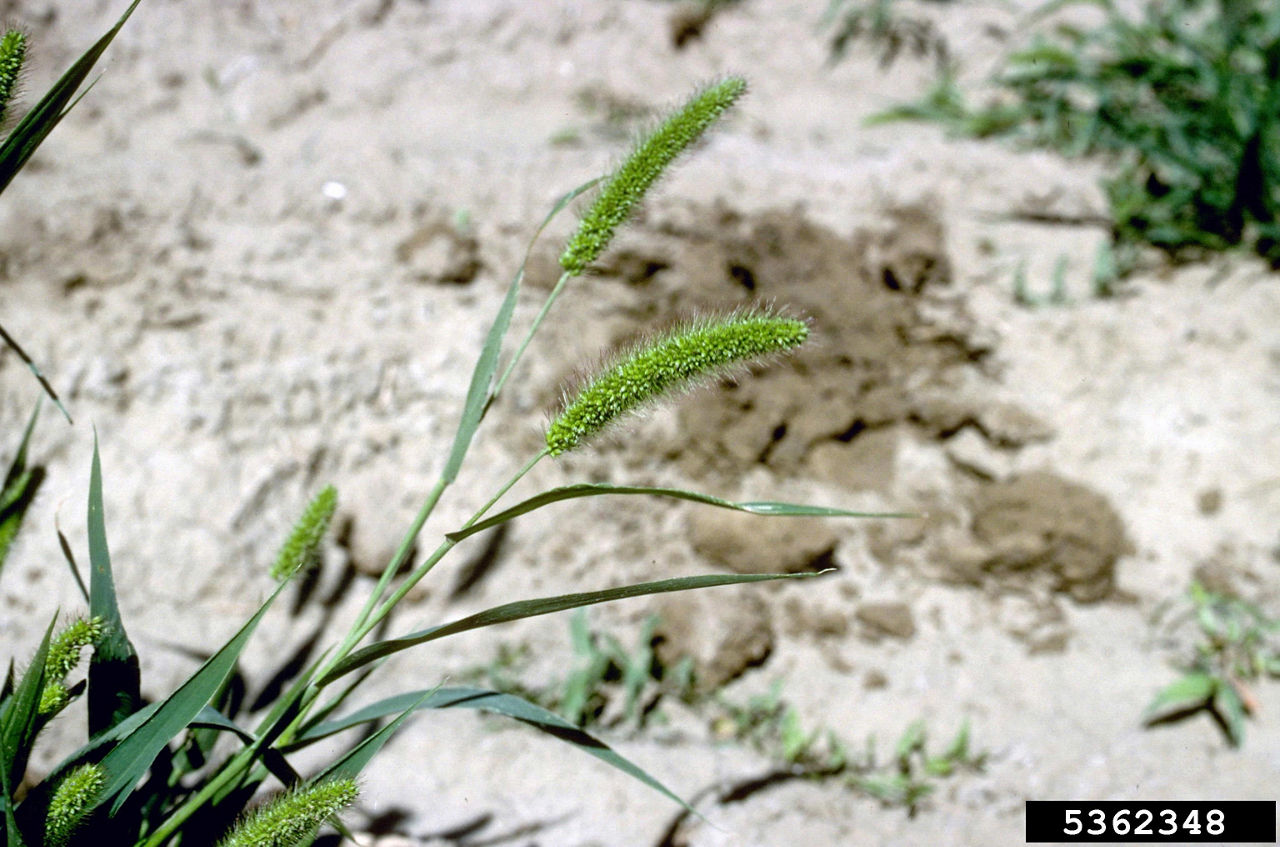
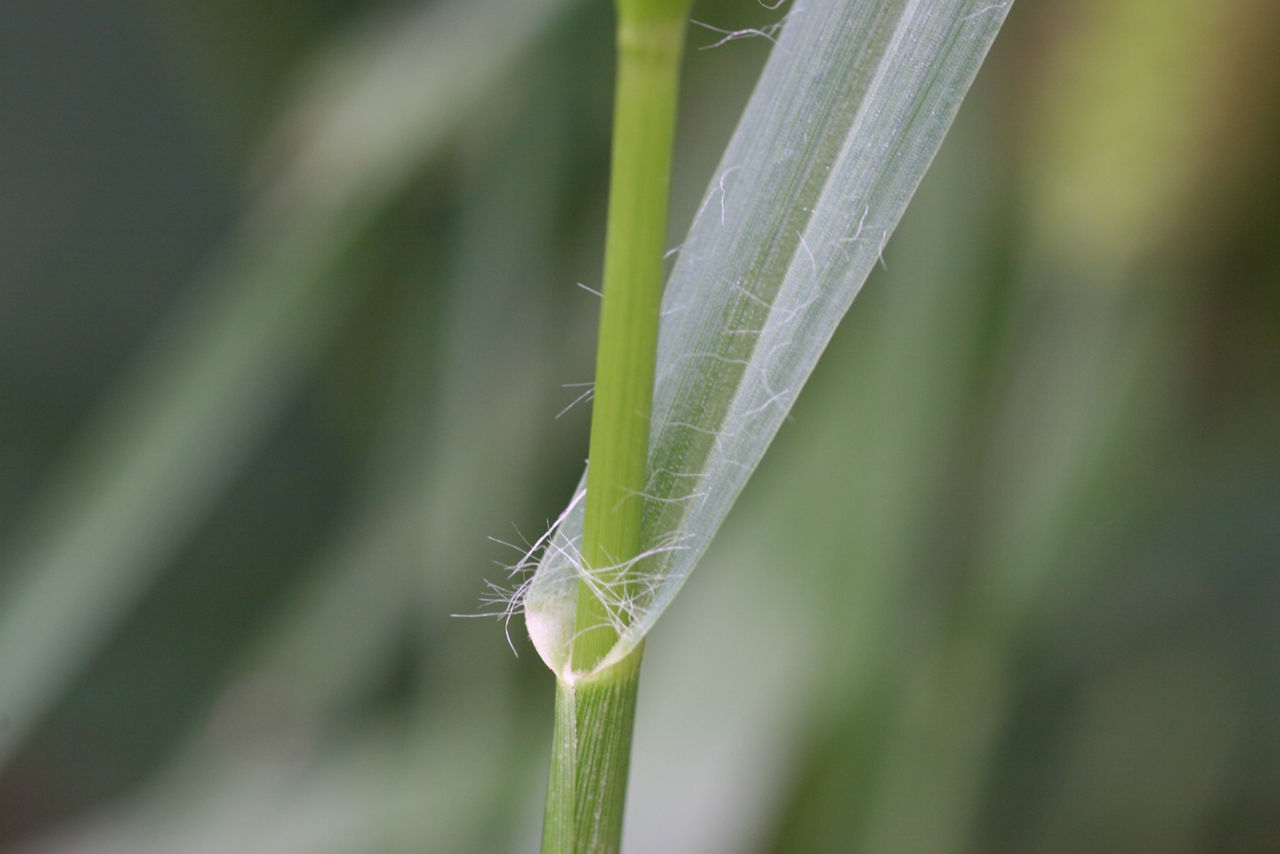
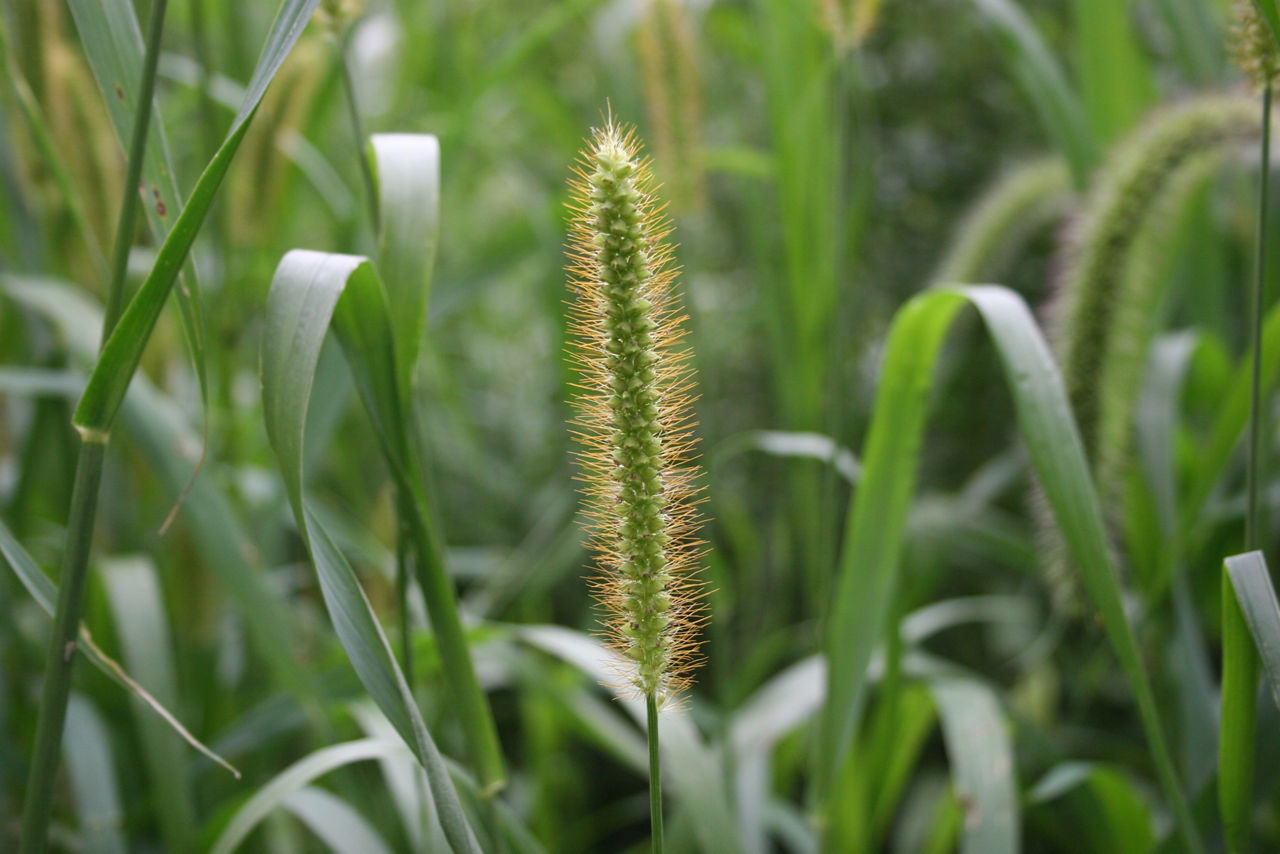
Similar species: green foxtail (Setaria viridis) and yellow foxtail (Setaria pumila) both have similar characteristics to giant foxtail. All are summer annuals and form the distinctive, fuzzy, foxtail seed head. Each grows upright and have a ligule that is a fringe of hairs. While it can be challenging to distinguish the foxtails, each species has unique characteristics that aid in identification.
Both green and yellow foxtail have narrower leaf blades compared to giant foxtail. Green foxtail has a smooth upper leaf surface (Figure 21), while yellow foxtail has a smooth upper leaf except for prominent, scattered, long hairs near the collar (Figure 23). Yellow foxtail has flat leaf sheaths with a reddish-purple tint at the base. Green and giant foxtail both have round leaf sheaths. The leaf sheath of green foxtail is lined with small hairs while that of giant foxtail is smooth.
One of the most distinguishing features is the color and size of the seed head. Yellow foxtail seed heads turn yellowish-brown at maturity and are more compact compared to green or giant foxtails. Green foxtail seed heads are green or purple-tinted and do not droop in the arch shape like giant foxtail (Figures 22 and 24).
Sources:
Bradly, K. May 19, 2014. Weed of the month: the foxtails, similar yet different. Integrated Pest Management. University of Missouri. http://ipm.missouri.edu.
Johnson, B. April 2019. Giant foxtail management in soybeans. Take Action Herbicide Resistance Management. http://iwilltakeaction.com
Perennial Grasses
Common name: Johnsongrass
Scientific Name: Sorghum halepense
Life Cycle: Perennial
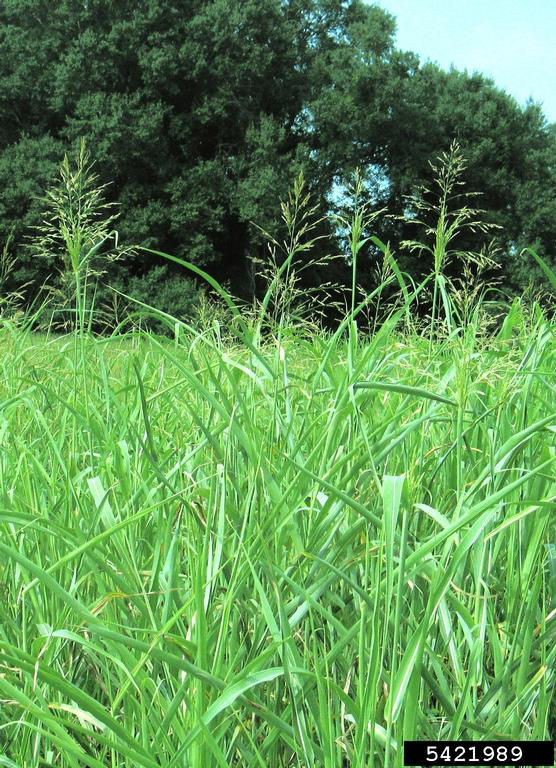

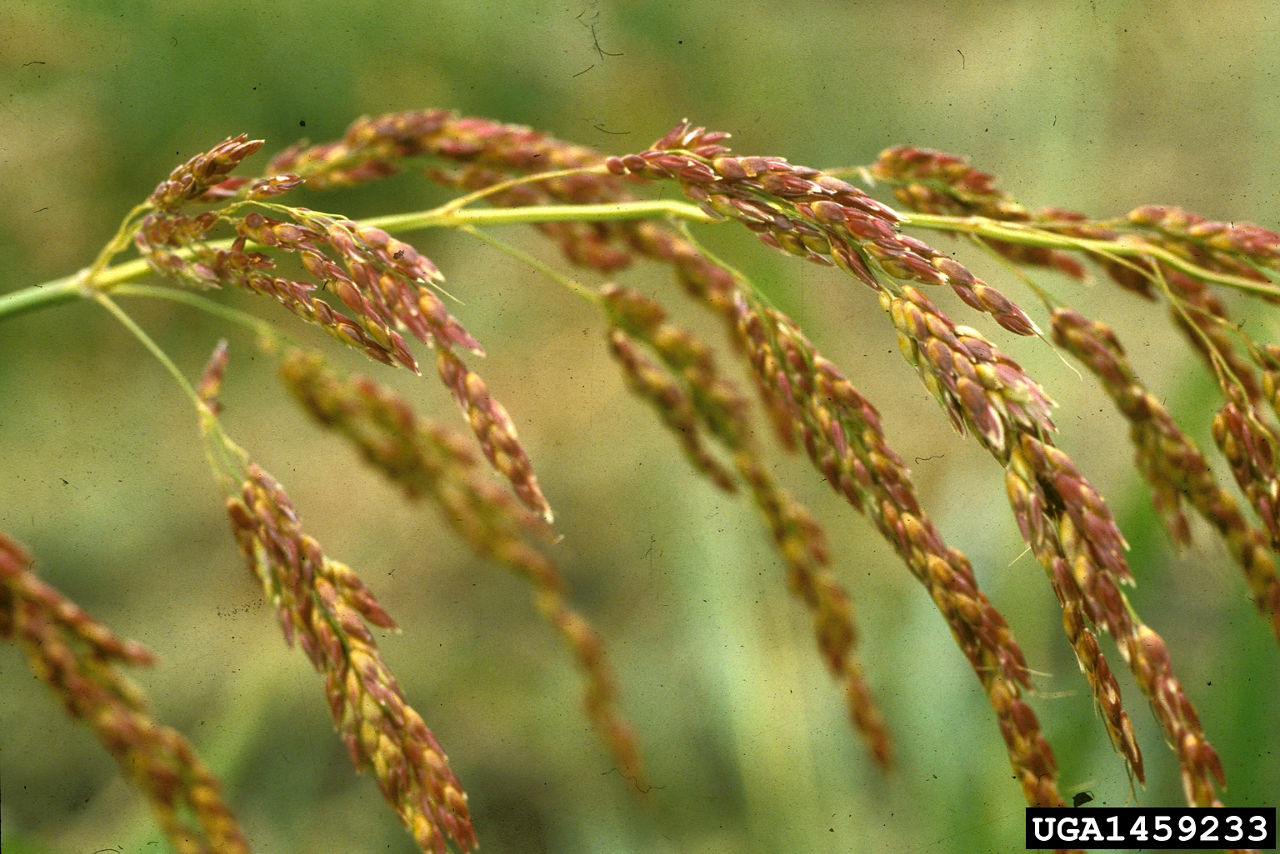
Identification: Johnsongrass is a noxious weed in many states and can be problematic in all Midsouth states. Johnsongrass is a perennial, warm-season grass that grows from seed and rhizomes. Leaves are bright green, hairless, with a prominent midvein (Figure 25). Leaf sheaths are also hairless. Johnsongrass has a very prominent, jagged, membranous ligule (Figure 26). Plants can reach 2 to 7 feet in height and have a loosely spreading or open, coarse, purplish panicle (Figure 27). Plants emerging from seed are capable of producing rhizomes in 3 to 4 weeks.
Management: Best management practices to control Johnsongrass require efforts to control plants that emerge from seed and rhizomes. Johnsongrass is generally more difficult to control in corn than soybean. Johnsongrass can emerge before planting and new plants are likely to emerge after planting. Those present at planting should be managed with a burndown herbicide application or tillage. Soil residual herbicides can help suppress Johnsongrass emerging from seed but will be ineffective on that emerging from rhizomes. An effective postemergence herbicide should also be applied. Some Johnsongrass populations have developed resistance to glyphosate and Group 1 (ACCase inhibitor) herbicides. To reduce the potential for resistance, it is important to rotate between herbicide sites of action. Crop rotation including corn will also allow the use of Group 2 (ALS inhibitor) site-of-action products.
Similar species: Shattercane (Sorghum bicolor) is a summer annual grass species that can resemble Johnsongrass and corn plants. It has smooth, waxy leaves, a membranous ligule, and reaches 4 to 8 feet in height at maturity. Being an annual species, it does not have rhizomes like Johnsongrass. Shattercane and Johnsongrass seeds are similar: football- to egg-shaped and dark reddish-brown to black. Some shattercane populations have confirmed resistance to Group 2 (ALS inhibitor) herbicides.
Sources:
2018. Shattercane. Sorghum bicolor. Weed ID Guide. Division of Plant Sciences. University of Missouri. http://weedid.missouri.edu.
Common name: Quackgrass
Scientific Name: Elymus repens
Life Cycle: Perennial
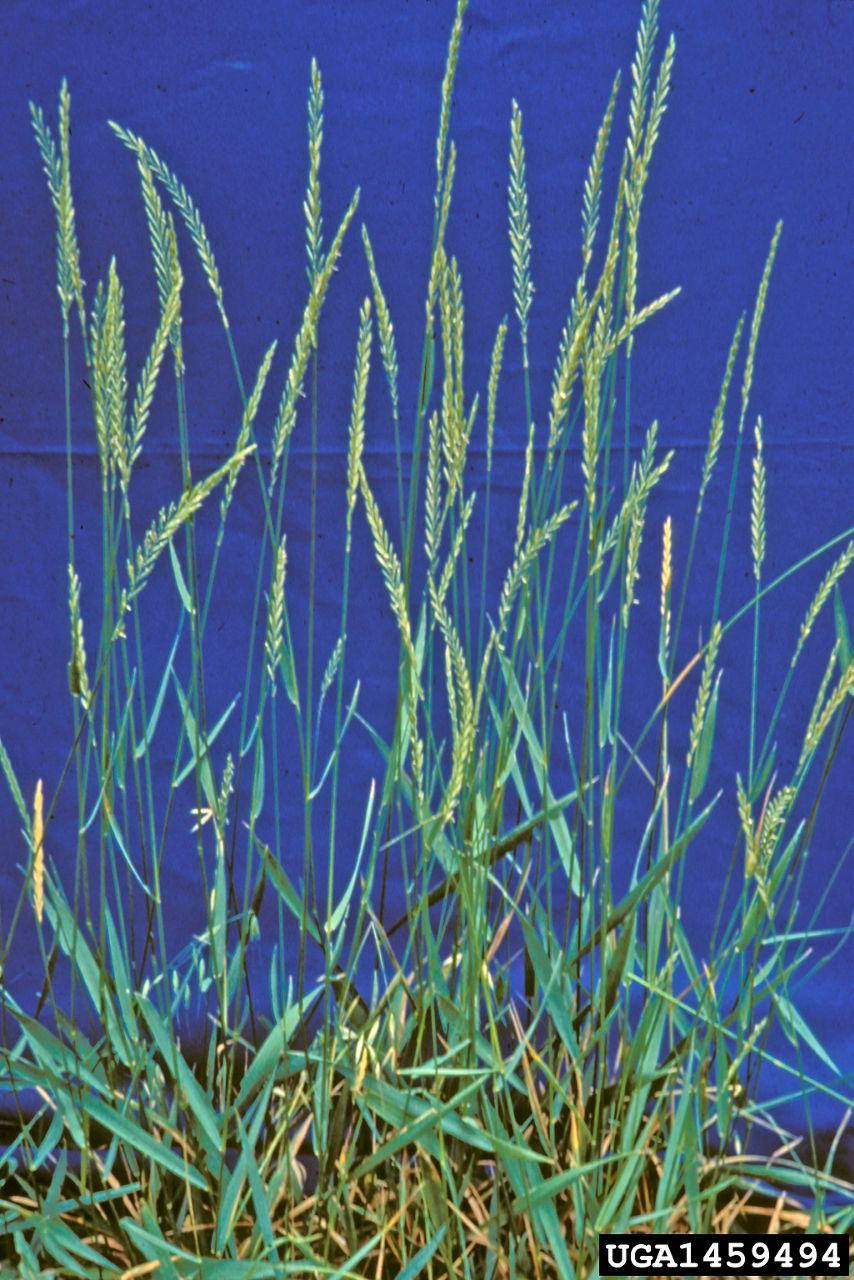
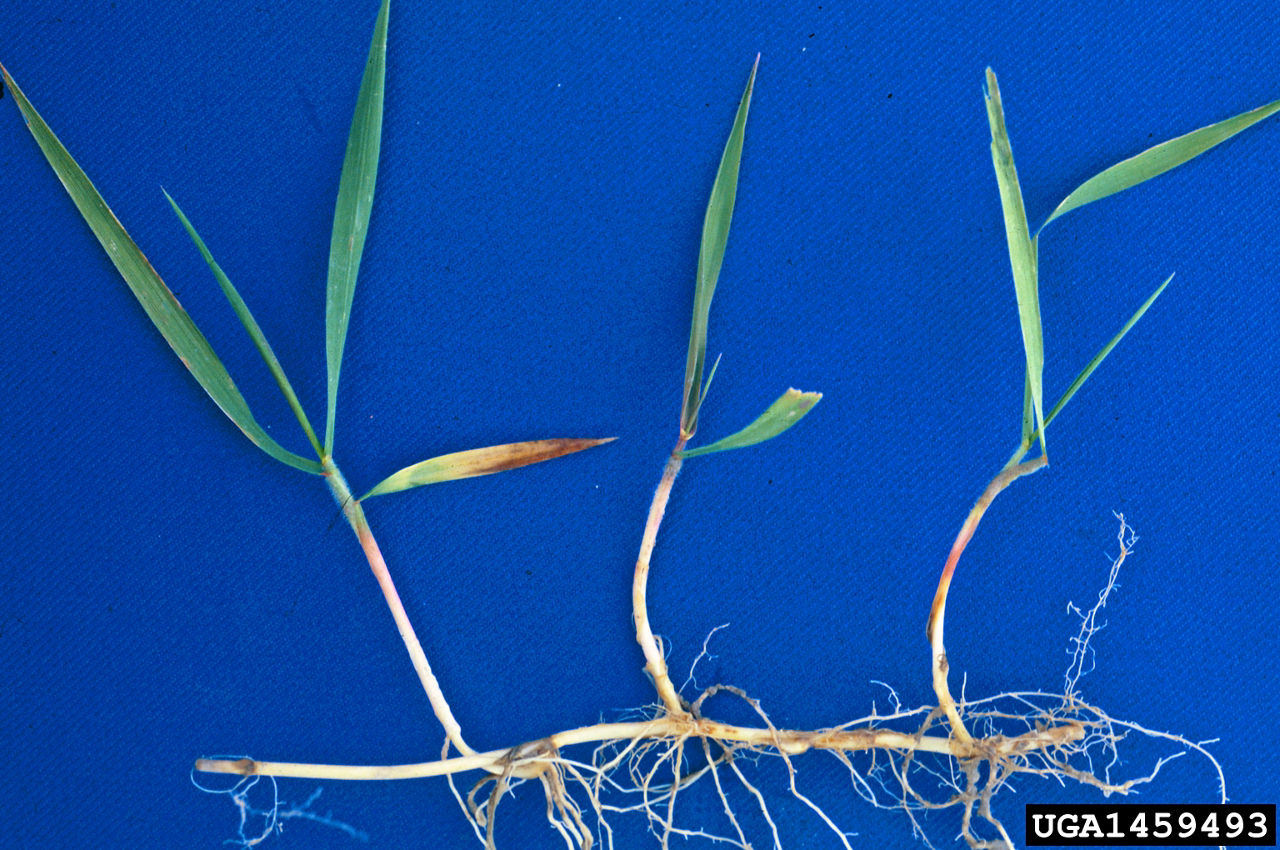
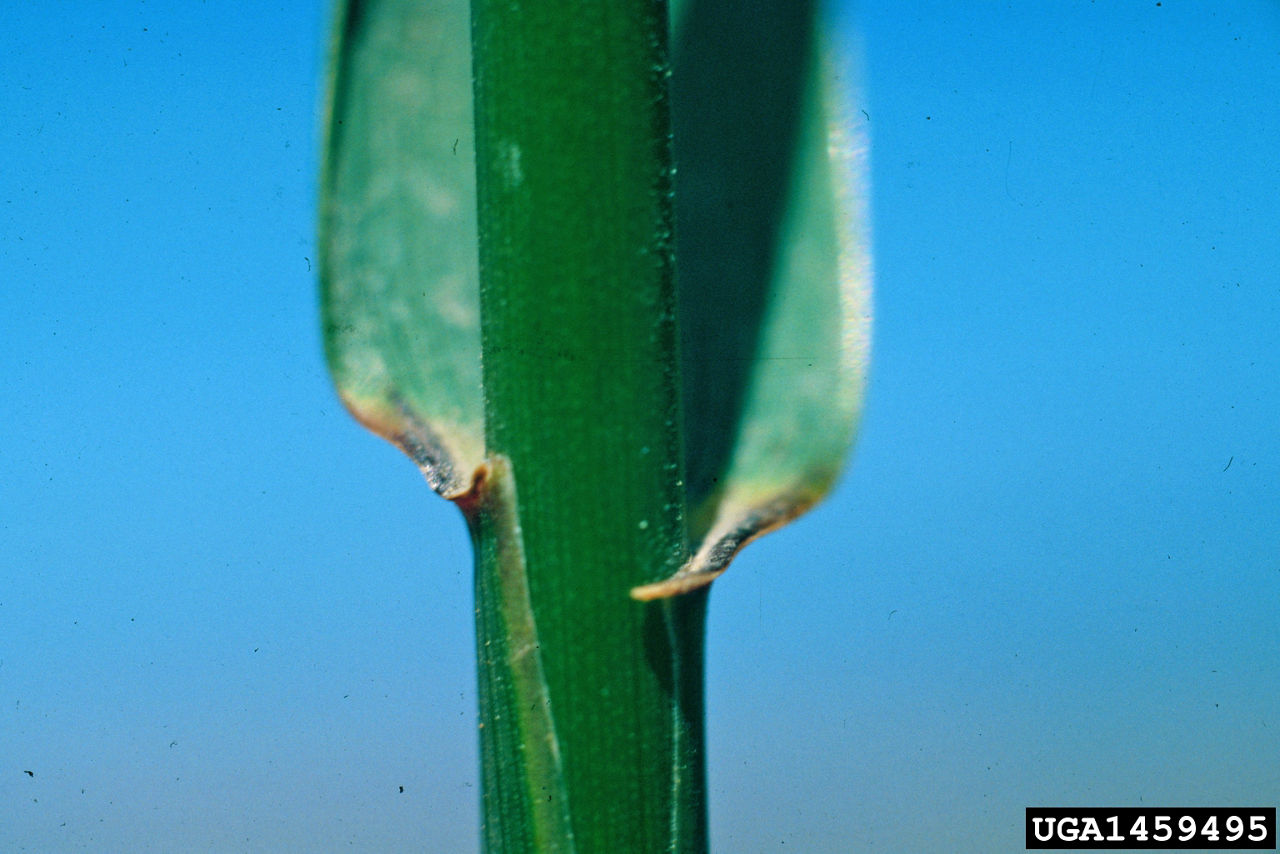
Identification: Quackgrass is a cool-season perennial with the potential to cause problems in several crops. Quackgrass stands erect up to 4 feet tall and can have many tillers (Figure. 28). Distinguishing features include pointed, yellowish-white rhizomes and a pair of clasping, claw-like auricles that are present at the collar region (Figures 29 and 30). The seedhead is a 2- to 10-inch long, slender, spike made up of several alternating spikelets arranged in two rows along the stem. Individual spikelets have prominent awns.
Management: The creeping rhizomes make quackgrass difficult to control. Severed rhizomes can produce new plants, so mowing or tillage does not prevent regrowth.
An integrated management plan combining preventative, cultural, and chemical control methods should be employed to control quackgrass competition with crops. Several different herbicides can be used for quackgrass control. A key to successful management is proper herbicide timing. Quackgrass is generally most vulnerable to an herbicide application when it is actively growing during late spring or early fall.
Sources:
Curran, W. and Ligenfelter, D. September 2, 2017. Quackgrass management: an integrated approach. Agronomy Facts 5. Penn State Extension. http://extension.psu.edu
Common name: Wirestem muhly
Scientific Name: Muhlenbergia frondosa
Life Cycle: Perennial
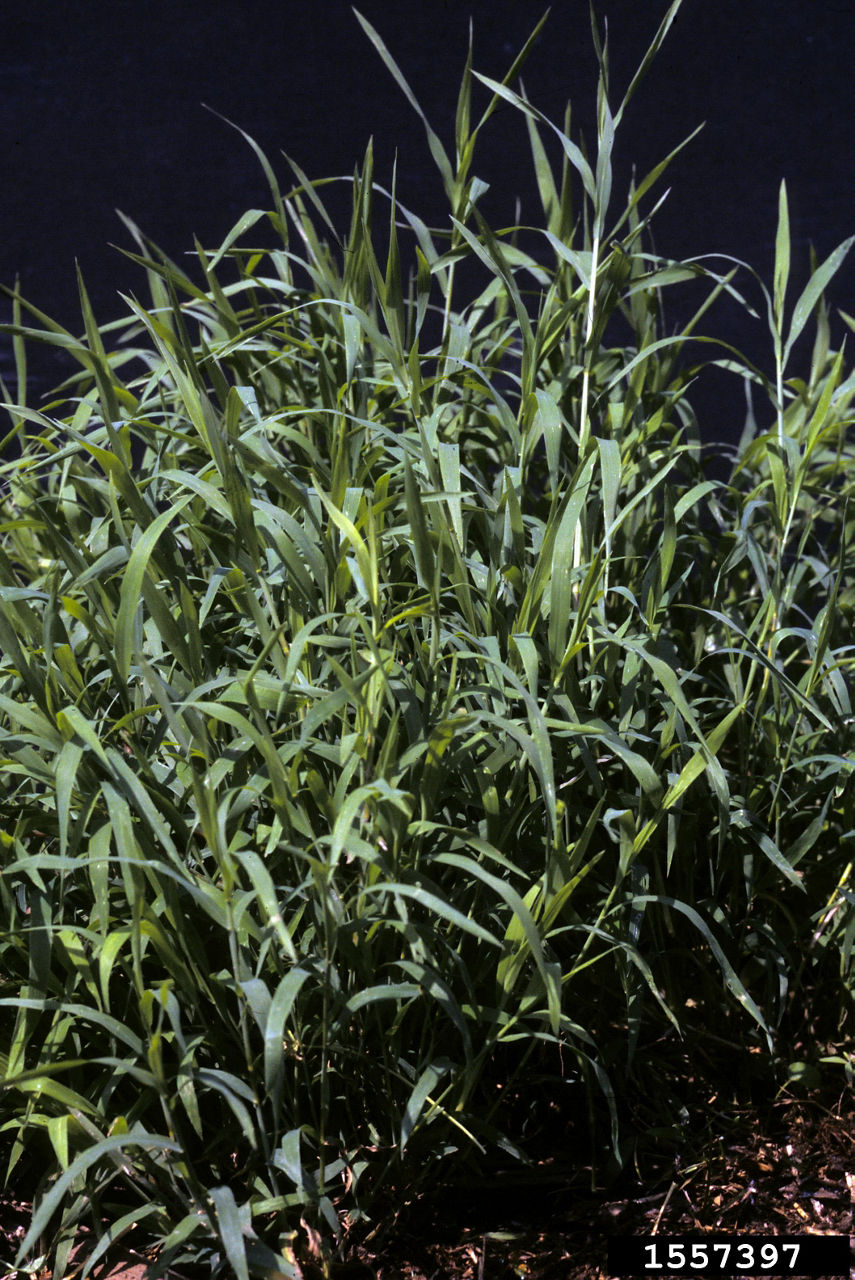
)
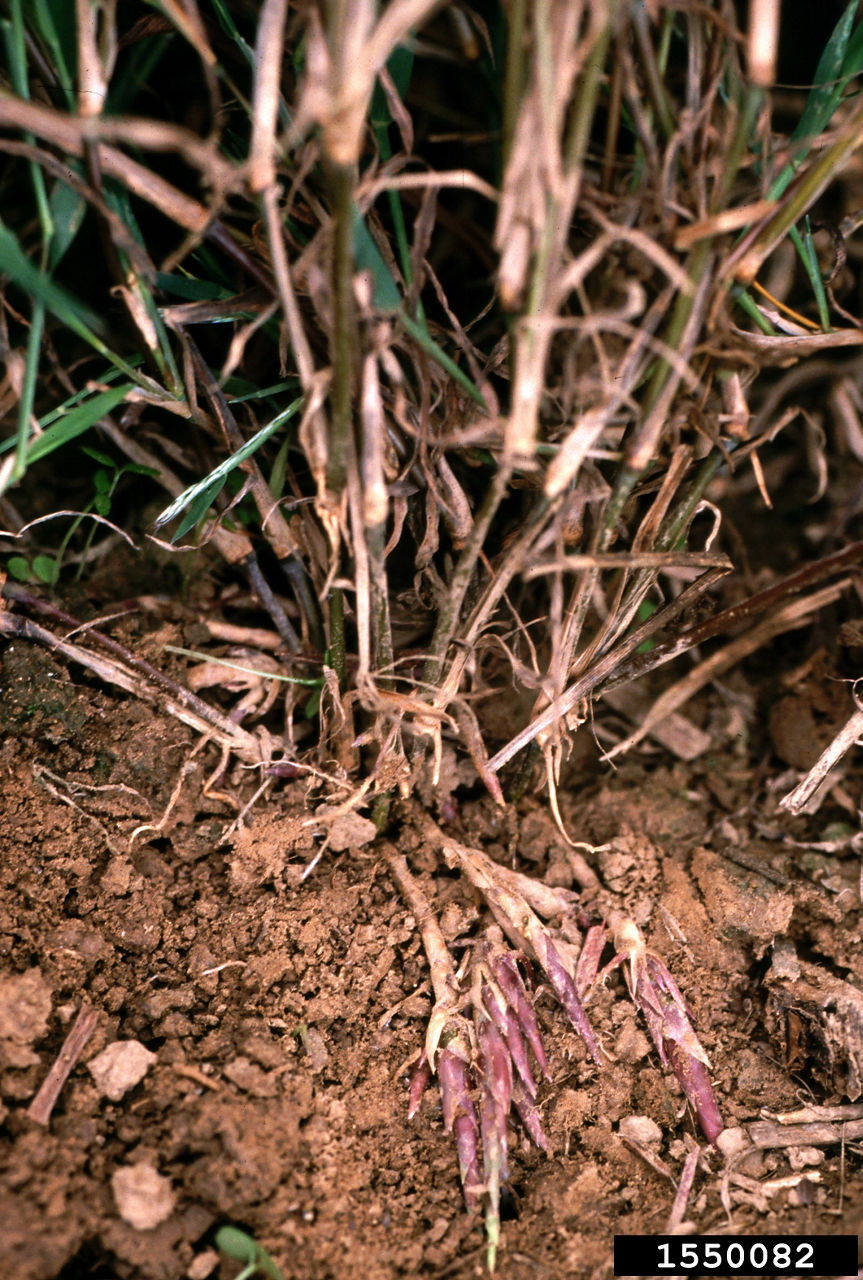
Identification: Wirestem muhly is a warm-season perennial grass that can be of concern in corn and soybean, especially in conservation tillage systems. Wirestem muhly has round stems with bushy growth up to 3 feet tall (Figure 31). Leaves are rolled in the bud and the leaf blade is relatively short, hairless, and usually rough. The leaf sheath is smooth and rounded with overlapping margins. The ligule is membranous, jagged, and short. The stems of wirestem muhly are branched and stiff, giving the plant a wiry appearance. Stems often form roots at the nodes when they contact soil. Narrow panicles are produced at the end of stems and also in leaf axils (Figure 32). Flowers change from soft green to brown purple as they mature.
Wirestem muhly produces abundant seed and has an extensive underground root system of short, thick, scaly rhizomes (Figure 33). Both rhizomes and seed are capable of spreading and initiating new infestations and if left unchecked, populations can become very dense, aggressive, and capable of reducing crop yield potential.
Similar Species: Wirestem muhly can be confused with quackgrass. However, quackgrass can be distinguished by its smooth, pointed rhizomes and long, claw-like auricles, which are not present on wirestem muhly.
Management: A combination of preventative, cultural, mechanical, and chemical control methods are needed for effective management. To prevent infestations into crop fields, wirestem muhly should be controlled in fence rows, ditch banks, and other non-crop areas to reduce sources of weed seed. Tillage equipment should be cleaned after working in infested fields to avoid further spread of rhizomes. When possible, vigorous tillage when wirestem muhly growth begins in spring followed by a timely postemergence herbicide application can help reduce the severity of wirestem muhly. However, once established, tillage alone may not provide adequate control. Tillage disrupts and fragments the root system, allowing for better control of smaller root segments by a systemic herbicide. However, infrequent cultivation can exacerbate wirestem muhly by breaking up rhizomes but leaving them buried where they can form new plants. In no-till systems, crop rotation and timely herbicide applications are critical for managing wirestem muhly. Sound agronomic practices (fertility, product selection, crop rotation, etc.) also provide a good foundation for crop growth and competition with wirestem muhly.
There are several herbicide options for control of wirestem muhly in corn and soybean. Unlike quackgrass, which is a cool-season perennial, wirestem muhly is a warm-season species and begins its growth in the late spring and early summer. Early-season burndown applications that are typical prior to corn and soybean planting are not as effective and delaying crop planting until mid-June is not typically practical unless planting double-crop soybeans. Glyphosate provides good control of wirestem muhly when applied during the summer months. Postemergence herbicides should be applied when wirestem muhly is 8 to 10 inches tall and sequential applications may be needed for improved control.
Sources:
Ligenfelter, D.D. and Curran, W.S. September 12, 2017. Wirestem muhly management in agronomic crops. Agronomy Facts 61. Penn State Extension. http://extension.psu.edu
Wirestem muhly (Muhlenbergia frondosa). Ohio Perennial and Biennial Weed Guide. The Ohio State University. http://oardc.ohio-state.edu/weedguide.
Common name: Yellow nutsedge
Scientific Name: Cyperus esculentus
Life Cycle: Perennial
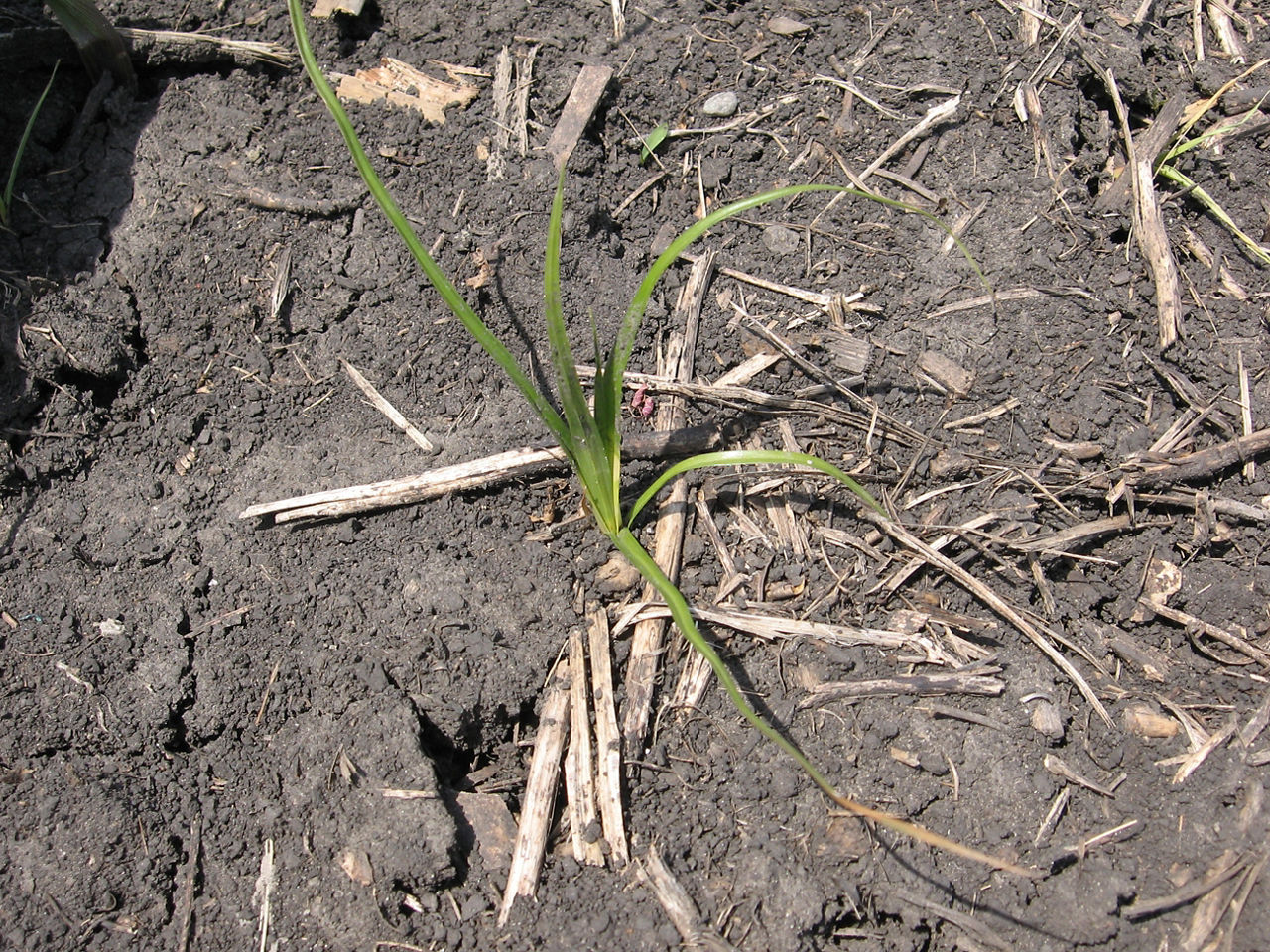

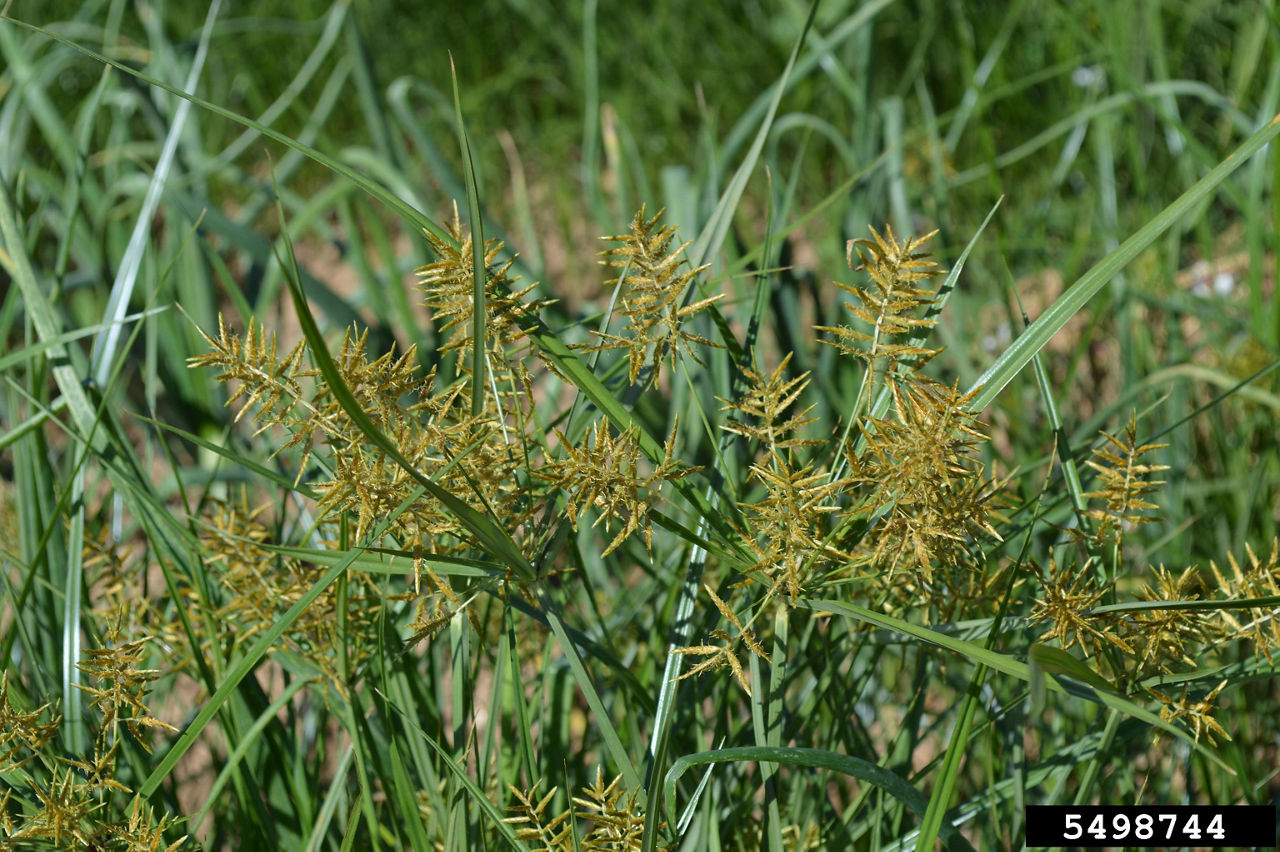
Identification: Yellow nutsedge, a problem perennial weed in field crops throughout the U.S., is a member of the sedge family but often mistaken for a grass because of its narrow grass-like leaves. However, it is easily distinguished from grasses by its triangular stem, which is free from nodes. The leaves are shiny, yellow-green, and hairless in groups of three at the base of the plant (Figure 34). Yellow nutsedge reproduces by small, underground tubers, called nutlets, that form at the end of rhizomes (Figure 35).It can also spread by rhizomes. Yellow nutsedge produces a seed head as a cluster of yellow-brown spikes at the tip of its stem; however, seeds rarely germinate (Figure 36).
Management: Yellow nutsedge is troublesome; however, competitive crops like corn and soybean can usually outgrow and shade yellow nutsedge except in the case of a severe infestation. An integrated program combining growth suppression from tillage, cultivation, and herbicides followed by shading from competitive crops can be effective in managing yellow nutsedge. Soil clumps containing tubers and rhizomes can be spread by tillage and harvest equipment, so these should be cleaned before moving to an uninfested field. Many herbicides are available for sedge control, but proper application timing is critical to optimize control.
Sources:
Yellow nutsedge. Department of Plant, Soil, and Microbial Sciences. Weeds. Michigan State University. http://www.canr.msu.edu/weeds.
Winter Annual/Biennial Broadleaf Weeds
Winter annual weeds can become a major problem in crop production when not controlled in the fall or early spring, especially in no-till systems. Winter annual weeds typically emerge from late summer through fall, can overwinter, and then flower to set seed in the spring/early summer. Seedling winter annual weeds can be difficult to distinguish from other weeds, particularly if they are in the same family (Table 2). Many fall-emerging broadleaf weeds have a rosette growth stage such as dandelion, horseweed, prickly lettuce, shepherd’s purse, and other members of the Brassicaceae, making identification more difficult.
The impact of winter annual weeds in cropping systems is sometimes overlooked because these weeds typically complete most of their life cycle prior to or shortly after corn and soybean planting. Dense mats of winter annual weeds may delay soil warming in spring, compete for water and nutrients, and interfere with crop planting. Winter annual weed species are hosts for some pests (Table 3). Henbit and purple deadnettle are hosts for soybean cyst nematode.
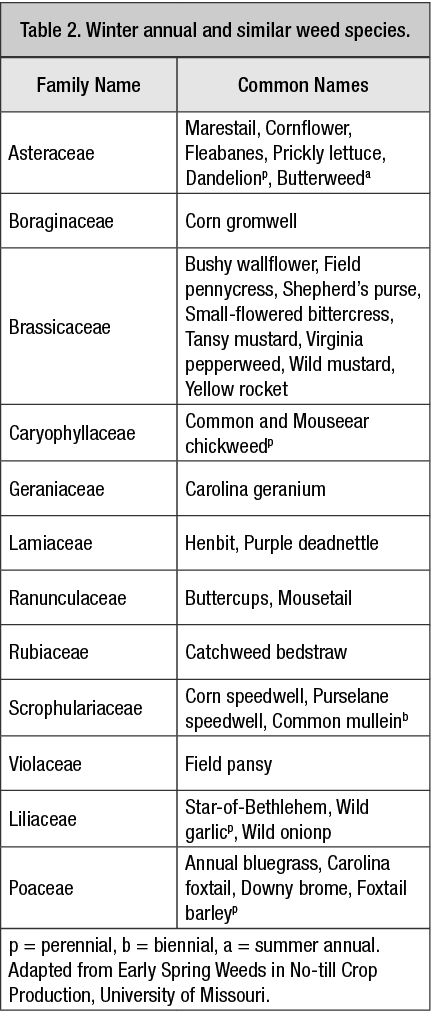
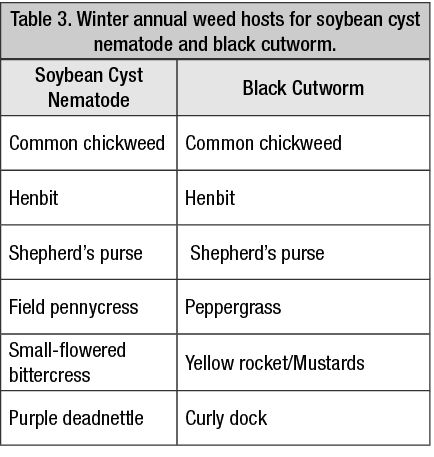
Proper identification can help focus weed management decision making. Selecting the right herbicides and proper application timing can influence performance. Common winter annual broadleaf weeds in the Midwest include: marestail, henbit, purple deadnettle, shepherd’s purse, field pennycress, prickly lettuce, and chickweed.
Common name: Common chickweed
Scientific name: Stellaria media
Life Cycle: Winter annual
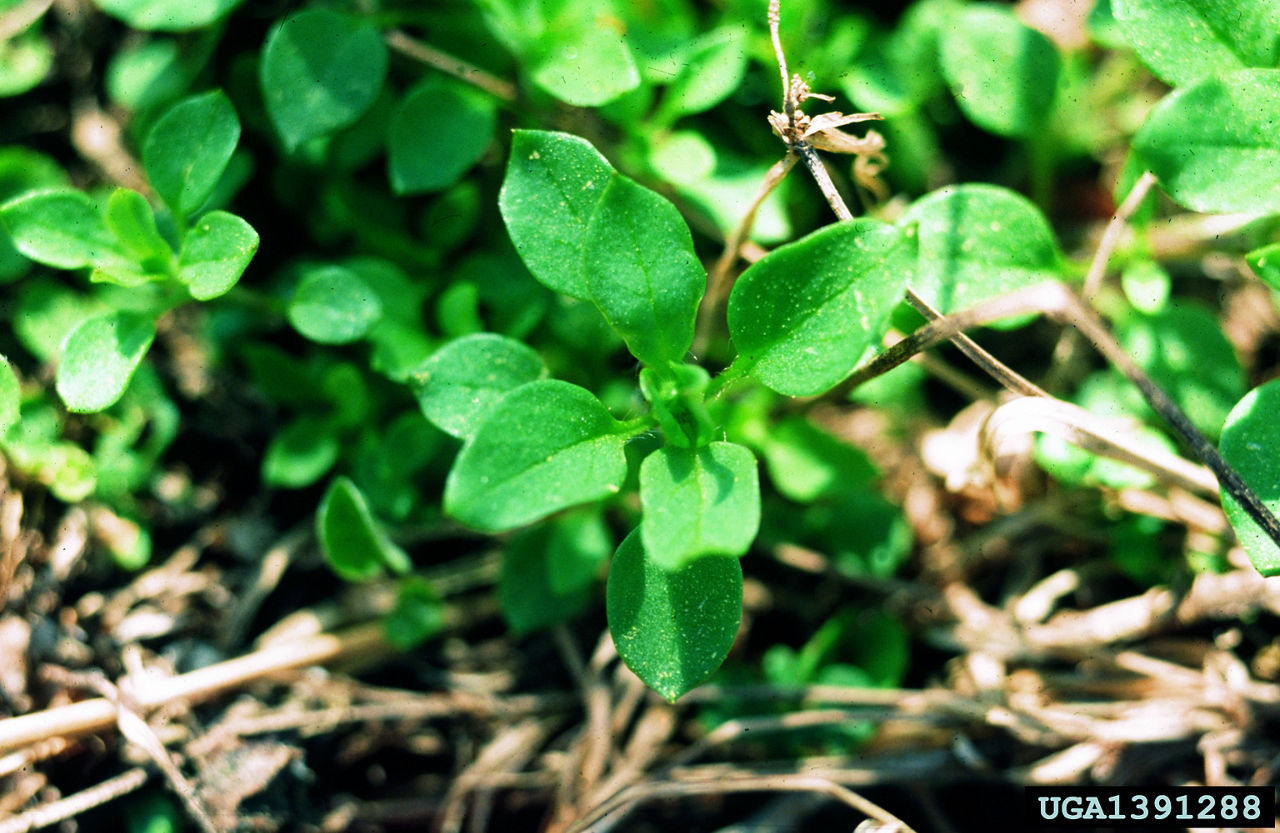
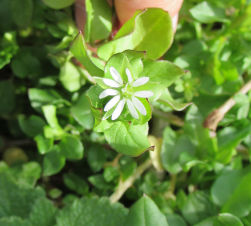
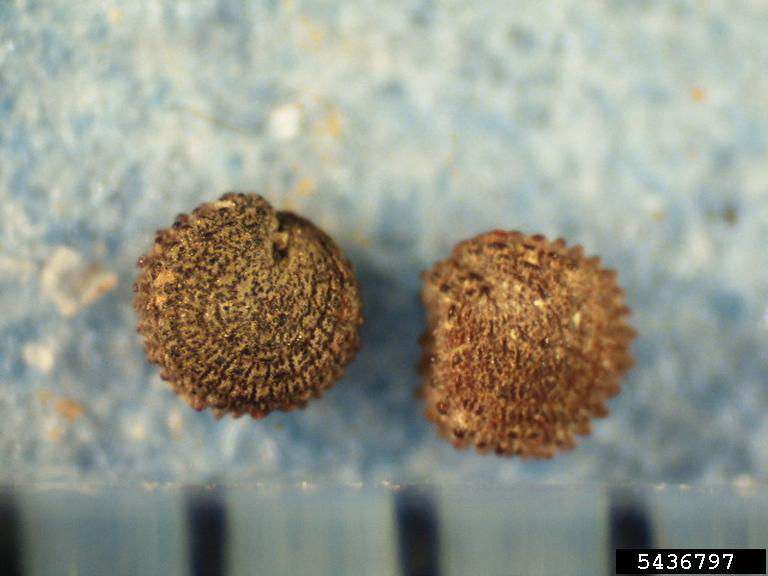
Identification: Common chickweed is a winter annual that can have several generations per year during cool, wet seasons, and forms prostrate, dense mats. Common chickweed leaves are opposite, light green, rounded to egg-shaped, with pointed tips, smooth margins, and hairless or with a few hairs near the base (Figure 37). Common chickweed has a single straight row of hairs along the stem. Lower stems often root at the nodes.
Small, white flowers are borne in clusters at the end of stems. Flowers have 5 deeply-notched petals, resembling a pair of petals, and though small, are quite noticeable (Figure 38). Fruit are slightly curved, an oval capsule that contains many tiny, brown seeds (Figure 39).
Management: Heavy infestations of common chickweed are competitive with crops, especially in small grains. Tall wheat cultivars and denser plant populations can help suppress chickweed. Tilling in the fall prior to wheat planting can help give wheat a head start. Common chickweed should be controlled prior to planting in no-till systems. A fall herbicide application can effectively reduce weed populations from overwintering and help reduce the number of seeds set in the spring. In addition, chickweed can serve as an alternate host for a range of crop pests including wireworm, black cutworm, and soybean cyst nematode and should be managed.
Similar species: Common chickweed is similar in growth habit and appearance to mouseear chickweed (Cerastum fontanum ssp. vulgare). Mouseear chickweed differs by having a perennial habit with densely hairy, oblongleaves lacking petioles, and dark-green foliage (Figure 40).

Common name: Field pennycress
Scientific name: Thlaspi arvense
Life cycle: Winter or summer annual
)
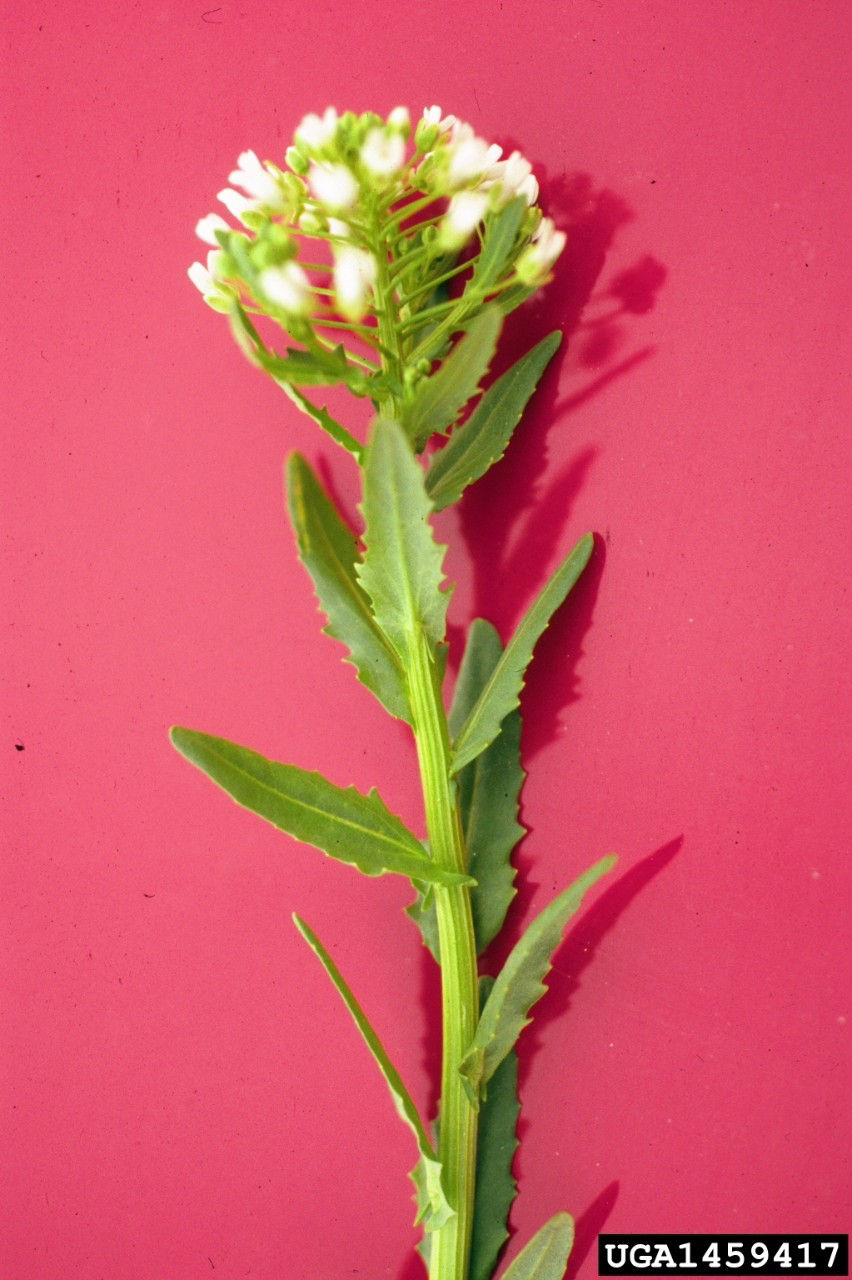
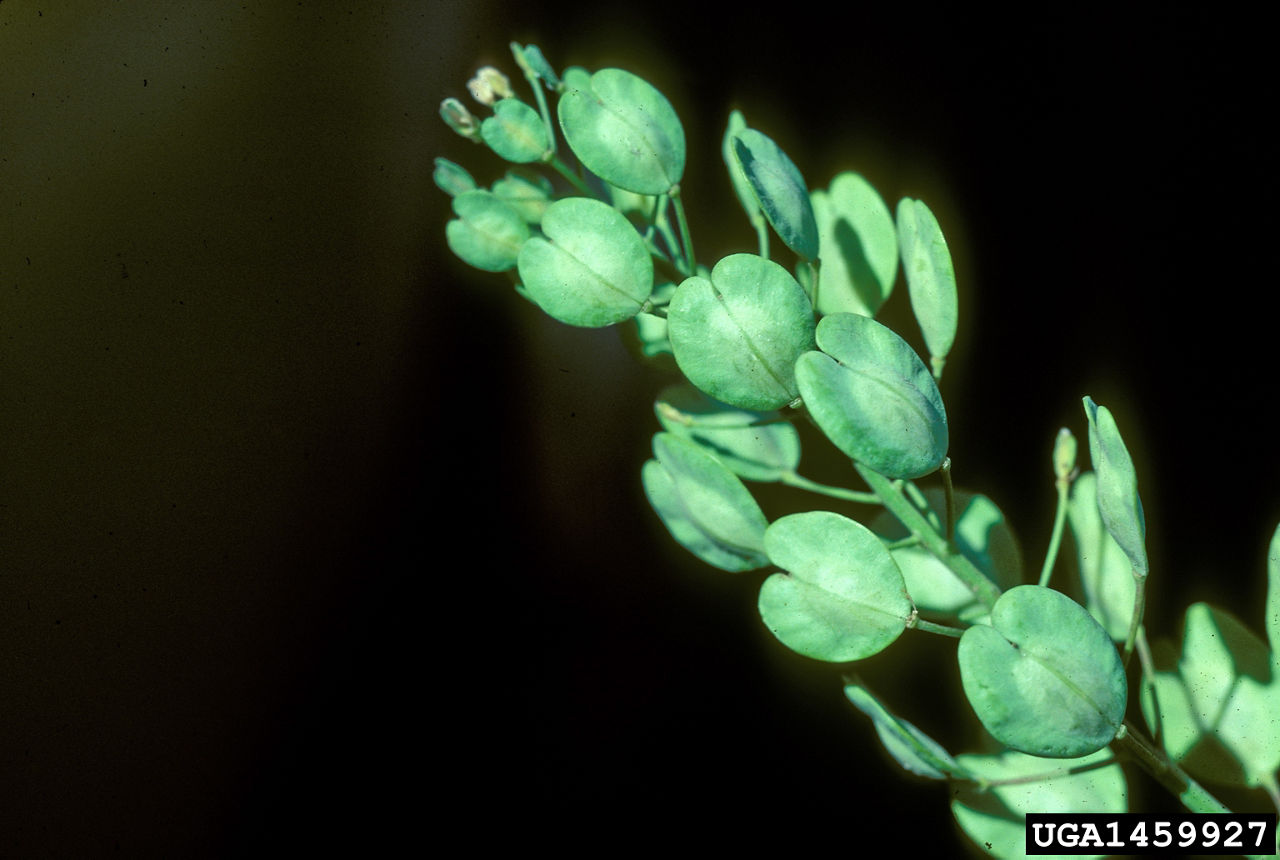
Identification: Field pennycress is a member of the mustard family and has either a winter or summer annual growth habit. It can be found in nearly every state, even as far north as Alaska. Seedlings develop into a compact basal rosette with a slender taproot system (Figure 41). Lower leaves are oval to spatula-shaped with wavy margins, rounded tips, and distinct petioles. Upper leaves are alternate with toothed to smooth margins and clasping bases. Basal leaves fall off before maturity.
Stems bolt from the basal rosette to flower (Figure 42). Flowers are terminal clusters with 4 small, white petals. Each flower produces a single seedpod that is bright green, flat, and round to oval in shape with distinct membranous wings that have a notch at the end. (Figure 43). The entire plant turns bright yellow to tan at maturity. All plant parts have a sharp odor and can give a bitter taste to milk if eaten by cows.
Management: Field pennycress can be controlled easily with tillage or burndown herbicide applications. Herbicides work best when plants are in the rosette stage and growth is active, before seeds start to shed.
Sources:
Anderson, B., Bradley, K., and Perez-Hernandez, O. April 19, 2016. Weed of the month: field pennycress. Integrated Pest Management. University of Missouri. https//ipm.missouri.edu.
Return to Top
Common name: Henbit
Scientific name: Lamium amplexicaule
Life Cycle: Winter annual
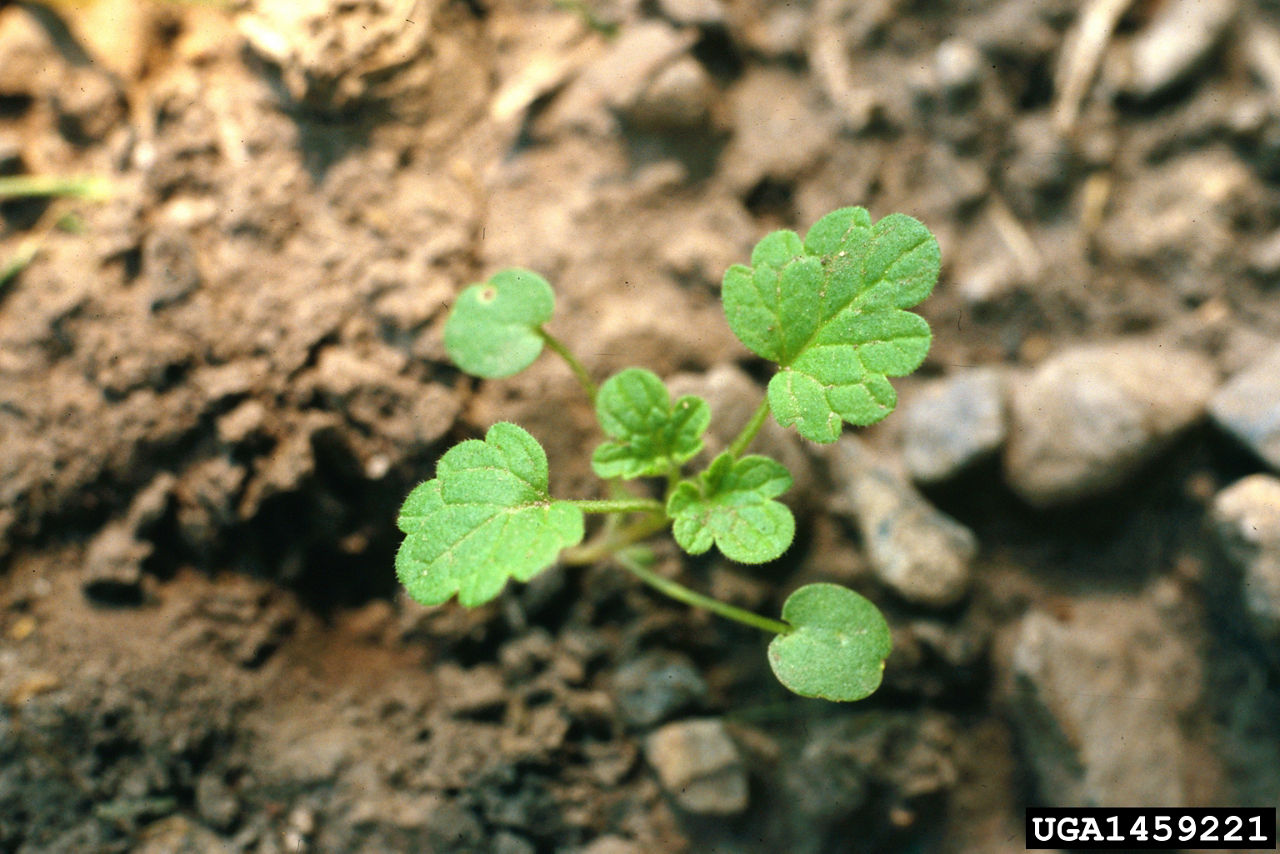

)
Identification: Henbit is a member of the mint family and has square stems. Leaves are opposite, circular to heart-shaped, with a crinkled leaf surface, hairy, and have rounded teeth along the leaf margins (Figure 44). Lower leaves are attached to the stem by long petioles, upper leaves lack petioles and encircle the stem. Flowers are pink to purple in a two-lipped tube form in whorls in upper leaf axils (Figure 45). Henbit is more prevalent in no-till fields and thick patches can make areas appear purplish as plants flower (Figure 46).
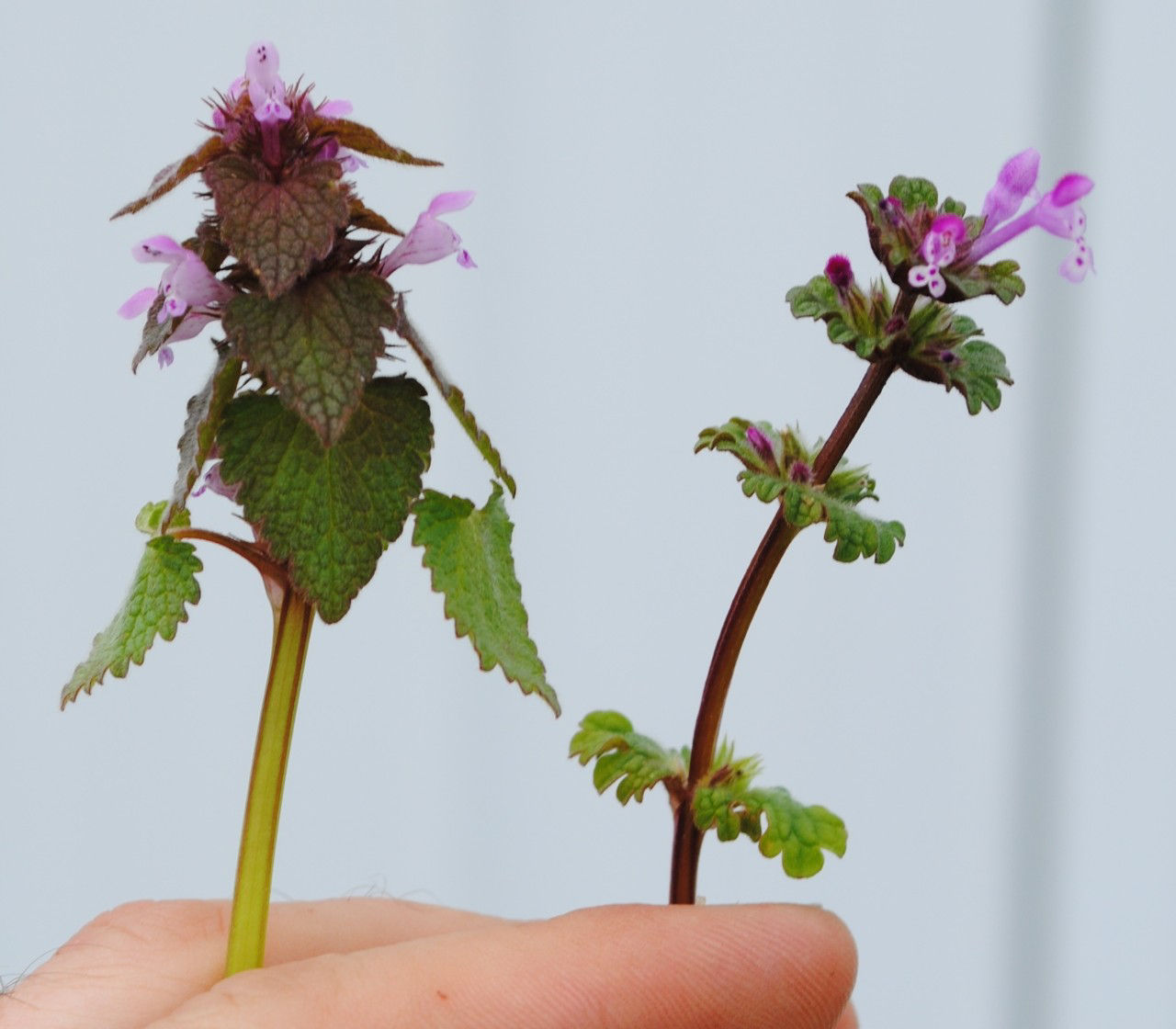
Similar Species: Henbit can be confused with ground ivy (Glechoma hederacea) and purple deadnettle (Lamium purpureum). However, purple deadnettle differs by having more triangular-shaped leaves, upper leaves with petioles, and red to purple leaf coloration (Figure 47). Ground ivy differs in that it is a creeping perennial with square stems that root at the nodes.
Management: Henbit and purple deadnettle both emerge mostly in the fall with flowering and seed set in the spring and are primarily weeds of no-till systems. Both are easily controlled with herbicides. Fall and early spring herbicide applications are most effective and may also suppress seed production. There is also some spring emergence, so consider herbicide options with some residual control.
Common name: Marestail (horseweed)
Scientific name: Conyza canadensis
Life Cycle: Winter annual
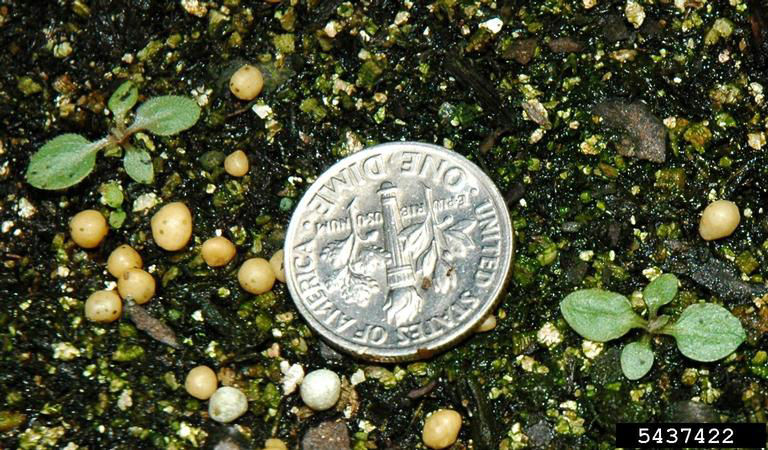
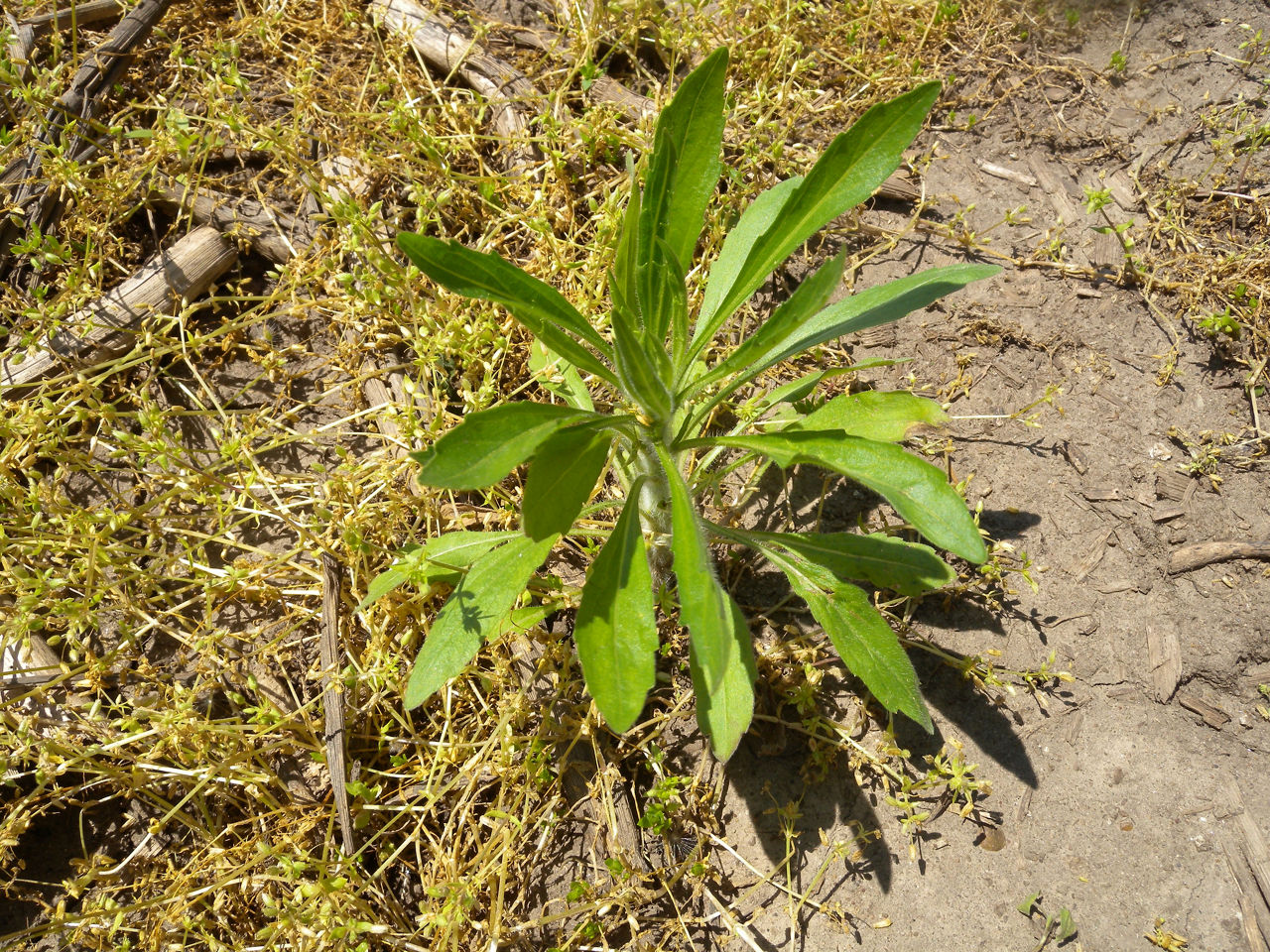
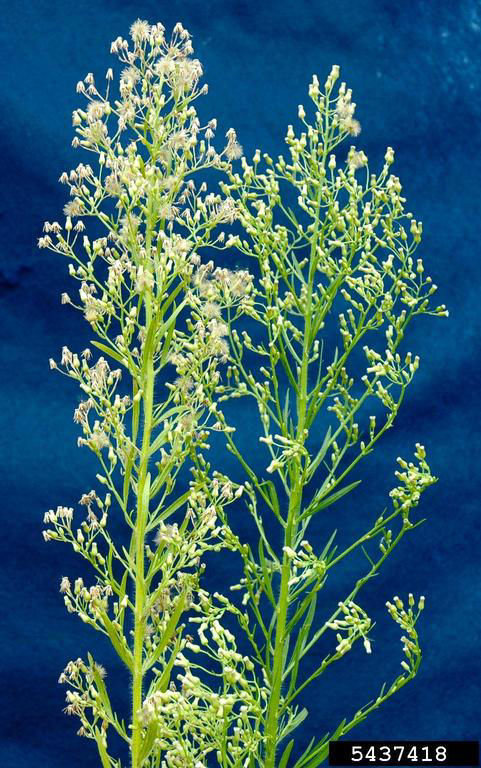

Identification: Marestail, also known as horseweed, emerges in both fall and spring. Seedlings develop into a basal rosette (Figure 48). Fall-emerged plants survive the winter as a basal rosette and bolt in the spring. Marestail leaves are alternate, linear, and simple with entirely or slightly toothed margins (Figure 49). Leaves get progressively smaller toward the top of the plant. When plants are mature, leaves do not have petioles. The main stem bolts, giving the plant the appearance of a horse’s tail. Flowers are arranged in a panicle with numerous white ray flowers (Figure 50). Fruit are small, yellow achenes, each with a white pappus that aids in wind dispersion (Figure 51). Marestail seeds usually germinate in the fall or spring but can germinate midsummer when growing conditions are adequate. Plants can reach up to 6 feet in height. Once plants are over 5 inches tall, they are difficult to control with herbicides alone.
Watchouts: Marestail has increased in prevalence and herbicide-resistant biotypes have developed due to three primary factors: use of reduced or no-tillage, a lack of diversity in crop rotations (production of soybeans in the same field for consecutive years), and limited herbicide diversity. Herbicide-resistant marestail biotypes have been identified in several states for ALS inhibitor, triazine, paraquat, and glyphosate herbicides. Abundant seed production and wind dispersal facilitate the spread of herbicide-resistant marestail biotypes.
Management: Several factors can influence marestail control. The size and stage of growth at the time of herbicide application can have a significant effect on efficacy. Marestail is most susceptible to control when it is small, in the rosette stage of growth, and less than 4 to 6 inches tall. Once marestail bolts it is more difficult to control. The second factor is the extended emergence time of marestail, which can complicate the timing of burndown applications. In many cases, including a herbicide with residual activity can help control later-emerging plants. A third challenging factor to marestail control is the limited number of postemergence herbicide options, particularly in soybean. Because of this limitation it is important to use burndown, preplant, and preemergence herbicides effectively.
There are herbicide options available for fall or spring burndown, preemergence, and postemergence applications for marestail control. Preemergence herbicides with residual activity should be the foundation of a marestail management program. Marestail susceptibility to herbicides declines substantially once the plant bolts in the spring.
Marestail management tips:
- Fall or early spring herbicide application for emerged plants to reduce heavy populations or seedlings. Plan for an additional herbicide application closer to planting.
- Spring burndown application to marestail less than 4 inches tall to prepare a clean seed bed.
- Add residual herbicides to the spring burndown application.
- Use full label rates of herbicides for maximum residual activity and postemergence activity on variable-height marestail.
- Herbicide applications with multiple sites of action should be used in areas with ALS-, glyphosate-, or multiple herbicide-resistant biotypes.1
- Use postemergence herbicides in-crop to control escaped plants.
- Rotate crops and till to reduce heavy marestail infestations.1
- Consult product labels for use precautions and restrictions to prevent crop injury or carryover.
Sources:
1Loux, M., Stachler, J., Johnson, B., Nice, G., Davis, V., and Norby, D. 2006. Biology and management of horseweed. GWC-9. https://www.extension.purdue.edu
Lingenfelter, O., Klodd, A., and Curran, N. November 13, 2017. Marestail (horseweed) management. Penn State Extension. http://extension.psu.edu.
Sprague, C. November 2018. Herbicide-resistant horseweed (marestail) in Michigan: keys to management in no-till soybean. Michigan State University Weed Science. http://www.msuweeds.com
Common name: Prickly lettuce
Scientific name: Latuca serriola
Life Cycle: Winter annual or biennial
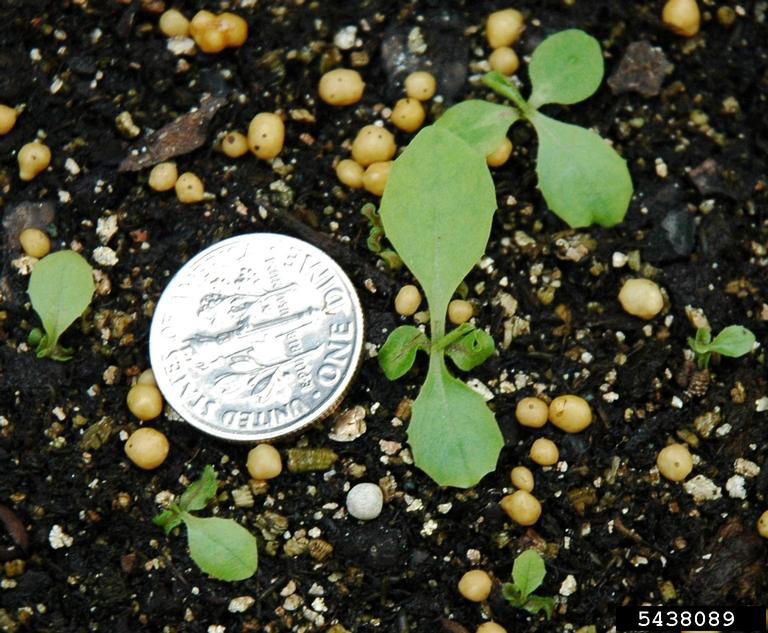


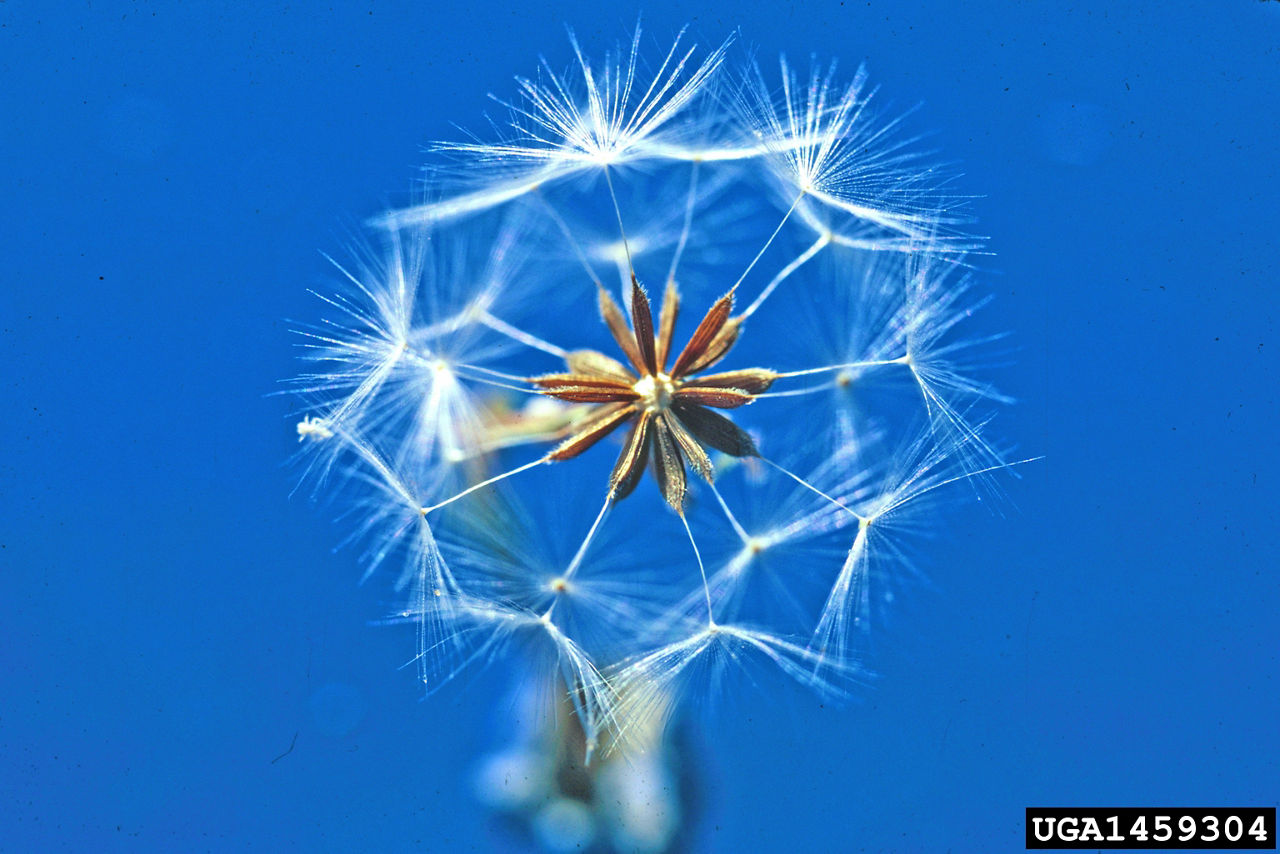
Identification: Prickly lettuce, also known as wild lettuce, is a common winter annual or biennial that can grow up to 6 feet tall. Seedlings develop as a rosette and stem elongate later (Figure52). The leaves are alternate, clasp the stem, are deeply lobed with spiny margins (Figure 53). The leaves have a row of spines along the mid-vein of the lower surface which is a distinguishing characteristic of this plant (Figure 54). Leaves become smaller and more lanceolate toward the top of the stem and may lack spines. The stems are hollow, and the stem and leaves will exude a milky sap.
Prickly lettuce produces yellow flower heads with up to 25 flowers resembling dandelion flowers. Prickly lettuce seeds travel on wind currents with the help of their downy, white plumes (Figure 55).
Management: Seedlings and rosettes of prickly lettuce are easily controlled by cultivation. There are several herbicide options available for fall or spring burndown, preemergence, and postemergence applications for prickly lettuce control. Plants become more difficult to control with herbicides once the flowering stems have begun to elongate.
Sources:
Montgomery, G., Bond, J., and Eubank, T. November 28, 2012. Weed of the week: prickly lettuce. Mississippi Crop Situation. Mississippi State University Extension. http://www.mississippi-crops.com
Common name: Shepherd’s purse
Scientific name: Capsella bursa-pastoris
Life Cycle: Winter or summer annual
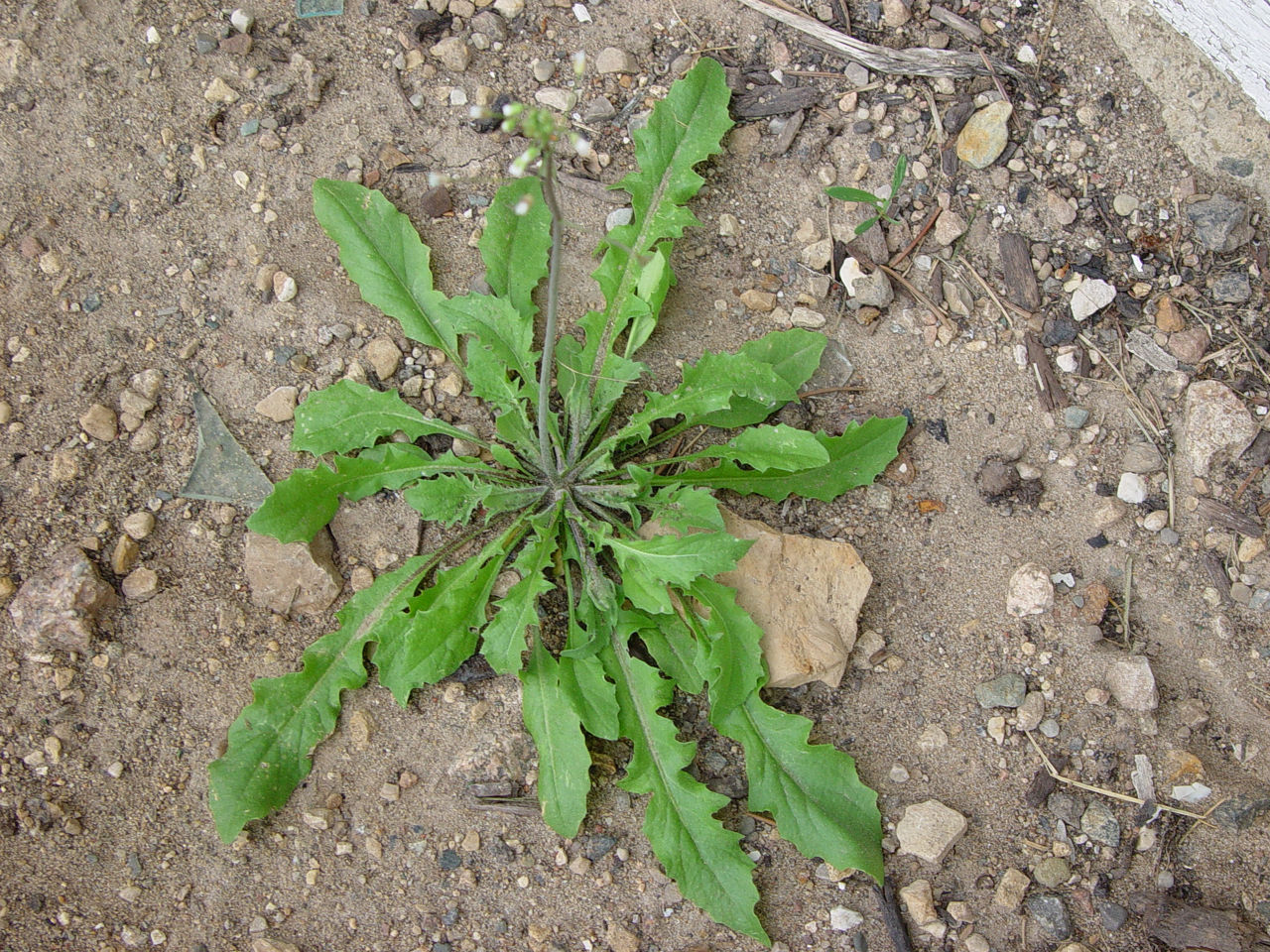
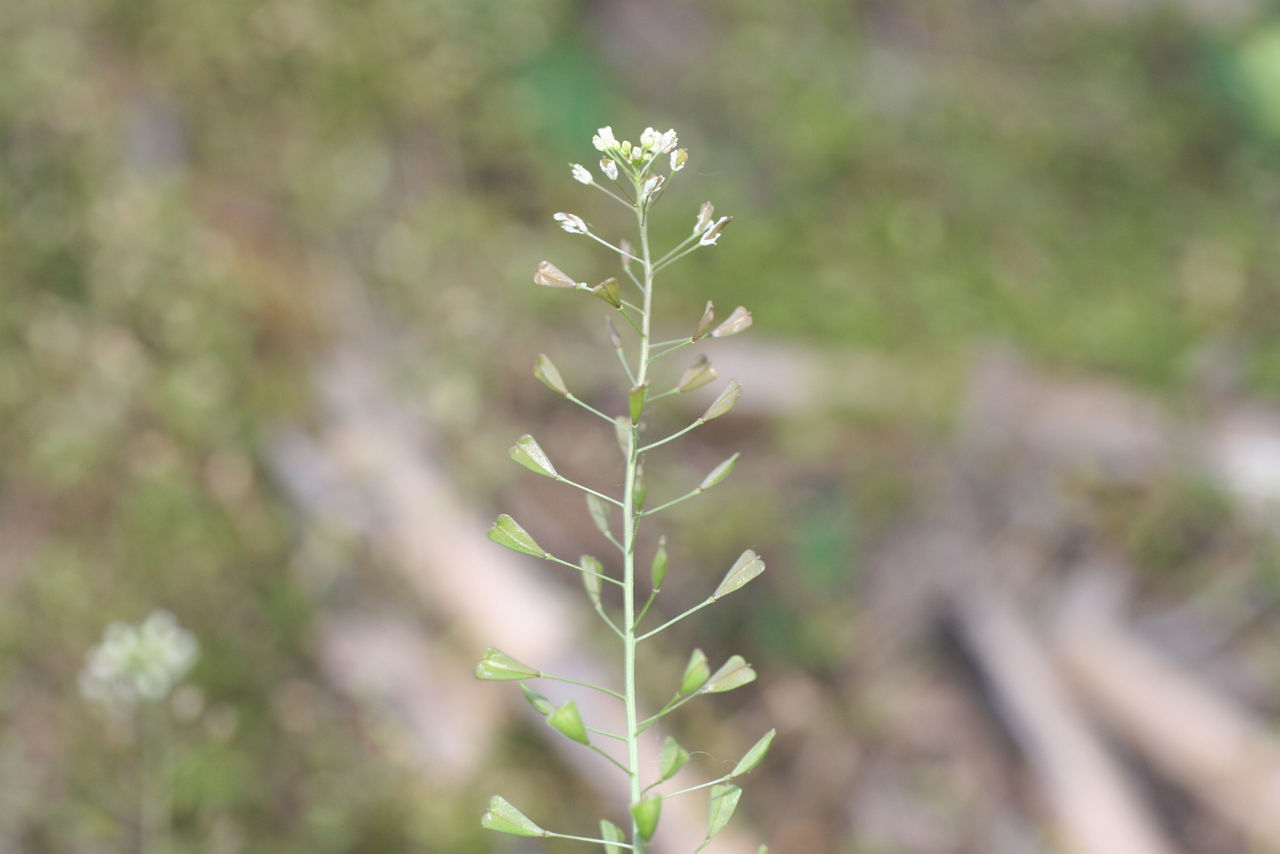
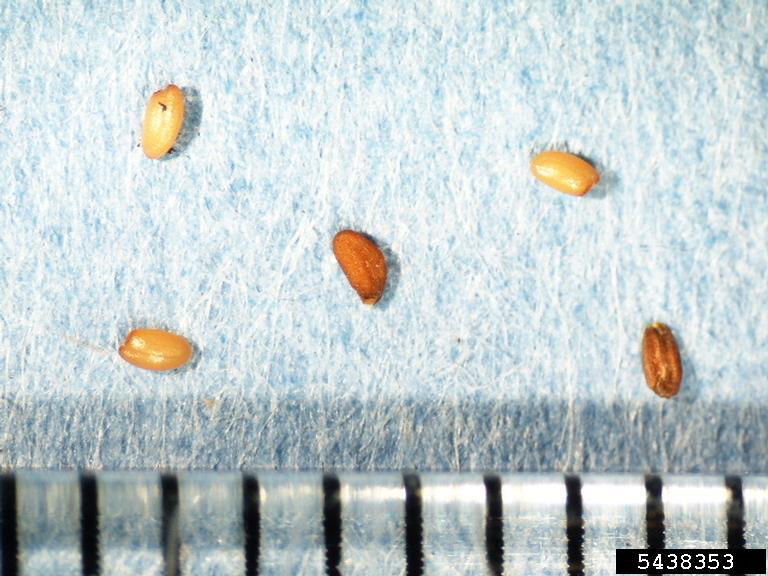
Identification: Shepherd’s purse is a member of the mustard family. Dandelion-like leaves initially develop from a basal rosette (Figure 56). Small stem leaves are alternate with smooth or toothed margins and clasping bases. Stems, up to 2 feet tall, bolt from the basal rosette to flower. White flowers with 4 small petals are found in a terminal cluster. The seed pods are very distinct heart-shaped to triangular pods found on elongated, unbranched stems (Figure 57). Seeds are oblong, grooved and yellowish red to brown (Figure 58). Each plant can produce thousands of long-lived seeds.
Similar species: In the basal rosette stage, shepherd’s purse can be confused with dandelion. Once it starts producing pods in the spring there is very little mistaking of identity. The arrow-shaped pod is very distinctive.
Management: Although shepherd’s purse is fairly common, it is easy to control in the fall. The use of glyphosate or 2,4-D in the fall when shepherd’s purse is in the rosette stage will typically control it. Shepherd’s purse bolts, flowers, and starts to set seed early in the spring, often too early to get into the field. Once it starts to set seed control can be more inconsistent.
Common name: Wild carrot
Scientific name: Daucus carota
Life Cycle: Biennial


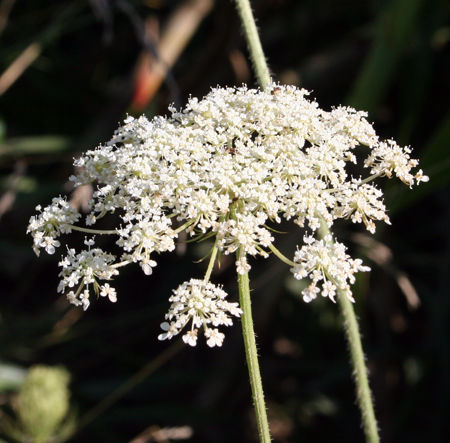
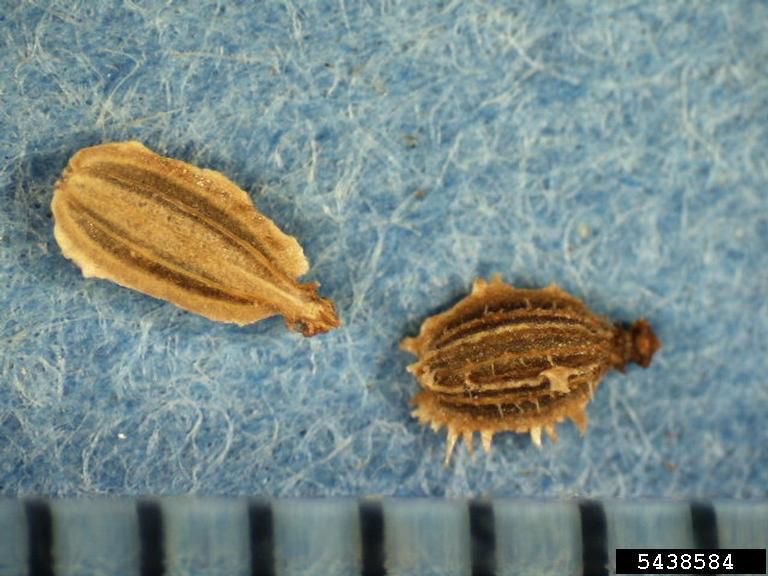
Identification: Wild carrot, also known as Queen Anne’s lace, is a biennial plant in the parsley family. It germinates and emerges in spring, developing a rosette of delicate, deeply-lobed, feathery or fern-like leaves (Figures 59 and 60). The foliage is very similar to garden carrots and will smell similar when crushed. Some plants will flower and set seed during the first year of growth, but most will overwinter without flowering. When winter comes, these first-year leaves will die back, but the strong taproot overwinters. The second year, plants send up a tall flower stalk and more leaves.
The flower, called an umbel, is a flat-topped cluster of small, white flowers, 2 to 5 inches across (Figure 61). Each plant can have several flowers. The flower heads face upward during the day and bend down at night. After fertilization, the flower head folds up and has a “birds nest” appearance. Fruit have two egg-shaped sections; each section is yellow to grayish brown, flattened on one side, and ridged with barbed prickles to aid in dispersal (Figure 62). Healthy wild carrot plants can produce as many as 1,000 to 40,000 seeds per plant, and seeds can live and germinate over a 7-year period or longer.
Management: Wild carrot disseminates only by seed so any time plants are prevented from going to seed future infestations are reduced. Tillage will control wild carrot. Spring applications of labeled herbicides are effective in controlling wild carrot seedlings in other crops. However, once wild carrot becomes established, fall herbicide applications are more effective.
Common name: Wild mustard
Scientific name: Sinapis arvensis
Life Cycle: Winter or summer annual
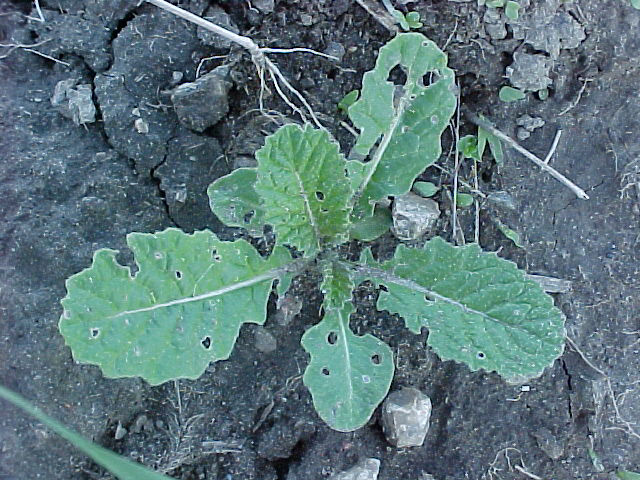
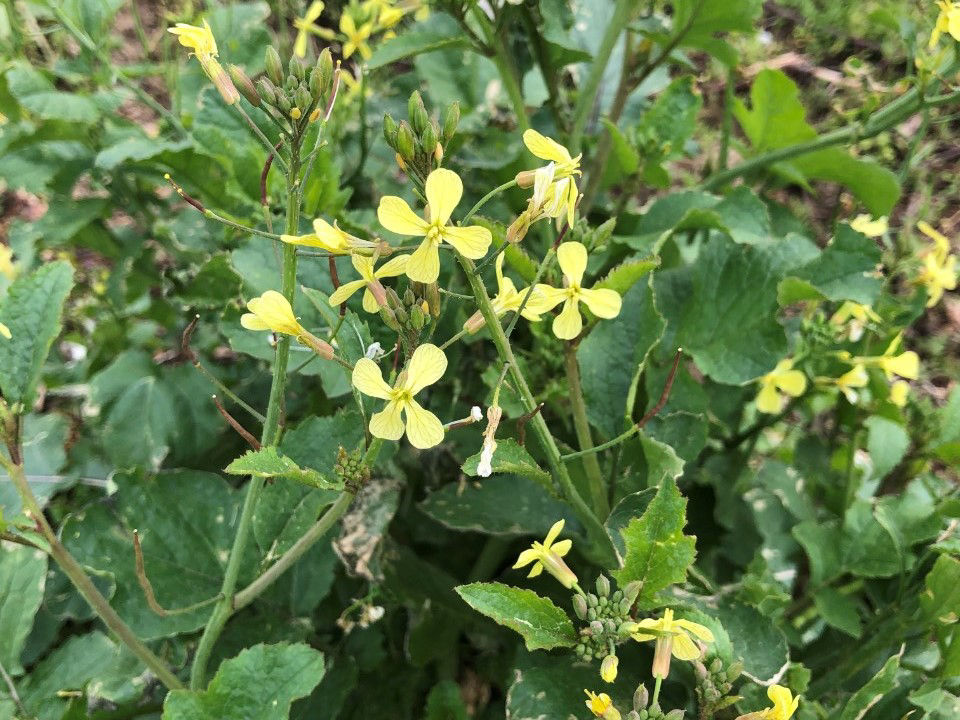
Identification: Wild mustard is a winter or summer annual and is considered a noxious weed in several states. The lower leaves of wild mustard occur as a basal rosette, petiolated, and are unevenly-lobed with coarsely-toothed margins (Figure 63). Upper leaves are alternate, petioles are absent or short, with coarsely-toothed margins, pointed tips, and gradually become smaller towards the top.
Erect stems bolt from the basal rosette to flower with white hairs that point downward and purple rings at the base of young stems. Bright-yellow flowers with 4 petals are found in terminal clusters (Figure 64). Fruit are cylinder-shaped capsules about an inch long with a beak at the tip (Figure 65).
Management: In a no-till system, timing herbicide applications before bolting is the key to successful control. Some populations (North Dakota) of wild mustard have developed resistance to Group 2 (ALS inhibitor) herbicides.
Diseases and Insect Pests Harbored: Wild mustard is more prevalent in no-till systems and can also serve as an alternate host to soybean cyst nematode and many insect pests.
Sources:
Cahoon, C. 2016. Wild mustard and wild radish. Virginia Tech Extension. http://blogs.ext.vt.edu
Common name: Yellow rocket
Scientific name: Barbarea vulgaris
Life Cycle: Winter or summer annual
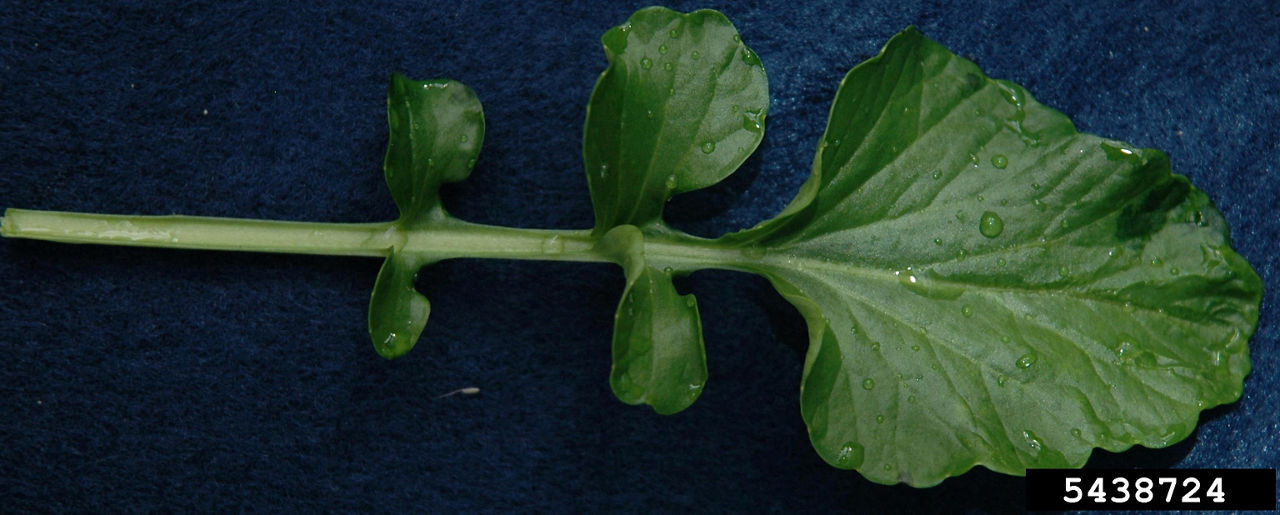
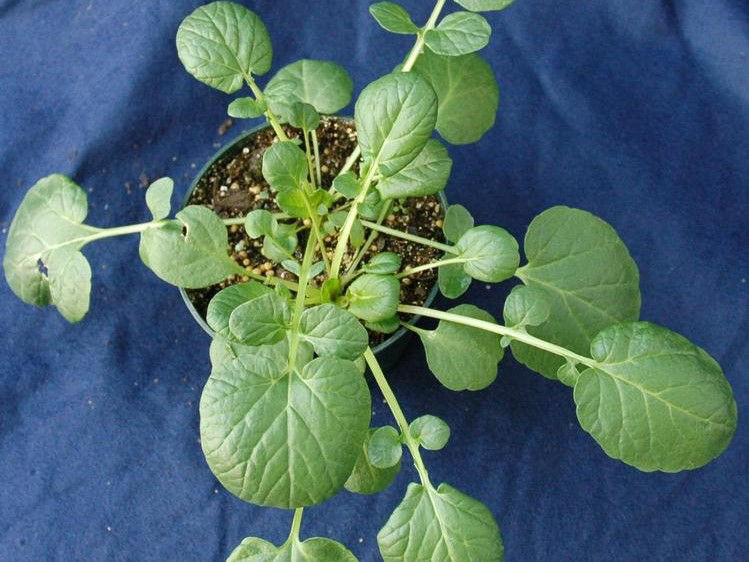
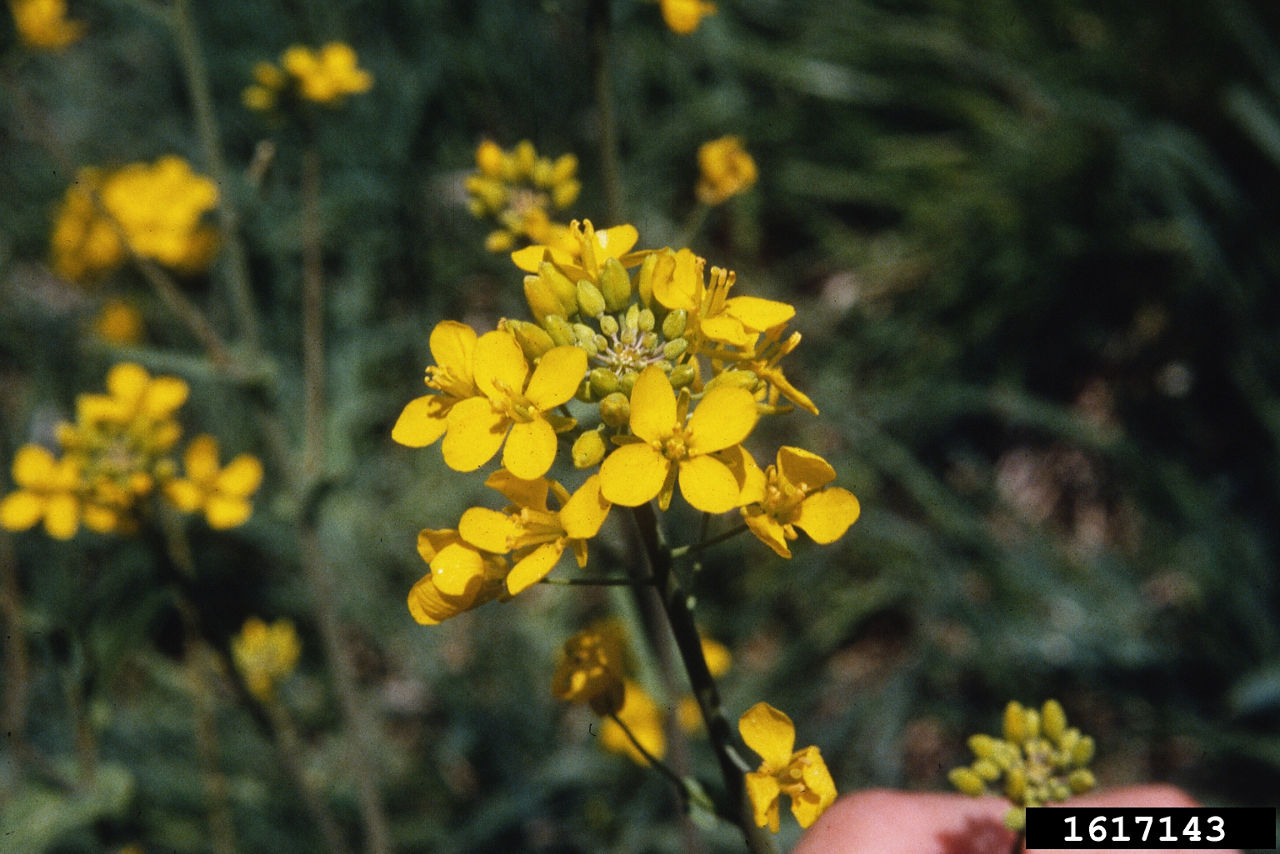
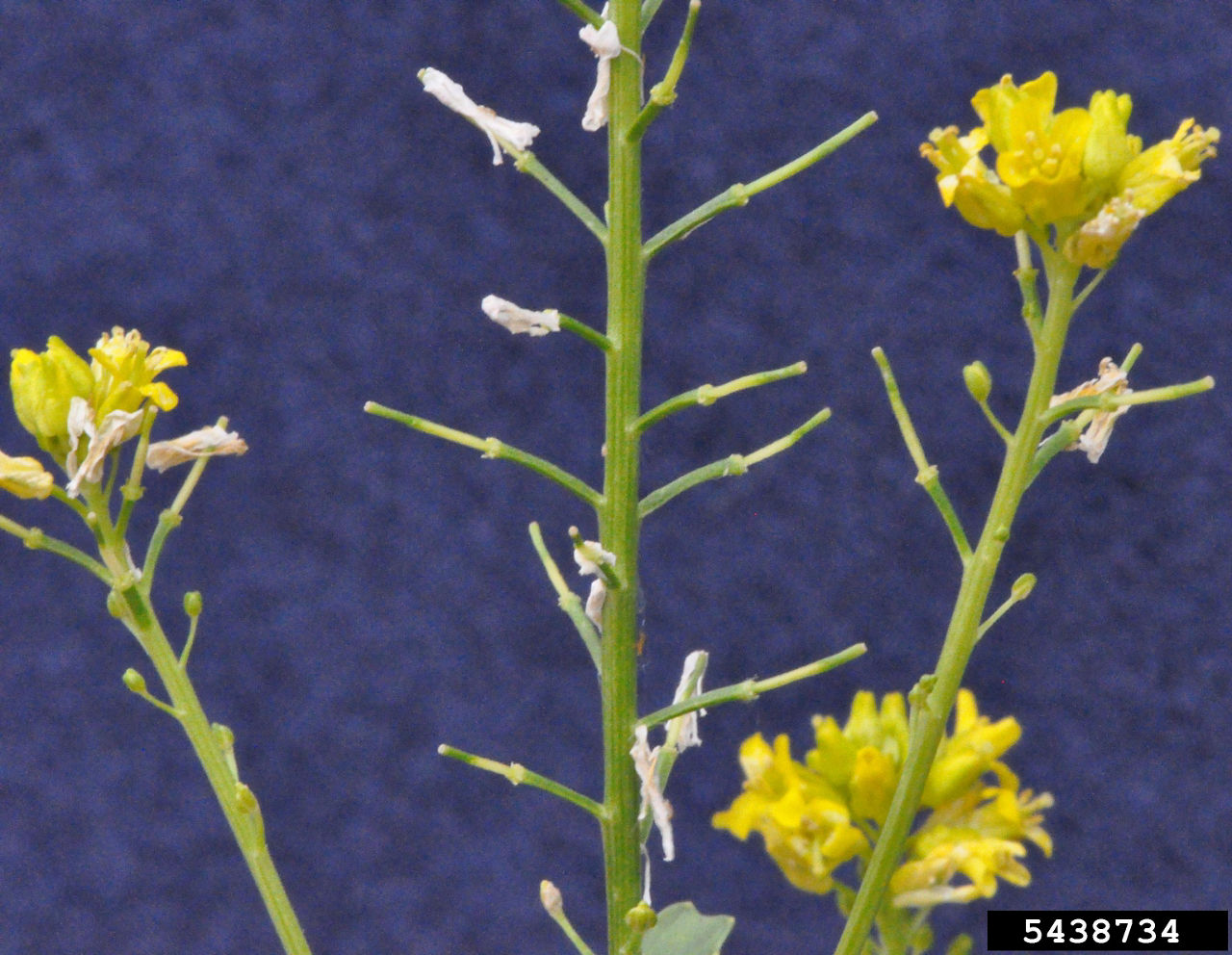
Identification: Yellow rocket can be a winter annual or biennial and reproduces by seed. Yellow rocket is most commonly found in no-till fields and contributes to the blanket of yellow covering in fields in the spring.
Yellow rocket is a member of the mustard family and has leaves with several smaller lobes and one large terminal lobe (Figure 66). Seedlings have round to egg shaped cotyledons on long stalks with smooth, shiny, dark green leaves that initially develop from a basal rosette (Figure 67). Leaf stems are arranged alternately and become progressively shorter toward the tip of the plant. Flowering stems are produced during the second year and can reach up to 3 feet in height (Figure 68). Bright-yellow flowers with 4 petals are found in terminal clusters. Fruit are slender, slightly curved, approximately 1-inch long capsules, with a beak at the tip and are almost square in cross-section (Figure 69).
Similar Species: At maturity, the flowers of several mustard species, including wild mustard and wild radish, will resemble those of yellow rocket. However, wild radish has leaves that are covered with stiff hairs unlike wild mustard or yellow rocket. Additionally, the large terminal lobe in the leaves of yellow rocket helps to distinguish this weed from wild mustard.
Management: Herbicides are highly effective at controlling younger, smaller weeds. The use of an effective early burndown to manage winter annual weeds like the mustard species is an important first step for a clean field for crop planting. Including a product with residual activity helps reduce early-season weed competition and helps manage winter annuals that can serve as alternate hosts for insects and soybean cyst nematode.
Summer Annual Broadleaf Weeds
Common name: Burcucumber
Scientific name: Sicyos angulatus
Life Cycle: Summer annual

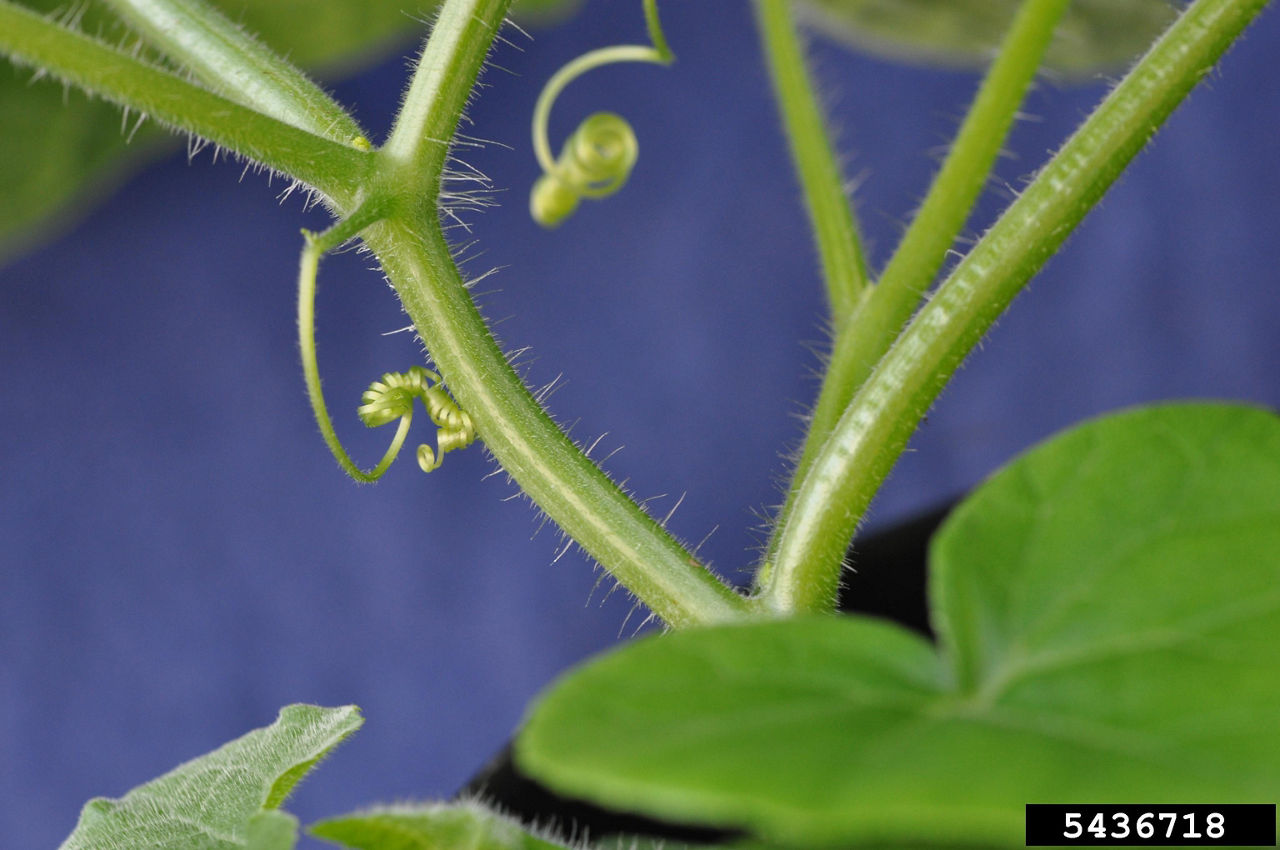
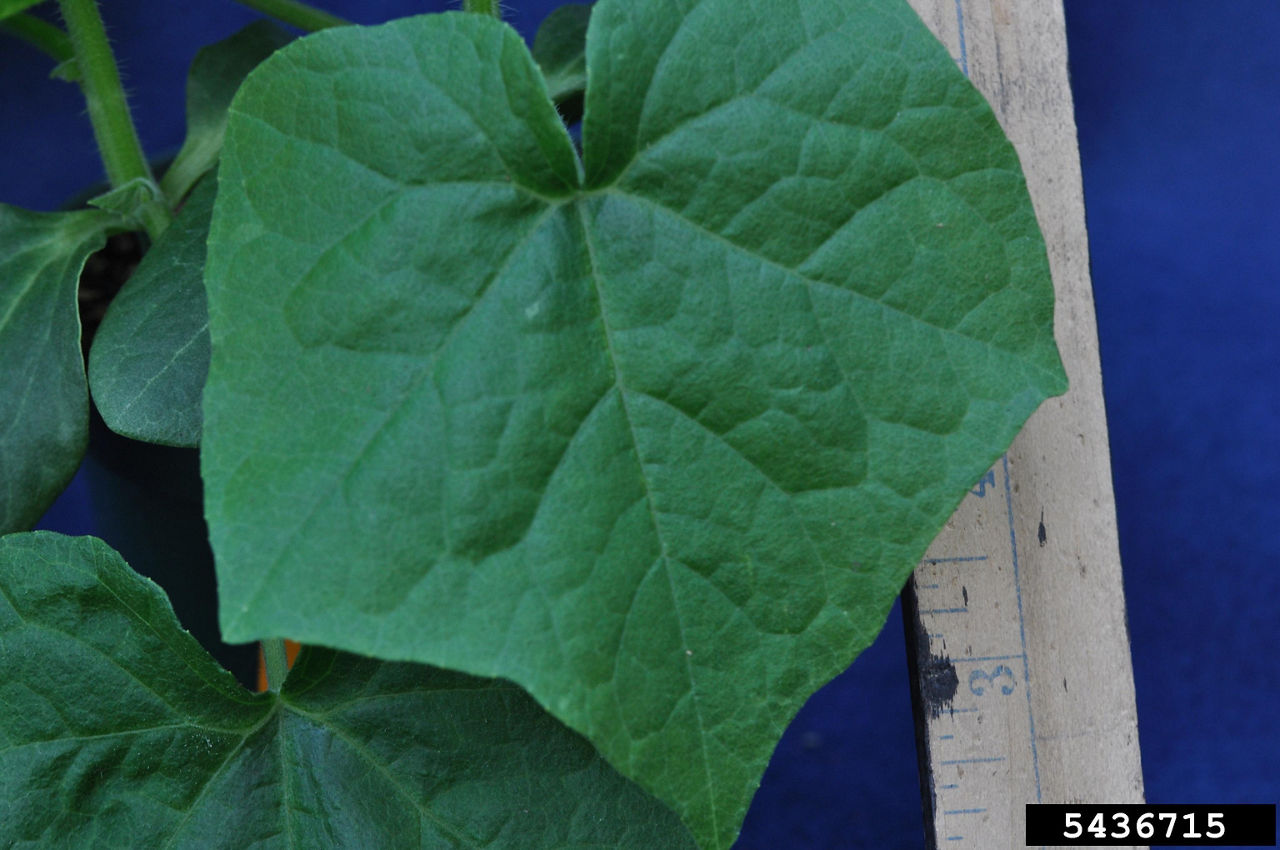
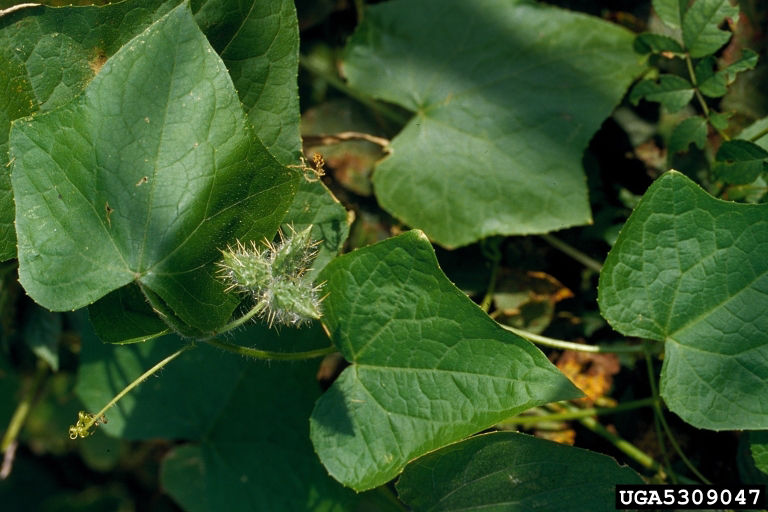
Identification: Burcucumber is an aggressive, vining, summer annual broadleaf weed that can germinate throughout the summer, substantially reducing crop yield and causing harvest problems. When grown in direct competition with soybean, burcucumber can reduce yield by up to 48%1 and the weighty vines of this weed can lodge corn.2
Burcucumber cotyledons are thick and oblong, similar to the cultivated cucumber (Figure 70). The hypocotyl is covered with many short hairs that point downward. The plant has a fibrous root system and uses branched tendrils to move up surfaces in search of sunlight (Figure 71). The leaves are alternate and are 2 to 8 inches long and wide. The leaves are hairy, broadly heart-shaped, and generally have 3 to 5 pointed lobes and a toothed margin (Figure 72). Burcucumber stems are also hairy, especially at the leaf nodes (Figure 71). These hairs are one of the main differences between burcucumber and wild cucumber (Echinocystis lobata), which has a stem that usually lacks hairs. The burcucumber flowers are usually whitish with a green tint and have 5 petals. The fruit are produced in clusters of 3 to 20 and resemble small cucumbers (about ½ to ¾ inches long and ¼ inch thick) that are covered with bristles/spines (Figure 73).
Management: Due to the ability of this weed to germinate throughout the corn and soybean growing season, burcucumber can be a challenging pest to eliminate. The first step in management is to prevent burcucumber seed spread by thoroughly cleaning tillage and harvesting equipment before leaving infested fields. Encourage aggressive crop growth through good cultural practices such as maintaining adequate soil fertility, choosing appropriate high-yielding crop varieties, and regularly scouting for and managing pests. Include in the rotation crops that provide early competition such as alfalfa or small grains. While foliar-applied herbicides can control current flushes, herbicides with residual activity can help minimize flushes of burcucumber that may occur later in the season.
Effective management must include both preemergence and postemergence (foliar-applied) herbicides. Postemergence programs that include effective foliar and residual herbicides will enhance season-long control. Several corn herbicides provide good control of burcucumber and they are most effective on young seedlings rather than larger plants. Because burcucumber germinates throughout the season, it is difficult to control with herbicides that lack residual activity. In corn, atrazine works well for residual control. Other effective herbicides include prosulfuron, primisulfuron, mesotrione, and glyphosate. In addition, other Group 6 herbicides, such as bromoxynil, are effective for controlling emerged plants.
In soybean, there are a variety of preemergence treatments that will provide initial suppression and reduction in the burcucumber population, but similar to corn, a postemergence treatment will almost always be required. Effective preemergence herbicides for burcucumber include products that contain chlorimuron or imazethapyr and these treatments must be followed by an effective postemergence treatment such as chlorimuron, glufosinate, or glyphosate.
Sources:
1Esbenshade, W.R., Curran, W.S., Roth, G.W., Hartwig, N.L., and Orzolek, M.D. 2001. Effect of tillage, row spacing, and herbicides on the emergence and control of Burcucumber (Sicyos angulatus) in soybean (Glycine max). Weed Technology 15:229-235.
2Nice, G., Johnson, W., and Bauman, T. 2005. Identifying and controlling Burcucumber. Purdue Extension Weed Science: www.btny.purdue.edu/weedscience/
Ligenfelter, D. March 7, 2018. Burcucumber management in corn and soybean. Penn State Extension. http://extension.psu.edu
Common name: Common cocklebur
Scientific name: Xanthium strumarium
Life Cycle: Summer annual
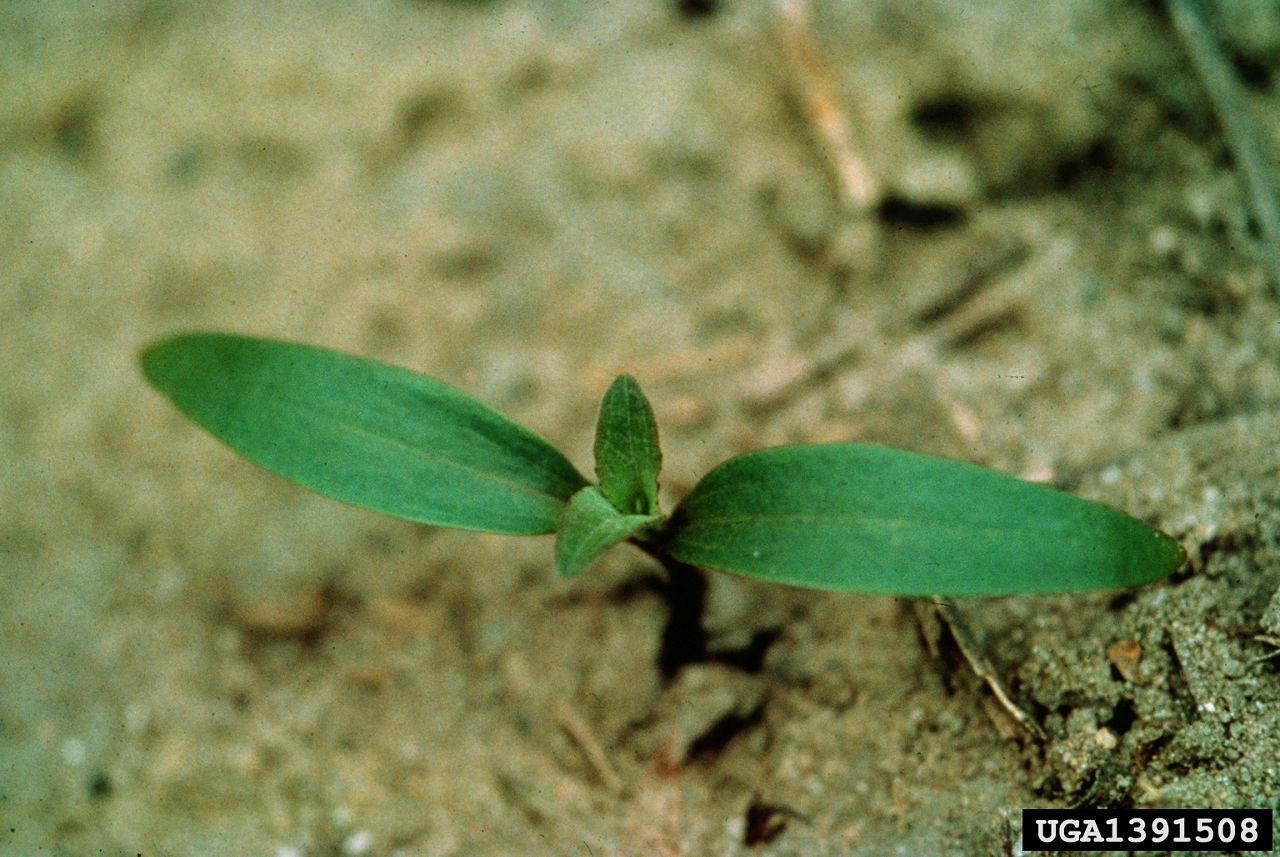
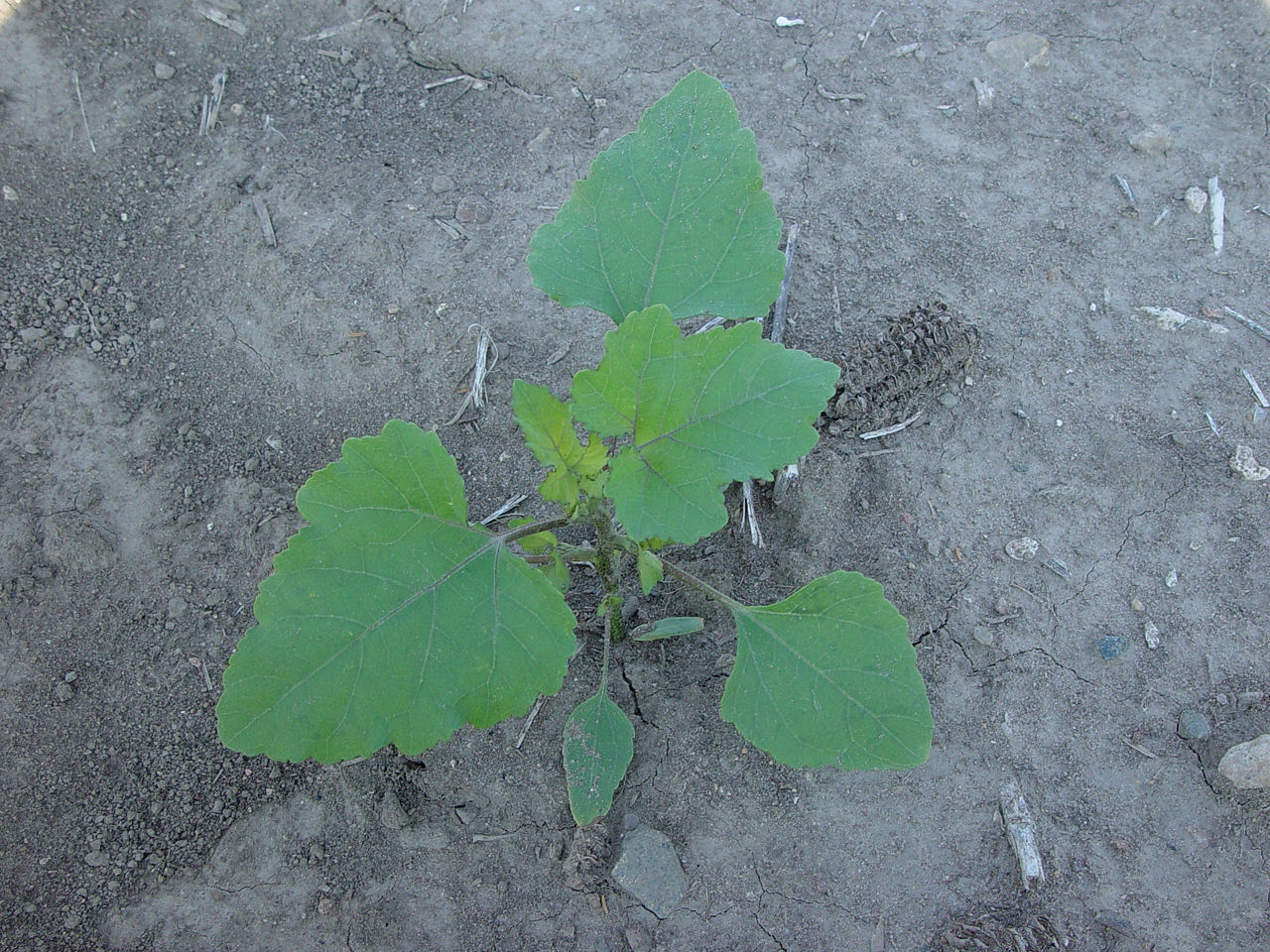

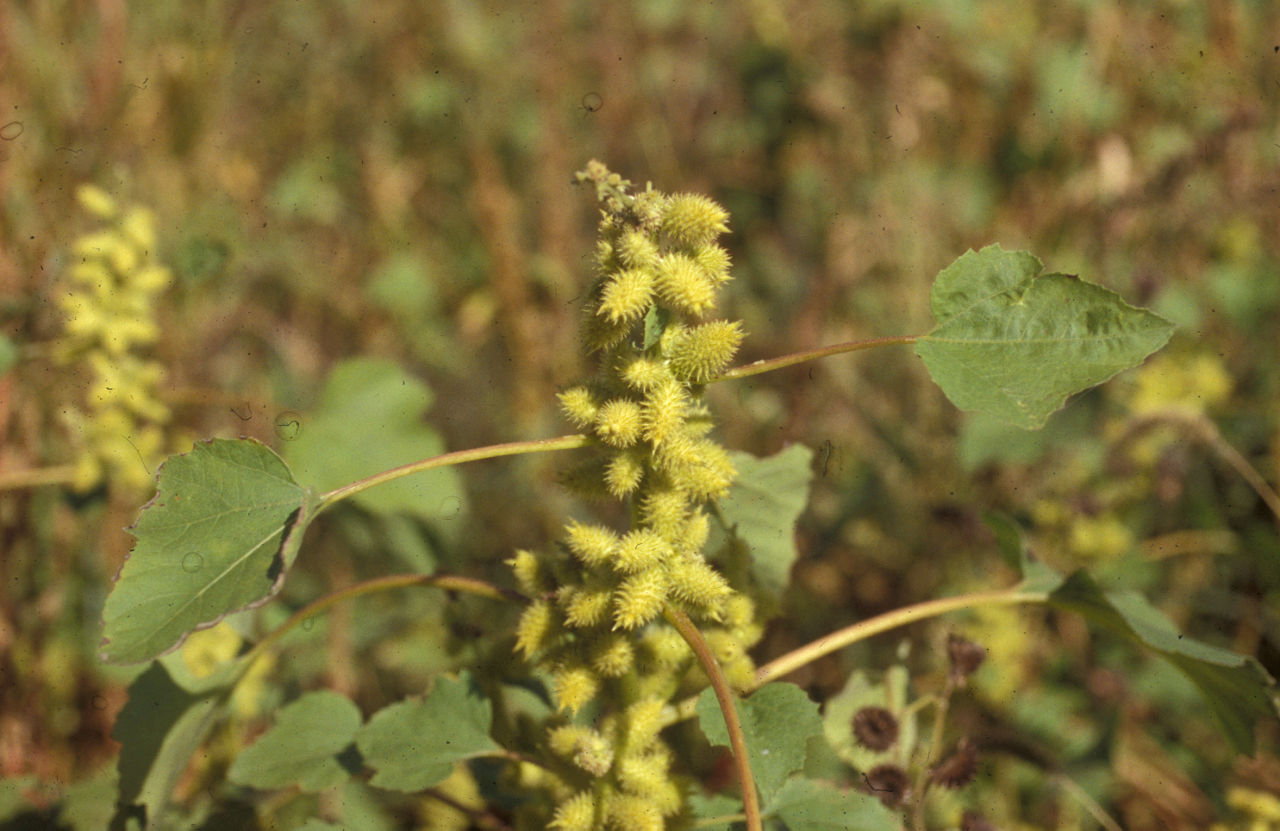
Identification: Common cocklebur is a summer annual and is considered one of the most competitive weed species. Common cocklebur can not only reduce yield potential but also causes harvest concerns with thick, woody stems. Seedling cotyledons are thick, fleshy, and narrow (Figure 74). The bur that contains the seed may remain attached to the base of the seedling, helping to identify the weed when pulled. The first leaf pair has an opposite arrangement; subsequent leaves are alternately arranged (Figure 75). Leaves are triangular with toothed margins, prominent veins, and rough to the touch (Figure 76). Leaves have a distinctive scent.
Mature plants can grow up to 5 feet tall and have thick, erect, and branching stems with purple or black spots. Flowers are small, inconspicuous, and can disappear soon after pollination. Fruit are football-shaped prickly burs with a pair of longer, hook-like spines at the tips, which may hook to clothes and/or animals, aiding in their dispersal (Figure 77). Two seeds are enclosed in the bur, one larger than the other, and they vary in their germination. Ingestion of cocklebur seeds or seedlings at 1% or more of body weight can be fatal to livestock.
Management: There are several preemergence and postemergence herbicide options available for management of common cocklebur. Due to some cocklebur with late emergence patterns, preemergence herbicides don’t always provide season-long control. Glyphosate provides excellent control in glyphosate-tolerant corn and soybean products. In soybean, postemergence herbicides also include foliar grass herbicides. Resistance to Group 2 (ALS inhibitors) herbicides has been identified in some populations.
Common name: Common lambsquarters
Scientific name: Chenopodium album
Life Cycle: Summer annual

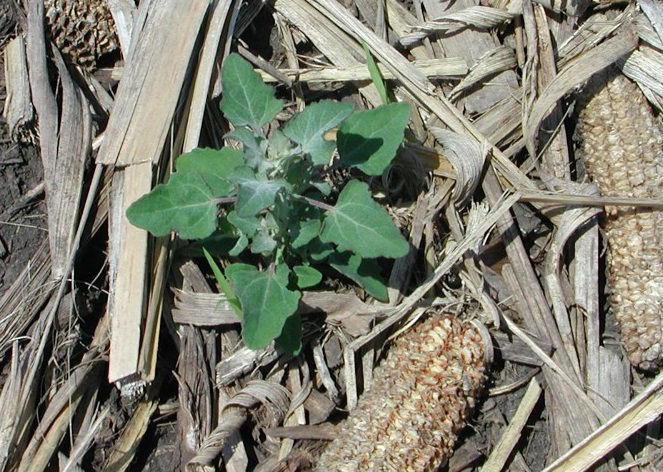
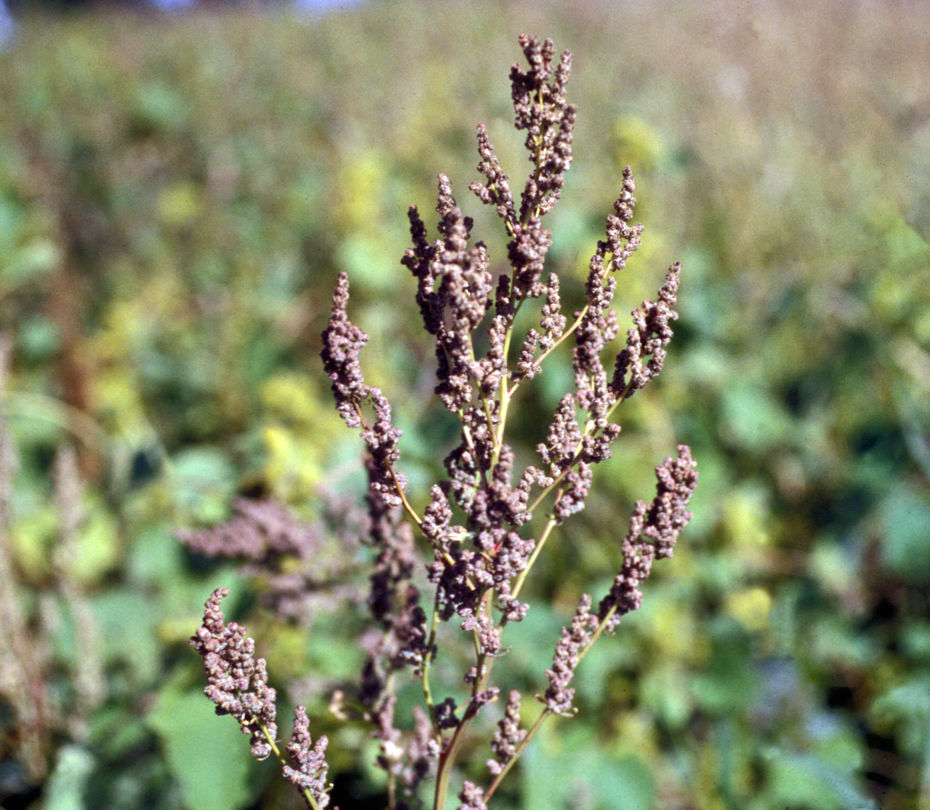
Identification: Common lambsquarters is an annual weed belonging to the goosefoot family and is one of the most prevalent weed species found in the corn growing region. Like many small-seeded annuals, common lambsquarters germinates at or near the soil surface with the optimum seed depth for emergence being about 1/10 of an inch. Initially, leaves appear opposite in arrangement, later becoming alternate, and may be purplish on the underside with both surfaces covered with white granules or a mealy substance (Figure 78). More mature plants have broad, triangle-shaped leaves with irregular, shallow-toothed margins (Figure 79). The stems are vertically grooved with green or reddish stripes, and hairless. Mature plants generally reach a height of 2 to 6 feet. An average common lambsquarters plant can produce more than 70,000 seeds (Figure 80). Common lambsquarters seed is one of the most persistent in the soil seedbank. On average, it takes 12 years to reduce common lambsquarters seed in the soil seedbank by 50% and 78 years to deplete the seedbank by 99%.1
Management: Since the 1970s, common lambsquarters has evolved resistance to two different herbicide sites of action including the triazines and ALS inhibitors. The most effective herbicide programs to control common lambsquarters combine preemergence and postemergence herbicide treatments and two or more herbicide sites of action, especially in soybean. The most effective common lambsquarters management programs include:
- Control of emerged weeds prior to planting with tillage or a preplant burndown herbicide application.
- Applying preemergence herbicides with activity on common lambsquarters.
- Applying postemergence herbicides before common lambsquarters exceed the recommended plant height for control, usually 4 to 6 inches.
- Controlling escapes or plants that emerge after the initial postemergence application with a second postemergence application. Common lambsquarters is similar to common ragweed in that it is much easier to control in corn and small grain crops than in soybean.
Sources:
Curran, W. September 20, 2017. Management of triazine-resistant pigweed and lambsquarters: an integrated approach. Agronomy Facts 10. Penn State Extension. http://extension.psu.edu
Common name: Eastern black nightshade
Scientific name: Solanum ptycanthum
Life Cycle: Summer annual
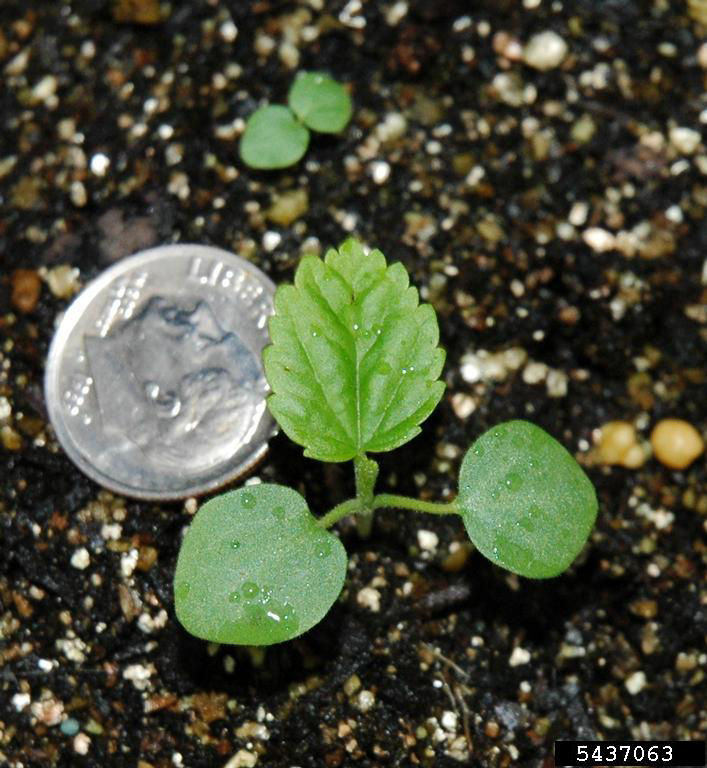
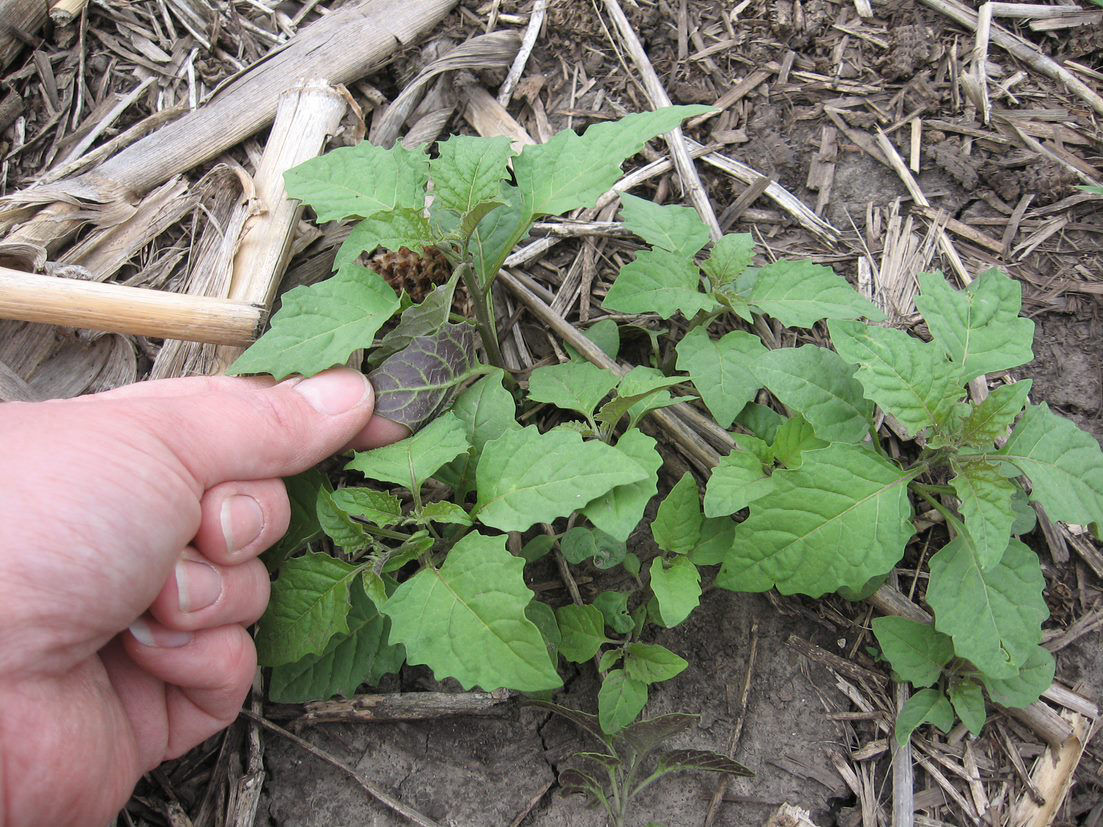

Identification: Eastern black nightshade is an erect summer annual that grows up to 3 feet tall. Seedling cotyledons are green on the upper surface and purple-tinted on the lower surface (Figure 81). Seedling stems are covered with small hairs and are green and also sometimes purple-tinted. Eastern black nightshade leaves are simple, alternate, egg- to diamond-shaped, slightly hairy, with smooth to irregularly-toothed margins (Figure 82). Eastern black nightshade lower leaf picture Flowers are white to purple-tinged, star-shaped, and found in downward-facing clusters. Mature berries are glossy, black, and globe-shaped and the plants are capable of producing hundreds of thousands of seeds per growing season (Figure 83).
Watchouts: All parts of the eastern black nightshade plant (except mature berries) are toxic to livestock. Although eastern black nightshade is capable of competing with crops and reducing yields, the greater concern is the ability to interfere with harvest and reduce seed quality. Berries can stain corn and soybean seed and foliage can plug combines and act as a source for fungal growth.
Management: Almost all preplant and postemergence corn herbicides provide good control of eastern black nightshade. However, the growth habit of eastern black nightshade is well adapted to common weed management practices in soybean. It can germinate after postemergence glyphosate applications and plants are very shade-tolerant, allowing it to grow undetected under the soybean canopy until the canopy senesces later in the season. In addition, there are ALS-resistant biotypes of eastern black nightshade in several Midwestern states. One of the best options for eastern black nightshade management in soybean is the application of preplant residual herbicides. Additionally, narrower row spacings have also been shown to contribute to overall eastern black nightshade management.
Sources:
Rich, A.M. and Renner, K.A. Row spacing and seeding rate effects on eastern black nightshade (Solanum ptycanthum) and soybean. Weed Technology 2007 21: 124-130.
Common name: Jimsonweed
Scientific name: Datura stramonium
Life Cycle: Summer annual
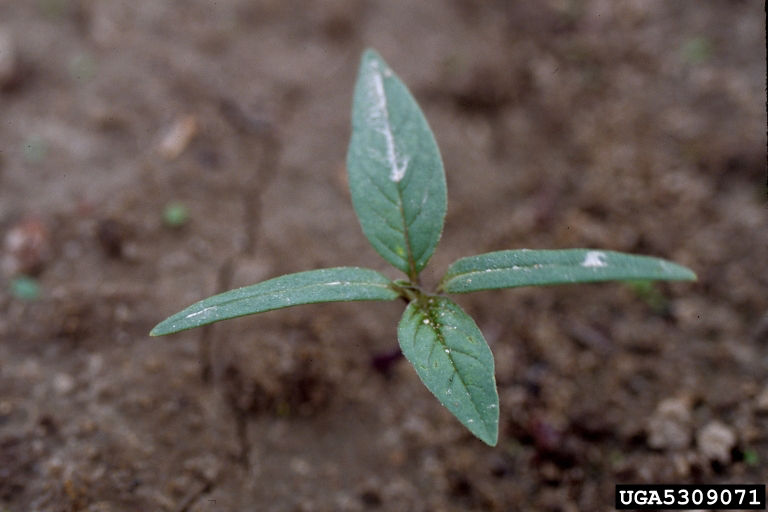
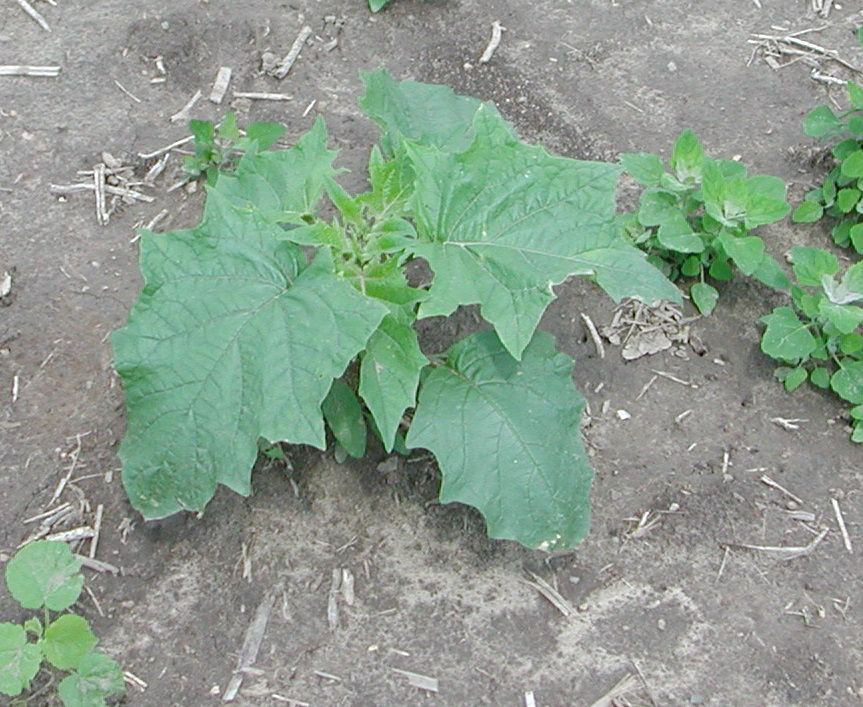

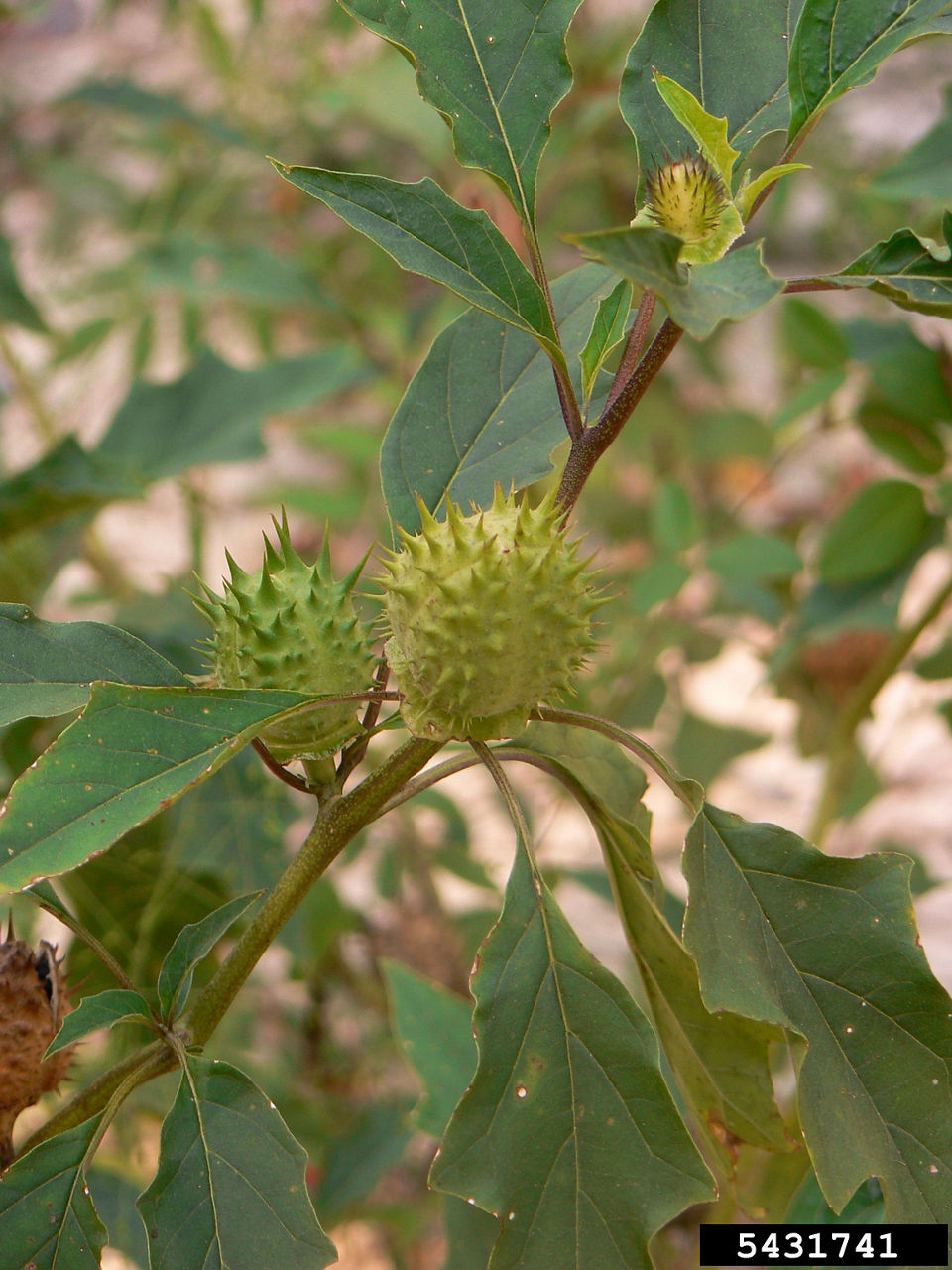
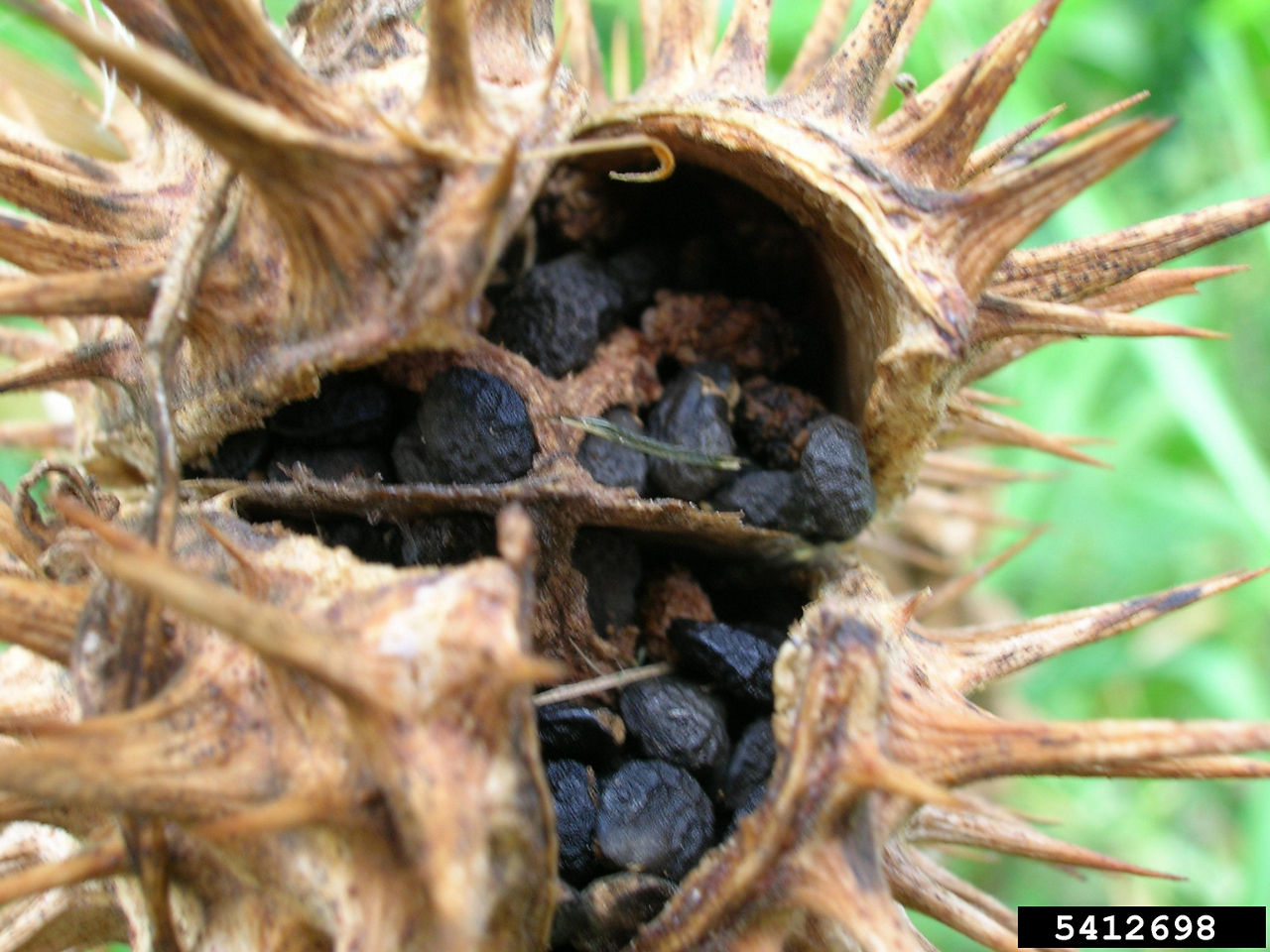
Identification: Jimsonweed is a member of the nightshade family and can reach up to 5 feet in height. It’s a tall, branching, leafy, rank-smelling annual, often with purple stems. Seedling cotyledons are thick, hairless, long, and linear with a prominent midvein (Figure 84). Common cocklebur cotyledons can be confused with jimsonweed. However, common cocklebur cotyledons lack the distinctive midvein. The distinctive odor of jimsonweed aids in identification. First true leaves are entire while later leaves have large, coarsely- and unevenly-toothed margins (Figure 85).
Flowers have large, white to purple petals and are fused into a long tube (Figure 86). Fruit are egg-shaped, spiny capsules with 4 valves (Figure 87). Each valve contains numerous flat, dark-brown to black, round to kidney-shaped seeds (Figure 88).
Management: Jimosnweed has a shallow root system that readily succumbs to cultivation, especially when small. There are several selective herbicide options that control jimsonweed.
Watchouts: Jimsonweed has long been known to be toxic to all classes of livestock and humans as well. All parts of the jimsonweed plant are poisonous.
Sources:
Weed ID Guide: Jimsonweed (Datura stramonium). Division of Plant Sciences. University of Missouri. http://weedid.missouri.edu
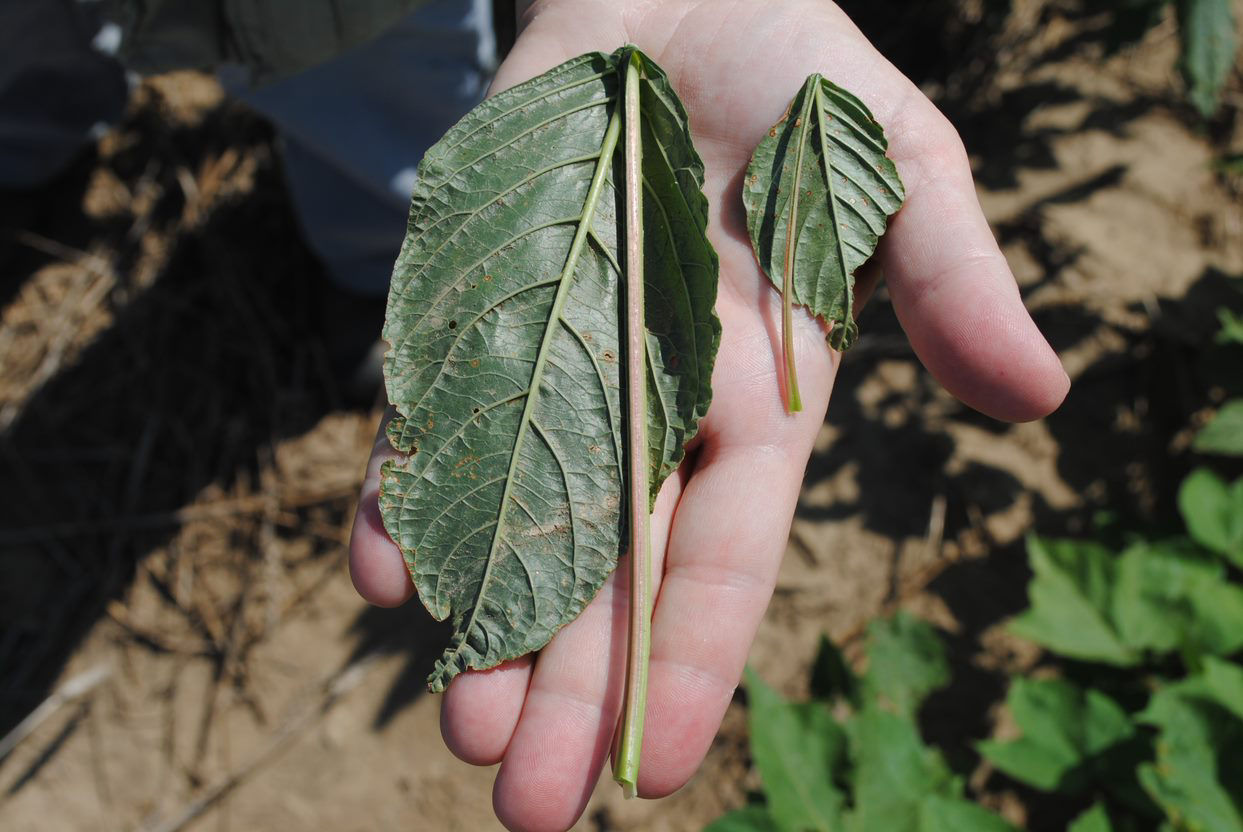
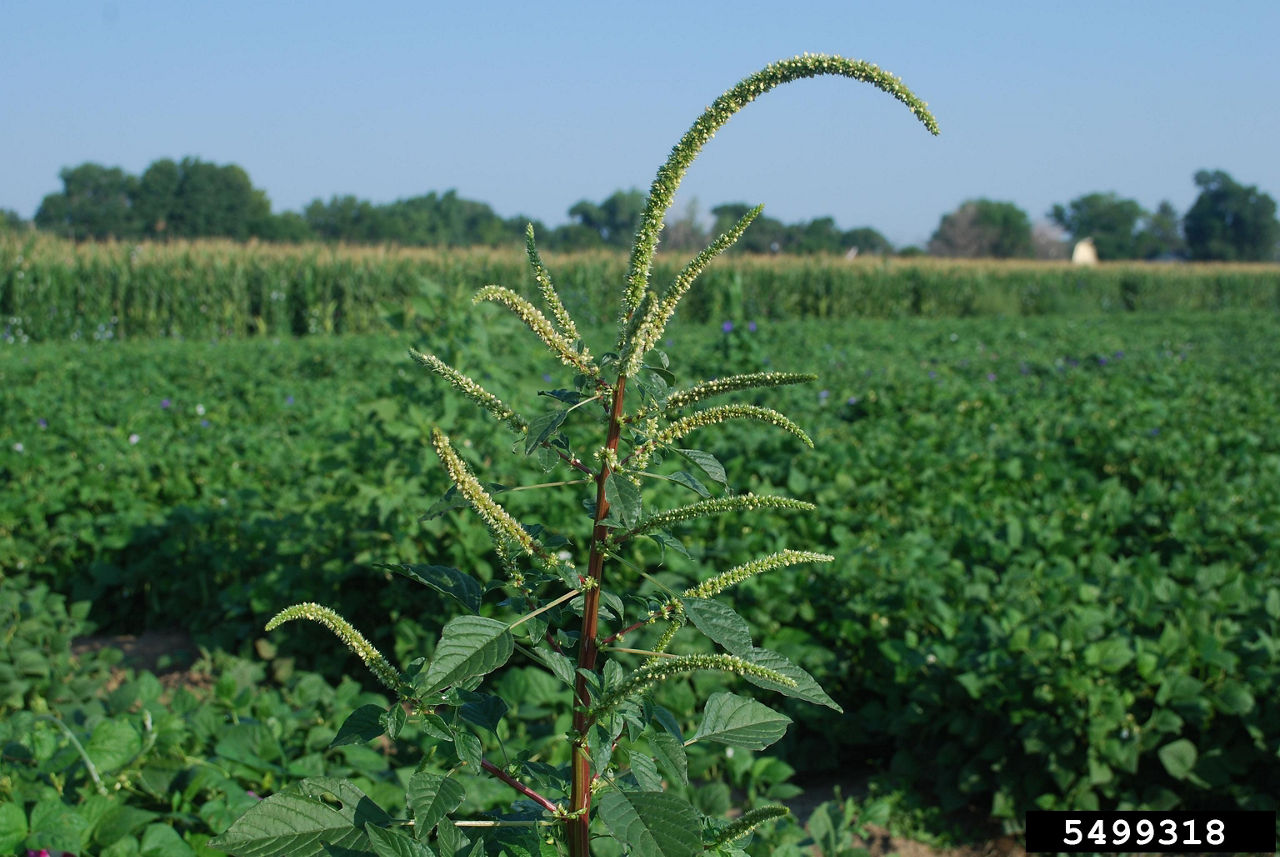

Identification: Palmer amaranth is one of several Amaranthus species found in the corn growing region. It is important to correctly distinguish Palmer amaranth from other Amaranthus species as it is aggressive, competitive, and has many characteristics common to plants that are prone to develop herbicide resistance. Palmer amaranth can reduce yield potential up to 91% in corn and 78% in soybeans.1
Similar in appearance to waterhemp and redroot pigweed, one way to distinguish Palmer amaranth from other pigweed species it to examine the leaf stem, or petiole. Palmer amaranth leaves, stems, and petioles are hairless and petioles are as long or longer than the leaf blade (Figure 89). Palmer amaranth leaves have a diamond- to ovate-shaped leaf that is widest at the base. In contrast, waterhemp has a more narrow, elongated leaf. Another distinguishing feature of Palmer amaranth is the small spike sometimes found at the tip of leaves. Leaves often have a poinsettia-like appearance with symmetrical arrangement (Figure 90). Petiole length is the most consistent and reliable characteristic that differentiates Palmer amaranth from waterhemp and is most evident on the oldest leaves. A quick way to determine petiole length is to simply pull a leaf off a plant and bend the petiole back over the leaf blade to compare petiole and leaf blade length (Figure 91).
This species is dioecious, having both male and female plants. The female plant has spiny bracts that give the plant a bristly texture and contains seeds (Figure 92). Male flowers have thin, triangular bracts, are soft, and shed pollen. Seeds are small, round, and dark reddish-brown and the seed head has the potential to be 2 feet long (Figure 93).1 Palmer amaranth is a prolific seed producer. A single female plant has the ability to produce 500,000 to 1 million seeds, which germinate at a higher rate than many other Amaranthus species.1,2 These seeds are small and easily mobile, contributing to the spread of this weed. However, Palmer amaranth seeds are relatively short-lived in the soil, with about 80% mortality in 3 years.3
Management: The ability to emerge throughout the growing season, rapid growth rate, prolific seed production, and the ability to evolve herbicide resistance makes Palmer amaranth one of the most difficult weeds to manage. Palmer amaranth has evolved resistance to 7 sites of action including Groups 2, 3, 4, 5, 9, 14, and 27.4 Several populations across the U.S. exhibit resistance to multiple herbicides. This leaves very few herbicide options available for management, particularly in soybean. Aggressive tactics are needed to effectively manage Palmer amaranth. Frequent and vigilant scouting coupled with accurate weed identification are the foundation of a prevention strategy. The integrated weed management plan should include multiple tactics in the current crop and throughout the rotation.
Accurate identification and early detection with frequent scouting of fields, fence lines, roadsides, and other crop areas.
Prevent seed production and dispersal. Scout fields after harvest. Remove weed escapes prior to weed seed maturity. A single female Palmer amaranth plant can produce up to 1 million seeds.
Clean harvest and tillage equipment to avoid spreading seed from field to field.
Till in the fall or spring or use burndown herbicide applications.
Always use a preemergence soil residual herbicide product that controls Palmer amaranth. Apply herbicides at full label rates. Use multiple herbicide applications with effective, unique sites of action and overlapping soil residual herbicides.2,3,4
Early postemergence herbicides must be applied before Palmer amaranth is 4 inches tall. Use full rates and tank mixtures with residual herbicides.
Integrate additional crops into the rotation. Diversifying the crop rotation makes effective use of cultural practices, crop competition, multiple herbicide sites of action, and varied herbicide application timing that can increase management options and help reduce the soil seedbank. Grass crops, such as corn, grain sorghum, or wheat, provide the best opportunity for management. Three to 5 years of alfalfa with good weed management can help exhaust seed reservoirs.
Watchouts: Palmer amaranth has 3 to 4 times the photosynthetic rate of corn, cotton, and soybeans. A high photosynthetic rate contributes to its ability to grow rapidly. This weed can grow in excess of 2 inches per day during the summer. This characteristic makes timely herbicide applications essential and adds to the management challenge.
Subsequent flushes of Palmer amaranth may require multiple postemergence applications or timely cultivation and hand pulling. Scout fields throughout the season so that management practices can be used to prevent Palmer amaranth from flowering and producing seed. Please work with your seed brand representative to determine the appropriate management strategy for your field.
Sources:
1Smith, P. 2011. The truth about pigweed. AgWeb. https://www.agweb.com/article/the_truth_about_pigweed/.
2 Steckel, L. 2007. The dioecious Amaranthus spp.: Here to stay. Weed Technology 21: 567-570.
3Sosnoskie, L.M., Culpepper, A.S., Kichler, J., and Webster, T. 2014. The biology and ecology of Palmer amaranth: Implications for control. University of Georgia Extension. Circular 1000. http://extension.uga.edu/publications/detail.html?number=C1000.
4Kumar, V. March 6, 2019. Confirmation of 2,4-D resistance and identification of multiple resistance in a Kansas Palmer amaranth (Amaranthus palmeri) population. Pest Management Science. 10.1002/ps 5400.
Common name: Common waterhemp
Scientific name: Amaranthus rudis
Life Cycle: Summer annual
)
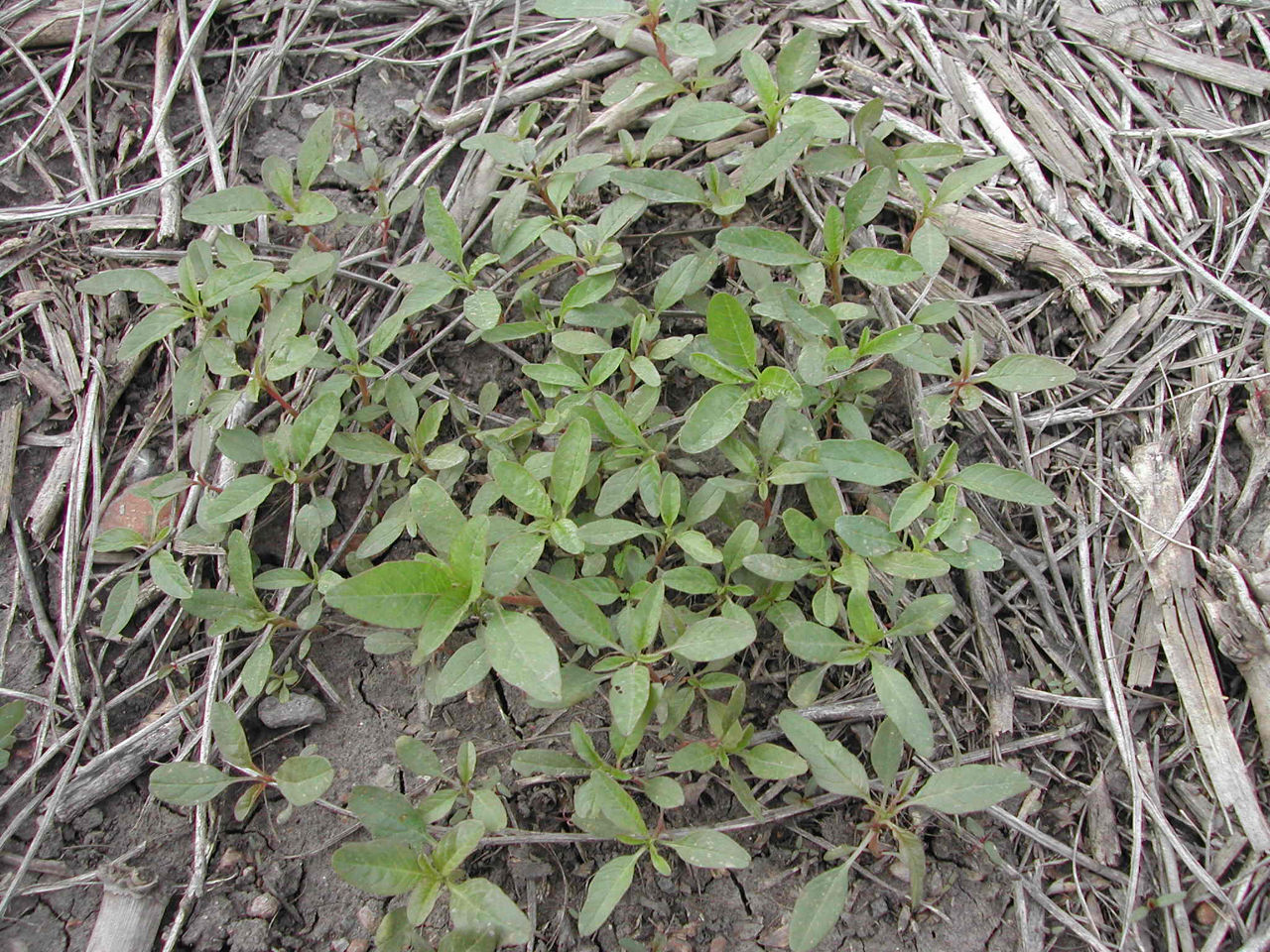
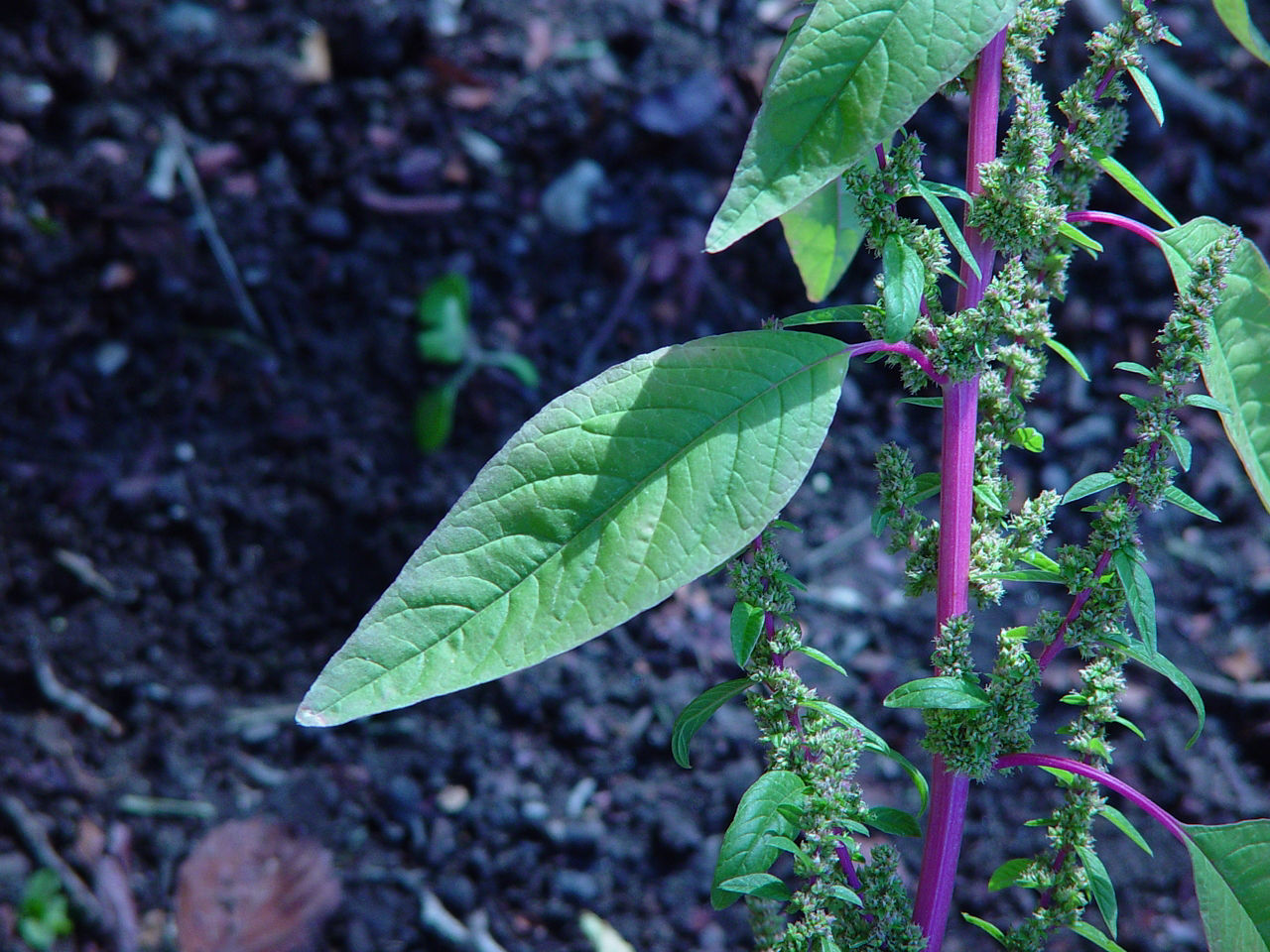
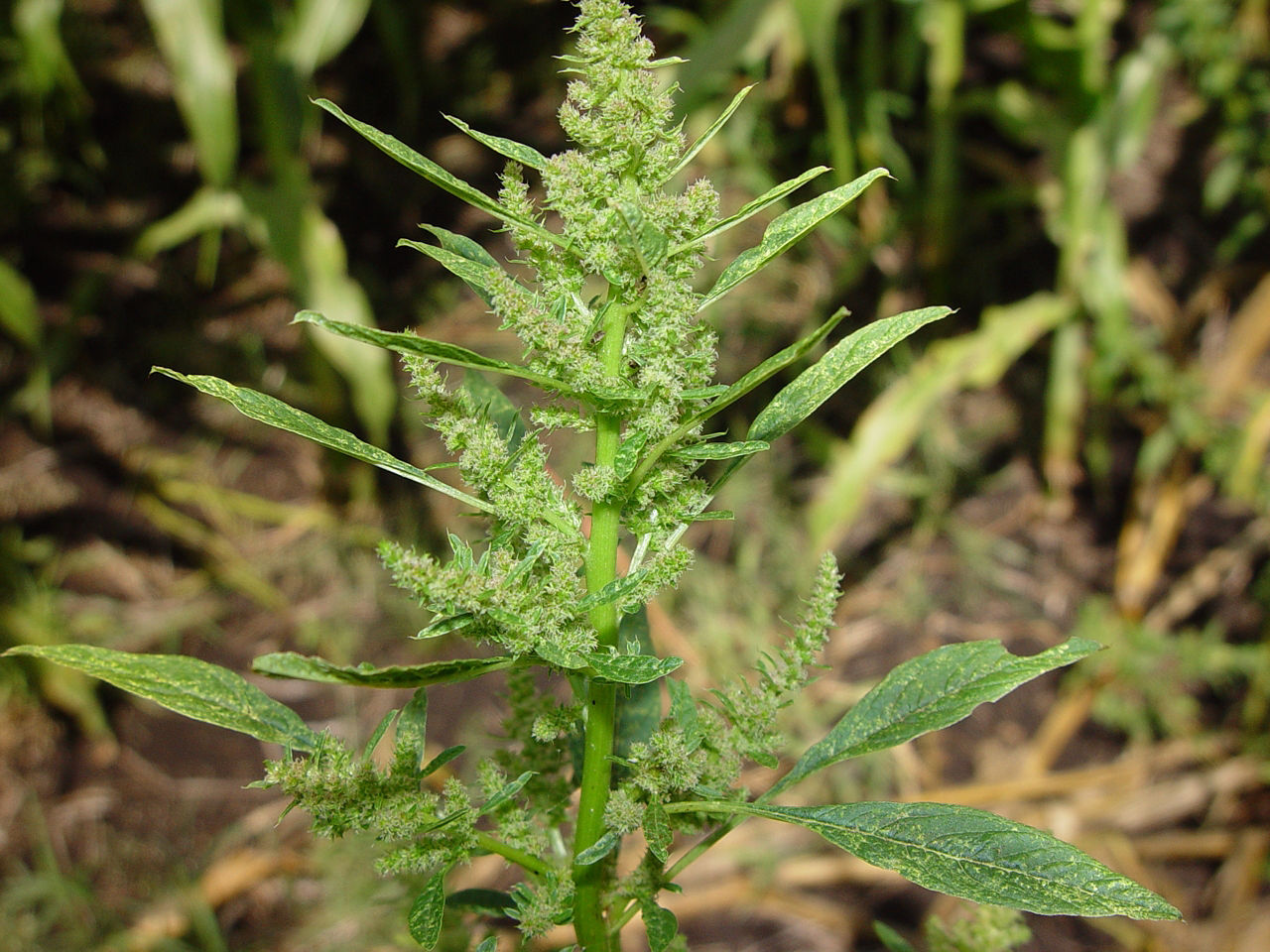
Identification: Waterhemp is a member of the pigweed (or Amaranth) family, which includes several weedy species including Palmer amaranth, redroot pigweed, and smooth pigweed. Distinguishing the different pigweed species from one another is challenging, especially in the seedling stages. There are a few key differences. Waterhemp cotyledons are often more egg-shaped than the long, linear cotyledons of other pigweed species (Figure 94). Waterhemp’s first true leaves are generally longer and more lance-shaped than other pigweeds (Figure 95). Waterhemp seedlings are hairless with leaves that look waxy or glossy. Waterhemp and Palmer amaranth stems are hairless, whereas other pigweeds have hairy stems.
Additionally, the leaf petiole is shorter than the length of the leaf blade (Figure 96). Common waterhemp is typically 4 to 5 feet tall but can grow upwards of 10 feet. Many small green flowers form an inflorescence (Figure 97). While the terminal inflorescence can be up to 1 foot long, many wiry lateral branches occur throughout the inflorescence. Male and female flowers are found on separate plants, and some populations may turn pinkish red as they mature (most are green).
Waterhemp plants emerge continuously and late into the season. They are prolific seed producers and can produce 300,000 or more seeds per plant.2 Seeds are small but can survive in the soil for several years. The extended emergence pattern and prolific seed production may require multiple herbicide applications in cropping systems. Production practices that enhance crop competitiveness and disrupt waterhemp seed production are extremely valuable tools for waterhemp management.
Waterhemp has a relatively higher growth rate than most weeds or crops at an upwards of 1 inch per day during the season.3 Competition from waterhemp resulted in a 44% reduction in yield in soybean in 30-inch row spacing and a 37% reduction in yield in 7.5-inch row spacing.5 Corn yield was reduced by 15%. However, delaying weed emergence in soybean beyond V5 resulted in only a 10% yield reduction and a 1% reduction in corn when waterhemp was controlled prior to 6 inches in height.5
Watchouts: Herbicide-resistant populations of waterhemp are prevalent throughout many U.S. states with some populations resistant to 3 to 5 herbicide sites of action. Populations have been found with resistance to Group 2 (ALS inhibitors), Group 4 (growth regulators), Group 5 (PSII inhibitors), Group 9 (glyphosate), Group 14 (PPO inhibitors), and Group 27 (HPPD inhibitors) herbicides and combinations of these groups.7 This level and prevalence of herbicide-resistant waterhemp make it necessary to integrate multiple management practices to achieve optimal control.
Management: Soil-applied preemergence herbicides represent the best chemical option for control of waterhemp biotypes resistant to glyphosate, ALS, PPO, and HPPD inhibitor herbicides. A preemergence herbicide application helps reduce early-season weed competition, adds additional sites of action to a weed management program, and expands the postemergence application window. There are several herbicides with alternative sites of action for use in soybean and corn. Sequential applications of herbicides with different sites of action and tank mixtures are the best options for waterhemp management. To maximize the effectiveness of soil-applied preemergence herbicides, select the preemergence herbicides based on the weed spectrum in each field and use full labeled rates. Scout each field regularly to determine in-crop application timing and to identify waterhemp that may have escaped the previous application or emerged late.
Continuous emergence of waterhemp normally requires the use of postemergence herbicide applications even following preemergence herbicide applications. Waterhemp should be sprayed when actively growing and at or before 4 inches in height. Thorough spray coverage is essential, particularly when tank-mixing other herbicides with glyphosate.
In recent years, there has been an increased interest in using cover crops to help increase soil health and system sustainability. Combining cover crops and herbicides may also be an effective strategy against aggressive weeds like waterhemp and Palmer amaranth.
Sources:
1Costea, M., Weaver, S.E., and Tardif, F.J. 2005. The biology of invasive alien plants in Canada. 3. Amaranthus tuberculatus (Moq.) Sauer var. rudis (Sauer). Can. J. Plant Sci. 85:507-522.
2Sellers, B.A., Smeda, R.J., Johnson, W.G., Kendig, J.A., and Ellersieck, M.R. 2003. Comparative growth of six Amaranthus species in Missouri. Weed Sci. 51:329-333.
3Seibert, A.C. and Pearce, R.B. 1993. Growth analysis of weed and crop species with reference to seed weight. Weed Sci. 41:52-56.
4Hartzler, B. and Battles, B. 1998. Late-emerging waterhemp - how big of a problem? Iowa State Weed Science online.
5Nordby, D., Hartzler, B., and Bradley, K. 2007. Biology and management of waterhemp. GWC-13.
6Hartzler, R. 2000. Early season weed competition. Iowa State University Integrated Crop Management.
7Waterhemp. Integrated Weed Management Resource Center. http://integratedweedmanagement.org
Common name: Redroot pigweed
Scientific name: Amaranthus retroflexus
Life Cycle: Summer annual
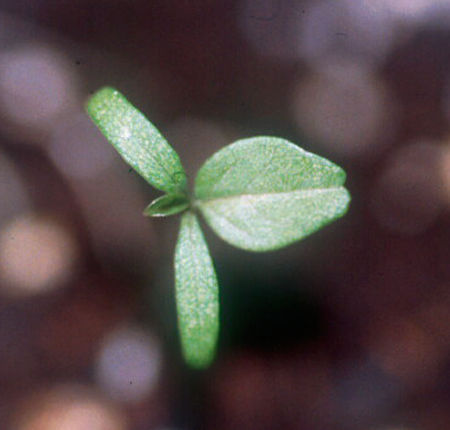
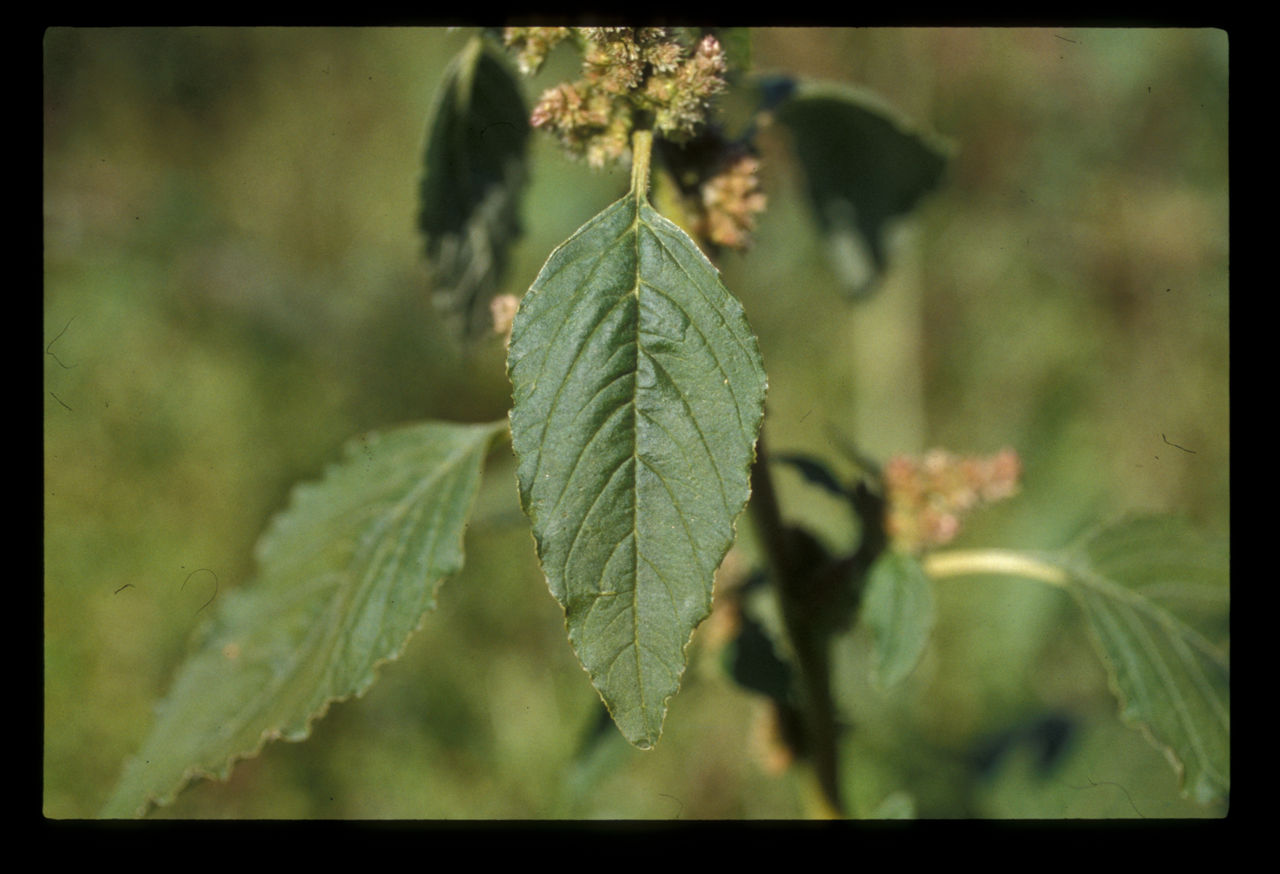
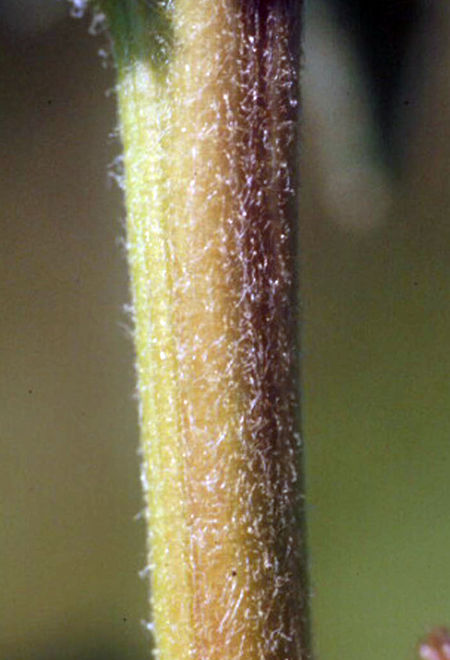
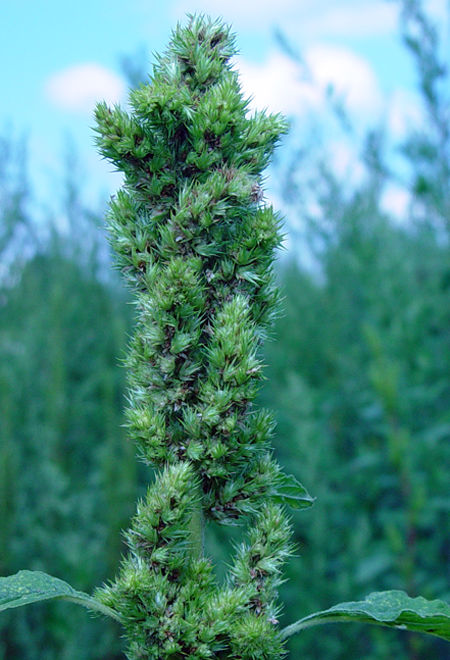
Identification: Redroot pigweed is a summer annual that is an abundant seed producer and can be found throughout the U.S. It is important to note that there is often physical variation within pigweed species and that crossing can occur between species, resulting in hybrid plants. Redroot pigweed can be difficult to distinguish from other pigweeds, but identification is important for management. Cotyledons are linear with a prominent midvein and reddish-tinted undersides (Figure 98). Leaves are alternate and egg-shaped with a small notch in the tip (Figure 99). Leaf surfaces are rough with hairs on the underside, most notably, the veins. As seedlings mature, the stem becomes very roughly hairy (Figure 100).
Stems grow up to 6 feet in height, are pale green to reddish, and usually red at the base. Small, greenish flowers grow in dense terminal and auxiliary clusters (Figure 101). Clusters are thick, prickly spikes up to 8 inches long. Flowers have bracts about twice as long as the sepals and yield small, round, shiny, black seeds. A single, large, mature plant of redroot pigweed can produce well over 200,000 seeds.
Similar Species: Redroot pigweed can be confused with smooth pigweed (Amaranthus hybridus), which differs by having hairless leaves, slightly hairy upper stems, and narrower, less dense, less prickly seed heads (Figures 102 and 103). Smooth pigweed flowering stems are the shortest of the pigweeds.
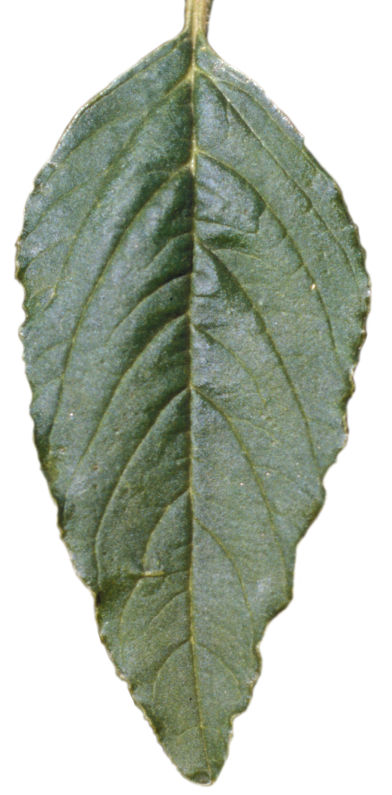
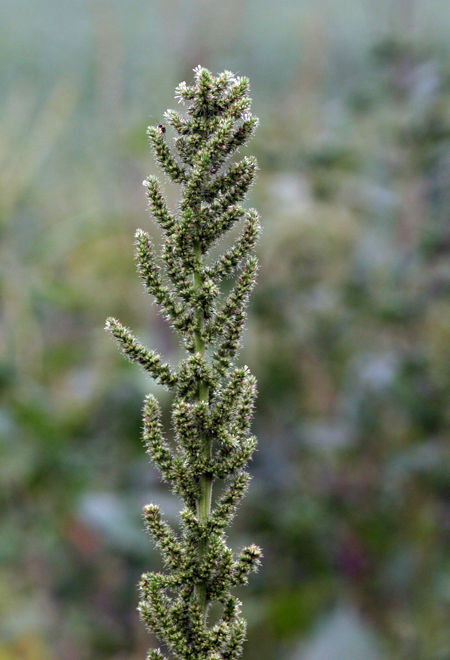
Management: The genetic variability and potential to hybridize with other weedy amaranths species contributes to the capacity for pigweed to adapt to different environments, climates, production systems, and control tactics. In recent years, Palmer amaranth and waterhemp have superseded redroot and smooth pigweeds as top concerns for farmers in many areas. Herbicide-resistant populations of redroot pigweed are present in 20 states with widespread resistance to Group 2 (ALS inhibitors) and Group 5 (triazines) herbicides. Populations with multiple resistance to Group 2 + Group 5 and Group 5 + Group 7 (PSII inhibitors) have also been found. Therefore, producers dealing with redroot pigweed should diversify the herbicide sites of action in tank mixes and between seasons. Avoiding the use of the same herbicide site of action 2 years in a row will help decrease the chance of populations developing resistance.
Sources:
Curran, W. September 20, 2017. Management of triazine-resistant pigweed and lambsquarters: an integrated approach. Agronomy Facts 10. Penn State Extension. http://extension.psu.edu
Pratt, D., Owen, M.D.K., Clark, L.G., and Gardner, A. April 1999. Identification of the weedy pigweeds and waterhemps of Iowa. Pm-1786. Iowa State Extension. http://agron.iastate.edu
Steckel, L. 2005. Mature pigweed identification. W072. University of Tennessee Extension. http://extension.tennessee.edu
Common name: Morningglory species
Scientific name: Ipomoea
Life Cycle: Summer annual
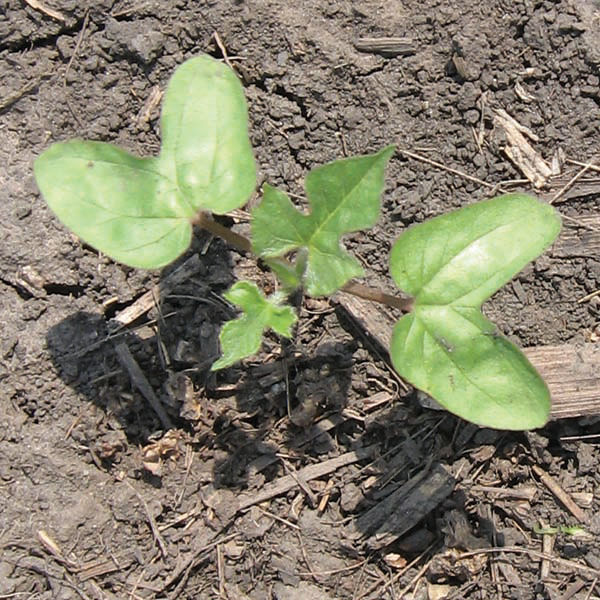
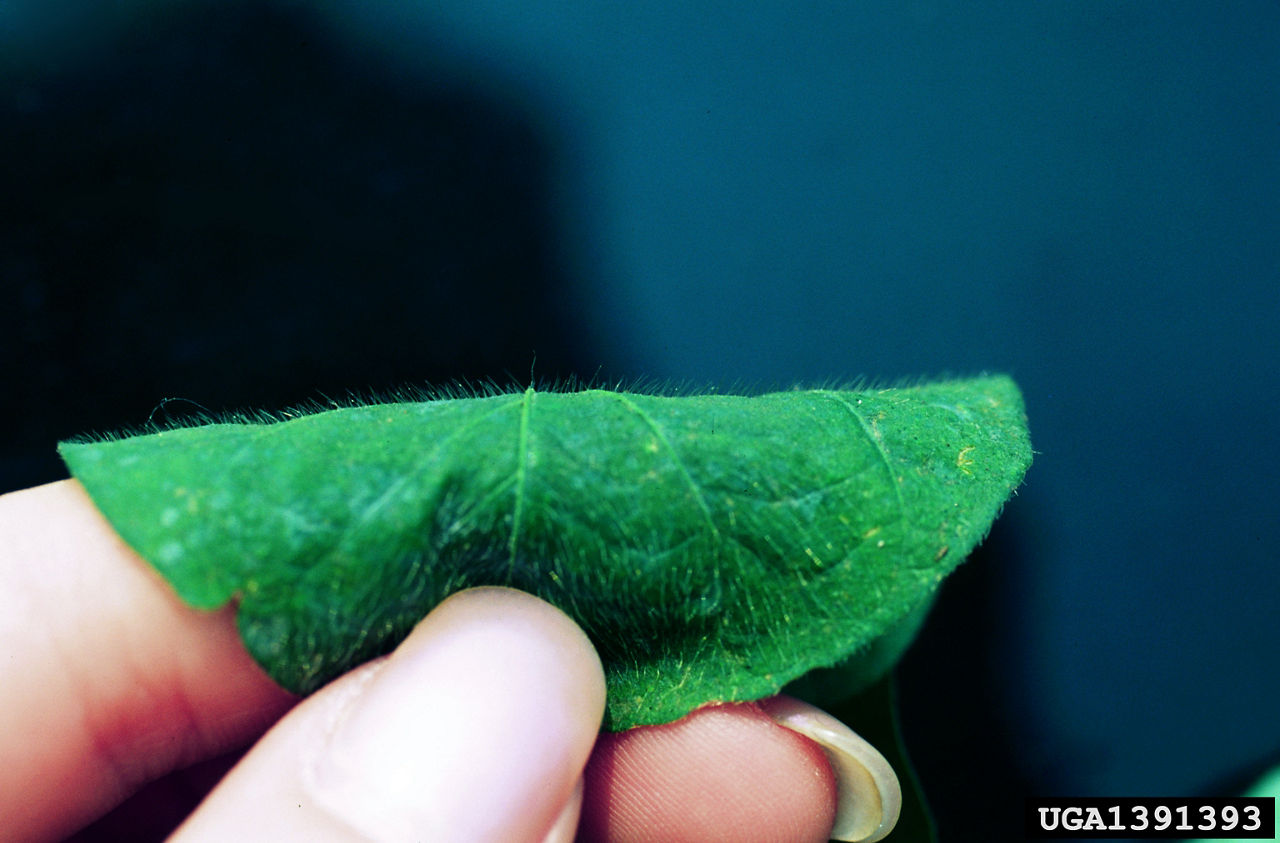
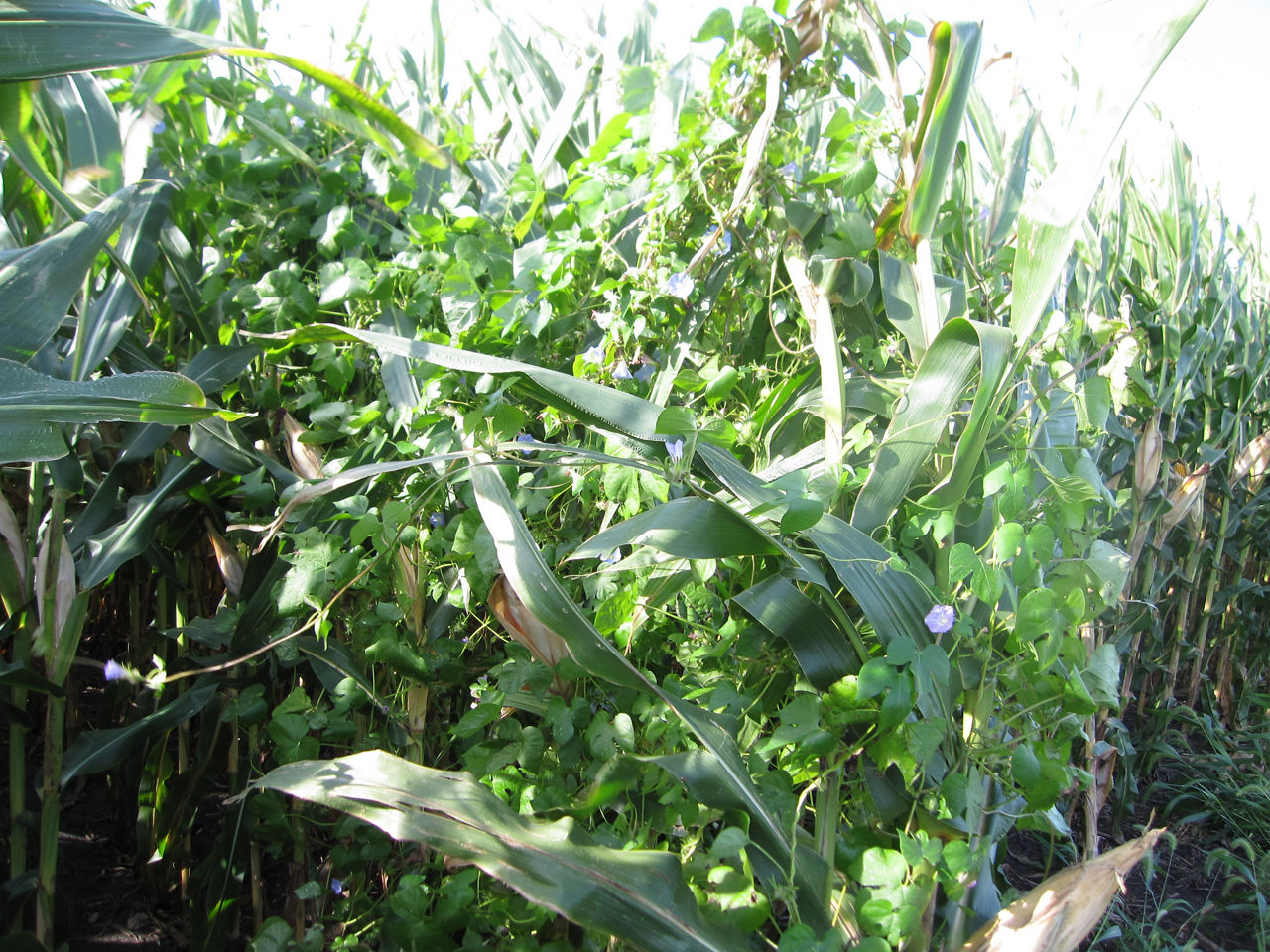
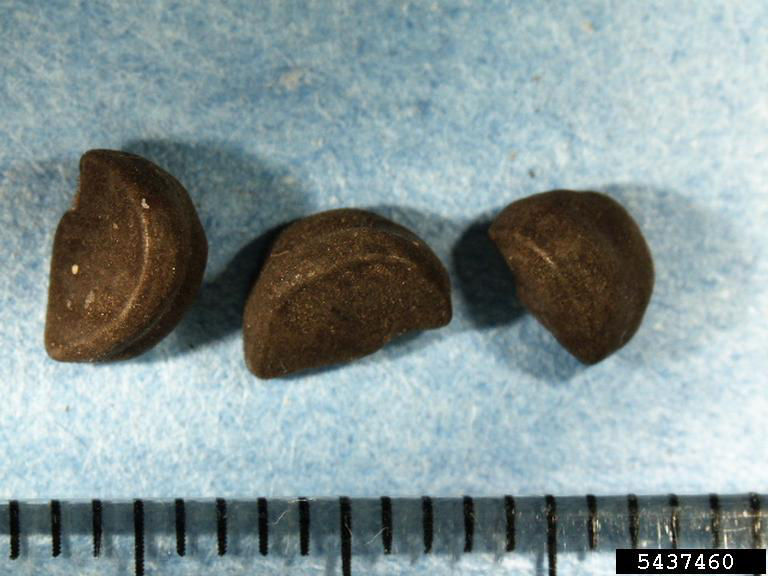
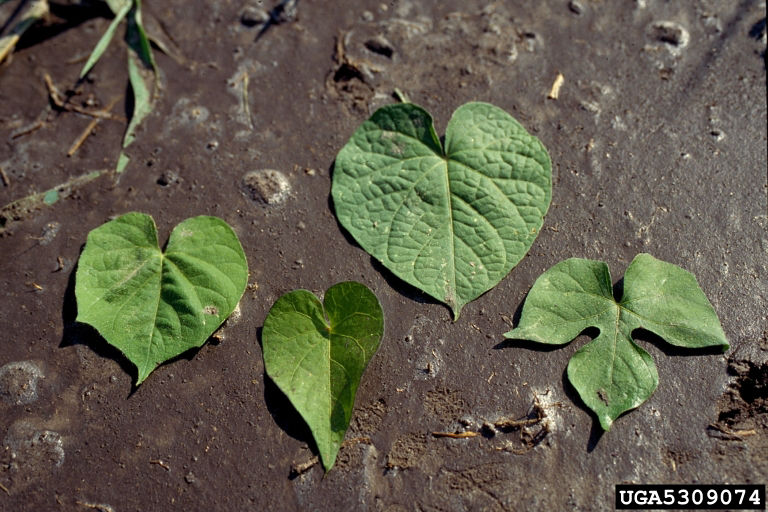
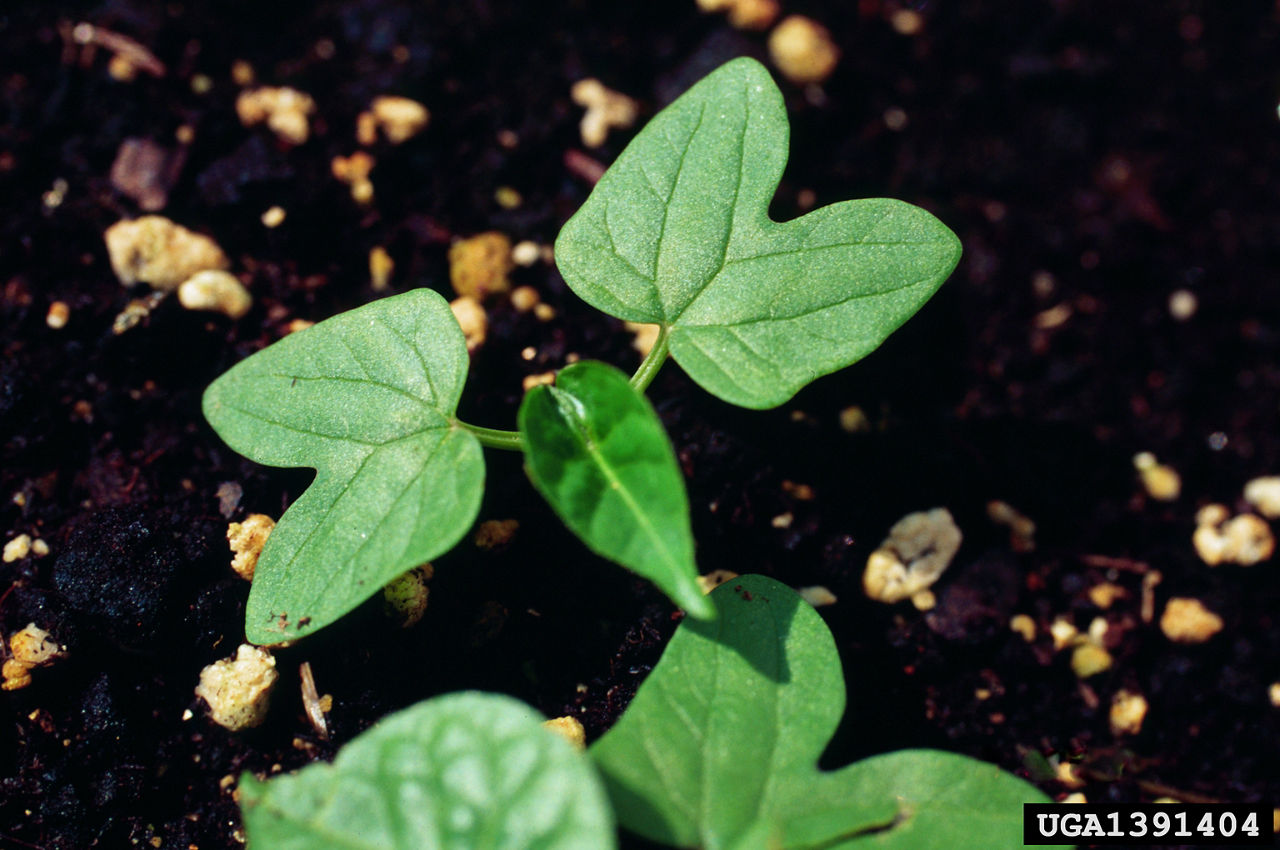
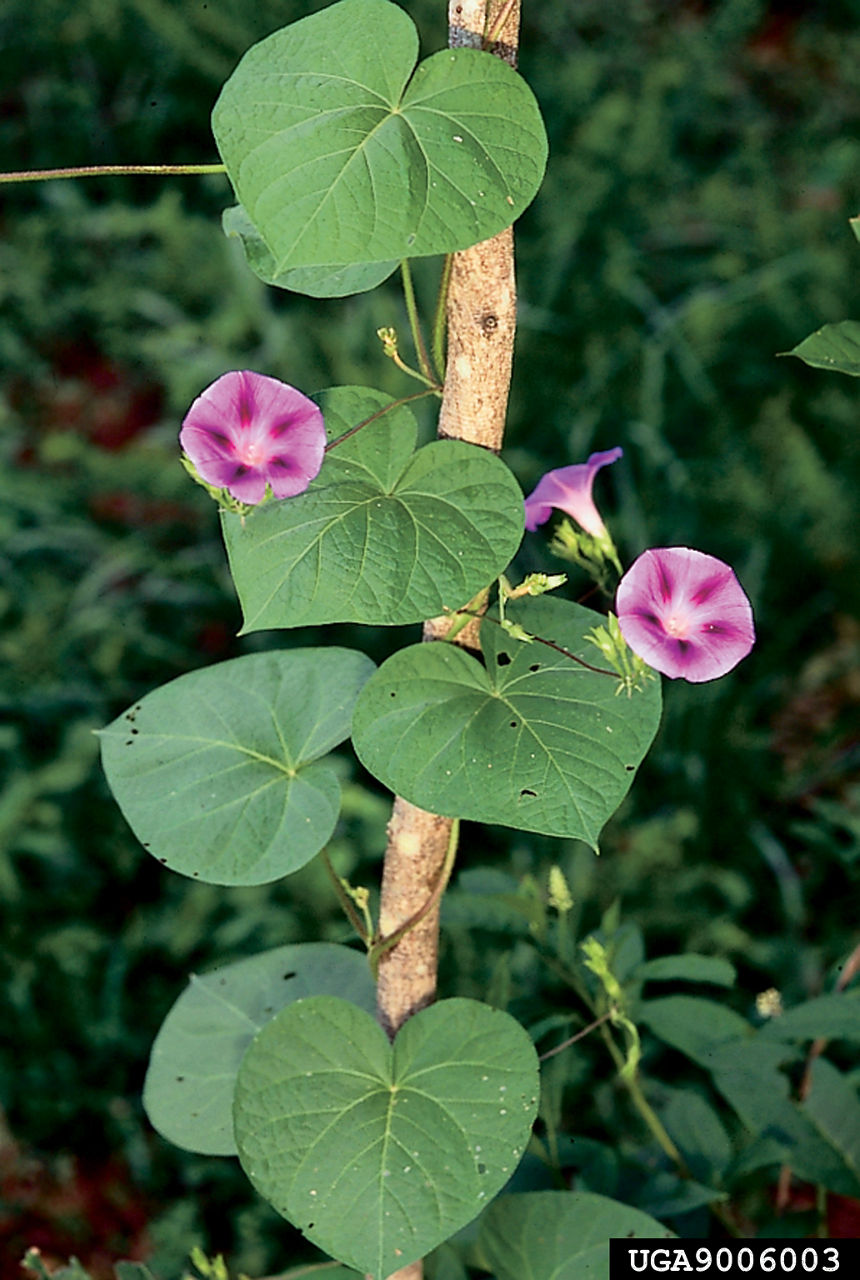
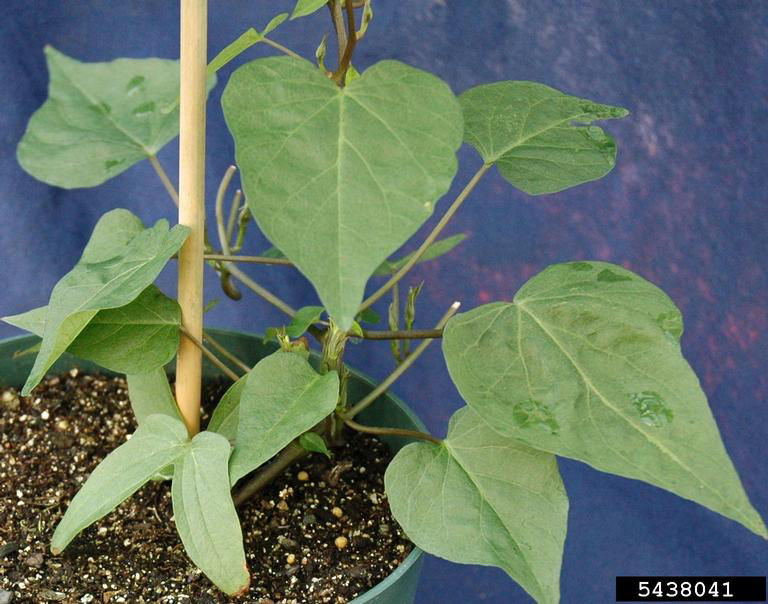
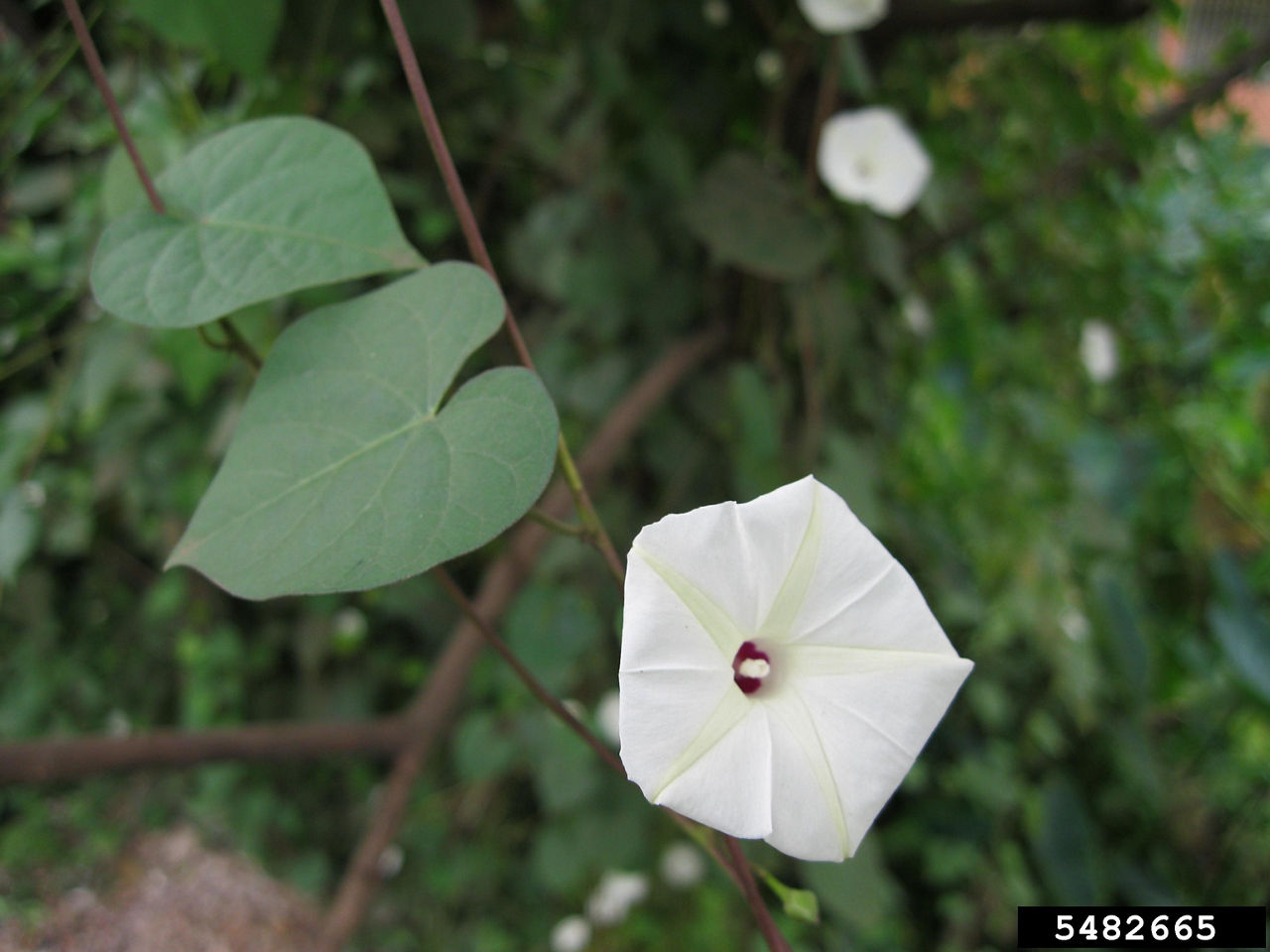
Morningglory species can be invasive pests of agronomic crops. They are summer annual, trailing or climbing vines that can grow up to 10 feet. Stems twine in whorls coiling clockwise. The 4 species of morningglory that occur most frequently are ivyleaf morningglory, entireleaf morningglory, tall morningglory, and pitted morningglory.
Ivyleaf morningglory (Ipomoea hederacea) has butterfly-shaped cotyledons that are usually narrower and the base (Figure 104). Leaves are alternate and ivy-shaped with erect hairs on both surfaces (Figure 105). The first leaf may be unlobed but all other leaves are three-lobed. Stems are densely hairy with hairs that stick straight out. Flowers are blue to purple or sometimes white petals fused into a funnel (Figure 106). Fruit are capsules shaped like a slightly-flattened ball and contain 4 to 6 dark-brown to black, wedge-shaped fruits (Figure 107).
Entireleaf morningglory (Ipomoea hederacea var. integruiscula) differs from ivyleaf only by having heart-shaped leaves (Figure 108). Leaf hairs are erect on both leaf surfaces.
Tall morningglory (Ipomoea purpurea) differs from ivyleaf by having a butterfly-shaped cotyledon with the tip and base of similar width and heart-shaped leaves with dense hairs that lie flat (Figures 109 and 110).
Pitted morningglory (Ipomoea lacunosa) differs from ivyleaf by having v-shaped cotyledons and heart-shaped leaves with few to no hairs (Figure 111). In addition, white flowers set it apart from tall morningglory, which usually has large, purple, showy flowers (Figure 112)
Management: The large seed size coupled with a hard, impenetrable seed coat can make morningglory more difficult to control with preemergence herbicides. The ability of morningglory species to emerge throughout the growing season adds to the challenge to manage. Its vining, climbing nature makes morningglory difficult to culturally control. Thin crop stands that allow light to penetrate the soil favor emergence of this weed. In addition, corn fields that have lost their tops due to maturity, wind, or insect damage can allow a late-season infestation. Crops wrapped in morningglory can complicate harvest efficiency. There are several herbicides used in corn and soybean to control these weeds.
Common name: Common ragweed
Scientific name: Ambrosia artemisiifolia
Life Cycle: Summer Annual
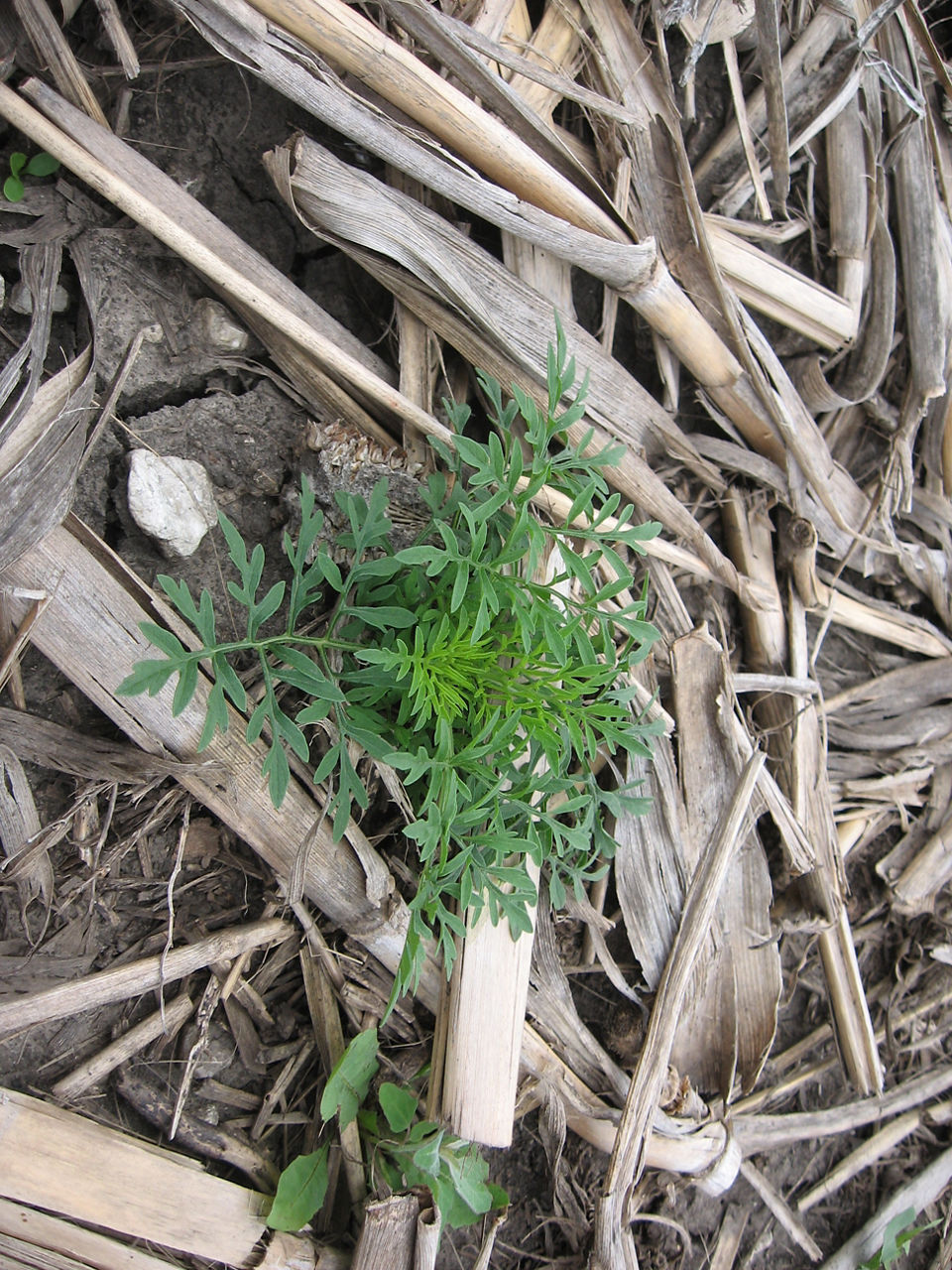
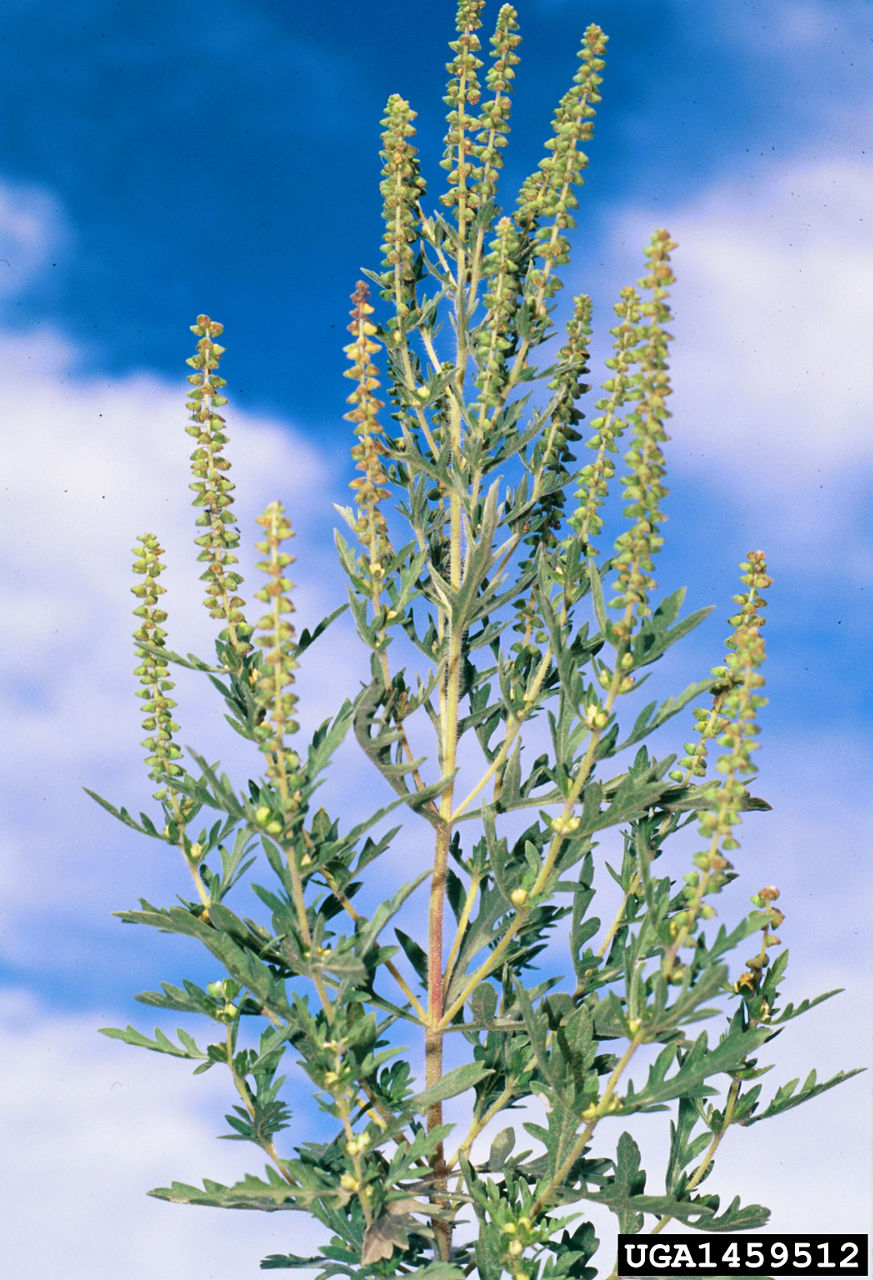
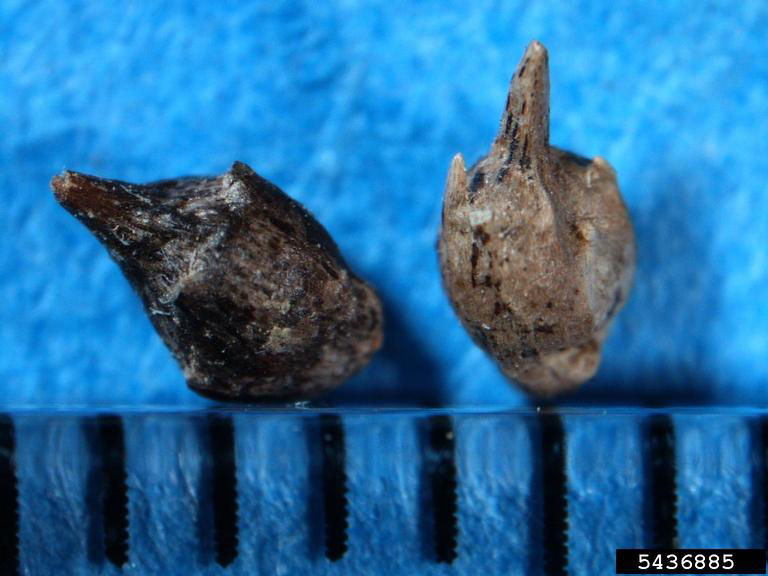
Identification: Common ragweed is native to the U.S. and Canada and is a common weed in agricultural settings. It has a shallow, fibrous root system and grows from 2 to 4 feet high. The leaves are lacy, finely-divided, and usually slightly hairy (Figure 113). The seeds are achenes topped with several spikes and resemble a crown (Figures 114 and 115).
Watchouts: Synchronous early-season germination is characteristic of common ragweed in non-crop situations. Common ragweed emerging with the crop can substantially reduce yield potential but, similar to many other weed species, is less likely to reduce yields when the crop can grow under weed-free conditions for 2 to 4 weeks after emergence. Management practices that promote a uniform canopy can help suppress the growth of ragweed.
Management: Common ragweed populations in several states have confirmed resistance to Group 2 (ALS inhibitors), Group 9 (glyphosate), and Group 14 (PPO inhibitors) herbicides with some even having multiple resistance. Comprehensive weed management should include scouting to determine the appropriate preplant tillage or burndown herbicides for ragweed control. Control all ragweed seedlings prior to planting with tillage or preplant burndown herbicides. For optimal control, herbicides should be applied when ragweed are under 4 to 6 inches tall. Successful management programs must include both preemergence and postemergence applications with at least two effective herbicide sites of action.
Sources:
Jordan, T., Nice, G., Smeda, R., Sprague, C., Loux, M., and Johnson, B. 2010. Biology and management of common ragweed. Glyphosate, Weeds, and Crops Series. GWC-14. Purdue University Extension. http://extension.purdue.edu
Common name: Giant ragweed
Scientific name: Ambrosia trifida
Life Cycle: Summer annual
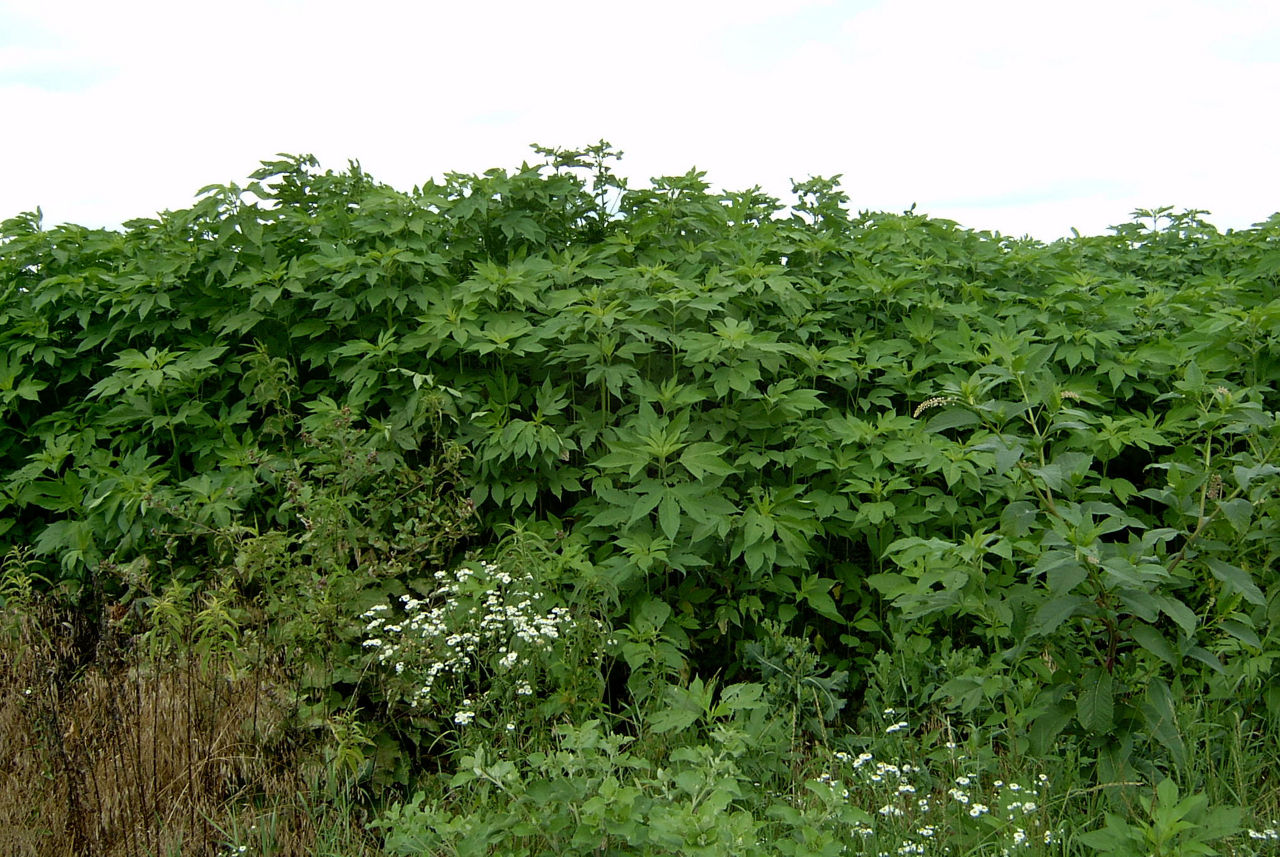
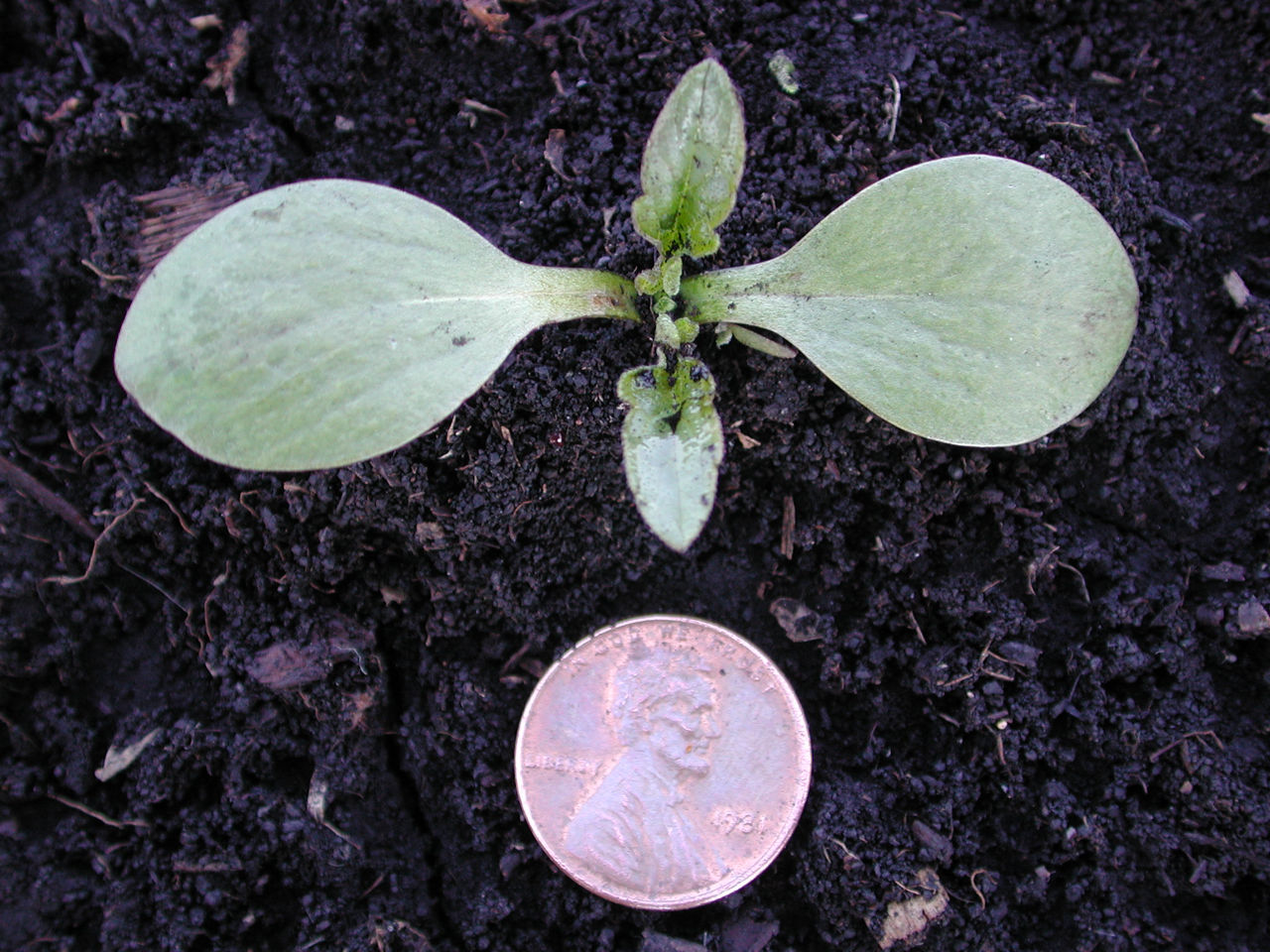
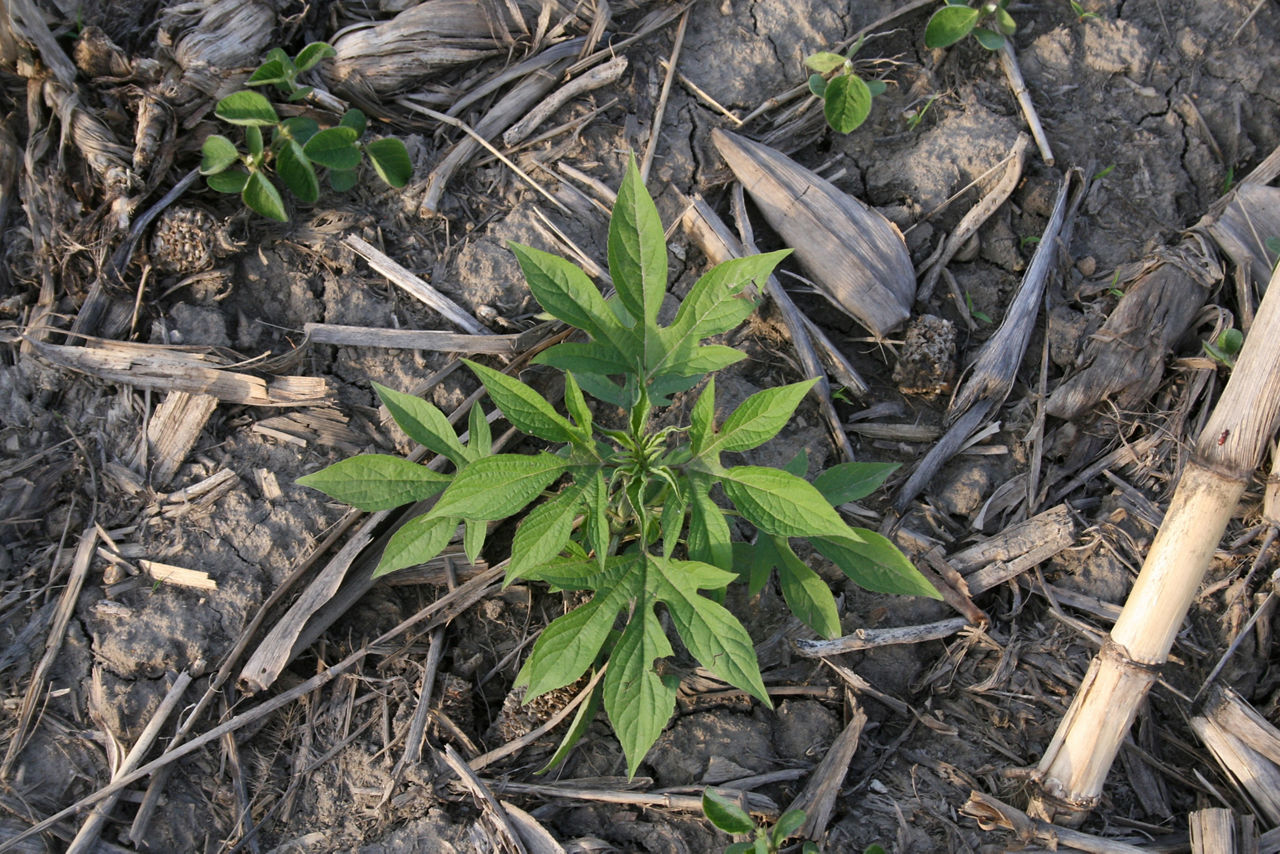
Identification: In row crops, giant ragweed is commonly a problem in midwestern and south-central states. Plants can exceed 15 feet tall and can cause a significant reduction to yield (Figure 116). The seedlings can be identified by their very large cotyledons (Figure 117). Giant ragweed has simple, large leaves with 3 to 5 deep lobes in an opposite arrangement (Figure 118).
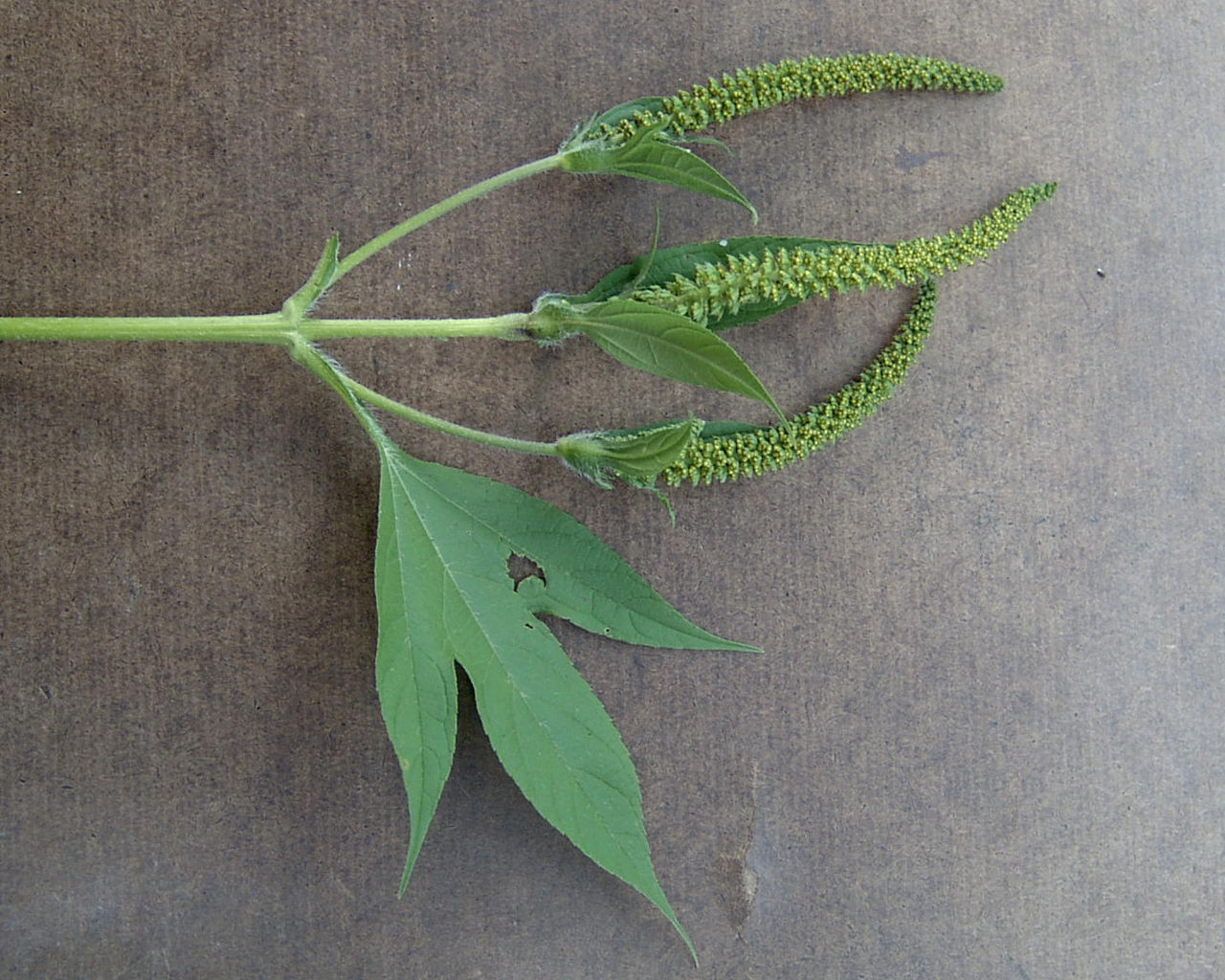
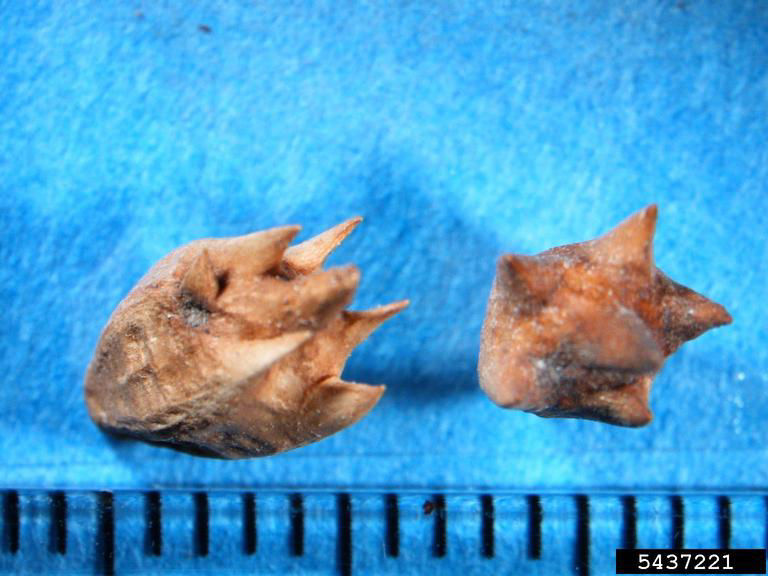
Giant ragweed typically emerges early in the growing season, as early as March, although some populations have adapted extended emergence dates into early summer. Emergence patterns can vary among fields and region based on prior management practices. Giant ragweed is often 1 to 5 feet taller than the crop and plants can bloom from July through October. Giant ragweed flowers are generally inconspicuous, found on terminal branches (Figure 119). They produce prolific amounts of pollen. Giant ragweed produces large, crown-shaped seeds with points and ridges along the top of the seeds (Figure 120).
Management: Farmers should evaluate the performance of previous herbicide applications, scout, and understand emergence patterns to determine the best management practices. Giant ragweed has a competitive advantage over other weeds and crops due to its early-season emergence, rapid growth rate, large leaf area, and prolonged emergence period. The prolonged emergence period may allow some giant ragweed biotypes to outlast preemergence soil-applied herbicides. Management practices that promote a uniform canopy can help suppress the growth of ragweed and other species with extended germination periods. Tillage controls emerged giant ragweed seedlings but can also stimulate germination. Long-term no-till practices along with proper herbicide management can help reduce giant ragweed populations.
Giant ragweed populations have been confirmed with resistance to Group 2 (ALS inhibitors) and Group 9 (glyphosate) herbicides with some populations exhibiting resistance to both sites of action. To manage giant ragweed, start by controlling all emerged weeds prior to planting either with thorough tillage or an effective burndown. The use of a residual herbicide either in combination with a burndown or at planting in a tilled seedbed will help provide suppression of later-emerging giant ragweed. With dense populations of giant ragweed, multiple postemergence applications will likely be needed, especially in populations that exhibit extended germination. Postemergence options may be limited in ALS- and glyphosate-resistant populations. Herbicide application timing is critical for effective control. Multiple effective herbicide sites of action should be used to aid against further resistance.
Sources:
Johnson, B., Loux, M., Nordby, D., Sprague, C., Nice, G., Westhoven, A., and Stachler, J. 2007. Biology and management of giant ragweed. GWC – 12. Glyphosate, Weeds, and Crops Series. Purdue University Extension. http://extension.purdue.edu
Common name: Kochia
Scientific name: Kochia scoparia
Life Cycle: Summer annual
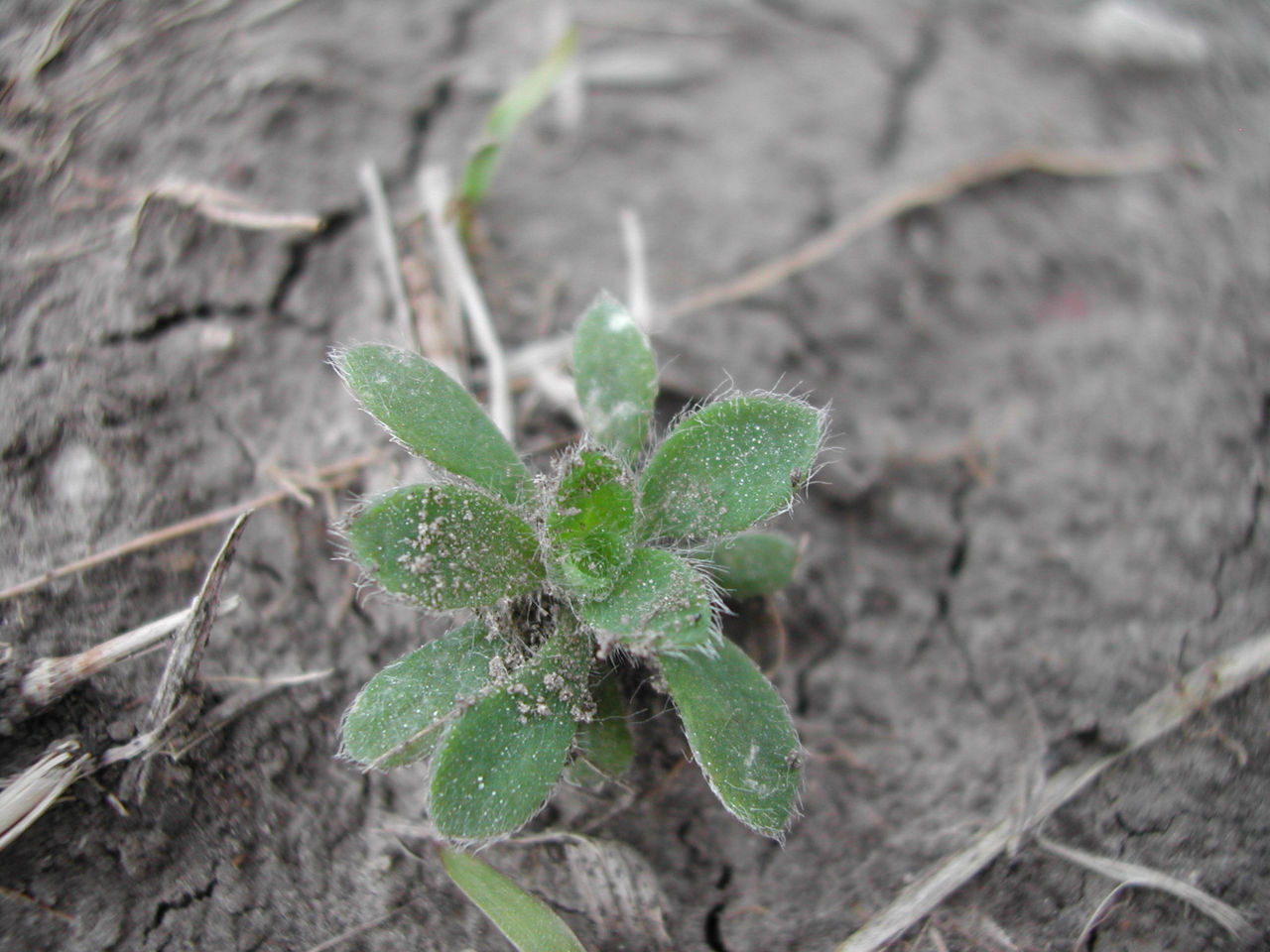

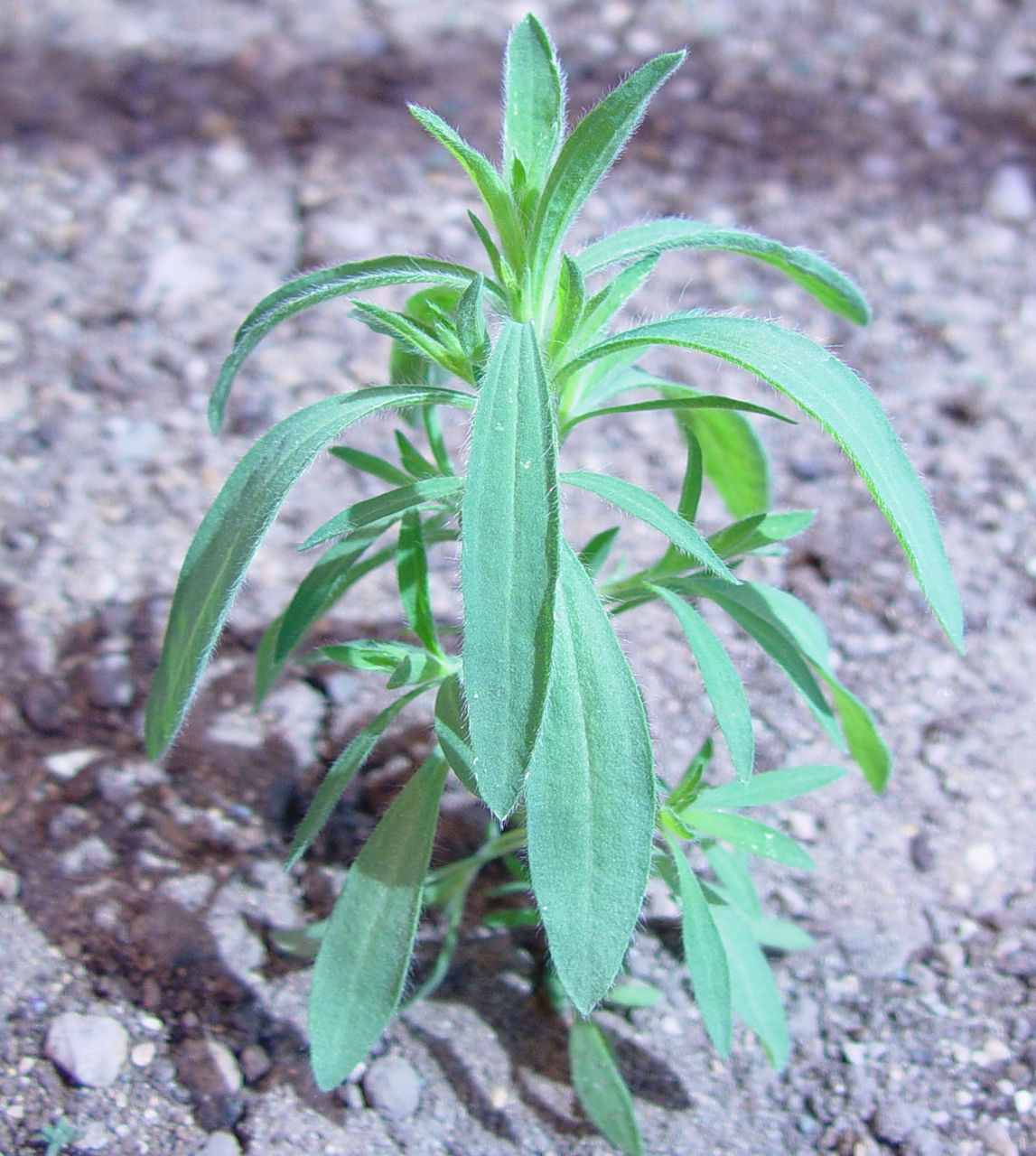
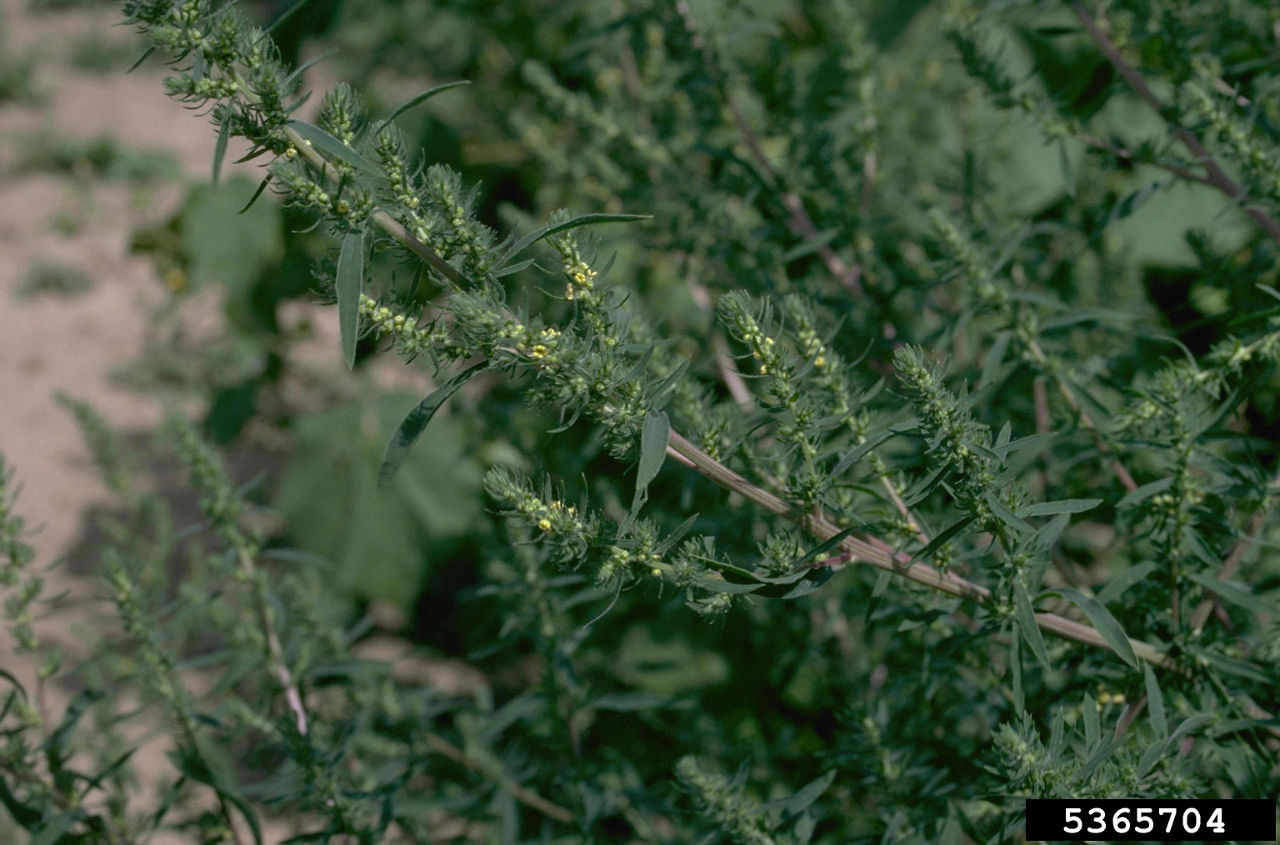
Identification: Kochia is one of the most troublesome weeds across the Great Plains and western U.S. It can be found in crop fields, pastures, rangeland, roadsides, ditch banks, and wastelands. Kochia is competitive with crops and problematic in fallow periods between crops. Understanding the biology of kochia helps in developing management strategies for the weed.1
Kochia is one of the earliest summer annual broadleaf weeds to germinate in the spring, and it will continue to germinate throughout the growing season. Kochia reproduces only by seeds, which will generally survive 1 to 2 years in the soil. Kochia seeds germinate at shallow soil depths.2 Seedlings have thick, dull-green leaves, and the undersides of kochia cotyledons on seedlings are usually bright pink or magenta in color. Young plants form a small rosette (Figure 121).3 Kochia is capable of germinating at colder soil temperatures and is quite tolerant of frost. Because kochia germinates early, it can be in advanced stages of growth when other weeds are ready to spray.
Kochia grows rapidly and can reach 6 feet in height when grown in competition with other plants. Without competition, it can grow to be a bushy plant, typically reaching heights of 3 to 4 feet. Kochia plants develop many branches with stems that are often red-tinged (Figure 122). Leaves are lance-shaped, pale green, and covered with hairs (Figure 123). Kochia flowers are inconspicuous, green, and in clusters up to 2 inches long (Figure 124). Clusters occur at the ends of stems and in leaf axils. Kochia flowers and sets seed in late summer and fall, with a single plant capable of producing up to 50,000 seeds that can be spread by wind, water, equipment, and as contaminants in hay.1 The seed is often dispersed after plants mature and become “tumbleweeds”, dropping seeds as they blow around.
Management: Kochia is tough to control because it is widely adapted, tolerates stress, emerges early with an extended germination period, has narrow leaves which are more difficult to cover with herbicide applications, and produces an abundance of seed that can spread over long distances. Kochia plants are tolerant of drought and saline soils and do well under growing conditions considered poor for most crops. Seeds germinate at shallow soil depths, making no-till a good environment for kochia survival. Kochia plants can self– or cross-pollinate, increasing the likelihood of resistant genes moving across populations.
Kochia has confirmed herbicide resistance to Group 2 (ALS inhibitor), Group 4 (synthetic auxins), Group 5 (PSII inhibitors), and Group 9 (glyphosate) herbicides. Best management practices should be adopted for the containment and management of resistant weed populations.1 This includes integration of cultural and mechanical weed management practices, and the use of diversified and effective control tactics with herbicides.
Crop rotation has been shown to be an important factor for managing kochia. A multi-state university study has shown corn and soybean plants to compete well with kochia, suppressing growth and development.5 Corn and soybeans have more herbicide options for kochia management than other annual rotational crops. Wheat and fallow were less effective than corn or soybeans, and sugarbeets were found to be ineffective in suppressing kochia growth. Diverse crop rotations can include the use of multiple management tactics and herbicides with different sites of action for more effective control of kochia.
Using both preemergence (soil-residual) and postemergence herbicides with multiple sites of action is also an important management strategy to control kochia populations. Using multiple herbicide application timings (burndown, preplant, preemergence and postemergence, and postharvest) in-crop or fallow are the most effective means to control multiple flushes of kochia during the season. Kochia plants that escape herbicide applications should be controlled using tillage or physical removal before those plants produce seed.
Sources:
1Jha, P., McVay, K., Varanasi, A., and Kumar, V. 2013. Glyphosate-resistant kochia in Montana - Herbicide recommendations and best management practices for growers. Montana State University Extension Research Bulletin No. 4602.
2Schwinghamer, T.D. and Van Acker, R.C. 2008. Emergence timing and persistence of kochia.
Weed Science 56:37-41.
3Kochia weed gallery. University of California IPM program. http://www.ipm.ucdavis.edu .
4Heap, I. The international survey of herbicide resistant weeds. http://www.weedscience.org .
5Sandell, L. 2012. Glyphosate-resistant kochia confirmed in Nebraska. UNL CropWatch. http://cropwatch.unl.edu .
Common name: Velvetleaf
Scientific name: Abutilon theophrasti
Life Cycle: Summer annual
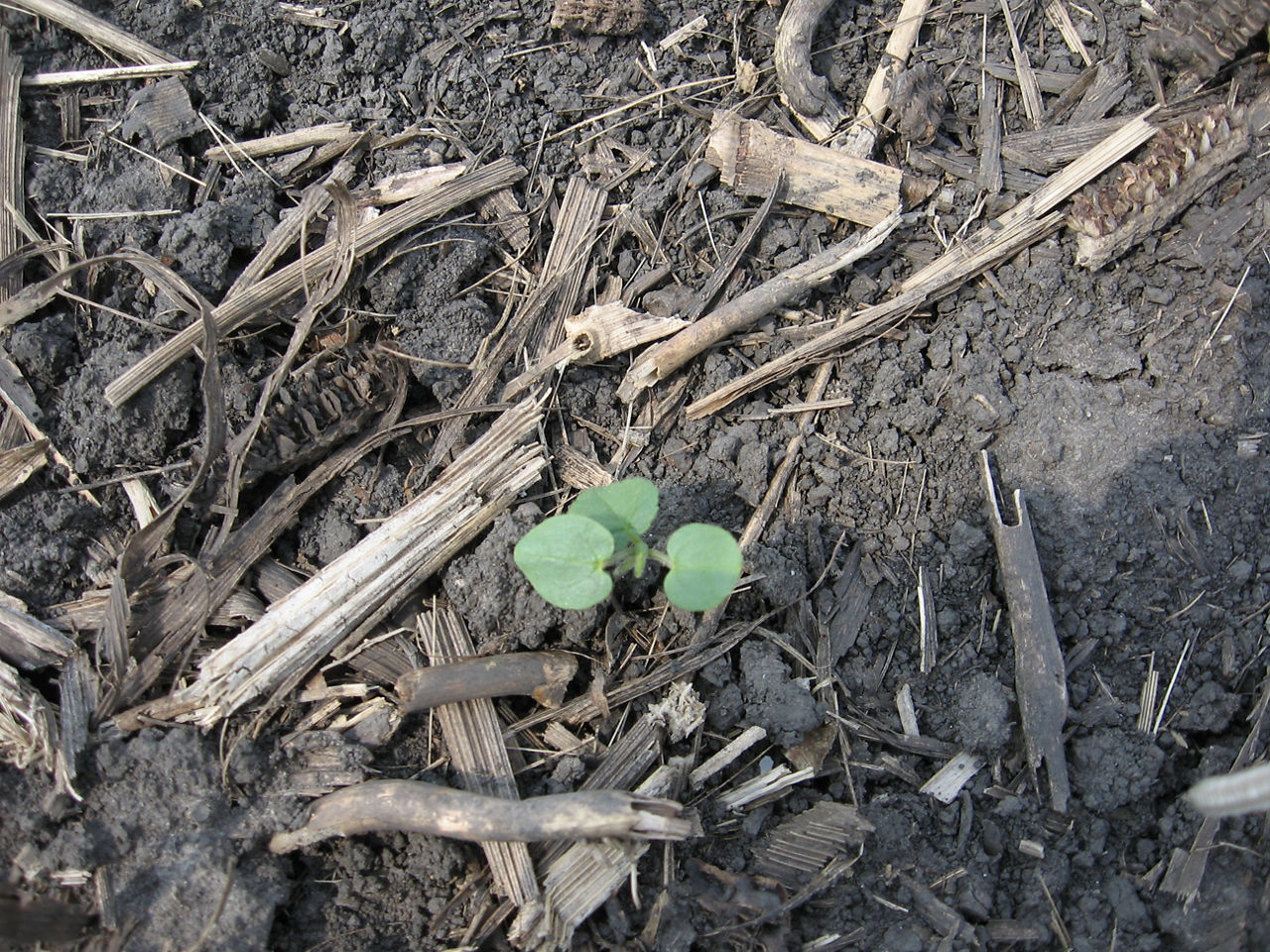
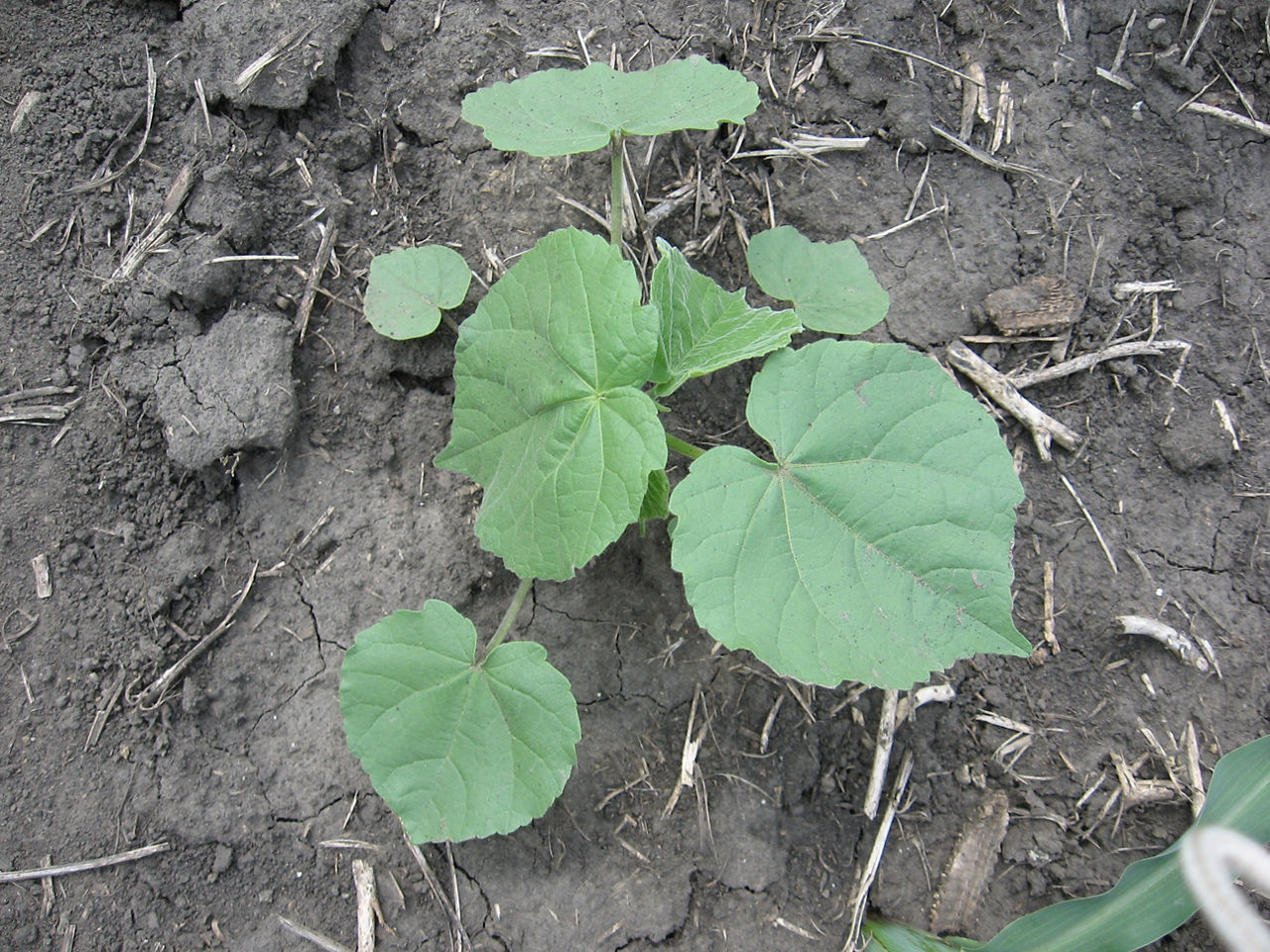
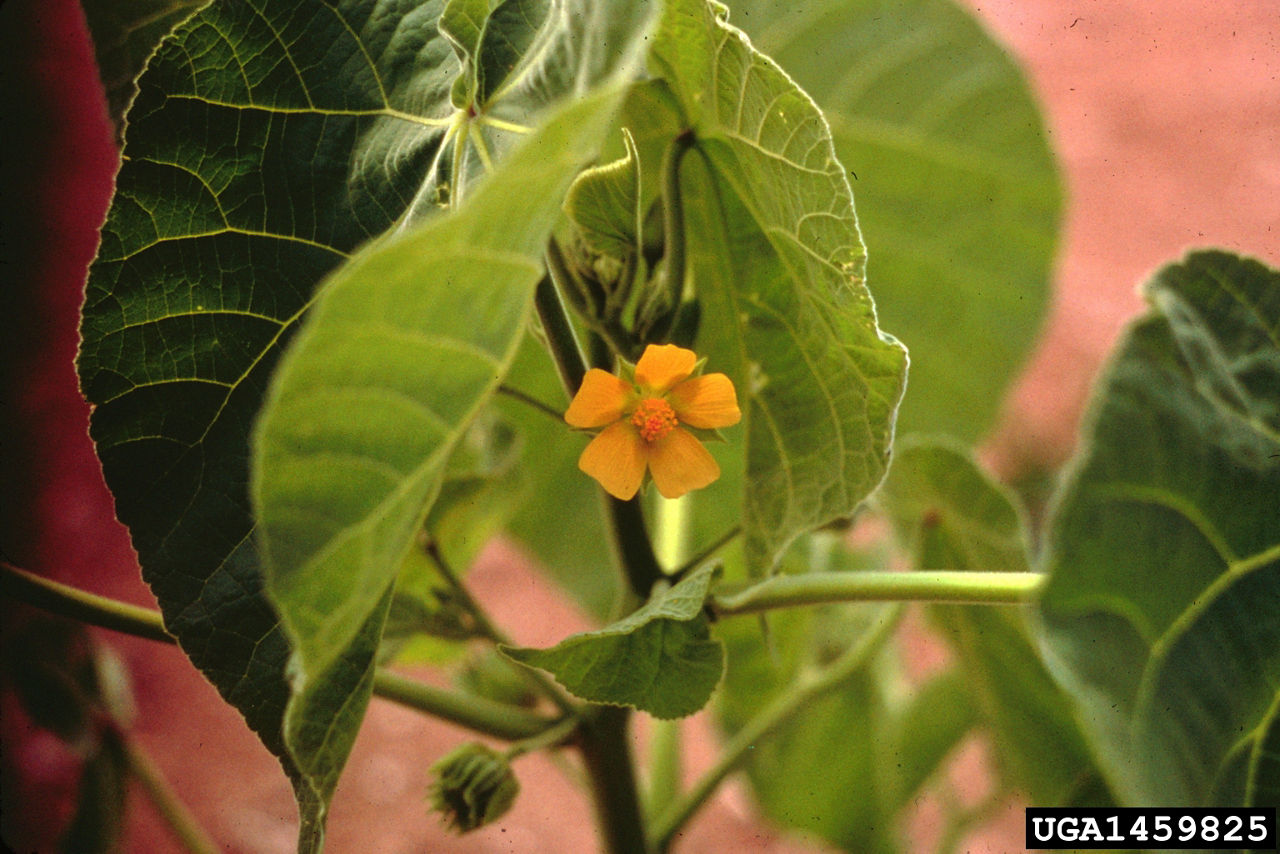
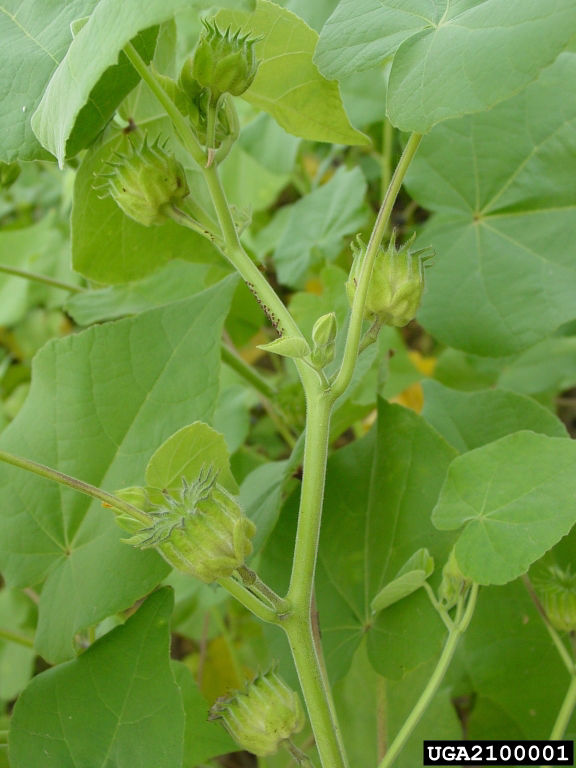

Identification: Velvetleaf is a common weed found in 48 states and considered noxious in 4 states. Velvetleaf is an erect summer annual easily identifiable by heart-shaped leaves with an abundance of short, soft hairs giving it a velvety feel. It is highly competitive in row crops with allelopathic properties. Seedlings have one heart-shaped cotyledon and one nearly-round cotyledon with short hairs on both surfaces (Figure 124). Velvetleaf seedlings can be confused with prickly sida (Sida spinosa) which begins to emerge at the same time and has two heart-shaped cotyledons and a first true leaf that is more serrated than velvetleaf. Subsequent leaves of velvetleaf plants are heart-shaped with round, toothed margins, grow 3 to 8 inches long and wide and have pointed tips arranged alternately on the stem (Figure 126). Stems are mostly unbranched and can reach up to 7 feet tall and are also covered in soft hairs. Both leaves and stems emit an unpleasant odor when crushed.
Velvetleaf flowers consist of 5 orange-yellow petals that form on short stalks in upper leaf axils (Figure 127). Fruit are bowl-shaped, green capsules that turn dark brown at maturity (Figure 128). Seeds are kidney-shaped, covered in hair, and grayish brown (Figure 129). One velvetleaf can produce up to 9,000 seeds and its hard seed coat and ability to emerge from soil depths up to 2 inches contribute to its persistence and longevity in the soil seedbank.
Management: Velvetleaf has only evolved resistance to atrazine (Group 5) found in four states. However, atrazine-resistant populations can be challenging to manage in a corn-soybean rotation. Existing stands of velvetleaf should be managed prior to planting. Preemergence herbicides are effective at controlling velvetleaf and allow the crop to gain a competitive advantage. Cultivation can also help prevent emergence. Effective soil-applied residual herbicides can be included with burndown herbicide applications. Postemergence herbicide applications following a soil-applied treatment are generally most effective for velvetleaf management. Velvetleaf size can impact the effectiveness of postemergence applications. In addition, velvetleaf can be difficult to control when herbicide applications are made between late evening and early morning. During this time, velvetleaf leaves droop to a nearly vertical position making it difficult to get adequate spray coverage. Environmental stresses can also cause leaves to angle downward.
Sources:
Bush, M.D. May 28, 2015. Weed of the month: velvetleaf. Integrated Pest Management. University of Missouri. http://ipm.missouri.edu.
Common name: Ladysthumb
Scientific name: Polygonum persicaria
Life Cycle: Summer annual
Common name: Pennsylvania smartweed
Scientific name: Polygonum pensylvanicum
Life Cycle: Summer annual
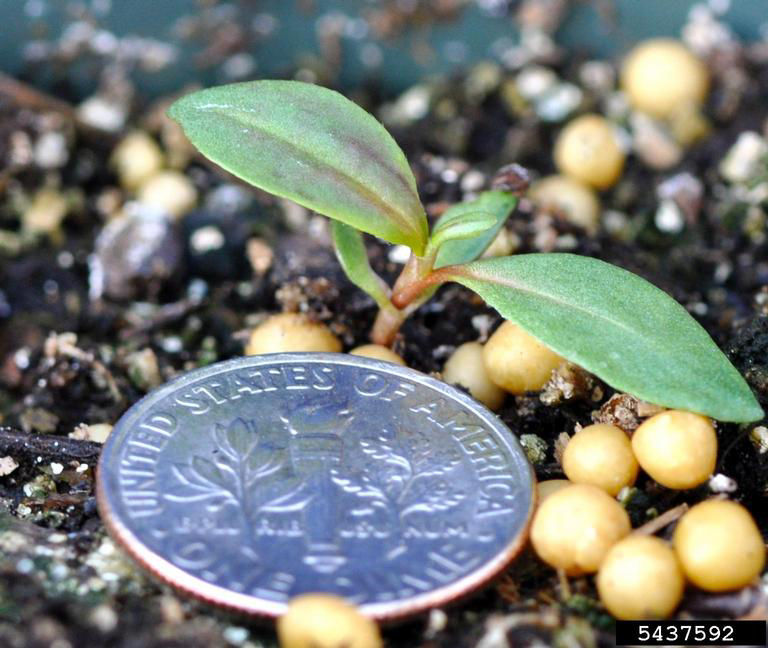
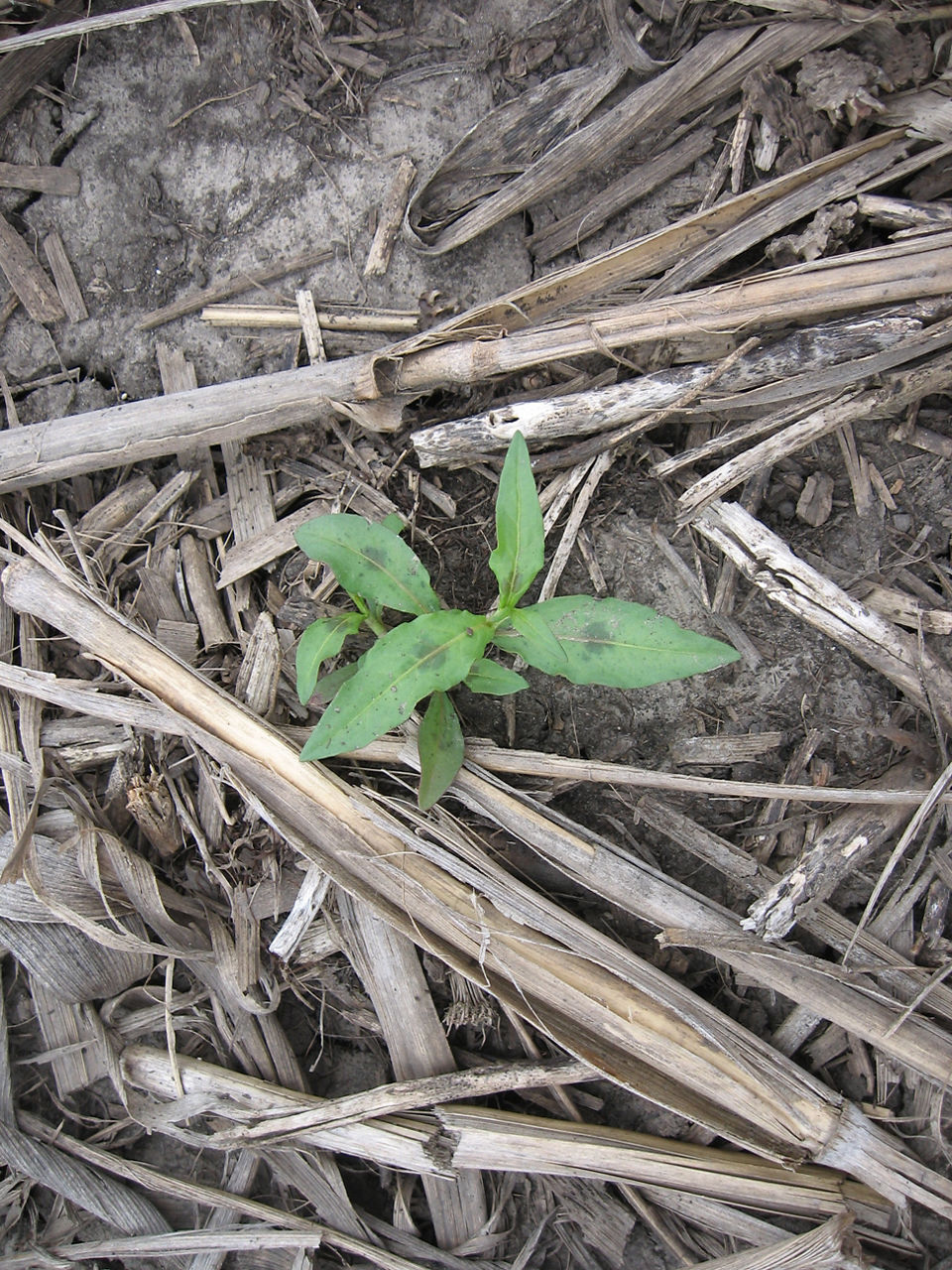
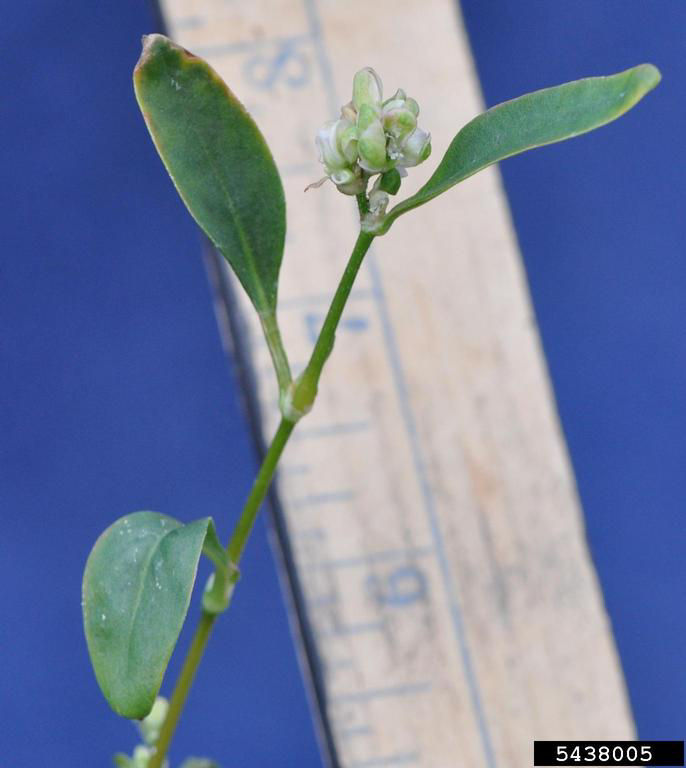
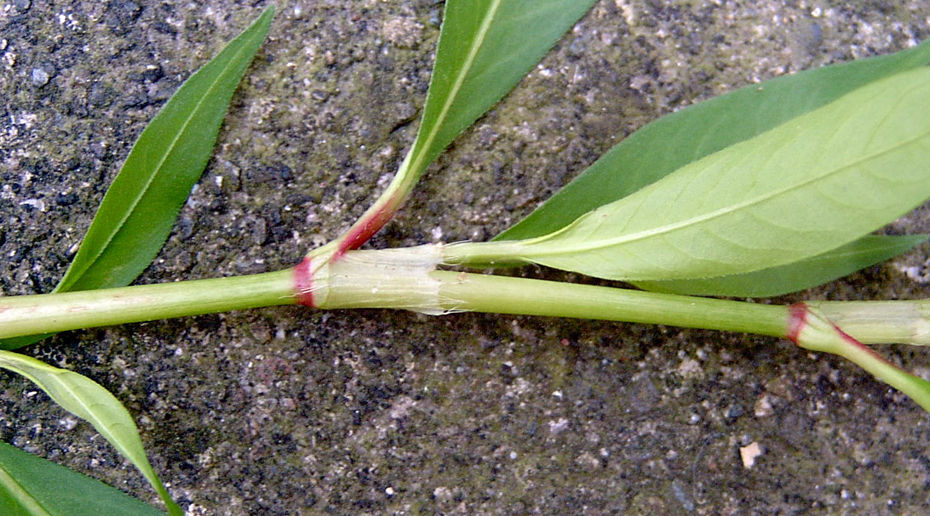
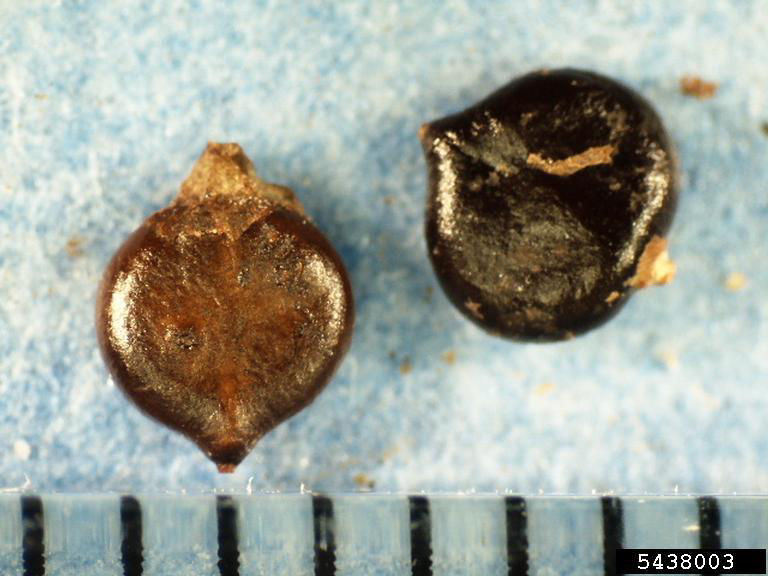
Identification: Pennsylvania smartweed and ladysthumb are early-emerging annuals. These two species are very similar in appearance and growth habit. Both species can be problematic in agronomic cropping systems since they tolerate a range of soil types and conditions. However, they do not tolerate drought conditions. Cotyledons are narrow, oval to lance-shaped, with rounded tips (Figure 130). Leaves are usually hairless, alternate, and lance-shaped with pointed tips and smooth margins. The center of both leaf surfaces can be marked with a purple blotch resembling a thumbprint (Figure 131). Many feel this purple blotch helps distinguish ladysthumb; however, the blotch can be seen on either species.
Stems of Pennsylvania smartweed and ladysthumb are branched and can be green or reddish and, as with all species in the Polygonaceae family, are swollen and jointed at the nodes. A smooth, membranous sheath (ocrea) surrounds the stem at the base of each petiole (Figure 132). The distinguishing feature between Pennsylvania smartweed and ladysthumb is the pubescence on top of the ocrea (Figure 133). Ladysthumb has a fringe of hairs at the top of the ocrea, whereas Pennsylvania smartweed does not.
Small, pink or white flowers are clustered in terminal spikes at the end of stems (Figure 132). The seed is enclosed in a single-seeded, flat, glossy, black, round fruit with a pointed tip (Figure 134).
Management: Smartweeds are somewhat competitive but low-growing weeds. Soybean yield was reduced 13% by 8 smartweed plants in 30 feet2 of field (about 1 plant per 4 feet of row).1 Tillage in the spring triggers smartweed to germinate. Tilling early and planting later will help reduce smartweed infestations because many will have emerged and been controlled by tillage. Tilling at night (dark tillage) helps reduce smartweed emergence by 30 to 50%.1 Dicamba-containing products are effective herbicides, especially in a burndown situation. Other herbicides are also effective for smartweed control in field crops.
Sources:
Smartweeds (Pennsylvania smartweed and ladysthumb). Weeds. Department of Plant, Soil, and Microbial Sciences. Michigan State University. http://canr.msu.edu
Common name: Wild buckwheat
Scientific name: Polygonum convolvulus
Life Cycle: Summer annual
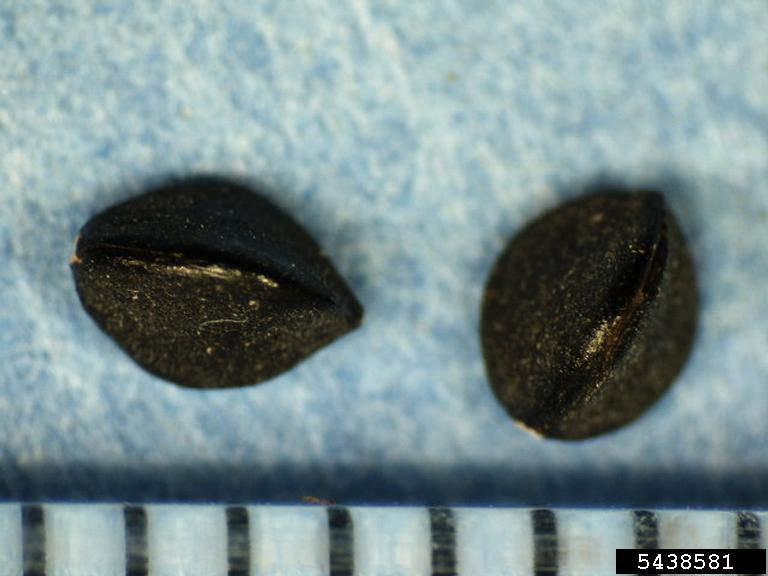

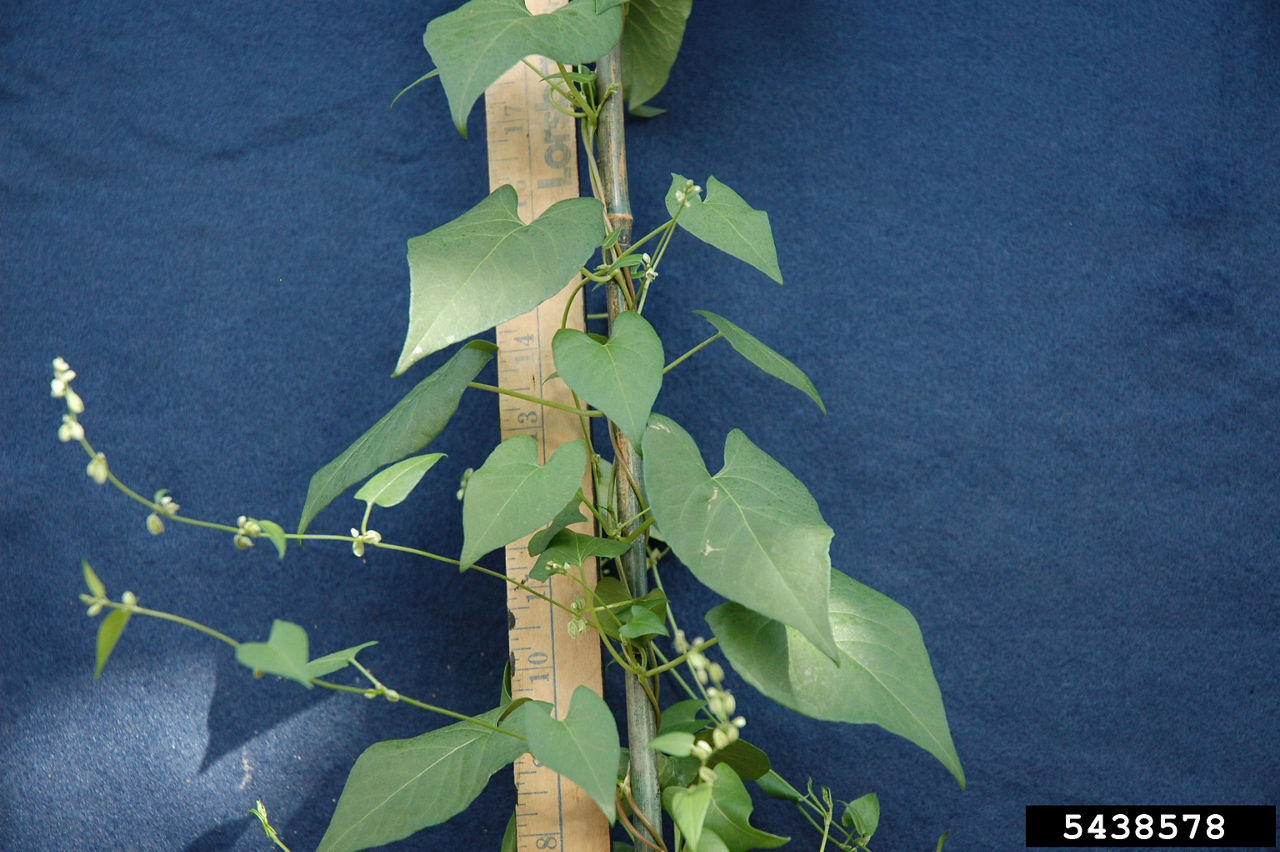
Identification: Wild buckwheat is a summer annual that grows from a hard, black, triangular seed about 1/8-inch long (Figure 135). The cotyledons are narrow with a rounded tip and base (Figure 136). The plant has long, slender, creeping stems that trail along the ground or climb any plants or objects they contact. The leaves are alternate, heart- or arrowhead-shaped, pointed at the tip, and have widely-separated lobes at the base (Figure 137). Plants bloom throughout the summer and the flowers are small and have no petals but have 5 greenish or pinkish sepals. Flowers are in short-stemmed clusters in the axils of the leaves or at the end of stems. Wild buckwheat is a member of the smartweed family. Like other smartweeds, wild buckwheat possesses an ocrea around the stem at each node. It can be confused with field bindweed because of its vining growth habit and arrowhead-shaped leaves. Field bindweed, however, is a perennial, has an extensive underground root system, does not possess an ocrea, and has large, funnel-shaped flowers that are white or pink. Also, wild buckwheat’s lower leaves are usually much wider than bindweed leaves.
Wild buckwheat begins germinating very early in the spring during the first prolonged warm period, beginning as early as March in Kansas and April in North Dakota. Most of wild buckwheat seed emergence occurs by mid-June. Wild buckwheat’s climbing habit allows the plant to obtain sunlight while growing in stands of grain or other tall crops. It also can spread horizontally and quickly cover bare ground, enabling it to maximize light-gathering efficiency.
Watchouts and Disease Host: In addition to competing for nutrients, light, and moisture, wild buckwheat causes difficulty in harvesting crops. Furthermore, wild buckwheat is a host for several crop plant diseases, including virus yellows of beets and cucumber, alfalfa mosaic virus, and tobacco rattle virus.
Management: Cultural practices, such as crop rotation, mowing, delayed seeding, post-seeding harrowing, or postharvest cultivating, can help reduce wild buckwheat stands, but have not been effective in control. Delayed crop seeding can help manage wild buckwheat by killing early-germinating seedlings through seedbed preparation or burndown herbicide applications.
Wild buckwheat and related smartweed species have some natural tolerance to glyphosate. Wild buckwheat control from glyphosate is reduced when applications are made at lower than labeled rates, when only one glyphosate application is made, when plants are stressed from adverse environmental conditions, or when runners are more than 3 to 4 inches long. The most effective herbicides on wild buckwheat are atrazine, bromoxynil, clopyralid, dicamba, glufosinate, and some sulfonylurea products. Using these herbicides or mixtures with these ingredients will ensure the most effective wild buckwheat control. Atrazine, clopyralid, dicamba, and some sulfonylurea herbicides may persist in the soil and carry over for more than one growing season, especially in soils with high pH.
Wild buckwheat has become a major weed problem in no-till fields prior to spring planting. All existing weeds (including wild buckwheat) should be controlled prior to planting or emergence of no-till crops with a preplant burndown herbicide treatment. Glyphosate or glyphosate plus 2,4-D is often inadequate for wild buckwheat control. Adding or using another herbicide may be necessary to achieve adequate wild buckwheat control, but proper waiting intervals between applications must be observed. Crops planted before early or mid-May could require an in-crop herbicide application to control late-emerging plants. This strategy will allow earlier postemergence applications to smaller plants.
Sources:
Wild buckwheat. UC IPM. University of California Agriculture and Natural Resources. http://ipm.ucanr.edu
Zollinger, R., Peterson, D., and Moechning, M. 2006. Biology and management of wild buckwheat. GWC-10. Purdue Extension. http://extension.purdue.edu
Perennials
Common name: Canada thistle
Scientific name: Cirsium arvense
Life Cycle: Perennial
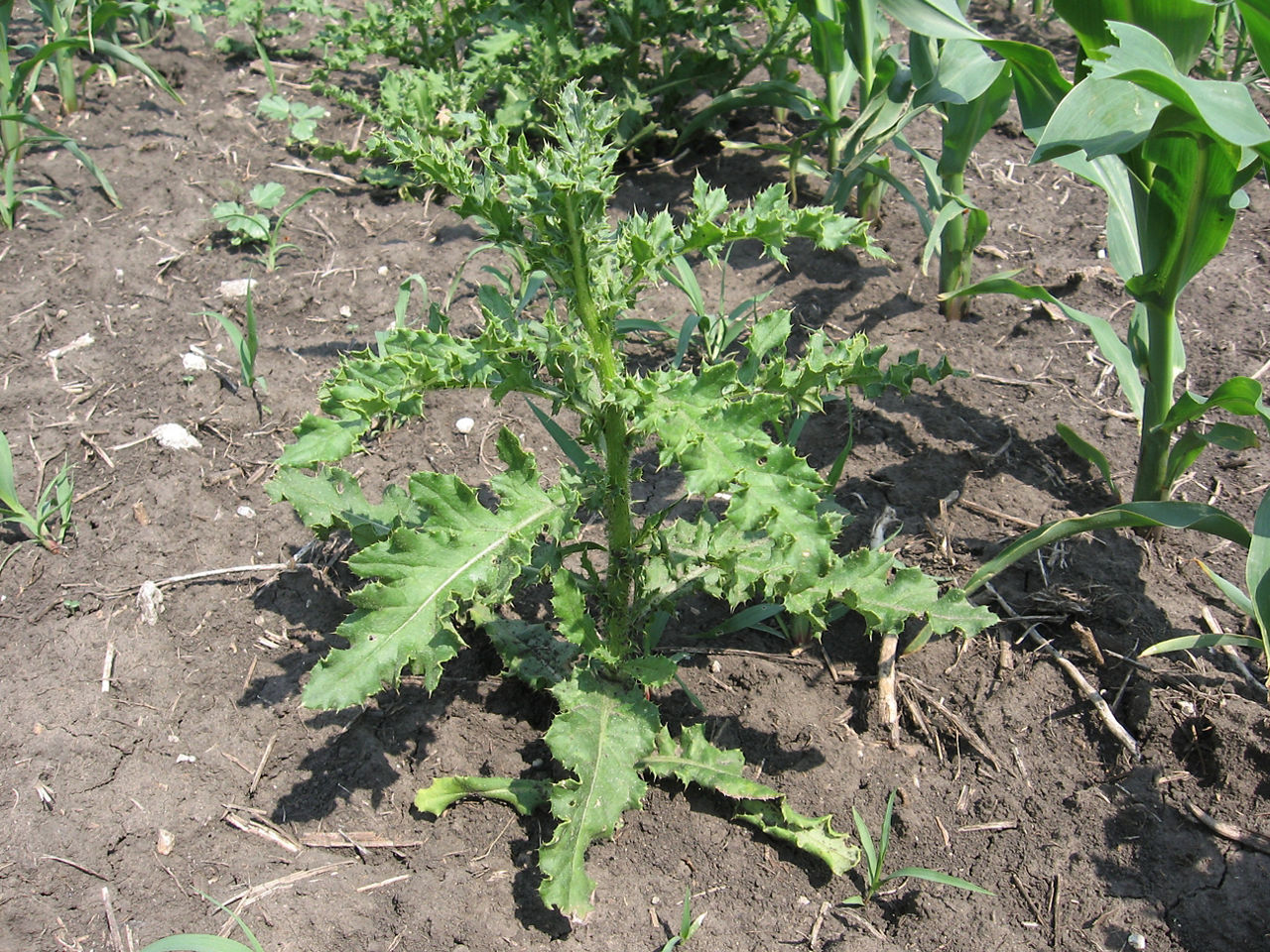
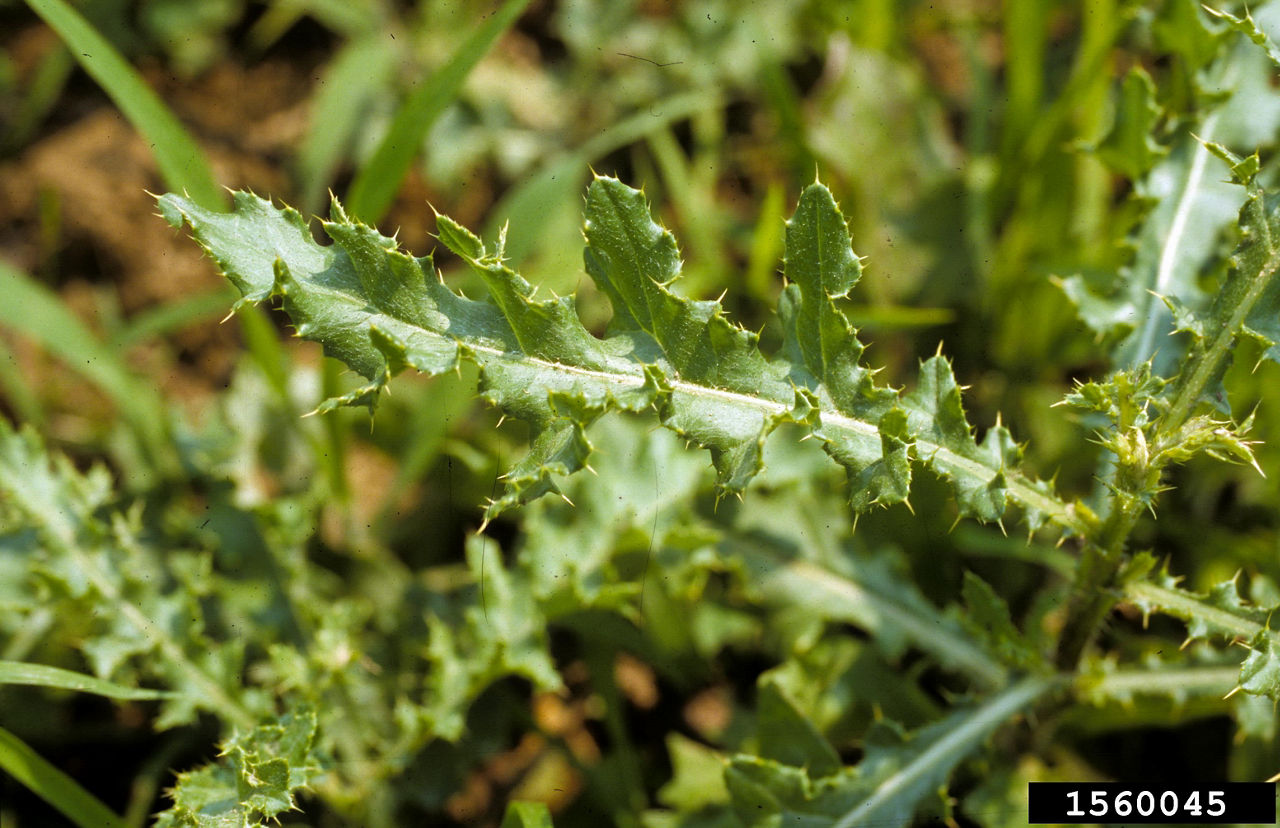
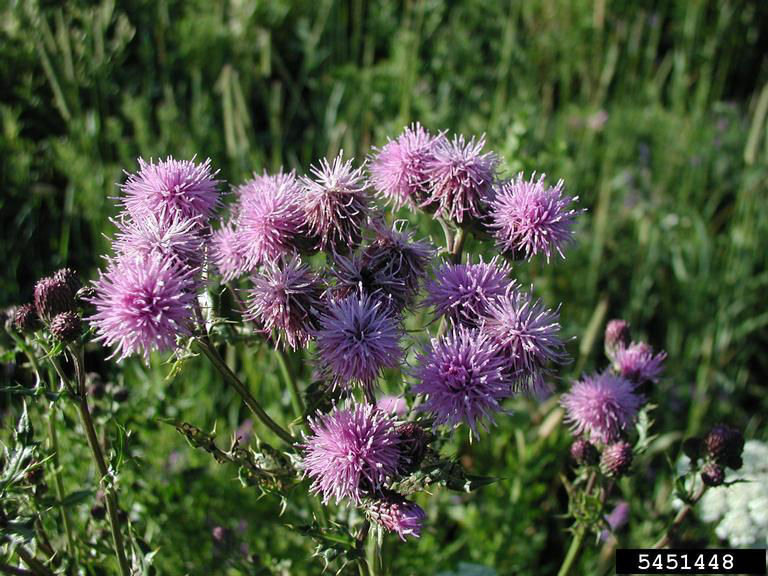

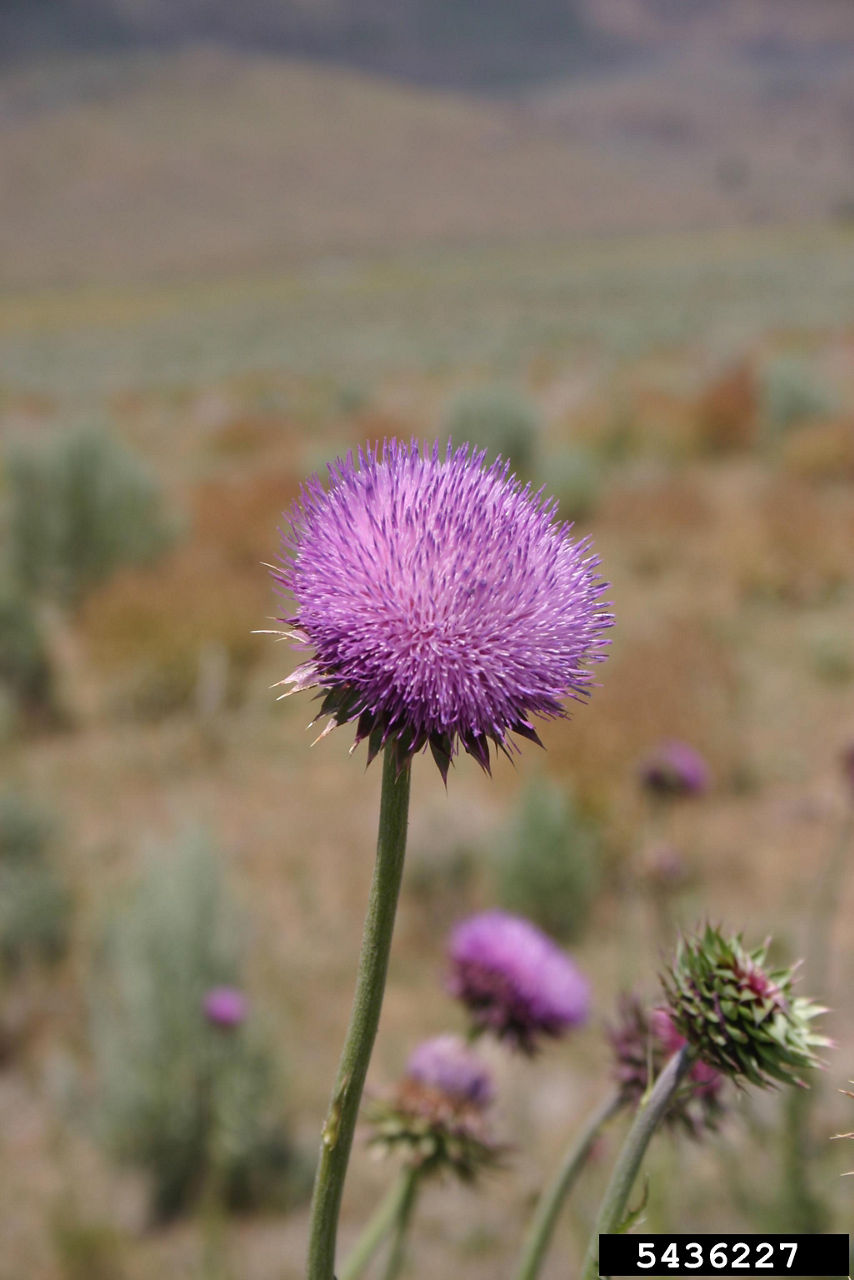
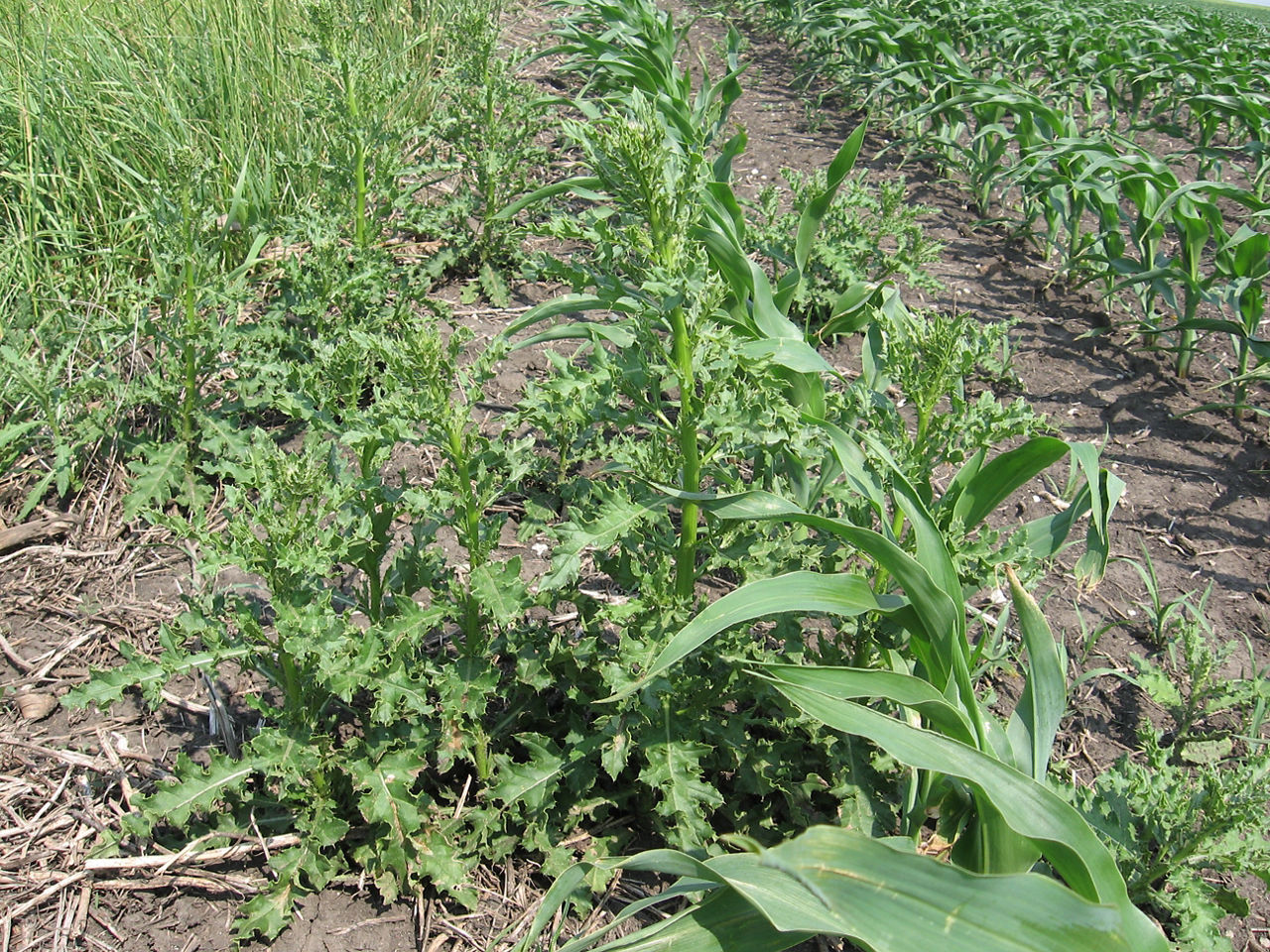
Identification: Canada thistle is an aggressive perennial that reproduces vegetatively from creeping roots and from seed. Canada thistle is considered a noxious weed species in many states. Creeping roots provide stored food and numerous underground buds to depths well below the plow layer. Canada thistle plants can grow 2 to 5 feet tall and branch only at the top (Figure 138). Leaves are alternate, sessile, simple, and oblong with irregular lobes and spiny margins (Figure 139). Stems are grooved, hollow, and branch at the top and become hairy with age. Male and female flowers occur on separate plants (dioecious) and seed production requires the presence of both plants. Flower heads are about ¾ inch wide and consist of purple or pink disk flowers surrounded by spineless bracts (Figure 140). Fruit are flat, brown, 1/6-inch long achenes with tufts of hair.
Similar Species: Plants most likely to be confused with Canada thistle are other thistles. Canada thistle can be differentiated from bull thistle (Cirsium vulgare) (Figure 141) and musk thistle (Carduus nutans) (Figure 142) by its spineless stems and flowers without spines or prickles, both of which are present on these other two thistle species. Additionally, Canada thistle plants grow in distinct patches due to the rhizome root growth (Figure 143).
Management: Canada thistle is difficult to manage, and control is best achieved through an integrated program. Creeping roots can be moved from field to field on tillage equipment and tillage can increase the problem by spreading vegetative roots of Canada thistle. Including forages or small grains in the rotation can help manage Canada thistle. Canada thistle is susceptible to shading. Conditions that favor rapid crop canopy closure (good stand establishment, fertility, narrow row spacings) maximize control from the competing crop and compliment other control practices.
There are several herbicides labeled for control of Canada thistle in corn and soybean. Canada thistle is most susceptible to systemic herbicides between the bud and flower stages. However, most herbicides have a maximum crop height or stage restriction for application; refer to the herbicide label for these restrictions.
Biological Control Agents: Various insects as well as fungal and bacterial pathogens can attack Canada thistle. Three insects, Canada thistle stem weevil, thistle bud weevil, and thistle stem gall fly, are available commercially. Typically, biological controls alone will not control Canada thistle and need to be combined with other methods to be successful.
Sources:
Beck, K.G. 2013. Canada thistle. Fact Sheet 3.108. Colorado State University Extension. http://extension.colostate.edu
Ross, M. Control practices for Canada thistle. Department of Botany and Plant Pathology. Purdue University. http://btny.purdue.edu.
Common name: Curly dock
Scientific name: Rumex crispus
Life Cycle: Perennial
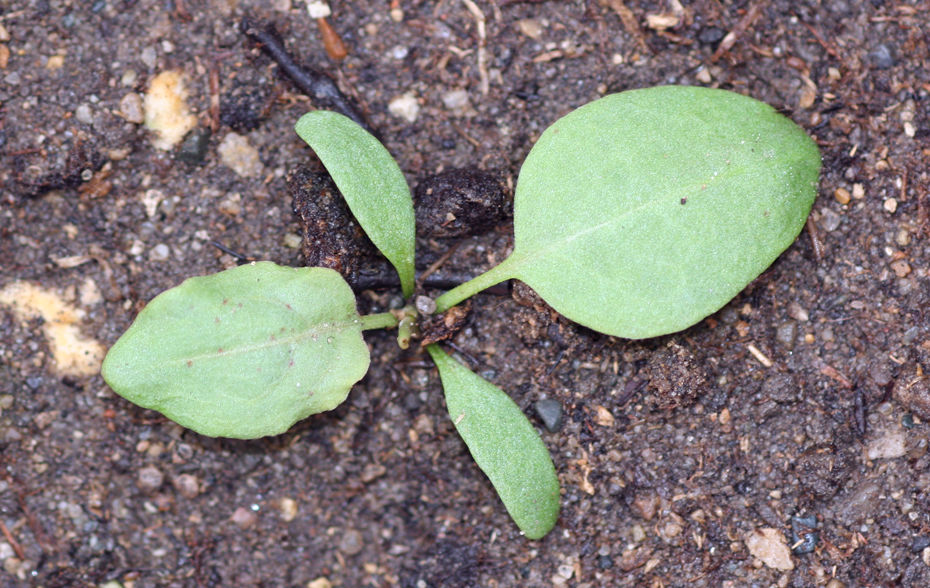

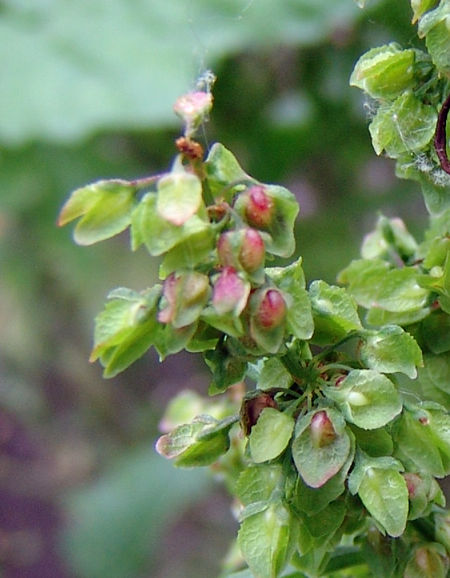
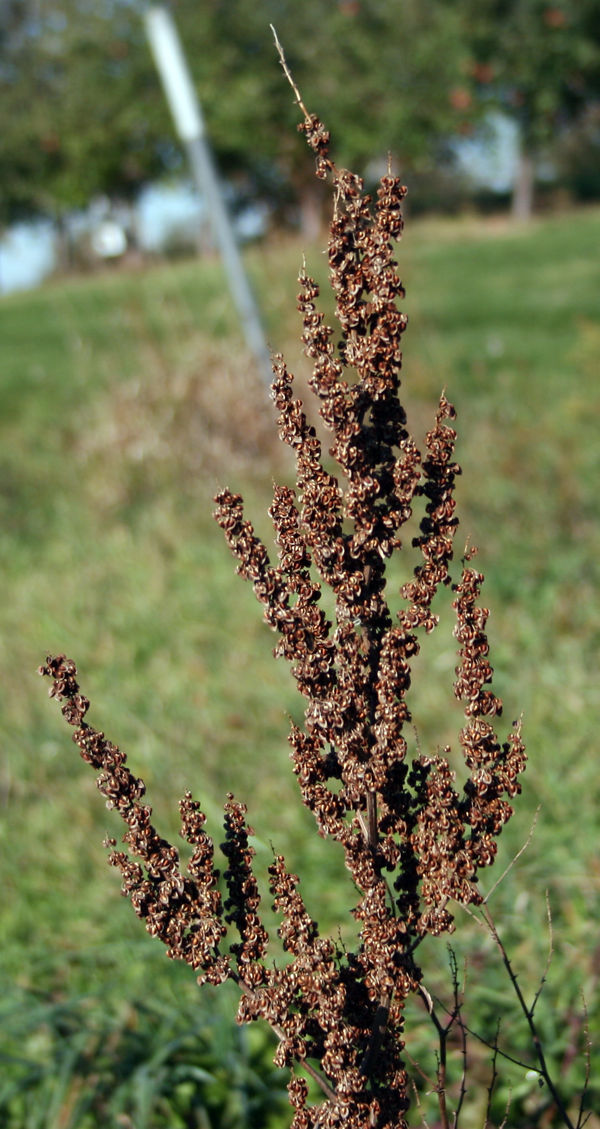
Identification: Curly dock is an erect, top-rooted, simple perennial weed that can thrive in a variety of habitats including agronomic fields and pastures. Curly dock cotyledons are round at the apex and narrow at the base (Figure 144). Young leaves are spatula-shaped and may have red patches. Mature leaves are alternate, long, and narrow with round to pointed tips and wavy margins resembling bacon strips (Figure 145). Leaves have prominent midveins and an ocrea surrounds the stem. The plant forms a basal rosette that bolts prior to flowering, reaching 3 to 4 feet in height. Stems are unbranched, thick, ridged, hairless, and often turn red. Flowers are small, usually greenish, in narrow panicles on the upper stems and become reddish-brown at maturity (Figures 146 and 147). Seeds are three-sided, rust-colored, and shiny. Each plant can produce hundreds to thousands of seeds that can move easily in wind and water. Curly dock can also reproduce vegetatively from sprouts that regenerate from buds on the taproot.
Management: Curly dock seeds can remain dormant in the soil for decades and germinate at various times throughout the year. Curly dock can become problematic in no-till corn and soybean systems but is rarely an issue in tilled soils. It is difficult to achieve complete control of rootstocks with any treatment, but there are a number of herbicide combinations that manage the weed for subsequent corn and soybean crops. Higher rates of glyphosate in combination with dicamba or 2,4-D can provide acceptable control prior to planting. Uprooting, chopping, and burying the taproots through tillage will control curly dock. Spring herbicide applications are effective in controlling curly dock. Once established, fall herbicide applications are more effective. Sequential herbicide applications may be necessary for control.
Common name: Dandelion
Scientific name: Taraxacum officinale
Life Cycle: Perennial
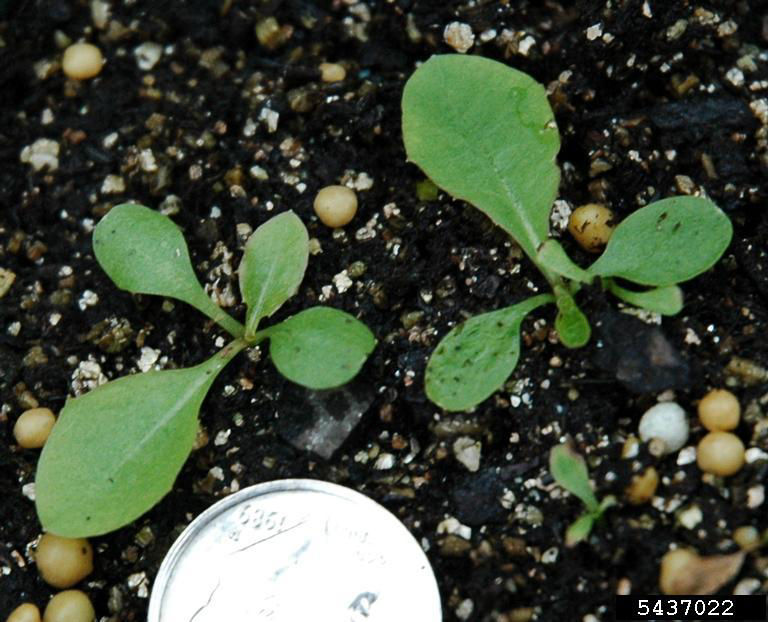
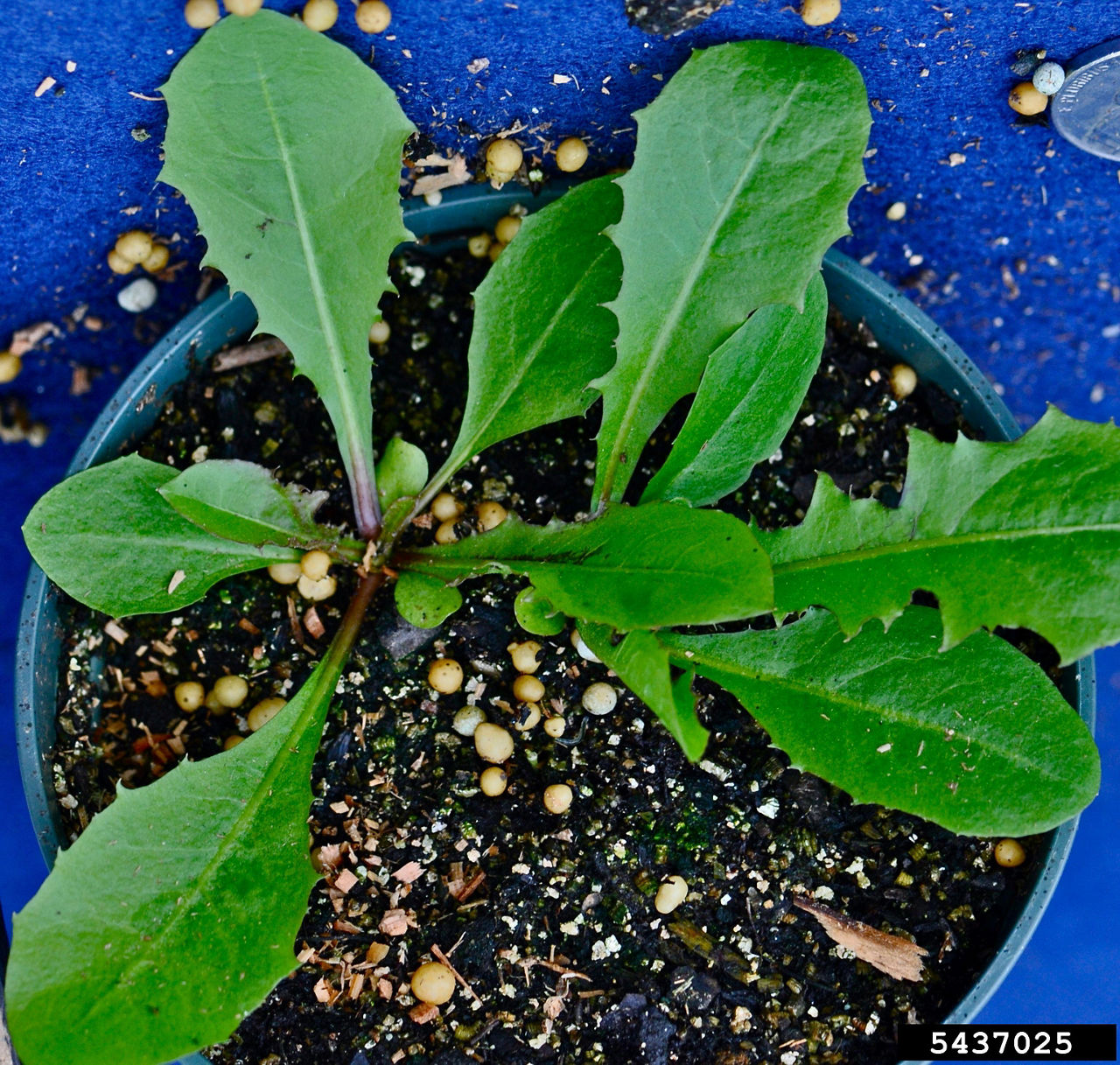
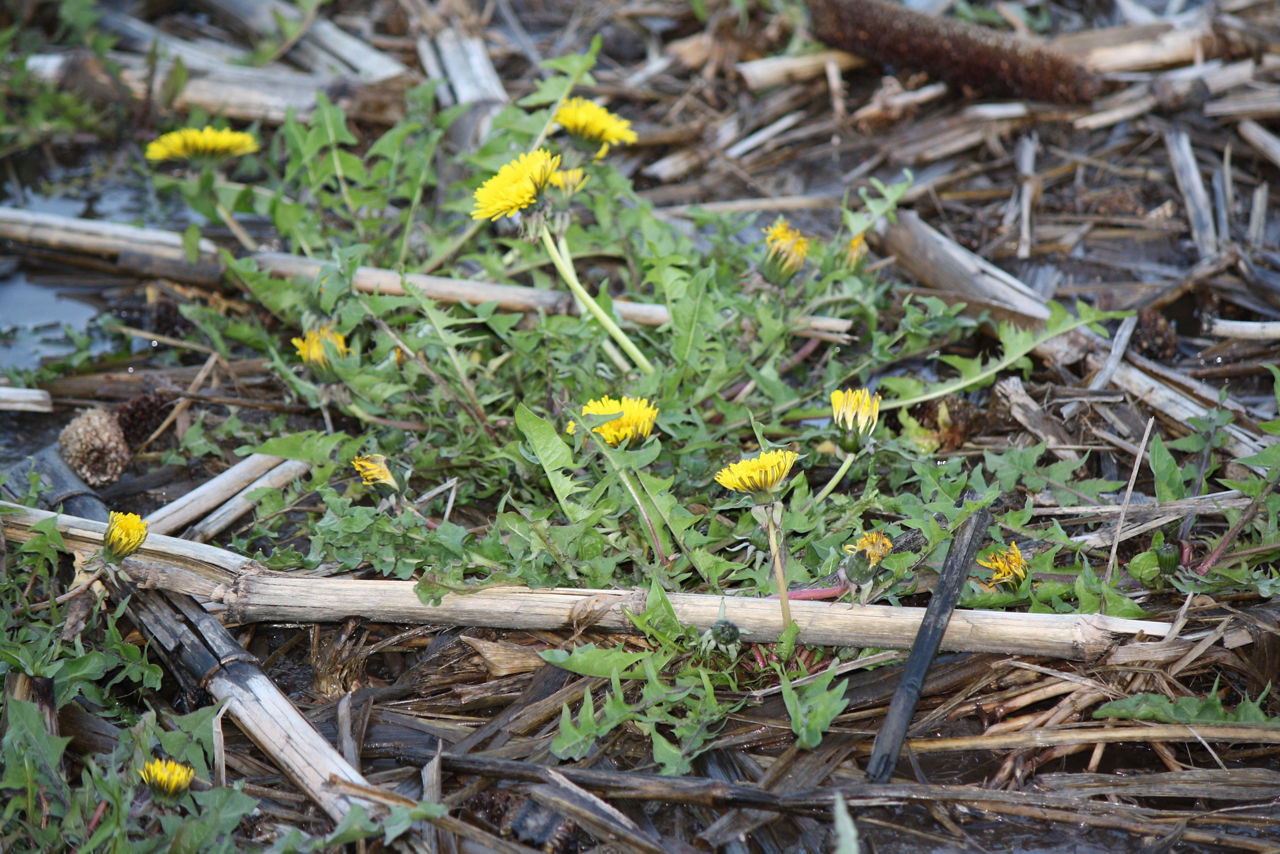

Identification: Dandelion is a simple perennial that forms a basal rosette with yellow flowers and a puff-ball seed head. Dandelion is one of the most common and problematic weeds of turfgrass and lawns and can also be problematic in no-till crop production. Plants emerge from seed and the root becomes a perennial taproot system that persists over the winter. Dandelion captures space in forage crops and in no-till systems. It is not competitive for light but captures soil moisture and nutrients.
Cotyledons are light-green, smooth, and oval to spatulate in shape (Figure 148). Young leaves form a basal rosette and are also oval to spatulate in shape, 2 to 6 inches in length (Figure 149). Leaf margins are noticeably wavy, especially on older leaves. All leaves are basal, ranging from 2 to 16 inches in length depending on the environment. Usually, leaves are more in the range of 2 to 8 inches in length. Leaves are oblong in outline, sometimes sparsely hairy, deeply indented, with lobes that point toward the center of the rosette. Stems are erect, hollow, and approximately 2 to 6 inches in height giving rise to solitary, bright-yellow flowers (Figure 150). Fruit are an achene that is brown, 3 to 5 mm long, with a feathery pappus attached that aids in wind dispersal of seed (Figure 151). Collectively, the achenes form a white seed head that resembles a puff-ball.
Management: Regular soil disturbance is effective at preventing the establishment of dandelion plants. This is why dandelions are seldom a problem in tilled cropping systems. Tillage must be deep enough to cut the root 4 inches below the crown and the soil surface. Both rotary hoeing and cultivation control seedling dandelions but have little effect on those that are established.
Herbicide options are available to suppress dandelion in corn, soybean, and alfalfa. Spring applications of some herbicides control seedling dandelion. For perennial weeds, fall applications of herbicides are usually more effective than spring applications. Dandelion is one of the more difficult weeds to control. Differences in response of dandelion populations to 2,4-D ester and glyphosate have been observed. Where corn or soybeans have emerged and dandelion are established, the strategy should be to suppress the plants to minimize yield loss from dandelion competition. In-season applications will substantially reduce dandelion competition but will likely not greatly reduce dandelion populations. Then a fall application can be planned following harvest with the goal of actually removing the plants.
Sources:
Kells, J., Hillger, D., and Sprague, C. May 4, 2006. Dandelion management in field and forage crops. Department of Crop and Soil Sciences. Michigan State University. http://canr.msu.edu
Common name: Field bindweed
Scientific name: Convolvulus arvensis
Life Cycle: Perennial
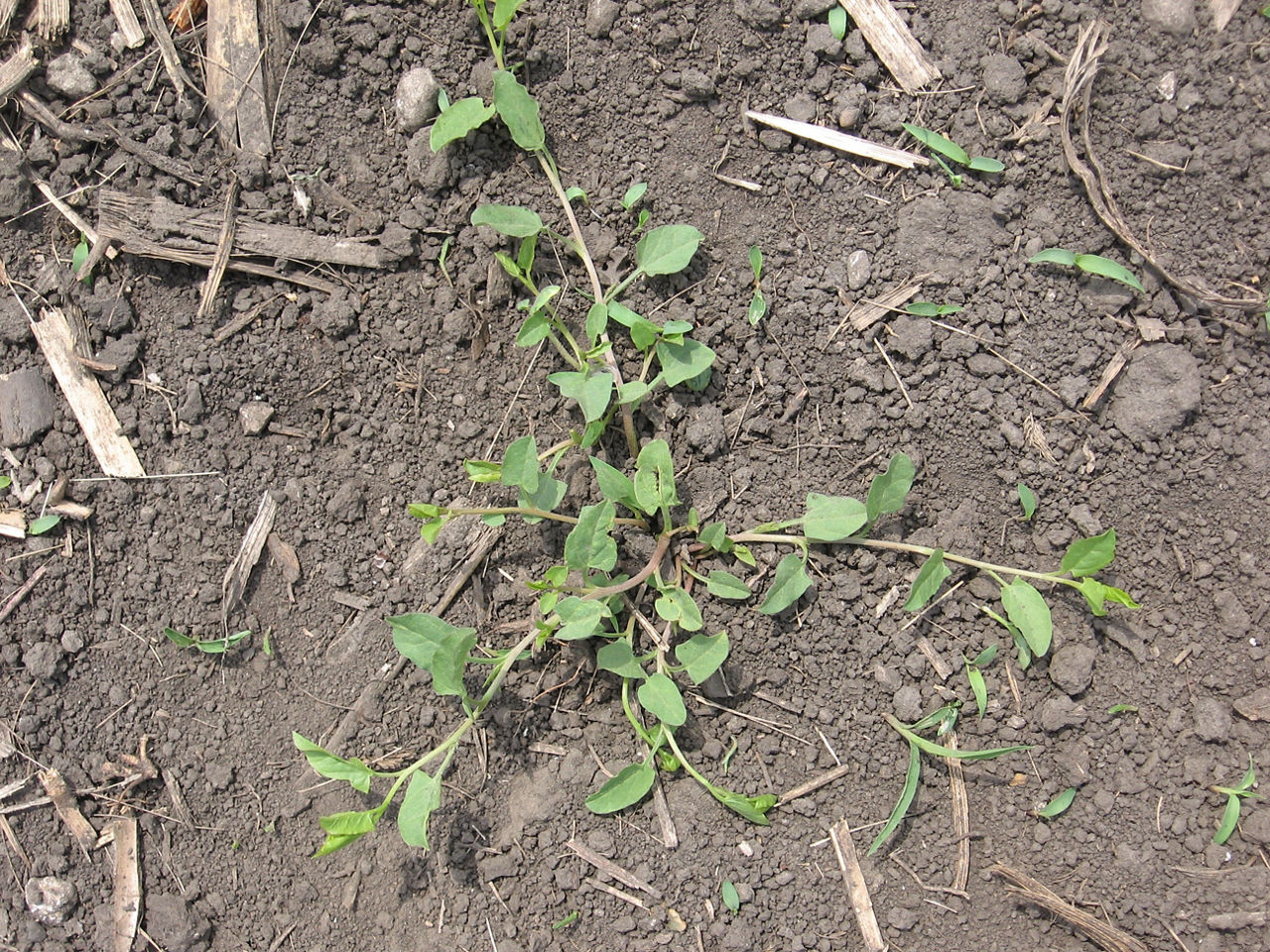
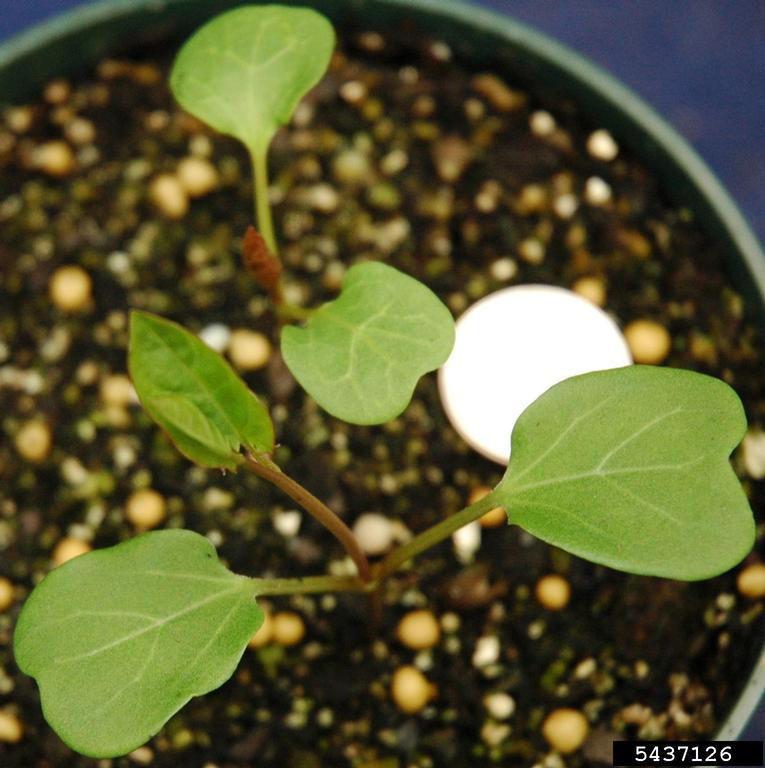
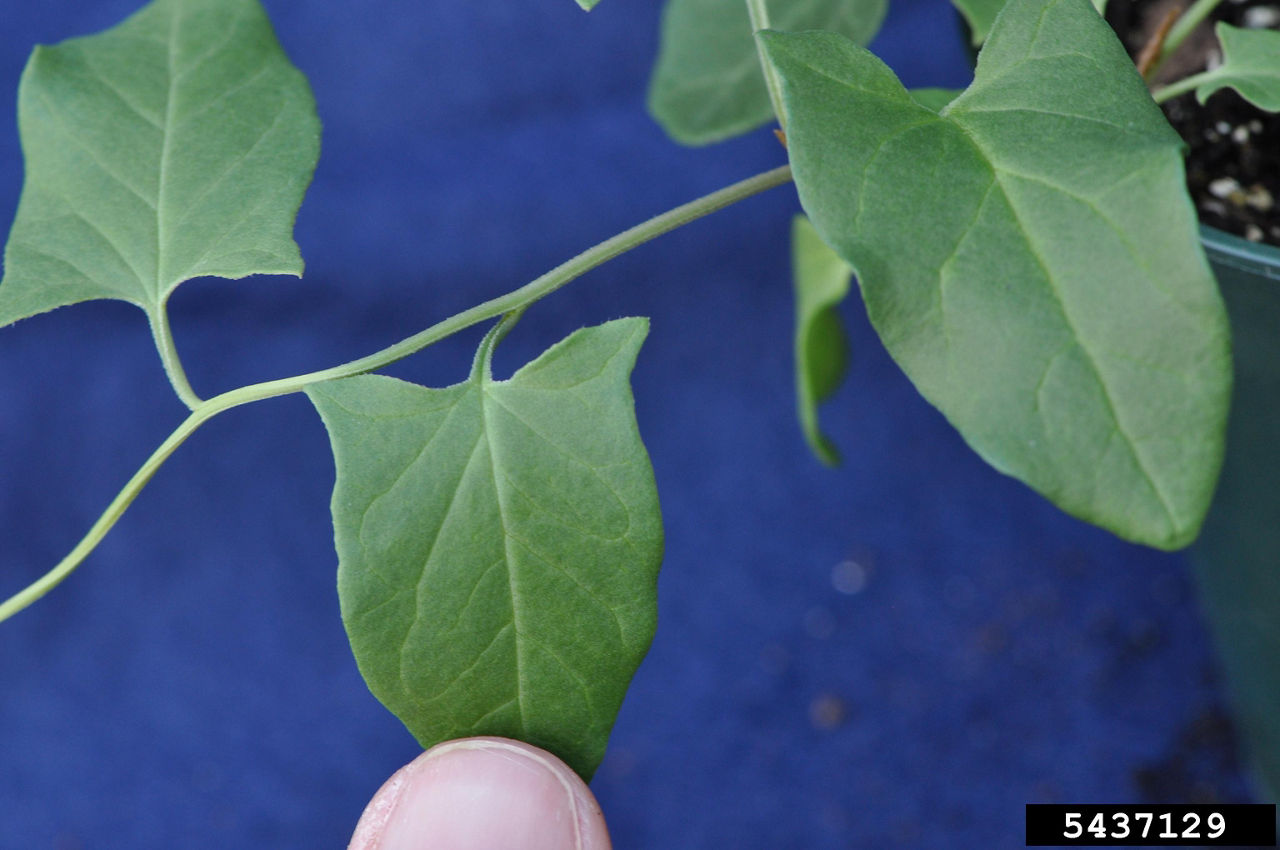
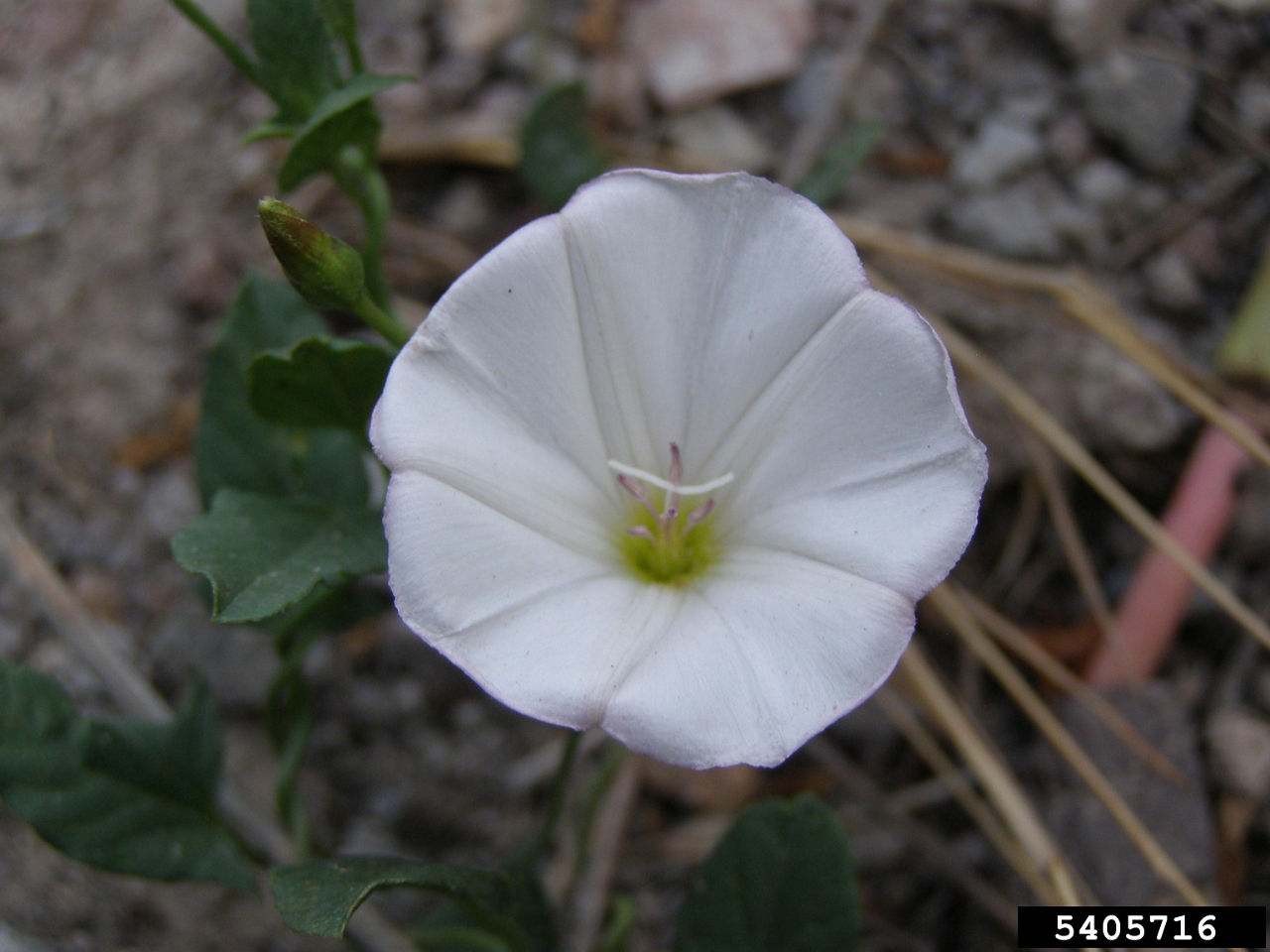
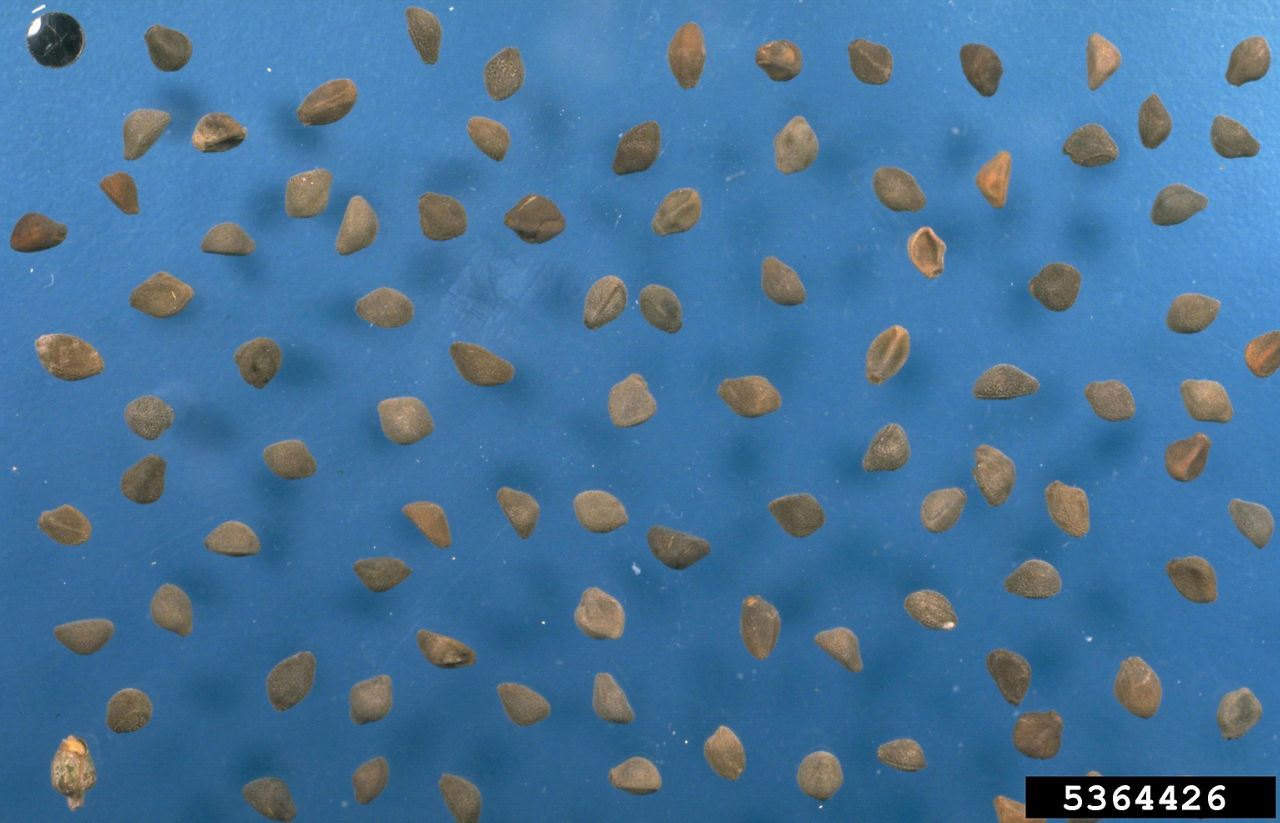
Identification: Field bindweed is a creeping, deep-rooted perennial that is considered noxious in many states. It spreads from extensive rootstock and seed. Field bindweed vines grow out in a spiral pattern, allowing them to twist around whatever may be growing near them, up to 6 feet high (Figure 152). The cotyledons on seedling plants are square, usually with a slight indentation on the apex (Figure 153). The first true leaves are arrowhead-shaped, lobed at the base, and have petioles. No cotyledons are present on young plants emerging from established rhizomes. Mature plants also have alternate, arrowhead-shaped leaves up to 2 inches long depending on environmental conditions (Figure 154). Under warm, moist conditions, leaves are larger, and vines are more robust than under drought conditions. Stems are smooth to slightly hairy and trail along the ground or climb vegetation and other objects. Flowers have white to pink petals fused into a funnel shape with two leafy, small bracts one inch below the flower base (Figure 155). Fruit are oval to round capsules containing dull-gray to brown or black seeds with one rounded side and two flattened sides (Figure 156). An average plant produces about 250 seeds. The root system has both deep, vertical and shallow, lateral roots. The vertical roots can reach for 20 feet or more. Most of the root structure, however, is in the top 2 feet of the soil.
Similar species: Hedge bindweed (Calystegia sepium) is often confused with field bindweed but differs by having larger, triangle-shaped leaves with square lobes extending behind and perpendicular to the petiole (Figures 157 and 158.). Flowers of hedge bindweed are larger, and this weed also has large bracts beneath the flowers, unlike field bindweed (Figure 159).
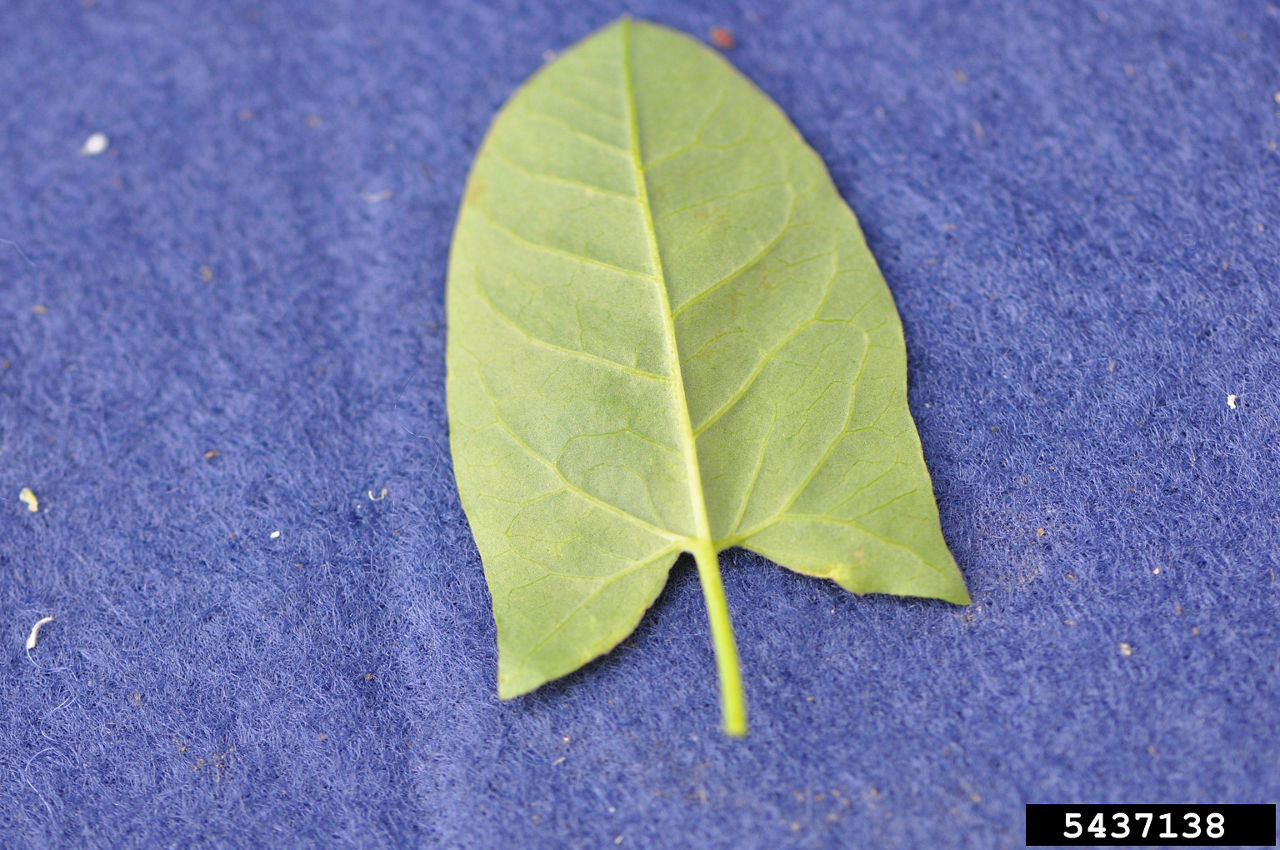
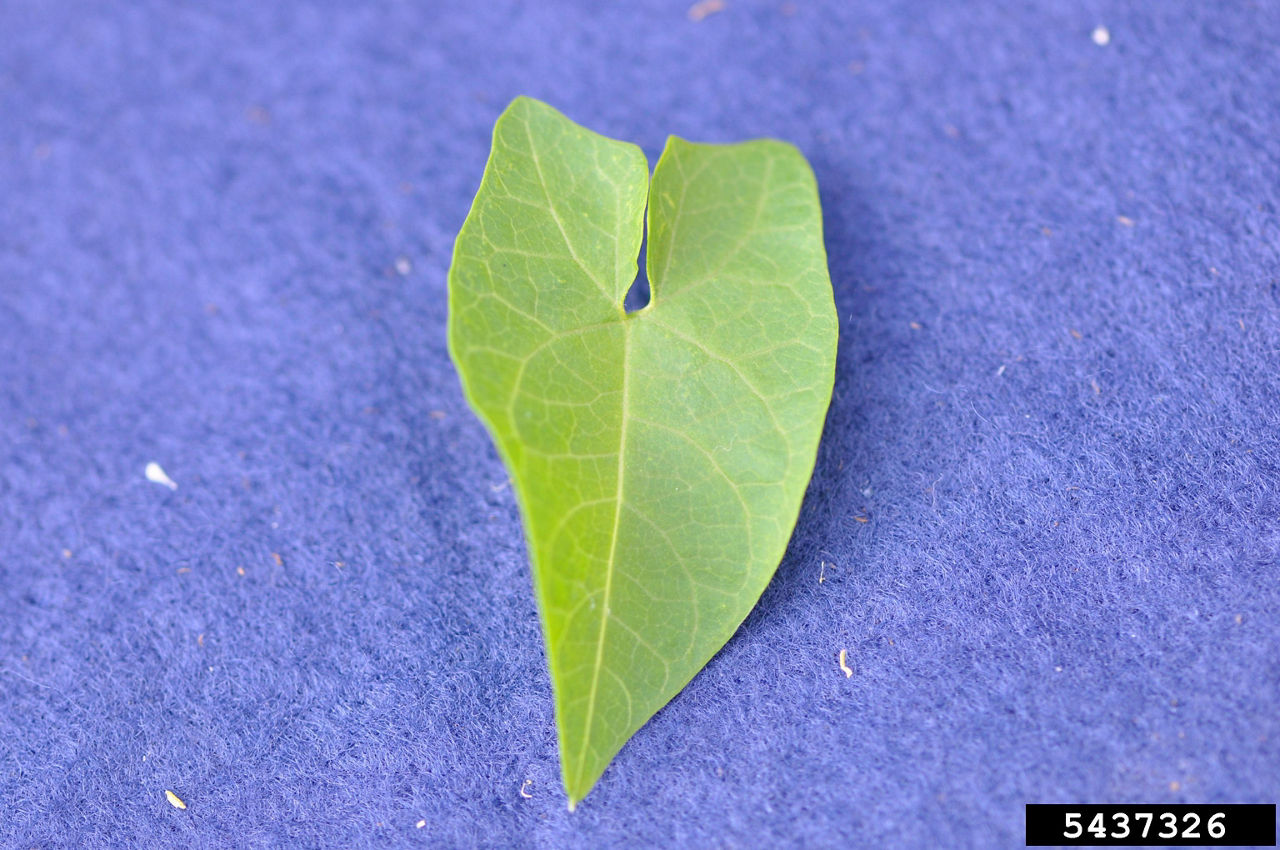
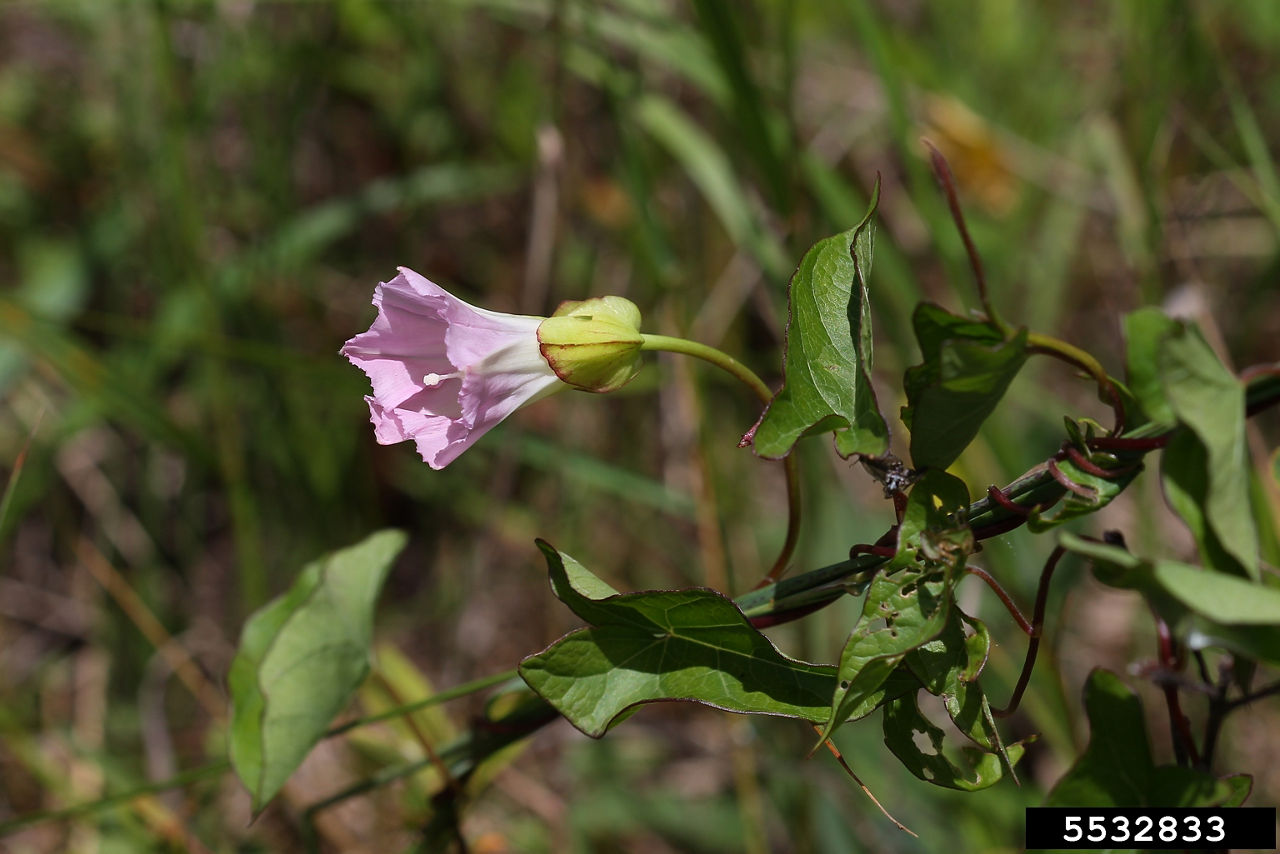
Field bindweed is also mistaken for wild buckwheat (Polygonum convolvulus) because of its vining habit and arrowhead-shaped leaves; however, wild buckwheat has inward-pointing lobes at the base of the leaf and an ocrea at the base of each petiole (Figure 160).
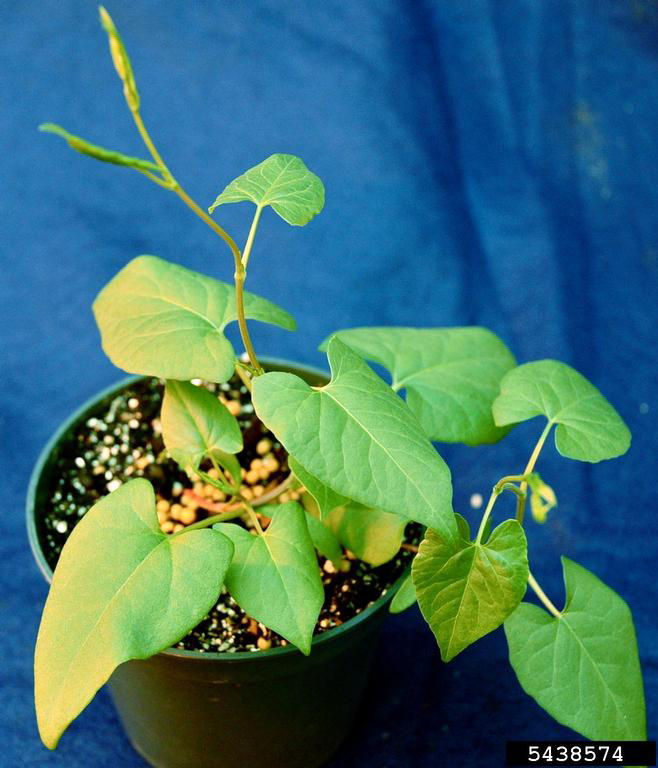
Management: Established field bindweed is difficult to control and should include a combination of management tactics including cultivation, selective herbicides, and crop competition. Timely and intensive cultivation helps control newly-emerged seedlings and manage young field bindweed infestations. Timely cultivation depletes root reserves and helps stimulate dormant seeds to germinate. Intensive cultivation is usually not practical as the sole method of control because tillage must be done every 8 to 14 days throughout the growing season for multiple years and exposes the soil to erosion.
Field bindweed prefers full sunlight, so competitive crops may help discourage field bindweed as it is not competitive under shady conditions. Rotation with crops like winter wheat, corn, alfalfa, and sorghum can reduce field bindweed growth.
Preventive control measures, along with tillage and herbicide applications, are most effective for controlling field bindweed. Closely-drilled, vigorous, competitive crops such as winter wheat or forage sorghum may also aid control. Systemic herbicides like dicamba, 2,4-D, picloram, and glyphosate products alone or in various combinations are registered for suppression or control of field bindweed. Single herbicide applications rarely eliminate established bindweed stands. Applications of 2,4-D and glyphosate products are most effective when spring-applied to vigorously-growing field bindweed in mid to full bloom. However, dicamba applications are most effective when applied in the fall. Most herbicide treatments are least effective when applied in midsummer or when bindweed plants are stressed.
Common name: Hemp dogbane
Scientific name: Apocynum cannabinum
Life Cycle: Perennial
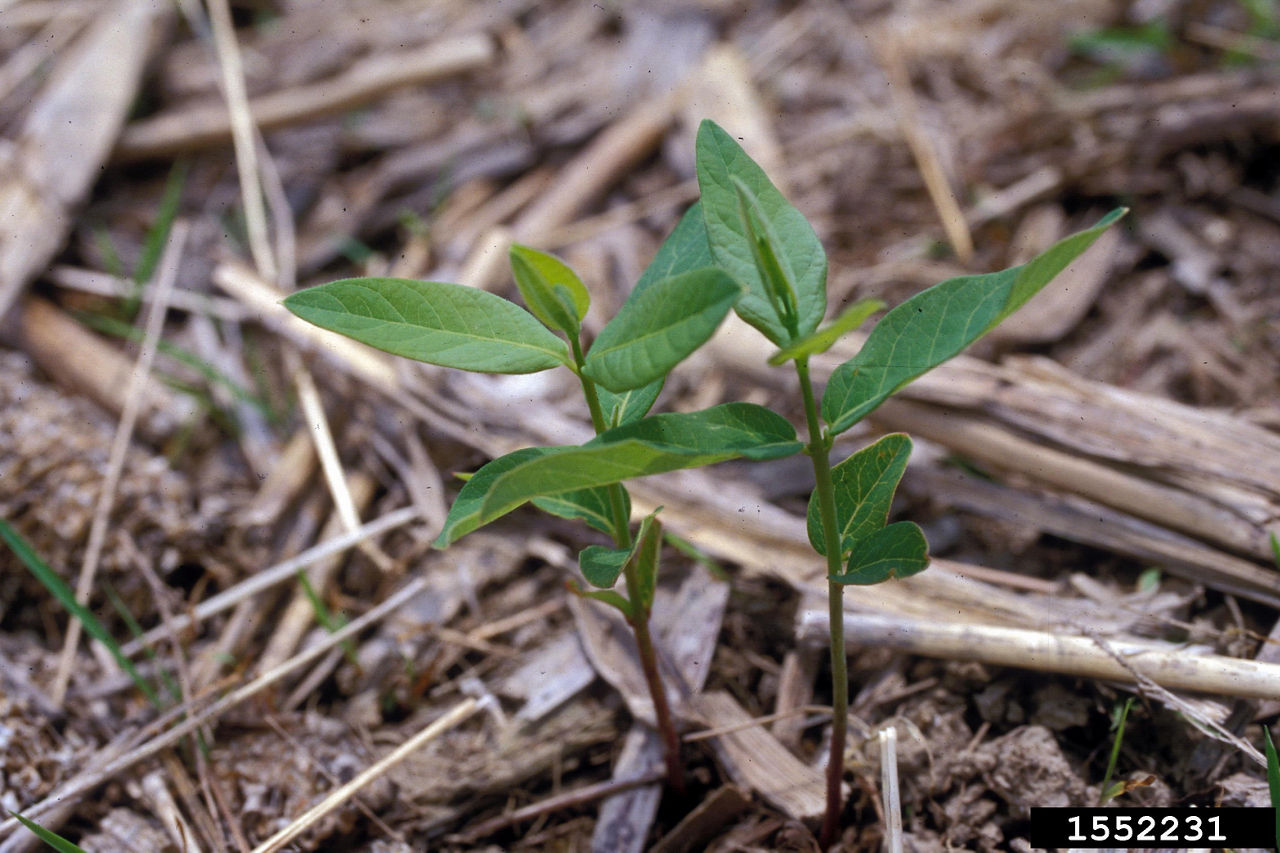
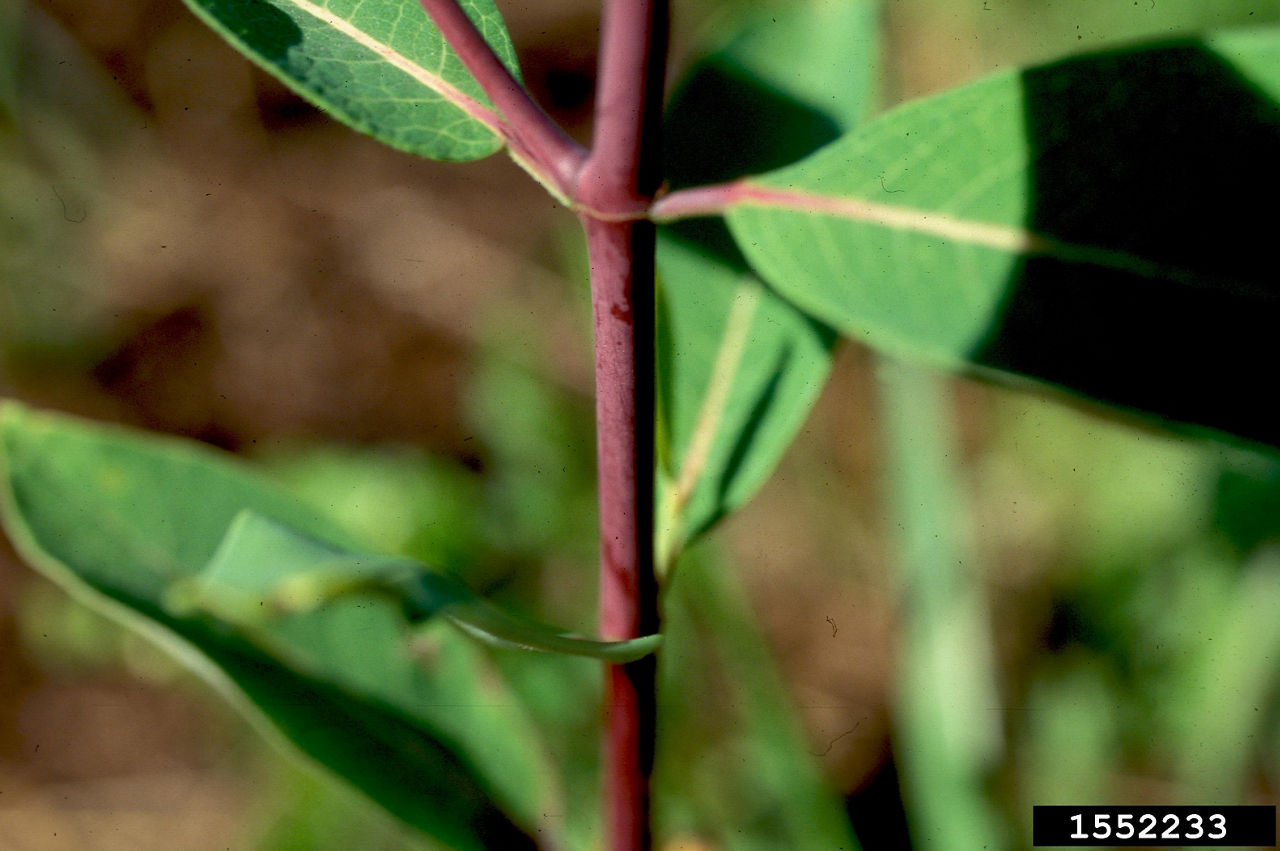
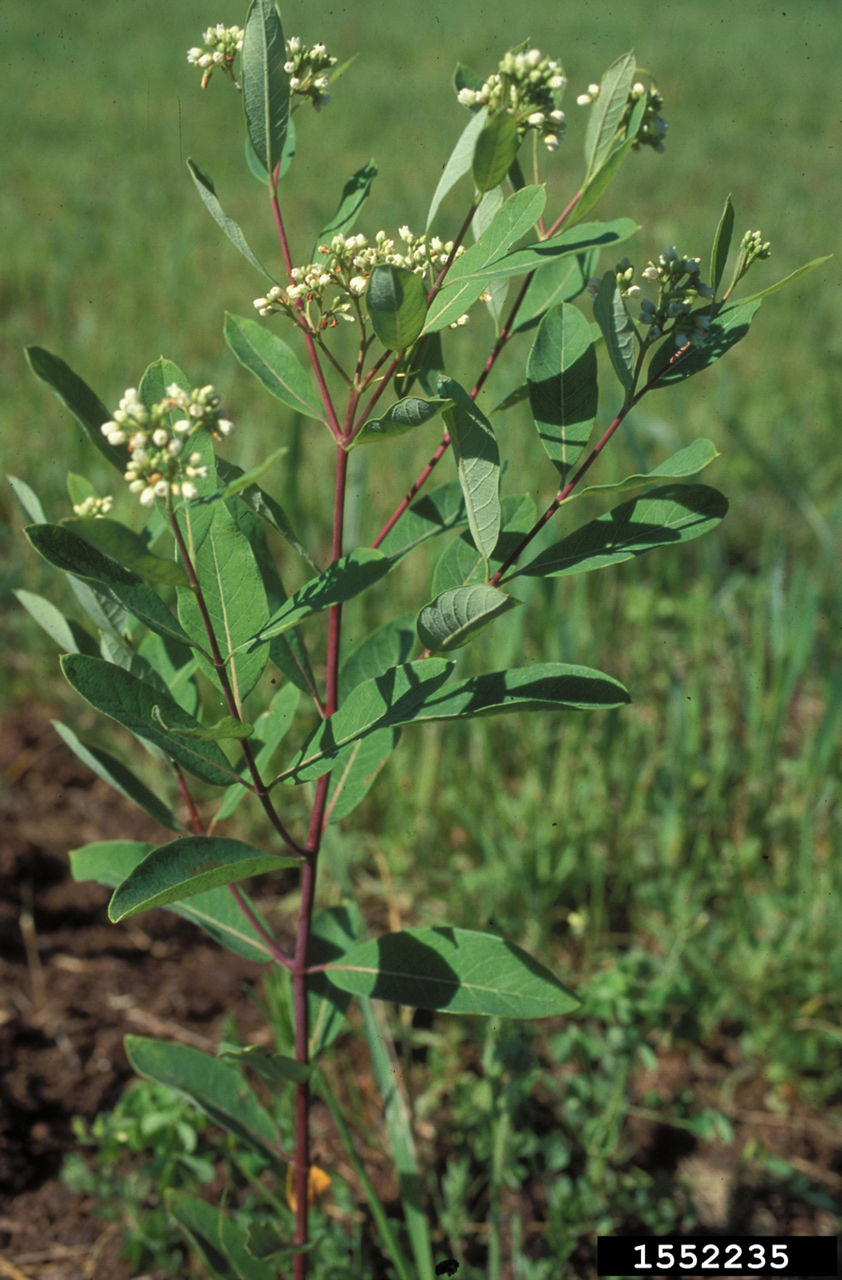

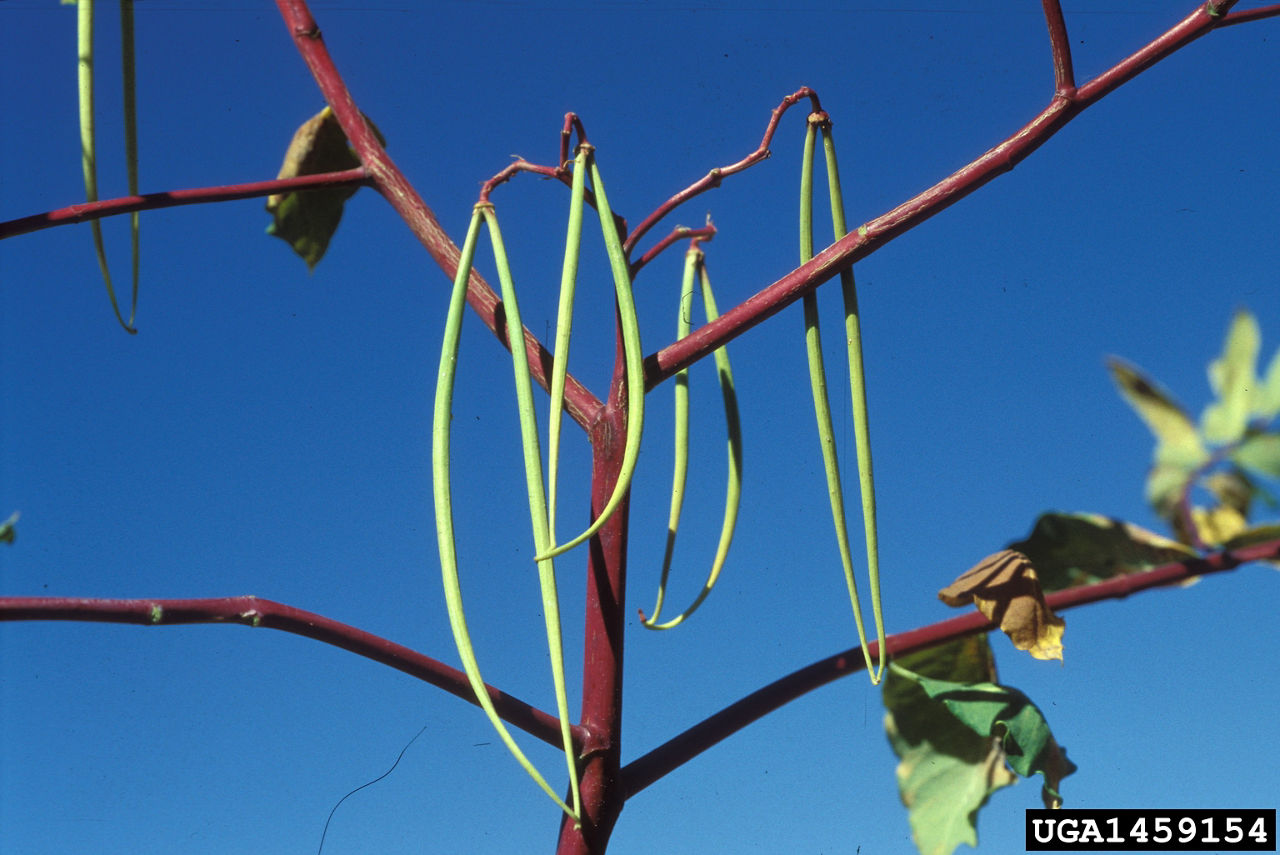
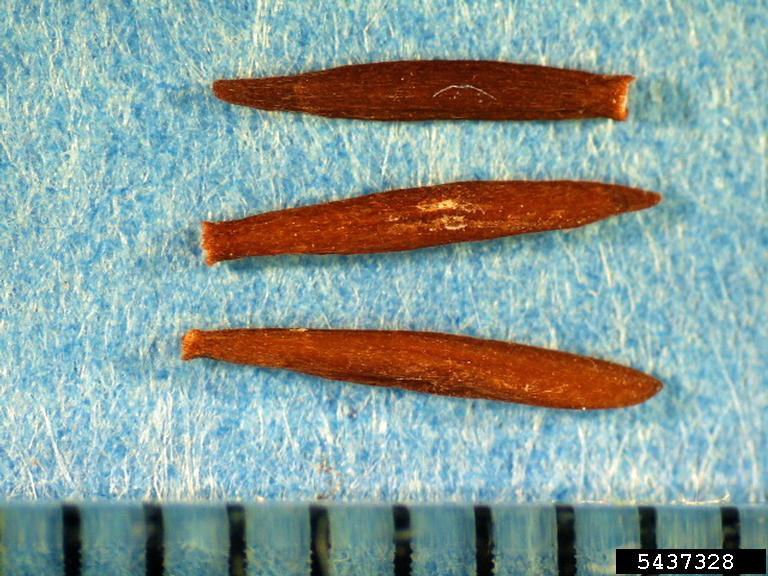
Identification: Hemp dogbane is a perennial weed that secretes a milky sap when broken, reaching 5 to 6 feet in height. In pastures and hay fields, hemp dogbane represents a potential threat both as a weed capable of reducing yields and is also poisonous to cattle, horses, and sheep. Leaves are entire, ovate or elliptic, 2 to 5 inches long, 1/2 to 1 & 1/2 inches wide, and arranged oppositely along the stem (Figures 161 and 162). Stems are without hairs, often have a reddish tint when mature, and undivided at the base but become heavily branched in its upper half (Figure 163). Flowers are small, white to greenish-white, and produced in terminal clusters (Figure 164). The fruit are long (5 inches or more), narrow follicles that are produced in pairs (Figure 165). Hemp dogbane reproduces by seeds (Figure 166), but the primary mode of reproduction of plants in agronomic fields is vegetative creeping roots resulting in hemp dogbane to arise in patches. Seedlings can become perennial 5 to 6 weeks after emergence. The perennial creeping rootstocks persist many years in the soil.
Similar Species: Common milkweed and hemp dogbane share such characteristics as creeping roots, opposite leaves, and milky sap. However, young leaves of common milkweed are finely hairy while those of hemp dogbane are nearly hairless (Figure 167). Also, stems of hemp dogbane branch more than those of common milkweed, flowers differ in color, and pods of hemp dogbane are long and narrow while those of common milkweed are much broader.
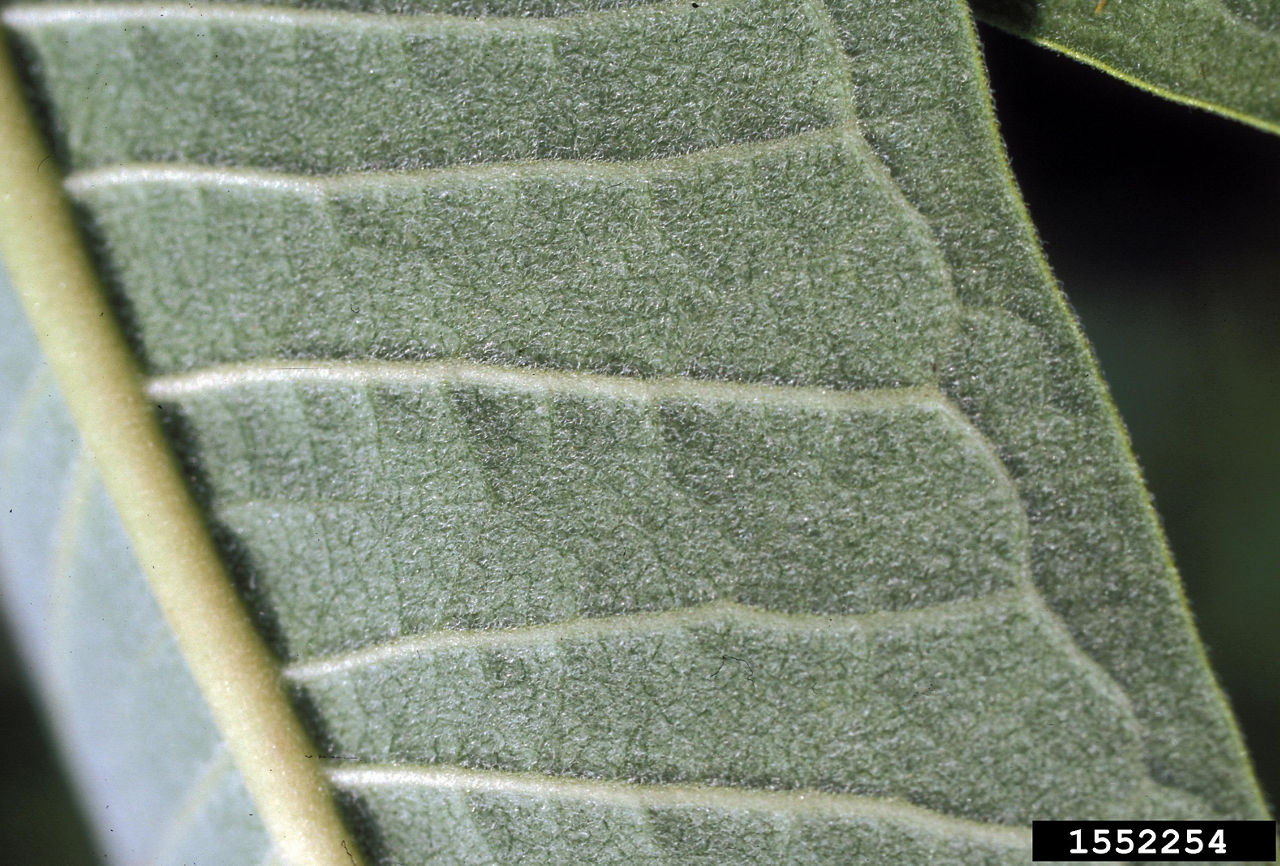
Management: Uprooting, chopping, and burying the hemp dogbane rhizomes will control this weed, therefore, it is less of a problem in tilled cropping systems. Effective broadleaf herbicides for hemp dogbane are dicamba, 2,4-D, and glyphosate. Application timing is important. Where appropriate, tillage to disrupt the perennial rootstock will greatly enhance the effectiveness of herbicide treatments. In soybean, applications of glyphosate coupled with the competitive effects of good soybean canopy closure should be considered one of the most effective means of hemp dogbane control.
Common name: Common milkweed
Scientific name: Asclepias syriaca
Life Cycle: Perennial
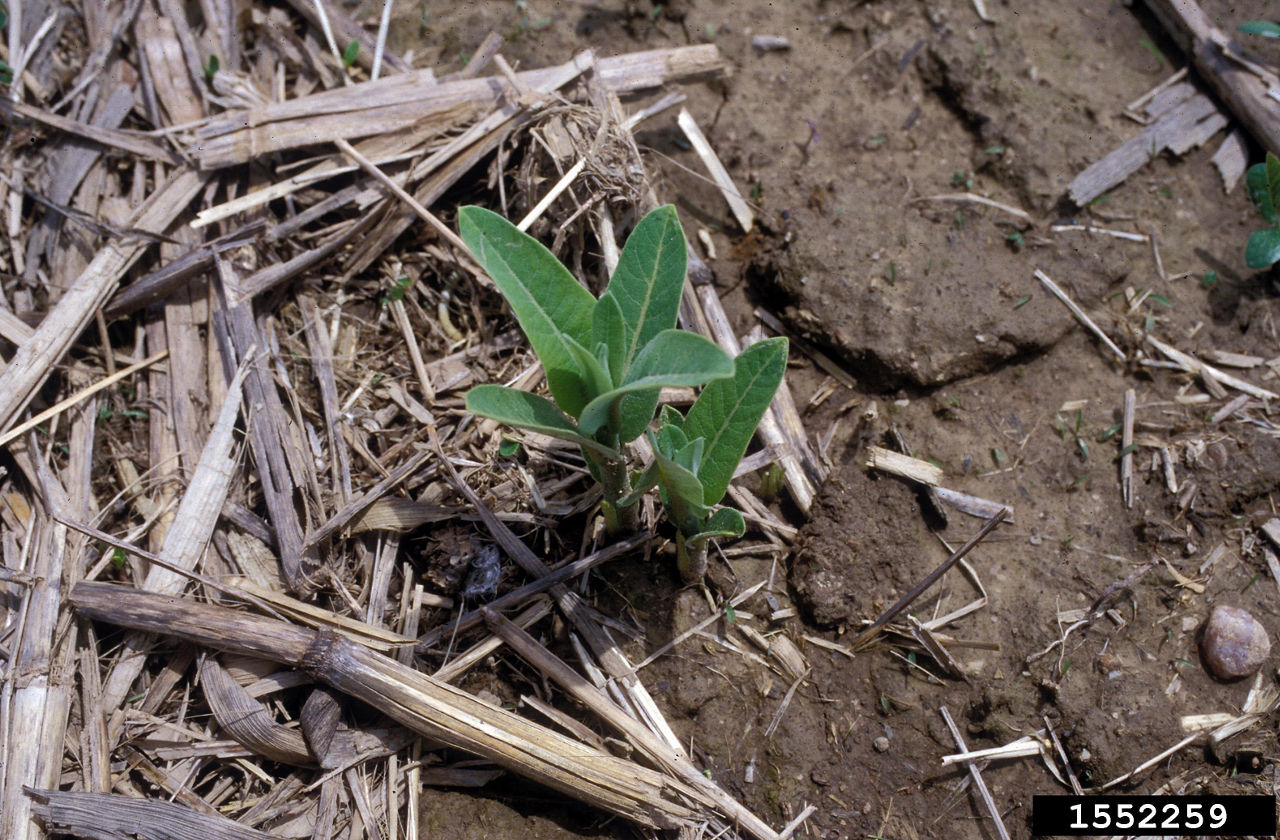
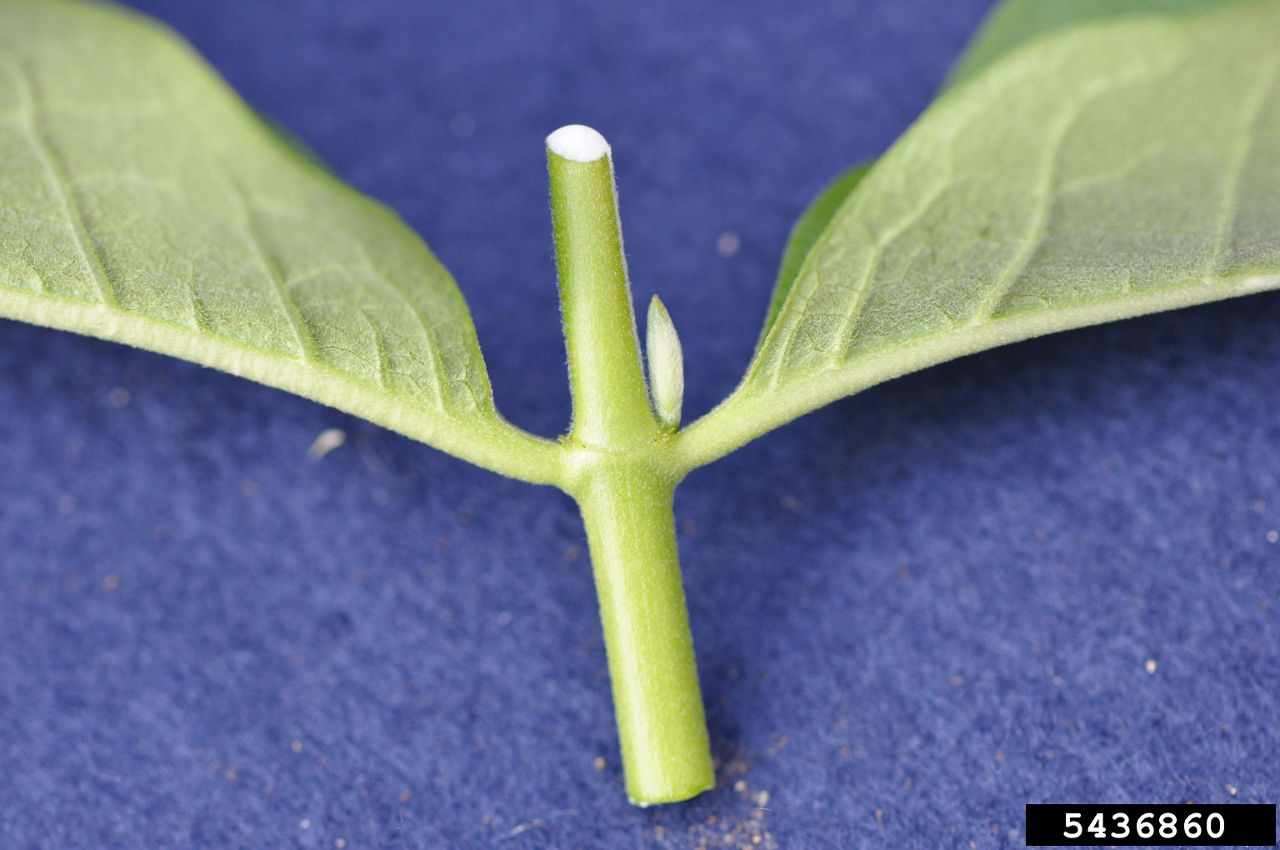

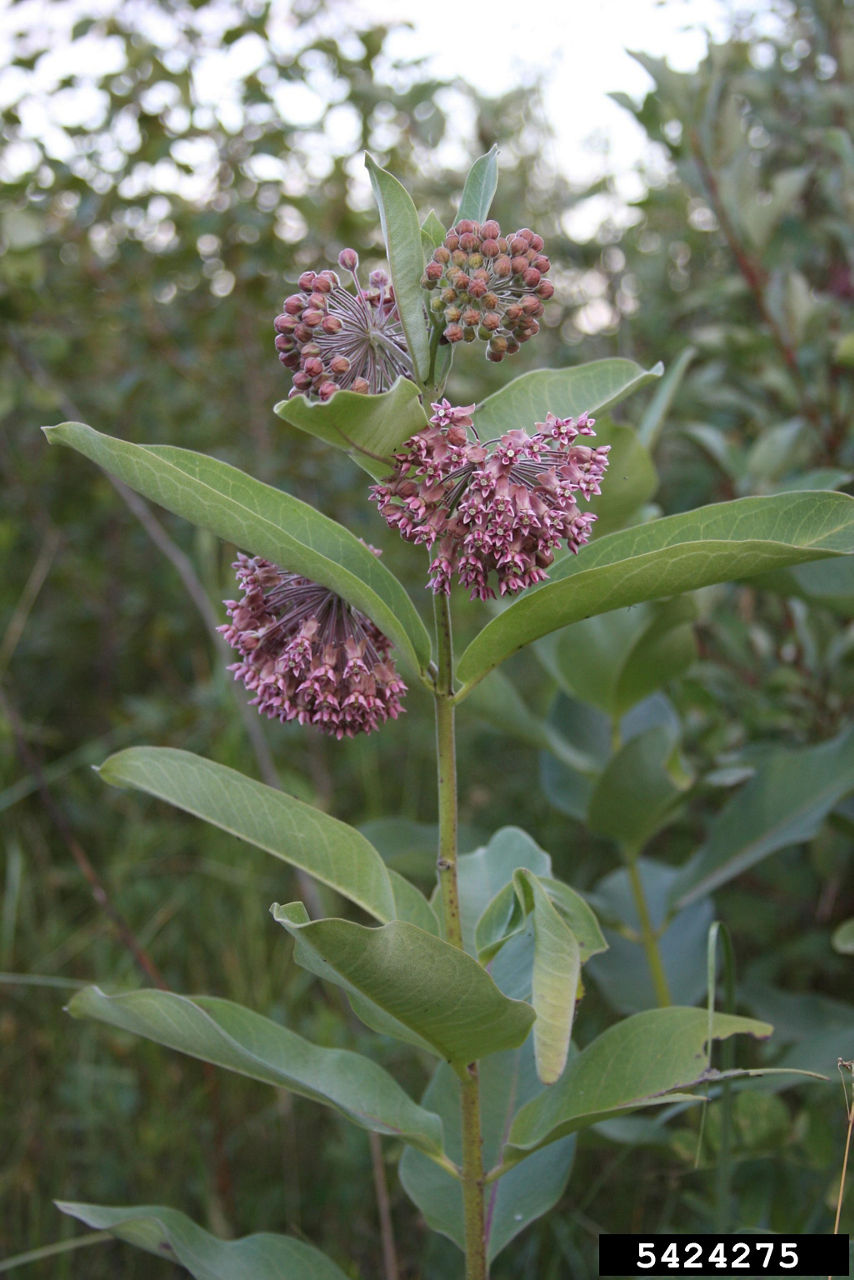
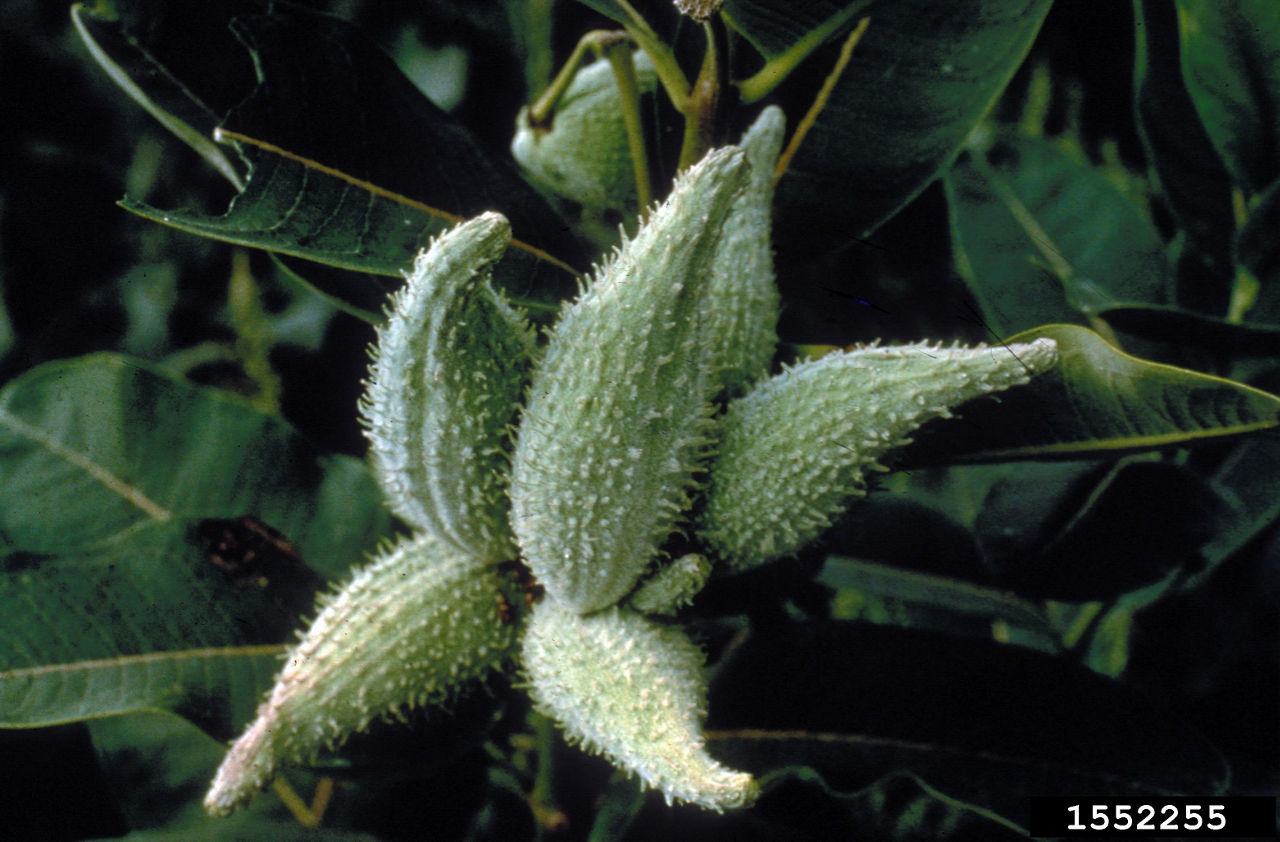
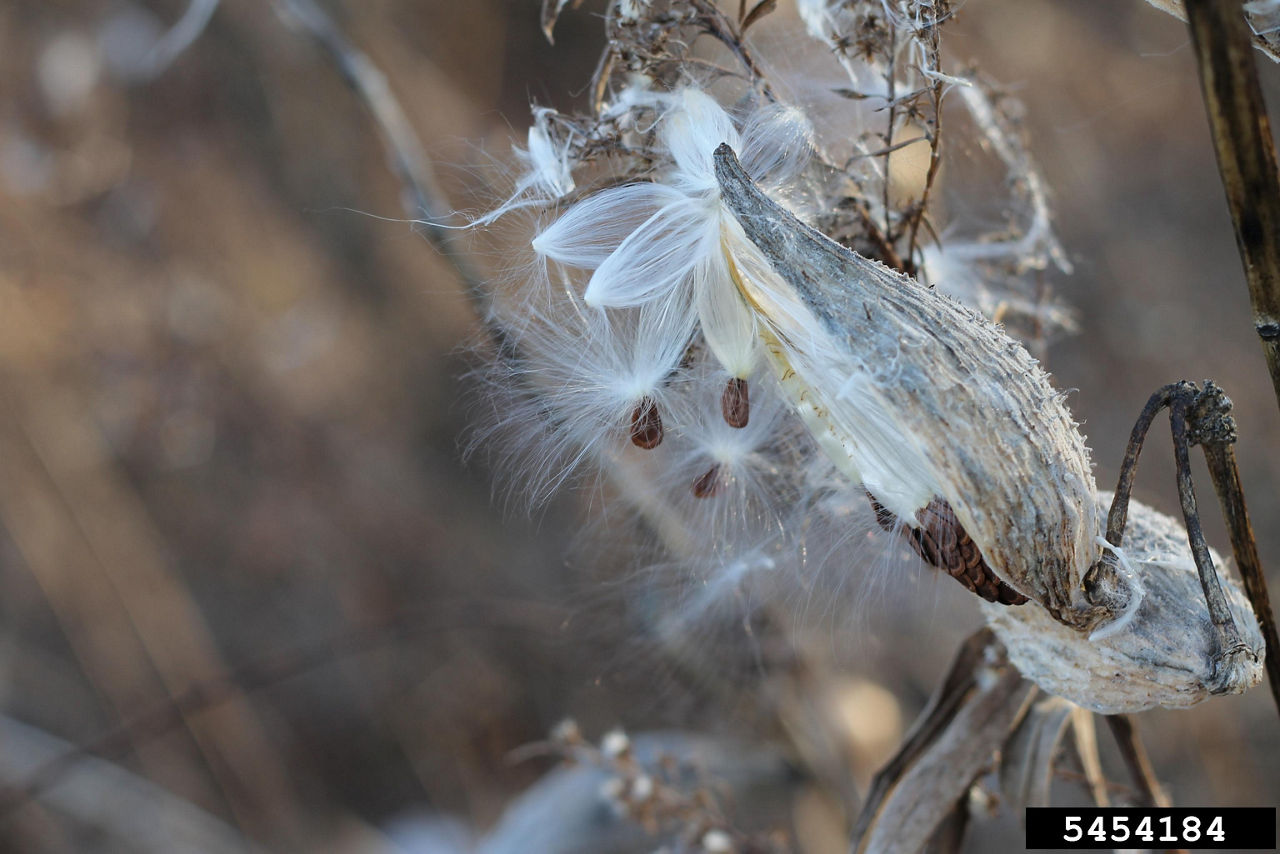
Identification: Common milkweed is an erect, tap-rooted perennial that reproduces by both seed and rhizomatous roots bearing adventitious buds (Figure 168). Although the stems of common milkweed are usually solitary, multiple stems can originate from a common root crown. The stems are hollow, subtly squared, seldom branched, and generally covered with short, downy hairs.
All plant parts contain a white milky latex that is excreted upon injury (Figure 169). The leaves of common milkweed are opposite, oval, oblong to egg-shaped, 3 to 8 inches long, with smooth margins and distinctly-white midveins and veins. The upper leaf surface is dark green and usually smooth; the lower leaf surface is pale green and finely hairy (Figure 170). Milkweed flowers occur in rounded clusters at stem ends and in upper leaf axils and are sweetly scented, and each occurs at the end of a long, slender flower stalk (Figure 171). Although commonly lavender-pink, the flowers can also be shades of yellow or green. The flowers have both male and female parts but must be cross-pollinated by insects to form seeds. A single common milkweed plant can produce an estimated 25 fruit with each fruit containing as many as 450 seeds. The conspicuous seed pods are initially fleshy, pale green, covered with soft-pointed bumps, and shaped like long teardrops (3 to 5 inches long) (Figure 172). With maturity, the follicles dry up and turn brown before splitting open lengthwise, releasing numerous brown, flat seeds, each with a tuft of silky hair (pappus) attached to one end (Figure 173). Seeds, commonly carried off by the wind, reportedly remain viable in the soil for at least 3 years.
Similar Species: Hemp dogbane (Apocynum Cannabinum) can also be confused for common milkweed, especially in early growth stages, but it has much smaller leaves, has a different flower color, and is so heavily branched that it forms a bushy plant (Figure 174).

Management: Cultivation does not work well because it spreads root fragments and cannot reach the roots of common milkweed that extend far below the plow depth. To be effective, tillage must be done often enough to deplete underground root reserves—every 2 or 3 weeks.
This weed has an extensive and deep root system and is tolerant to many common herbicides. Multiple herbicide applications are often required. Glyphosate, when applied at the proper rate and timing, will give good control. Late, postemergence applications when plants are in the bloom stage will be most effective in killing roots. There are several herbicides listed for tank mixes with glyphosate for corn and soybeans.
In small grains, milkweed should be allowed to regrow to a mature stage after harvest or mowing, and then treated. In hay or pasture, milkweed can be spot-treated with glyphosate applied with a wipe-on applicator while the milkweed is taller than the crop, or spot-treated with a hand-sprayer. When these fields are rotated or renovated, that is the time to make your best effort to deal with milkweed aggressively.
Common name: Horsenettle
Scientific name: Solanum carolinense
Life Cycle: Perennial
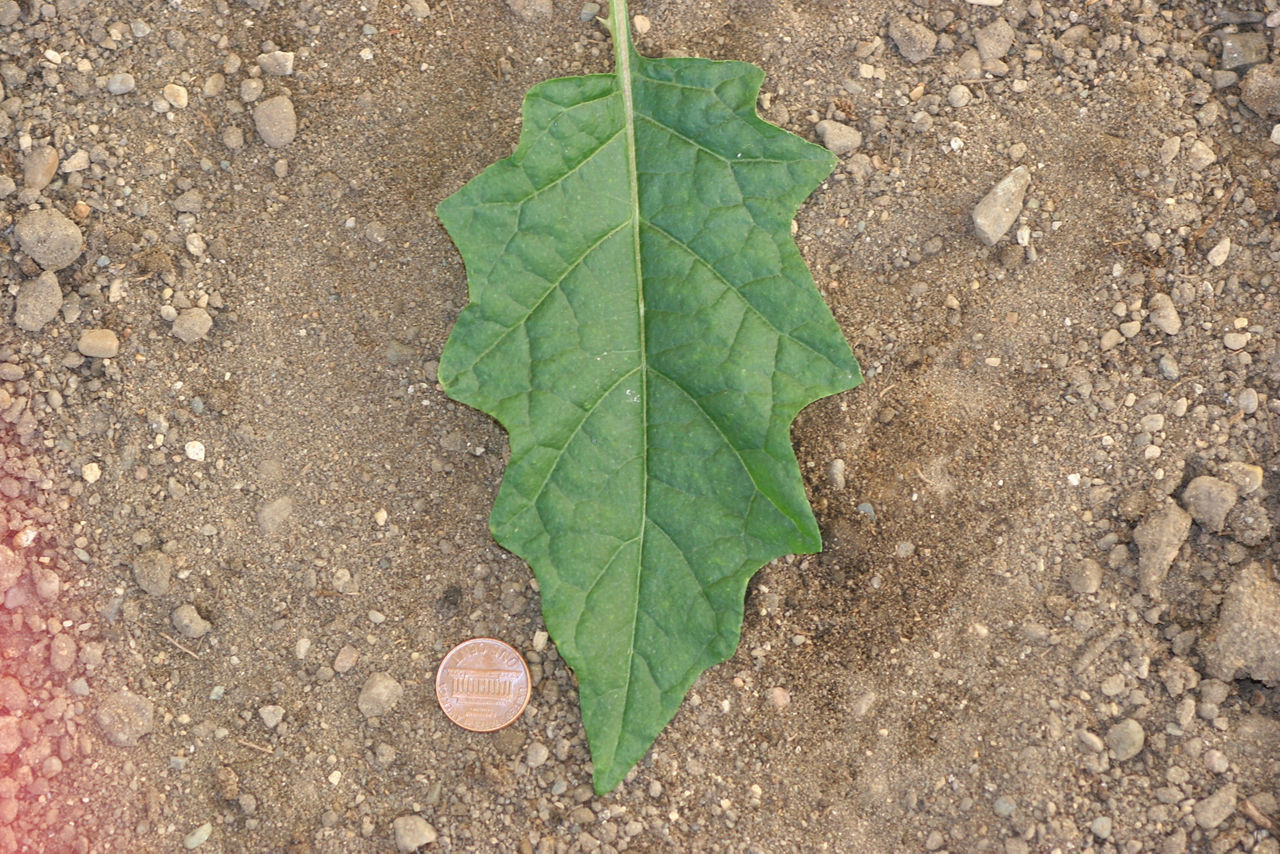
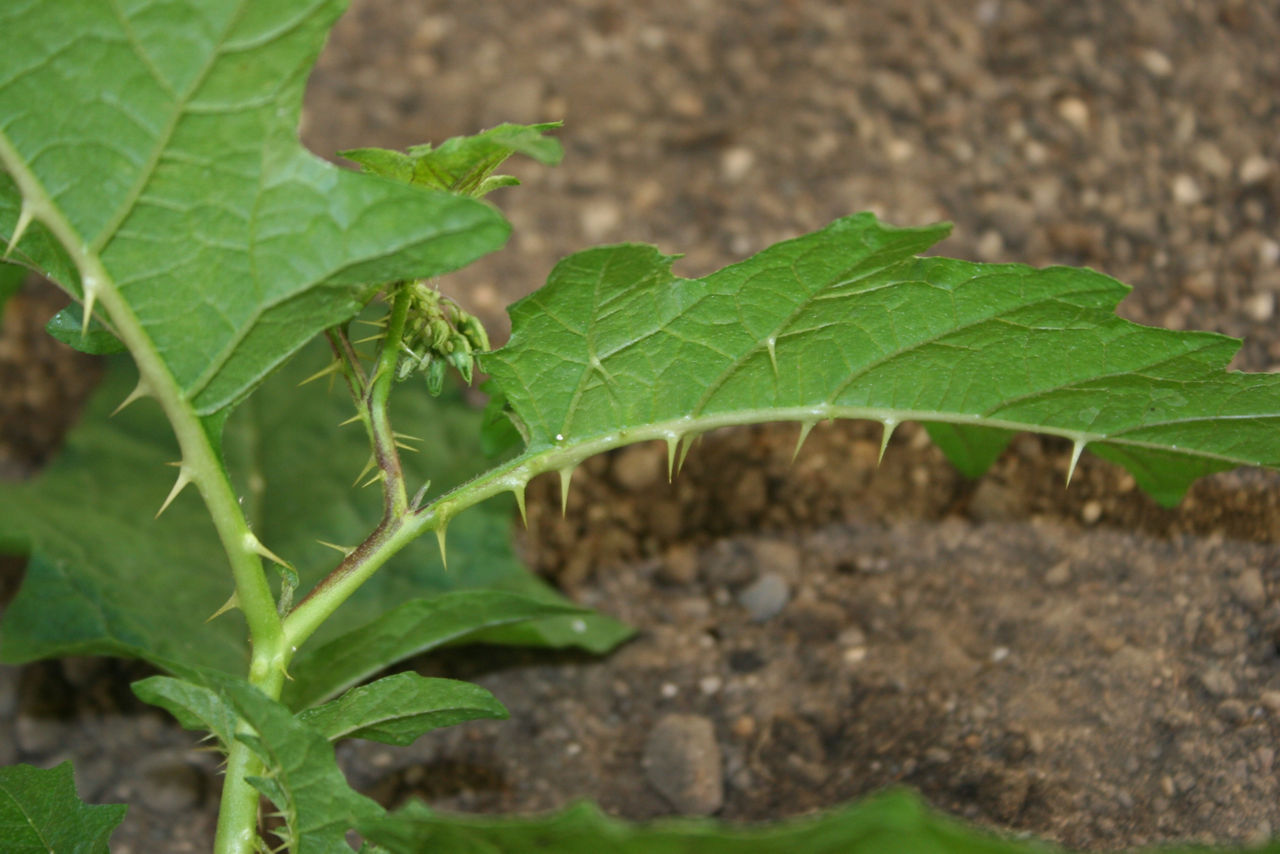
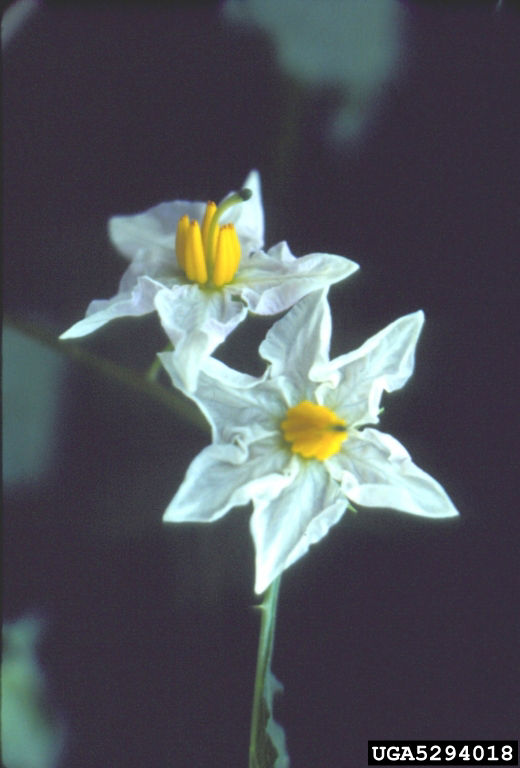
Identification: Horsenettle is a herbaceous perennial that is a member of the nightshade family (Solanaceae) (Figure 175). Some familiar members of this family include tobacco, tomato, and potato. Characteristics distinguishing horsenettle from other nightshades are its perennial spreading roots and prickly stems and leaves. Another distinctive feature is the yellow fruit, which changes from plump and smooth-skinned to wrinkled as it matures (Figure 176). New plants arise from seeds and spreading underground roots, which generally produce numerous shoots in dense patches. The cotyledons or seed leaves of seedlings are small; they are glossy green on the upper surface and light green on the underside (Figure 177). Both surfaces are void of hairs, but the leaf margins are hairy. Mature plants can grow to heights of up to 3 feet. The leaves are alternate with lobed margins (Figure 178). Leaves also emit a potato odor when crushed and contain prominent prickles on the midvein and petiole (Figure 179). Stems are angled at the nodes, become woody with age, and also have prickles and hairs. Flowers occur in clusters and are star-shaped with 5 white to violet petals and a yellow center (Figure 180).
Watchouts: All parts of the plants, except the mature fruit, are capable of poisoning livestock if eaten in sufficient quantity; however, consumption rarely occurs due to the prickly stems and leaves. Hay and silage containing the mature plants can cause poisoning and death of livestock.
Management: Few postemergence corn herbicides provide acceptable short- or long-term control of horsenettle. Previous studies have illustrated that the maximum translocation of herbicides into the roots occurs when horsenettle plants are in the early- to mid-bloom stages of growth.1 Unfortunately, this is not a compatible time for postemergence herbicide applications in most corn production systems, as most postemergence corn applications are made from late-May to mid-June when horsenettle plants are at a much younger stage of growth. Sequential applications of labeled herbicides will be needed to manage horsenettle. Control is also enhanced by the competitive effects of the crop canopy. Cultural control methods like narrow soybean rows and intensive management will enhance the crop competitive effect.
Sources:
1Bradley, K.W. and Hagood, E.S. Jr. 2009. Identification and control of horsenettle (Solanum carolinense L.) in Virginia. Publication 450-142. Virginia Cooperative Extension. http://pubs.ext.vt.edu
General Weed Management Considerations
It is important to start the season clean with tillage or a burndown herbicide application. Allowing weeds to be present at planting because of skipping or delaying the burndown application will give weeds a competitive advantage with the crop.
The use of preemergence herbicides at planting can reduce the risk of early-season competition by reducing densities of weeds that can emerge with the crop.
The use of strictly postemergence herbicide application programs can by risky. Weeds grow rapidly, and weather can delay postemergence applications which can result in loss of yield potential. Surveys have shown that where weeds are managed with only postemergence herbicides, application timings often occur too late to protect the full yield potential of corn from early weed competition.2
The use of preemergence and postemergence herbicides in sequential applications or in tank mixtures can be the best approach to weed control. Weeds should be controlled throughout the season to protect yield potential, using a mix of herbicides and multiple sites of action that can help to prevent the development and spread of resistant weeds.
Sources:
1VanGessel, M. Weed management in row crops: application to corn production - competitive index factor chart. Northeast IPM Module number 10. http://northeastipm.org.
2Fickett, N.D., Boerboom, C.M., and Stoltenberg, D.E. 2013. Predicted corn yield loss due to weed competition prior to postemergence herbicide application on Wisconsin farms. Weed Technology 27:54-62.Schaefer, K., Mueller, D., Sisson, A., Hartzler, B., Anderson, M., Jha, P., and McGrath, C. 2019. Weed identification. Field Guide. 2nd Edition. Iowa State University Extension and Outreach.
Everman, W., Sprague, C., Gower, S., and Richardson, R. 2014. An IPM Pocket Guide for Weed Identification in Field Crops. Bulletin E-3081. Michigan State University Extension.
1027_G1
